Archived Blog Posts
Mold Removal in Commercial Properties: Trusting SERVPRO of East Boston, Chelsea, & Revere
4/26/2023 (Permalink)
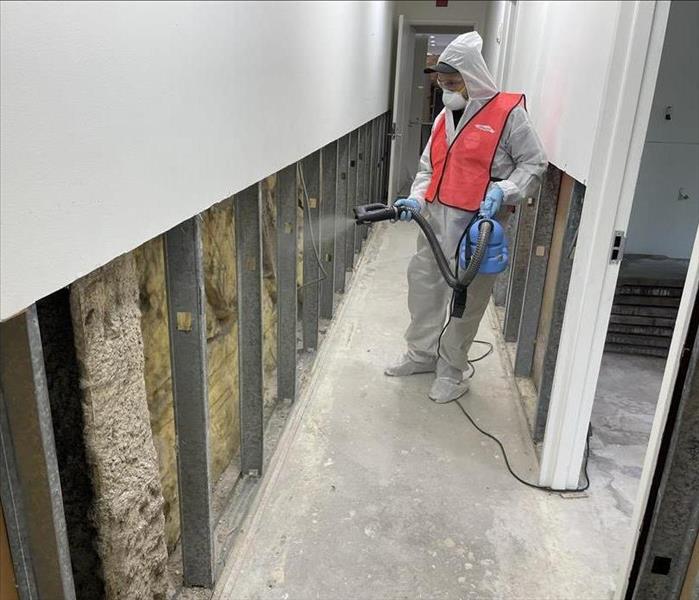 SERVPRO of East Boston, Chelsea, & Revere is an area leader in mold remediation services, call us today to learn more.
SERVPRO of East Boston, Chelsea, & Revere is an area leader in mold remediation services, call us today to learn more.
Mold is a common problem in commercial properties in the Boston, MA area. It can grow quickly in moist and humid environments, and if left untreated, can cause significant damage to the structure of the building and impact the health of the occupants.
That's why it's important to work with a trusted and experienced mold removal company like SERVPRO of East Boston, Chelsea, & Revere. As part of the SERVPRO Team Luzzi network, they have the expertise, equipment, and training to effectively mitigate mold in commercial properties.
Their mold removal process starts with a thorough inspection of the property to determine the extent of the mold growth and the source of moisture. They then use specialized equipment and techniques to contain the mold and prevent it from spreading to other areas of the building. They also use air scrubbers and HEPA vacuums to remove mold spores from the air.
Once the mold has been removed, SERVPRO of East Boston, Chelsea, & Revere will clean and sanitize the affected areas to ensure that all traces of mold have been eliminated. They will also work with the property owner to identify and address any underlying moisture issues to prevent future mold growth.
Overall, if you're dealing with mold in a commercial property in the Boston, MA area, SERVPRO of East Boston, Chelsea, & Revere is an excellent choice for mold mitigation services. Their experience, expertise, and commitment to customer satisfaction make them a leader in the industry.
Restoring Homes After Fire Damage: SERVPRO of East Boston, Chelsea, & Revere Is Here to Help
4/26/2023 (Permalink)
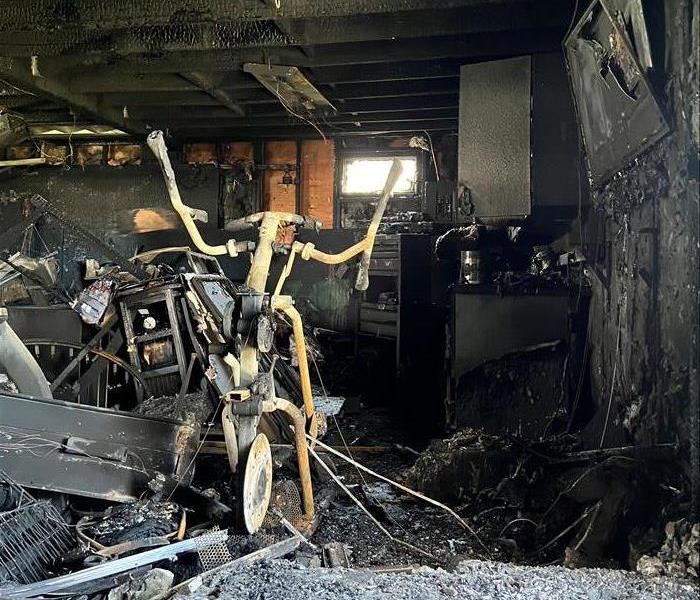 SERVPRO of East Boston, Chelsea & Revere is available 24/7 when fire damage restoration services are needed immediately. Call us now.
SERVPRO of East Boston, Chelsea & Revere is available 24/7 when fire damage restoration services are needed immediately. Call us now.
Fires can strike at any time and cause extensive damage to residential properties. The aftermath can be overwhelming and emotionally devastating for homeowners. That's why it's important to work with a trusted and experienced fire damage restoration company like SERVPRO of East Boston, Chelsea, & Revere in the Boston, MA area.
As part of the SERVPRO Team Luzzi network, they have the knowledge, expertise, and equipment to restore homes after fire damage. They start by assessing the extent of the damage and creating a customized plan for restoration. This may include cleaning and deodorizing, removing soot and debris, and repairing or replacing damaged materials.
SERVPRO of East Boston, Chelsea, & Revere also offers 24/7 emergency services to help homeowners deal with the immediate aftermath of a fire. They can board up and secure the property, and begin the restoration process as quickly as possible to prevent further damage.
In addition, they work with homeowners and their insurance companies to navigate the claims process, making the experience less stressful and more efficient.
Overall, if you're dealing with fire damage in a residential property in the Boston, MA area, SERVPRO of East Boston, Chelsea, & Revere is an excellent choice for restoration services. Their experience, expertise, and commitment to customer satisfaction make them a leader in the industry.
Expert Water Damage Restoration for Commercial Properties in Boston: SERVPRO of East Boston, Chelsea, & Revere
4/26/2023 (Permalink)
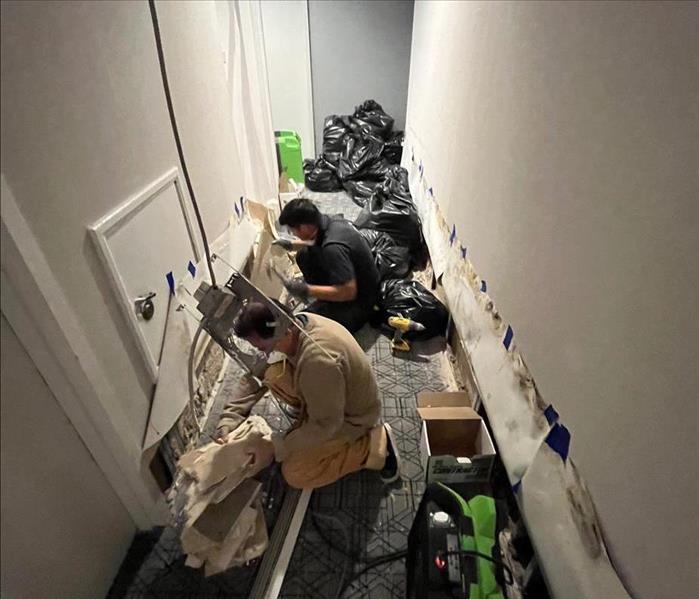 SERVPRO of East Boston, Chelsea & Revere is available 24/7 when water damages your commercial property. Call us now.
SERVPRO of East Boston, Chelsea & Revere is available 24/7 when water damages your commercial property. Call us now.
Water damage is a common issue in commercial properties in the Boston, MA area, and can result from a variety of causes, such as floods, storms, plumbing issues, and leaks. It's important to address water damage as quickly as possible to prevent further damage to the property and minimize business interruption. That's why it's crucial to work with a trusted and experienced water damage restoration company like SERVPRO of East Boston, Chelsea, & Revere.
As part of the SERVPRO Team Luzzi network, they have the expertise and equipment to handle any size water damage restoration project. They start by identifying the source of the water damage and taking steps to stop the water from flowing into the property. Then, they use specialized equipment like pumps, air movers, and dehumidifiers to remove standing water and dry the affected areas.
SERVPRO of East Boston, Chelsea, & Revere also offers mold remediation services, as mold can quickly grow in damp environments and pose a health hazard to occupants. They use industry-leading techniques to ensure that all traces of mold are eliminated from the property.
In addition, they work with property owners and their insurance companies to navigate the claims process, making the experience as stress-free as possible.
Overall, if you're dealing with water damage in a commercial property in the Boston, MA area, SERVPRO of East Boston, Chelsea, & Revere is an excellent choice for restoration services. Their experience, expertise, and commitment to customer satisfaction make them a leader in the industry.
Learning and schools
6/25/2021 (Permalink)
Did you know that SERVPRO helps schools stay up to code with clean healthy environments for your children. We will even respond to emergency clean up situations. Having seen in recent news the fly infestation that occurred at a local Chelsea School we were compelled to spread the word.
We can give schools a once over deep cleaning after summer breaks or vacation weeks to make sure that students come back to a fresh clean environment ideal for learning. If your school has recently updated its equipment or has a lot of broken desks and older books to get rid of let us know we can haul it away to free up more space for learning. Did one of the kids in protest vandalize the school in some way in protest of an event that occurred at the school let us know and we will respond to quickly get you cleaned up and back to normal learning . Prolonged distractions can be detrimental to the education process and even emotionally upset students if it was derogatory.
Smell something funny, see something on a wall that does not look just right, or some new visitors that you know should not be there. Well we are here to tell you if you can see it, smell it or even hear it the problems is far worse than what is within the range of our senses. It is very critical that you call in professionals to detect not only the immediate problem but also have the knowledge to detect the root reason that the problem exists in the first place.
Let me explain, with the case of the Chelsea school the problem was a fly infestation. They did not just appear for no reason. They had to have a ripe environment with an adequate food and water source, and an over abundance of sewer water was just the thing. The flies were not really the problem a broken sewer pipe was. Having gone undetected for an undetermined amount of time allowed for the flies to blossom and become the major issue that it was forcing a school closure.
We see this all too often within businesses and a lot of damage can occur from not having an assigned person trained to look for the subtle signs that prevent a much larger issue. Dedicating one person to do a once over the entire building daily and making notations of any odors, visual changes, as well as any animal or insect changes is pivotal to building health.
Along with several incidents of that same person not having the authority or not knowing what to do if there are changes to the environment. Emergency Ready Plans for businesses guide the individuals on the front lines through policy, procedures and protocols to make sure that issues are addressed quickly and correctly. They can be customized to the needs of your facility and can include evacuation routes and meeting points. Main points of contact in case of an emergency and closest emergency service locations can also be included. As a preparedness plan I ask you, if you asked your primary team where the water and electrical shut valves were for the building will they be able to tell you? Most will not our preparedness plan will put all that information at your fingertips from where ever you are.
It is a mobile app that will keep each locations information separated as well right at your fingertips. The best part is it can be shared with whomever you would like to share it with so long as they download the app to their phone. A version that can be edited is available to the key players while a non-editable version can be sent out to local managers.
No one plans for an emergency but having a plan in place and having people that know what to do should an emergency arise can be the difference between a slight issue and a major emergency. Working with a company whose network spans the country ensures 24 hours 7 days a week availability and response time mitigates the damages and provides solid clear cut direction for your staff.
Our staff is trained to clean and sanitize building materials, surfaces and contents following the restoration industry standards along with using FDA registered cleaners and disinfectants. Bleach does not get it done on pesky situations. Call the professionals at SERVPRO of East Boston to ensure your next problem does not become a major problem.
Boston ready!
4/1/2021 (Permalink)
Is Boston Ready for the next major storm and what is it doing to prepare for the rising tides. A town almost entirely built through human design in the middle of a bay is subjected to the ebb and flow of the tide more than most and its lack of elevation adds to the problem. To better understand this problem let us take a quick look at the history of Boston and how it came to be.
Tidal flats were filled in to create shipping ports. They were filled in with rocks, dirt and yes trash. A lot of the quaint neighborhoods such as the Back Bay, East Boston, Charlestown and the South End were built on landfills. I know shocking right. Needless to say, they are low-lying areas susceptible to the rising seas. Even the airport used to be a collection of 5 islands filled in to serve a purpose.
Ok so that is a very quick back story so what dangers does this possess. To understand this, you need to know how high everything is. At best Boston is considered 14 meters above sea level, with many spots being directly at sea level. In recent years and by recent we mean the last century sea levels have risen 28 centimeters. There is talk about as much as a 3 meter rise due to greenhouse gases by 2100. This puts Boston in line to be one of the top 10 most vulnerable cities in the world.
You just did the math the city is still not underwater. Well let us take a look at high tides, storm surges and damage than can result from it. Storm surge tides are on the rise just ask an adjacent town like Winthrop or Dorchester about high tides during storms. These homes have been damaged in recent years resulting catastrophic damage.
Homes built at sea level, condos below grade even by as little as a half an inch are being denied coverage or being subjected to very limited coverage. So limited in fact it is only the drywall being covered for demolition and replacement. Often we are seeing that none of the contents, electrical systems, plumbing, insulation, flooring is being covered. This is very stressful for all involved. Especially since the corrosive nature of salt water is that more damaging than traditional water damage.
Understanding your policies and exclusionary clauses as flood plains are redrawn is essential FEMA has a flood map page where you can input your address and get a quick assessment of your homes risk. This will allow you to prepare for upcoming storms and possibly reassess your coverage for insurance.
NOAA estimates from May of 2019 to April of this year 2020 there will be 12-19 flooding events. How many have you already seen? Boston is working hard to prepare for these events. They have developed a Climate preparedness plan. There is a website you can follow and stay up to date on the latest meetings, proposals and individual neighborhoods plans for their specific needs. This website is full of reports, strategies, design and technology initiatives.
The city needs your help be it actively attending meetings to keep pulse with the changes and provide input on the impact these plans could have on your daily living. There are surveys for various community projects that will provide developers with real world feedback on things like commuting challenges projects may pose. We all know you want to be heard about the increased commuting problems.
We at SERVPRO of East Boston, Chelsea, & Revere see firsthand effects from these flooding events. We see the devastation that they cause, and we are seeing increasing restrictions on insurance coverage from these events. We have also seen Facebook pages dedicated to community discussions as well as grassroots efforts to find solutions to pollution. Keeping pollution out of the streets and in the trash barrels where they belong will ensure sewer drains maintain the flow of water. Less clogging means less flooding. We can all make a difference in how climate change affects our communities.
Steps in the Emergency restoration process
4/1/2021 (Permalink)
Everyone company wants to get back to normal as soon as possible, with as little cost and intrusion into their life as possible. Guess what??? That expectation is the worst way to approach this kind of water loss. While it sounds great what is the big deal. Let us explore the things that can happen when you actually move too quickly.
Having anything submerged in water means it was able to saturate. Saturated clothing can be wrung out but is still wet at the fiber level. Guess what wood does the same thing. Unlike clothing wood structures cannot be thrown into a dryer. That is right inside those beams are still wet. Behind that wall is soaked, oh your home is insulated yeah that’s wet too. That beautiful wood floor is sitting on a subfloor that space is wet too. However will you get it dry. Well if you do not have high powered fans and commercial grade dehumidifiers it can take months yes months to air dry.
Aside from the fact that everything is wet, said you were flooded right? Guess what dispite what you think flood water is not clean. At all!!!! It is flooded because the water did not have a normal place to drain. Where does most city water drain into??? That is right the sewer system.. Sooo if you are flooded because the sewer system is not working that is right folks you have been flooded with sewer water.
CHECK FIRST
- Is mold already growing
- Is electricity on & active ( Never walk through water to power off electricity)
- Check for gas leaks
- Is the structure safe
- Wear protective eye glasses, Shoes and gloves and respirator if you suspect mold.
- Do not mix chemicals the vapors can be deadly ( Especially Bleach and Vinegar)
Step by Step guide:
- Get to safety: If the rain has stopped flooding is still possible as the water drains from some areas and into others. Makes sure you stay safe. Once it is safe to do so start assessing the personal damage you have incurred.
- Insurance: Most people have home owners insurance. Guess what they do not cover flood insurance so start there. If you were flooded and do not have flood insurance you are on your own. Even if you do it is your responsibility to keep the home safe and reduce damages as much as you can. Which means you cannot wait to hear from the insurance company. Should you get mold or rot from waiting most likely it will not be covered due to the fact that it is considered secondary damage. Meaning it would not occur if you had started to clean up immediately.
The clean up: What can you do before the adjuster arrived from the insurance company.
- Take pictures of everything, before you or anyone do any work what so ever.
- Clean up areas of the house so that wall, and floor damage can be easily seen.
- There can be hidden damage, such as behind the walls so it will be reassessed as work begins.
- Reach out to government agencies for potential assistance for aid. ( Please note that a federal disaster must be declared for you to apply for this type of assistance.
- Hire an electrician to come in and assess the safety of electrical system of the home. This will tell you what is safe and not safe to turn on ( Never turn on equipment that was submerged any salvageable items could spark and become a total loss)
- Check with the local town to see if the water is safe to use or if it was adversely affected by the flood waters.
- Go through your food and make sure you throw out anything not in a metal can. Make sure you get rid of the labels and get new ones. To identify the food later. The cans must be washed if you are going to keep them . o.
- All your silverware and utensils have to be cleaned and sorted. Wood, plastic or anything no metal or ceramic needs to go
- Cut and remove walls ( Even if they do not look damaged)
- If you see a water line ..Cut the wall at a minimum of 2 feet above that line.
- Remove insulation and yes throw it away.
- Take off the base boards , they may be able to be dried and saved but at least removing them assured they are not holding in moisture.
- It is recommended anything that cannot be dry cleaned should be thrown away. This includes but is not limited to furniture, clothing, and blankets.
- Carpets must be pulled up and while the carpet may be able to be cleaned and dried the pad cannot so throw that way.. Do not re-attach the carpet before the floor it sits on is fully dry ( Yes we have to say that again) To avoid any issues make sure that you do this within 48hrs after the water goes down so that it does not have a chance to grow anything it should not be growing ( which is anything)
- Flooring: Be it if you have wood, vinyl, laminate or tile if it was submerged in flood water it really has to go.
- If you are not sure if the tile or its adhesive is asbestos get it tested.
- If it is a painted surface and you are not sure about the presence of Lead that too should be tested.
- This step while will be a bit of a delay keeps you, your family and the workers safe.
- Subfloors: Guess what your floors sit on a floor and regardless of what sort of main floor you have most of the time the subfloor is plywood and will be affected by the water. The top floor must be removed so that this level of floor can dry fully. Make sure you do not have any buckling before you put a new floor on top once it is dry. If so you may need to replace that.
- Set up fans and Dehumidifiers to created a vortex to encourage drying. Proper fan positioning and temperature regulation will speed up the drying process.
- ****BLEACH**** DOES NOT KILL MOLD… PERIOD….
- If you see mold… There is a very specific process that must be followed. The most important step is to NOT spread the spores all over the house. So DO NOT VACCUM them unless you have a hepa-vaccum.
Contact a professional and keep in mind this is not a two or three day process. Have the right expectations going in to this. It will ease your mind and reduce the amount of stress that you have. Expecting something to be done to fast can result in long term damage that will cost more. It will also put undue stress on all involved. Take a step back and know that it could be a month or even more depending on how extensive the damage is.
Water Power Unite!!
4/1/2021 (Permalink)
Water is not always bad.
Modular hydropower
While existing hydropower is among the least expensive sources of electricity, building a new plant can be expensive. Modern technologies are needed to reduce installation and civil works costs. One potential answer is modular hydropower, which uses separate, similar components that can be constructed off-site then easily integrated into new or existing sites and scaled to greater capacities.
Modular hydropower systems for non-powered dams and other untapped sites can lower construction costs and reduce environmental impacts. For example, a 24-foot long and 16-foot high prototype dam, composed of six precast blocks, was built in Massachusetts as part of the HydroNext Initative in order to lower cost, improve performance, and promote environmental stewardship of hydropower development.
Powering non-powered dams
Today hydropower is the largest renewable energy source in the U.S. Still, tens of thousands of dams across the country don’t produce power. Adding generation equipment to these sites could add up to 12 GW of new hydropower capacity to the grid, and using existing dam infrastructure can lower construction costs and reduce permitting time—meaning hydropower is added to the grid faster. Because 49% of hydropower capacity is owned by the U.S. Government, federal dams represent a big opportunity to develop non-powered dams.
Pumped-storage hydropower
Pumped storage house (PSH) works like a big battery. It pumps water to a higher elevation, which can then be released at any time to turn turbines and meet energy demand. As the largest form of utility-scale energy storage, PSH helps stabilize America’s power grid. It can respond quickly to grid instability or power outages and balance variable generation, such as from wind and solar. The country’s 42 PSH plants help make the electric grid reliable and resilient, but Energy Department-funded research shows we can add even larger amounts of new, flexible, low-cost PSH.
Tidal energy
Tides occur worldwide, but making electricity out of them requires a 16 foot difference between low and high tides. While there are no permanent tidal power plants in the United States yet, conditions are good for tidal power generation in the Pacific Northwest and the Atlantic Northeast regions. The Energy Department has funded research to develop new ways to install, maintain, and decommission tidal power plants. Recently, the Energy Department continued funding for Verdant Power, Inc. to optimize a way to deploy and retrieve three tidal turbines together as a single system with one on-water operation without diver support.
Wave Energy
Ocean waves pack immense energy. The challenge for scientists—and a focus of the Energy Department—is developing technology that can safely, reliably, and cost-effectively convert wave energy into usable electricity. But once that’s done, the potential for wave energy to supply power to major cities and distributed applications—like naval bases, desalination plants, and subsea data centers—is high. To address this challenge, the Energy Department-funded the Wave energy prize, an 18-month public competition, that ended with prize winner AquaHarmonics demonstrating a five-fold increase in the energy capture potential of their MHK device—which the two-person team built in a garage.
Fire Safety
4/1/2021 (Permalink)
It is that time of the year again, fires lots of fires.
Let us have a real talk about the power cords, extension cords, outlet plugs, and power strips. They are not the same thing and they are not meant to be plugged into each other. The only time a power strip can have an extension cord plugged into it is when it has been hard wired into the system.
Power strips/ surge protectors/ Hard wired power strips: They are different. But we use them for the same purpose added outlets and to extend the reach of our outlets to something further away. There are some precautions that many do not know or tend to ignore for convenience. Two different types of power are drawn from various equipment high power and low power. High power equipment tends to be stuff that turns one and off ovens, toasters, coffee pots, microwaves, space heaters, refrigerators etc. Low powered equipment tends to be more steady with its power use. Computers, cell phones, Radios, TV’s etc. Know what you are trying to plug in and make sure that you stay safe.
Extension cords: We all use them. Are we using them properly? Most likely NO. Did you know they are not meant for long term use. There is also a purpose to that pesky 3rd prong on the end. The one that many of you cut off. It is a grounding wire. Ok so you didn’t break it off on purpose. It got stepped on by accident and broke off. The fact that it is missing renders the cord no good. The equipment and items that are plugged into it are not grounded. (We will get into that later) If the extension cord is not being used do not leave it plugged in. It too can not handle high powered equipment.
3 prong vs 2 prong: OK this is a simple visual but has lasting consequences. So you have a wall plug that allows only 2 prong devices. You bought one of those 3 prong adapters, and it has that weird metal thing that you have no idea why it is there. So you plug it into the outlet plug in your device and carry on with your day. Guess what that’s wrong. That little metal piece has a purpose. You are supposed to plug the adapter in such a fashion that the metal piece hangs over the screw in the middle. You are supposed to remove the screw and secure this metal hook to the faceplate. That is what converts it to a grounded outlet. ( MIND BLOWN>>>WE KNOW)
Overloading: This is another step that many ignore. They think because they have space left on the power strip they can keep plugging things in. Or if they have something like Christmas lights they can connect an infinite number of strings together to get from one side to the other. You have to take into account the capacity load that the strip can take and how much energy each piece of equipment that is being plugged is going to draw. This will avoid over loading not only the strip or power cord but also the outlet. Many outlets are tied to others and do not run on an independent power source. Understanding how everything is connected can cut down on electrical issues.
Frayed cords ( NO duct tape is not a proper fix) Before you use any electrical cords, power cords, power strips, even the cords to the items you are trying to use. It is important to inspect them. Items that have been stored could have cracked or become frayed from age. They could have been gnawed at by an animal over the course of being stored. Place duct tape over the cord does not make it safe. Will it make the item work? Probably but it is NOT safe.
Grounding: So if you are not sure what grounding is or why it is important. It gives electrical surges a place to go other than into your home or office. Providing pathways for it to travel that are safe and less conductive. Easy enough. OK so your building or home is not properly grounded. What does that mean? It means all metal becomes a conductor. You along with the static in the air also becomes a conductor. In a power surge situation the energy will escape into the building. Your body can become the conductor as electrical currents flow through easily. Fires start more easily, electrical noises increases, as does the risk of electrical shock. The Electric Power Research Institute (EPRI) states that "better than 80% of all electronic system failures that are attributed to power anomalies are actually the result of electrical wiring or grounding errors or are generated by other loads within the customer's facility.
Being electrician is not for everyone. It is also not a part time hobby like a handy-man. Make sure that you are hiring a properly license and certified electrician. For those basics around the house have a light understanding of how all of your various options work. This will keep you and everyone in your home safe.
Fire at a local Boston restaurant
4/1/2021 (Permalink)
There was a kitchen fire at a local Irish pub in Boston. It was an electricial fire that caused fire damages to immediate areas and soot and smoke damage to the entire structure.
The crew arrived quickly and demo'd the area was severely affected by the fire. While there was a fire there was also water damage from the fire department extinguishing the fire. The crew has extract the water in the basement. The set up drying equipment for a three day dry out. Throughtout this process there was strong communication with the owners/ insurance company.
After day one, a full structural cleaning was performed to eliminate any evidence of any fire/water damage. Also, we cleaned all the contents, such as: glassware, bottles, tables, chairs, light fixtures, which you can imagine in a restaurant is a large job. This process is very tentious to ensure the cleaniness and the restaurant being restored to full function.
The restaurant was up in running within a week. Incuded in the was the rebuild team to repair damaged areas.
We know it's important to get back to business and our priority is meet their needs. Please entrust SERVPRO with all your restoration needs.
Sensitivity during hard times.
4/1/2021 (Permalink)
When tragic events happen in and around your home it is never pleasant and very hard to emotionally recover from. These are never high on the list for topics of conversation and many feel isolated with the stigma associated with some of them. They are however a very real scenes for far too many people in the area. We want everyone to know we too are sensitive to these issues and can help your home get back to normal as quickly as possible .
When someone passes away in a home there is so much sadness it can be hard to see past the loss. However when you realize that you are here and must begin to heal, there is a lot of work that needs to be done. Many times there is a lot of clean up that occurs. Death of a family member can be a very messy process as many muscles relax that were holding in a variety of fluids. There may also be a great deal of items that need to be disposed of. Ease the process by hiring a professional cleaning service. They have the chemicals and the proper knowledge of handling of any potentially contaminated materials.
Sadly in East Boston, Chelsea, Charlestown, Revere and Winthrop area we see daily overdoses and suicides on the rise. These overdoses are never pretty and come with a lot of vomit, urine, feces, many times blood and feces. All of these materials are very hazardous and it is not recommended that you clean them up yourself. Getting help right away is very important and can save lives. We always encourage that if you see something say something. You never know the life you may save. That being said once the ambulance has gone there will still be a big mess to clean up. Do not touch any of the bodily fluids without protective gloves, face masks, goggles and a suit if possible. Is it highly recommended that you call a professional as there are a lot of germs that you cannot see that are not killed with things like bleach and other consumer grade cleaners.
Another thing that sadly occurs in this area, are a lot of violent crimes. These crimes could be domestic disputes or could result from an argument at a party. No matter their reason there is a great deal of damage that can occur. Items within the home could be broken beyond salvation. Injured people could have moved to various rooms within the home trying to stay safe. This can result in a very large clean up project coupled with some bodily fluids that need to be handled with care. Once the police have conducted their investigation and released the scene. Please make sure you call a professional who is capable a full rounded cleaning and disposal of any of the residual effects of the problem. Have a restored home can do wonders on the healing from any traumatic events that may occur.
Remembering that you are not alone when there is a traumatic event in your life is paramount to healing and moving forward. We will be here for you through the tough times and help you where we can. Creating a community of support and developing strong bonds with our neighbors will hopefully begin to reduce the number of overdoses, domestic disturbances, violent crimes and deaths that occur. Until then one home at the time is our mission to restore and hopefully rejuvenate the community.
Commercial Water loss
4/1/2021 (Permalink)
When water begins leaking – even small leaks in areas you can’t see inside could quickly become a source of stress. The possibility of mold, rot and unseen damage may affect the value of your home and the health of loved ones. Professionals understand how disruptive water damages can be for your business and will help ensure the water is identified, regardless of where it hides. That’s why we offer 24-hour emergency response by trained, uniformed restoration professionals. With top-of-the line equipment and time-tested cleanup and restoration techniques, and have the expertise to help make your house feel like home again.
After all, when it comes to your business even a small disaster can feel like a huge problem. So if water damage occurs in your business just call a professional and get the job done right the first time.
The professionals you call should be able offer the following. Please keep in mind these professionals while adept at water damage and clean up they are not plumbers and cannot fix the underlying cause of the water.
Identify the Source/Type of Water.
Measure Temperature and Humidity for Drying Analysis.
Survey the Extent of Damage and Inspect the Premises For Hidden Moisture.
Perform Emergency Water Extraction.
Move and Block Furniture and Contents.
Inspect Carpet Pad/Carpet and Provide Service.
Apply Necessary Treatments (Disinfectants/Deodorization).
Utilize Advanced Drying and Monitoring Equipment.
Dispose of Refuse.
Water damage that you do not see is the most worrisome to us. People are always looking to save money and we get that. This results in attempts to clean up water damage themselves. Not only is this a bad idea it can be dangerous.
Water backup is from improper drainage to the sewer lines on the streets. Think about that for a moment. ..Sewer line back up, Contamination bacteria and a host of other hidden potentials. The other problem with this self clean up all too often people forget about what you cannot see. For example water comes in through the home, passes through your wall to get into your home. What is in your wall that you do not see? Insulation, Drywall, electrical wiring, maybe even insects and animal dropping or carcasses can all be behind there. When dirty water passes through there a lot that can go wrong, especially when you do not know it is even there.
Water restoration companies have special equipment that allows them to determine how wet certain materials are behind the scenes. They also have the training to understand water migration and that what is not always visible can still be there. Special training and equipment allows them to know to pull off baseboards, proper angle of fans in conjunction with industrial styled dehumidifiers to properly push the water out from behind walls into the air and extract it directly out of the air. There is a lot more to water remediation than getting it off the floor. You must then have the proper cleaners and anti-microbial sprays to rid the surfaces of all the bacteria and contaminants the water touched.
Please make sure you reach out to your local remediation company whenever you have water intruding into your home so that you can get back to normal as quickly and safely as possible.
Updates for COIVD-19
2/8/2021 (Permalink)
The Baker Administration and the Department of Public Health developed a vaccine distribution timeline after extensive consultation with the Massachusetts Vaccine Advisory Group. This group is comprised of leaders from health care, the faith community, community organizations, local government, and others.
The timeline reflects several priorities: protecting our most vulnerable, maintaining health care system capacity, and addressing inequities in health care access and COVID-19 burden.
The current phased approach distribution of COVID-19 in MA is as follows:
(NOTE: These timelines are estimates based on current COVID-19 regulations and production capabilities.)
Phase 3 April 2021
The vaccine is expected to be available to the general public, including:
- Higher education workers, including administrators, teaching and non-teaching staff;
- Bottled beverage industry workers;
- Veterinarians
Phase 3 Vaccination Settings:
Once the vaccine is available to the general public, public vaccine clinics will be available on the CDC’s interactive website: vaccinefinder.org. You will also be able to check with your primary care provider, local pharmacy or local health department.
Facts About COVID-19 Vaccination
- Can a COVID-19 vaccine make me sick with COVID-19? -
- No. None of the authorized and recommended COVID-19 vaccines or COVID-19 vaccines currently in development in the United States contain the live virus that causes COVID-19.
- There are several different types of vaccines in development. All of them teach our immune systems how to recognize and fight the virus that causes COVID-19. Sometimes this process can cause symptoms, such as fever. These symptoms are normal and are a sign that the body is building protection against the virus that causes COVID-19. Learn more about how COVID-19 vaccines work.
- It typically takes a few weeks for the body to build immunity (protection against the virus that causes COVID-19) after vaccination. That means it’s possible a person could be infected with the virus that causes COVID-19 just before or just after vaccination and still get sick. This is because the vaccine has not had enough time to provide protection.
- After getting a COVID-19 vaccine, will I test positive for COVID-19 on a viral test?
- No. Neither the recently authorized and recommended vaccines nor the other COVID-19 vaccines currently in clinical trials in the United States can cause you to test positive on viral tests, which are used to see if you have a current infection.
- If your body develops an immune response—the goal of vaccination—there is a possibility you may test positive on some antibody tests. Antibody tests indicate you had a previous infection and that you may have some level of protection against the virus. Experts are currently looking at how COVID-19 vaccination may affect antibody testing results.
- If I have already had COVID-19 and recovered, do I still need to get vaccinated with a COVID-19 vaccine
- Yes. Due to the severe health risks associated with COVID-19 and the fact that re-infection with COVID-19 is possible, vaccine should be offered to you regardless of whether you already had COVID-19 infection. CDC is providing recommendations to federal, state, and local governments about who should be vaccinated first.
- At this time, according to the CDC, it is not yet known how long someone is protected from getting sick again after recovering from COVID-19. More data is required.
- Will a COVID-19 vaccination protect me from getting sick with COVID-19?
- Yes. COVID-19 vaccination works by teaching your immune system how to recognize and fight the virus that causes COVID-19, and this protects you from getting sick with COVID-19.
- Being protected from getting sick is important because even though many people with COVID-19 have only a mild illness, others may get a severe illness, have long-term health effects, or even die.
- Will a COVID-19 vaccine alter my DNA?
- No. COVID-19 mRNA vaccines do not change or interact with your DNA in any way.
It is critical for all of us to remain vigilant in our battle against COVID-19. COVID-19 remains a highly transmissible disease. Individuals should continue to follow these universal precautions:
Commercial Emergency Preparedness
10/13/2020 (Permalink)
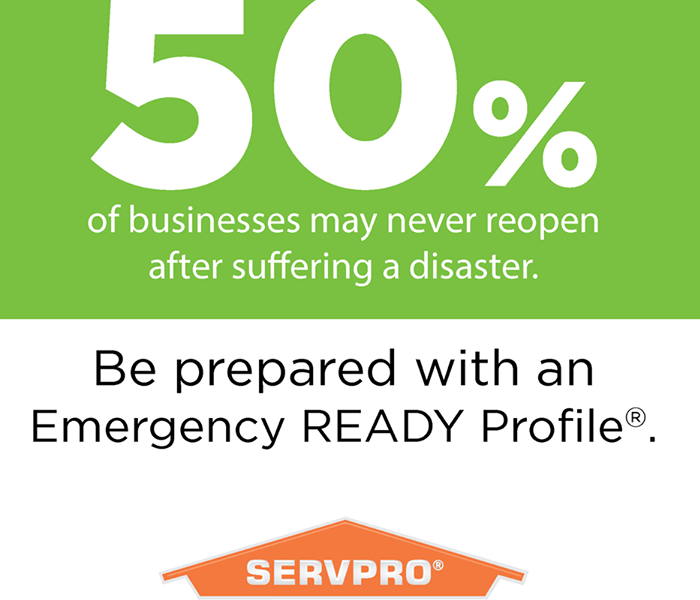 Commercial properties that are ready have a much higher success rate than those that are not. Is your building ready?
Commercial properties that are ready have a much higher success rate than those that are not. Is your building ready?
As a commercial property manager it is you responsibility to be prepared for every contingency. You must have connections and resources at your fingertips. This can be challenging as we move through this new environment with COVID-19. Keeping buildings running, safe and healthy is more important than ever. SERVPRO has the tools you need to keep all your vendors in one place. We also have your cyber security of all of this data covered. Our Emergency Ready Profiles, ensure you can create a secure place for all your contact needs anywhere you need it.
If you are not sure about what the Emergency Ready Plans (ERP) are let us give you a brief overview.
The Best Way to Reduce Business Interruption
Following a Disaster is to Plan For it NOW.
As many as 50% of businesses may never recover following a disaster, according
to the latest industry research. Of the businesses that survive, the overwhelming
majority of them had a preparedness plan in place. Pre-planning can serve as an
insurance policy aimed at peace of mind.
By developing a SERVPRO® Emergency READY Profile for your business, you
minimize business interruption by having an immediate plan of action. Knowing
what to do and what to expect in advance is the key to timely mitigation and can
help minimize how water and fire damage can affect your business.
Are You Ready?
Preparation is a key component for making it through any size
disaster, whether it’s a small water leak, a large fire or an area
flood. The best time for planning for such events is not when
the event happens, but well before it happens. No one ever
plans on a disaster, but you can plan for it. Now is the time to
ask yourself, “Are you ready for whatever could happen?”
The SERVPRO® Emergency READY Profile is a start up
approach that provides the critical information needed to begin mitigation and recovery services. It is designed to serve as a
quick reference of important building and contact information. By working with SERVPRO’s Emergency READY Profile,
your business will receive the benefit of over 40 years of experience in reducing the impact of any natural or man-made disaster.
SERVPRO® is a leader in water and fire damage response and can help you quickly get your property back in working order.
The SERVPRO® Emergency READY Profile Advantage
A no cost assessment of your facility.
– This means there is no need to allocate funds, giving you a great value at no cost.
A concise Profile Document that contains only the critical information needed in the event of an emergency.
– It will only take a little time to complete and will not take you away from current projects.
But it will save a lot of time if ever needed.
A guide to help you get back into your building following a disaster.
– This can help minimize the amount of time your business is inactive by having an immediate plan of action.
Establishes your local SERVPRO® Franchise Professional as your disaster mitigation and restoration provider.
– You have a provider that is recognized as an industry leader and close by.
Identification of the line of command for authorizing work to begin.
– This saves time so we can begin the work of mitigating the damage which can save you time and money.
Provides facility details such as shut-off valve locations, priority areas and priority contact information.
– Having a quick reference of what to do, how to do it and who to call provides solutions in advance
of an emergency so that during the emergency you are “Ready for whatever happens.”
Call Us Today To Get Started! The percent of businesses
that may never recover
after suffering a disaster.
SERVPRO® values the data it processes through our systems and understands our clients’ and business partners’ concerns when it comes to securing their data assets. Therefore, SERVPRO® has made substantial investments in an information security framework to provide protection over data confidentiality, integrity and availability.
Security measures have been built into the SERVPRO® computer network and each application. The ERP application system is one of many tools provided to our Franchises to help them facilitate customer acquisition and retention. Below is a summary of the key security features designed to secure data processed by the ERP System:
1.Access to the ERP application is secured. Access to the ERP system is controlled via a username/password combination that allows the user to view only content that has been assigned to them. Data is only accessible via a secure web service using security standards that prevent malicious attacks.
2.Passwords are protected. Passwords use a one way hash.
3.Data on mobile devices is secured. Security of data is managed at the mobile device level within the Security Settings. For the iOS version, all data and photos are encrypted on the device. For Android version, only data is encrypted on the device.
4.Data is secured in transit. All data transmitted from the mobile device to the SERVPRO® network is sent over a 256 bit encrypted TLS 1.2 Triple DES SHA256 connection.
5.Access to the SERVPRO® network is secured. Firewalls are in place to control external access to the SERVPRO®ERP system.
6.Data in the SERVPRO® network is secured at rest. All ERP data is encrypted at the database level using AES 256.
While these security measures are highlighted for the ERP system, SERVPRO® has a comprehensive security framework inclusive of these controls to provide ongoing security and protection of all data accessed and processed each day.
Understanding your Roof
9/28/2020 (Permalink)
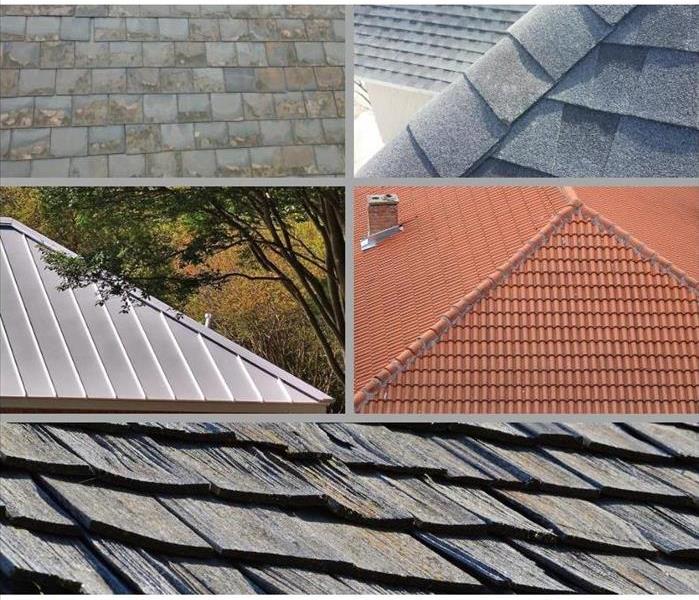 Where you live coupled with what your roof is made out of can be the difference in how your home holds up over time.
Where you live coupled with what your roof is made out of can be the difference in how your home holds up over time.
You may think we at SERVPRO of East Boston, Chelsea, Revere only know water, Fire, & mold. Which we do, but our team is professionally trained to seek out and investigate the cause of a water loss in your home. All too often we discover the damage stems from your roof.
We wanted to take a moment to look at different roofing materials and their 100 year cost of replacements.
While up front cost is always a factor it is important to take a look at the look at the long term cost of having to possibly replace your roof several times over the course of the lifetime.
Read the information below on types of roofing options before reaching out to a professional for help completing your project.
Not only does the shape of the roof need to be taken into account but so does the material that it is made out of. We will take a look at the roofing materials available along with the relative costs for them.
There are a full range of materials, life spans and price ranges for roofs.
Asphalt rolled roofing is the same material as asphalt shingles. The big difference is the pitch of the roof angle. Most rolled roofing is used for garages, sheds, shallow pitched porches. This type of roofing is very short lived 5-10 years at the most. It is important to inspect these frequently and patch any holes rips or tears as soon as possible. The cost of this type of roofing per install is about $2.25 per square foot making it one of the most cost effective however due to its need for frequent replacement could be well over $54,000 every 100 years for an average 2000 sq ft. home over time.
Asphalt shingled roofs are very similar to the rolled roof except they are smaller sections and they have individual pieces. These pieces are made of fiberglass, and may even have slate, quartz, ceramic, or even schist, and the bottom is lined with asphalt. This type of roofing can last up to 40 but as long as 50 years with proper maintenance. While they are all made similar there are varying degrees of consistency. It is important to check warranties and use a reputable contractor for the install. It is very important to not power wash this type of roofing to make sure you do not loosen any of them. This type of roofing can cost about $5 a Sqft and over the course of 100 years could need to be replaced 3-4 times making that lifetime average $30-40 thousand dollars.
A built-up roof (BUR) is a layered roof that is created by alternating layers of roofing felt and waterproof materials such as fiberglass, and hot tar (bitumen). Normally used on roofs that are flat or with a very slight pitch, BUR roofing is fire-resistant and inexpensive, but the roofing is messy and smelly to install. Their life span is longer than rolled roofing. Typically it last 20-30 years making sure debris is removed is essential because it will not have gravity to roll off an angle. The cost for this type of roofing is approximately $4 per sq ft. On average it would be $8000 and over 100 years it will be about $32,000 of cost.
Metal seamed roofs are much more fire retardant than the other options. They are just what they seem large metal sheets that overlap and run vertically. They tend to last 30-50 year nut unlike other options need very little maintenance. Due to them being somewhat new to the market longevity on seams and overall length of time is still being made. Some assessments have them lasting well over 75 years. Their cost are relatively in line with some of the other materials making their life span and low maintenance much more appealing. Coming in at approximately $10 -18 per sq ft depending on the type of metal that you use your 100 year cost would be about $44K
Wood shingles are always an option and have a 25-30 year life expectancy. They do require a precise maintenance schedule and can last up to 50 years. It is important to choose right type of wood. They can be more of a fire risk due to woods flammable nature. It is also important to make sure no moss or lichen grows on it to deteriorate the wood. These shingles can be more costly running any where between $6-11 per SqFt and over the 100 years run you about $60-80K.
Wooden shakes on the other hand are much thicker and hold up a lot better running in a life expectancy of 35-40 years. They are still wood and need to be tended to and maintained on a very stringent schedule. They are still just as flammable and in some areas are banned for just that reason. If there are any that get damaged they must be replaced immediately, you must also check and replace any bowed, convex, concaved or split shingles to avoid water infiltration into your home. Due to them being thicker they are more costly running around $13 per SQ Ft over 100 years you could be looking at well over $70K
Clay and cement tiles are very durable and strong. Terracotta is the medium that is typically used but fired clay and concrete can also be used. You must have an extremely strong support structure as they are very heavy. It is important to never walk on them as cracking is their big concern. You much replace cracked ones immediately. The up side is this type of roofing can last well over 100 years or more. Making it one of the few once and done options for a home owner. Depending on what sort of material you use you can expect to pay some where between $15-20 sq ft having a 100 year cost of approx $44K
Slate while still a form of stone is very different from others as it comes directly out of the earth like that. This roof has the same life span as clay and tile well over 100 years sometimes they have lasted upwards of 200 years, if they are properly maintained. Their costs can be anywhere from $10-75 a square foot making it the most expensive options. However if you look at the longevity of this material it does earn its value as some will last 100-200-or even 300 years.
No matter what roofing you choose or have one common theme is they must all be properly maintained. You must also inspect your roof, attic or crawl space within your home. This will allow you to catch any problems. Please make sure if you have gutters they are cleaned and free of debris so that do not get clogged and pull away from the home. It is important to not only address the water damage that can not be done until you find the source of the water damage first.
Roofing materials article
https://www.thespruce.com/best-roofing-materials-for-longevity-1821951
Your roof and storm damage prevention
9/24/2020 (Permalink)
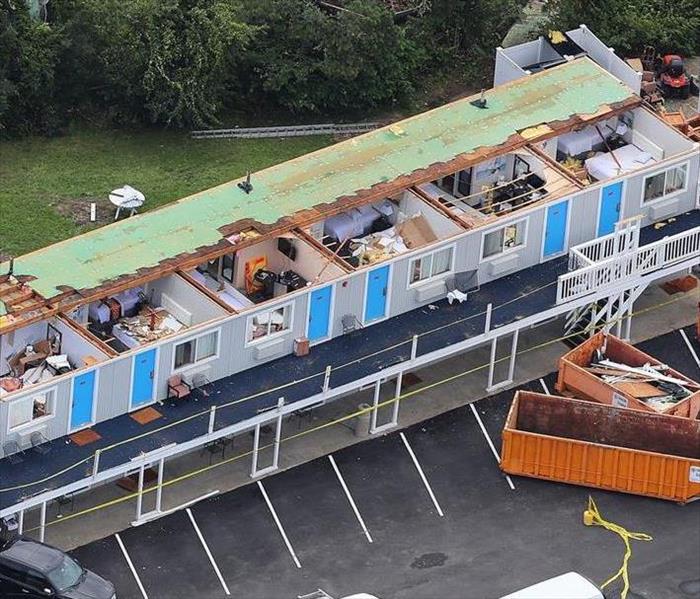 Wind damage can be just as devastating as flood damage. Inspect your roof and use the best materials you can afford
Wind damage can be just as devastating as flood damage. Inspect your roof and use the best materials you can afford
Certain home shapes and roof types can better resist high winds and hurricanes, according to a researcher at New Jersey Institute of Technology (NJIT). Civil engineer Rima Taher, PhD, special lecturer in the New Jersey School of Architecture at NJIT. She spent two years examining the findings of research centers that have studied the best designs and construction materials and methods needed to withstand extreme wind events and hurricanes.
"Although I'd like to say that there is a simple and economical solution for housing that won't fail or collapse in the perfect storm, such information does not yet exist," said Taher. "However, it is obvious that thanks to the work of wind engineers and researchers that changes to home design and construction can make buildings safer for people, while saving government and industry billions of dollars annually."
"Design of Low-Rise Buildings for Extreme Wind Events" (Journal of Architectural Engineering, March, 2007) by Taher highlighted such research findings. Wind researchers at the Center for Building Science and Technology (CSTB) in France, researched and tested reduced-scale home models at its wind tunnel facilities, and developed a prototype of a "cyclonic" or hurricane-resistant dwelling. Taher cooperated with the CSTB wind researchers, working on the structural aspect of the home's design.
That design eventually became an elevated structure of a square plan form on an open foundation. The home had a hip roof and was equipped with a central shaft with aerodynamic features designed to reduce wind forces during an extreme wind event. Wind tunnel tests at CSTB showed that such a home would be far more efficient under high winds and hurricane conditions than a typical structure. CSTB is working with a builder to construct a prototype of such a home on Réunion in the West Indian Ocean.
From this work and other studies Taher recommends the following construction considerations for homeowners in hurricane-prone regions.
- A home with a square floor plan (or better a hexagonal or octagonal plan) with a multiple-panel roof (4 or more panels) was found to have reduced wind loads.
- Roofs with multiple slopes such as a hip roof (4 slopes) perform better under wind forces than gable roofs (2 slopes). Gable roofs are generally more common because they are cheaper to build. A 30-degree roof slope has the best results.
- Wind forces on a roof tend to be uplift forces. This explains why roofs are often blown off during an extreme wind event. Connecting roofs to walls matters. Stapled roofs were banned following Hurricane Andrew in Florida in 1993.
- Strong connections between the structure and its foundation and connections between walls are good. Structural failure is often progressive where the failure of one structural element triggers the failure of another, leading to a total collapse. Connections are generally vulnerable but can be inexpensively strengthened.
- Certain areas of a building such as the ridge of a roof, corners and eaves are normally subject to higher wind pressures. In the cyclonic home design, CSTB researchers proposed some aerodynamic features to alleviate these local pressures such as introducing a central shaft which would function by creating a connection between the internal space and the roof ridge considered to be the location of the largest depression. This connection helps balance pressures leading to a significant reduction in the roof's wind loads.
- Roof overhangs are subject to wind uplift forces which could trigger a roof failure. In the design of the hurricane-resistant home, the length of these overhangs should be limited to 20 inches.
- The design of the cyclonic home includes simple systems to reduce the local wind stresses at the roof's lower edges such as a notched frieze or a horizontal grid to be installed at the level of the gutters along the perimeter of the home.
- An elevated structure on an open foundation reduces the risk of damage from flooding and storm-driven water
Not only does the shape of the roof need to be taken into account but so to the material that it is made out of. We will also take a look at the roofing materials available along with the relative costs for them.
Asphalt Roll Roof
Asphalt roll roofing is made from large rolls of the same material used in asphalt shingles. Used for relatively flat pitches, such as angled shed roofs, roll roofing is installing by laying strips lengthwise across the roof in overlapping courses. Roll roofing is a fairly easy material to install, and many DIYers do this themselves. But it is better suited for sheds, garages, and perhaps porch roofs, and is not a very good solution for most home roofs.
Average Lifespan
Asphalt roll roofing can be expected to last from 5 to 10 years, at most. Getting maximum life from the roofing is really just a matter of keeping it clear of debris and quickly patching any punctures or damage that occurs.
Installation Costs and Lifetime Value
Asphalt roll roofing is normally installed on roofs with a relatively flat peak, so a 2,000 square foot house will have very close to 2,000 square feet of roof area. Average costs for installing this roof are about $2.25 per square foot, for a total average cost of roughly $4,500. But assuming that this roof will likely need to be replaced perhaps 12 times over 100 years, total costs over this period, in today's dollars, can be as high as $54,000 over 100 years.
Built-Up Roofing (BUR)
A built-up roof (BUR) is a layered roof that is created by alternating layers of roofing felt and waterproof materials such as fiberglass, and hot tar (bitumen). Normally used on roofs that are flat or with a very slight pitch, BUR roof. It is fire-resistant and inexpensive, but the roofing is messy and smelly to install.
Average Lifespan
BUR roofs typically last from 20 to 30 years. Maximizing the lifespan of a built-up roof is accomplished by regular inspection and repair, and by keeping debris off the roof to prevent degradation of the surface.
Installation Costs and Lifetime Value
Built-up roofing average about $4 per square foot, installed. On a 2,000 square foot house with a roof very close to that square footage, average professional installation costs about $8,000. Assuming that this roof will need to be replaced about four times over a 100 year period, average roofing costs in today's dollars are about $32,000 over 100 years. However, this type of roof is not suitable for a home with any real slope to the roof.
Composite Asphalt Shingle Roof
Composite shingle roofing is the most popular of all roofing materials, found on more than 80 percent of all homes. Composite shingles use either an organic or fiberglass base that is saturated with asphalt, coated on the bottom side with asphalt, and the exposed surface impregnated with small chips of slate, schist, quartz, or ceramic granules. The vast popularity of shingles owes to the relatively low cost, easy installation, and decent life expectancy. These roofs are normally installed by professional crews, but installation is not out of reach for a skilled DIYer.
Average Lifespan
Composite asphalt shingles can be expected to last 15 to 40 years, depending on the quality of the materials chosen. Some shingle roofs may even last as long as 50 years. Most shingle roofing manufactures offer a range of products in different weights and different life expectancies. Manufacturers like Owens Corning, GAF, or Certainteed come with accordingly high-end warranties pushing a half-century.
Maximize the lifespan of asphalt shingle roofs by avoiding cheap shingles and avoiding walking on them. Keep them free of moss, and never power wash an asphalt shingle roof.
Installation Costs and Lifetime Value
On average, asphalt shingle roofs cost around $5 per square foot to instal,l although the price range can be substantial, depending on the types of shingles selected and the labor costs from region to region. Assuming that a 2,000 square foot house with a typical roof slopes has a roof square footage of about 2,200 square feet, that roof averages about $11,000 for professional installation. Assuming this roof might be replaced three to four times, an asphalt shingle roof will cost, in today's dollars, $33,000 to $44,000 over 100 years. Since a typical homeowner rarely lives in a home for more than 30 or 40 years, during which they may reroof only once, asphalt shingles make for a fairly cost-effective roofing material from most people.
Wood Shingle Roof
Wood shingle roofs are made from thin, wedge-shaped pieces of natural wood, such as cedar or yellow pine, which are sawn from logs. They make for an extremely attractive roof but are tricky to install and not suitable for most DIYers. Be aware that growing fire hazards in some regions has caused legal restrictions on the use of wood roofing materials. They are not a good choice in any location where there are seasonal wildfire hazards.
Average Lifespan
Wood shingle roofs average about 25 to 30 years in longevity, though longer lifespans are sometimes achieved in locations where the roof experiences mild conditions and remains free of debris. Meticulously maintained, wood shingle roofs can last for 50 years. To extend the life of a wood shingle roof, make sure to replace split and cracked shingles immediately, and keep the roof free of moss.
Installation Costs and Lifetime Value
Wood shingles are more expensive than asphalt shingles, costing between $6.50 and $11.00 per square foot, installed. Assuming an average of about $9 per square foot, a 2,000 square foot house with 2,200 square foot of standard sloped roof will cost $19,800 to roof. Assuming this roof will need to be replaced at least three or four times over a century, costs can be as high as $60,000 to $80,000 over 100 years, calculated in today's dollars.
Wood Shake Shingle Roof
Wood shakes are a thicker material than wood shingles, and they can be expected to stand up better than wood shingles to weather and UV rays. They are not suitable for most DIYers to install, requiring professional installation. Like wood shingles, shakes may be restricted in regions where wildfires are a known hazard.
Average Lifespan
Wood shake roofs can be expected to last 35 to 40 years, though longer life is not rare. To maximize lifespan, you do need to baby them and practice proper maintenance. There is no "set it and forget it" option for any wood roofing material. Remove debris as soon as it falls on the roof. Eliminate moss. Replace split shakes right away. Replace curled, cupped, or split shakes immediately.
Installation Costs and Lifetime Value
Both the materials and installation are more expensive for shakes than for wood shingles. You can typically count on shakes being about 50 percent more expensive than shingles. Based on an assumption of $13 per square foot, a 2,000 square foot house with 2,200 in sloped roof square footage will cost $26,000 to install. If three installations are required over a century, average costs in today's dollars would run $78,000 over 100 years.
Standing-Seam Metal Roof
An increasingly popular type of roofing, especially in areas prone to wildfire danger, standing-seam metal roofs are made from large steel panels laid on the roof deck with the seams overlapping in raised ridges that run vertically along the roof slope. Metals used are usually steel or aluminum, although copper and zinc are also used. These roofs are virtually maintenance free, and very durable. They are not suitable for DIY installation, however.
Average Lifespan
Standing-seam metal roofs have a lifespan of 30 to 50 years, but as a relatively new product, information is still being gathered. In good circumstances, metal roofs may well last 75 years. To maximize lifespan, regularly check them to make sure that fasteners and sealants haven't failed, and inspect for distressed, bent, or slipped panels.
Installation Costs and Lifetime Value
Costs for standing-seam metal roofs average about $10 per square foot for steel or aluminum, $13 per square foot for zinc, and $18 per square foot for copper. For a 2,000 square foot house with 2,200 in sloped roof area, average national costs for a steel panel roof are about $22,000. But there is strong evidence that improved metal roofs now being sold may routinely last 50 years. If a metal roof is replaced only once, costs in today's dollars are $44,000 over 100 years.
Is Metal Roofing the Best Value?
For a homeowner who lives in a home for 30 to 40 years before selling, a single $22,000 re-roofing expense might be the only one ever incurred if using metal roofing. And if you are shopping for a new home, buying one with a metal roof may mean you'll never face a re-roofing project at all. In many ways, standing-seam metal roofs might be a more cost-effective option then the far more popular asphalt shingle roof.
Clay or Cement Tile Roofs
Clay tile roofs are very popular in the Southwest, but they can be found anywhere in the country, thanks to their incredible strength and durability. Traditional tiles are made from terracotta clay, but there are also ceramic tiles roofs (made of fired clay), as well as concrete tile roofs. All consist of individual tiles installed in overlapping layers over the roof surface, and all have roughly the same degree of strength and durability. They require a sturdy roofing framing sufficient to hold the weight and must be installed by skilled professionals. This may well be the only roof your home ever needs.
Average Lifespan
Clay tile roofs routinely last 100 years or more when properly maintained. Tile roofing's Achilles heel is not decay, as with wood shake or shingles, nor the slow sloughing off of mineral grains, as with composite shingles. Rather, cracking is what can doom tile roofs. Avoid walking on your tile roof as much as possible. When efflorescence develops, as often happens with terracotta, buff it off with a clean, dry towel. Coat the tiles with a clear alkyd primer. Replace cracked and broken tiles as soon as you spot them.
Installation Costs and Lifetime Value
Costs vary considerably, depending on whether the tiles are traditional clay terracotta, fired ceramic, or concrete. Concrete tiles can cost around $10 per square foot, installed; terra cotta can range from $15 to $20 per square foot installed; and ceramic tile, from $20 to $30 per square foot, installed. If installing a traditional Spanish clay tile roof at $20 per square foot, costs for a 2,000 square foot house with 2,200 of sloped roof area would be $44,400. However, since this roof will very likely last a century, costs in today's dollars would remain $44,000 over 100 years. If you are really concerned about future owners, a tile roof is a great choice. And if you are shopping for a new home, a tile roof less than 50 years old may well be a house you'll never need to reroof.
Slate Roof
Slate is another version of a stone roof, but rather than being made from molded clays or concrete, these are roofs covered with actual stone hewn from rock mined from quarries. Slate has a natural tendency to split into flat slabs, making this the ideal natural stone to cover roofs. Slate must be installed by trained craftsmen. It is the most expensive of common roofing materials, but also the most durable of all. Properly maintained, it can potentially last the lifetime of your home
even if that lifetime is two centuries long. Because of the expense, this is a roofing material usually used on large, luxury homes.
Average Lifespan
This is a roof that can easily last 100 years or and far more. There are slate roofs still in operation that literally date back to Shakespeare's time. To achieve this kind of longevity, immediately replace any broken slate tiles you see. Make sure that all flashings are correctly installed and in good working order. When your copper flashing has turned black, it is time to replace it.
Installation Costs and Lifetime Value
There is quite an enormous variation in costs for a slate roof, which can range from around $10 per square foot to as high as $75 per square foot, installed. Assuming an average installation cost of $30 per square foot, a 2,000 square foot home with 2,200 in sloped roof area can cost roughly $66,000 to roof with slate. That 's the only cost ever incurred though. Ever. At today's dollars, a slate roof would cost $66,000 over 100 years. And $66,000 for 200 years. And $66,000 for 300 years...
No matter what materials your roof is made out of, how new, or well maintained it is there will be times when the weather can cause damage to your roof and cause water damage to your home. It is important to check its condition often and repair damages immediately to avoid costly water damage repairs down the road.
Roofing materials article
https://www.thespruce.com/best-roofing-materials-for-longevity-1821951
Article by science daily.
https://www.sciencedaily.com/releases/2007/06/070619155735.htm
Photo: Boston Globe
Commercial Real Estate In the"New Normal"
9/24/2020 (Permalink)
 The commercial industry must adapt, & change to the new needs of businesses to entice places for companies to reintroduce their work force safely
The commercial industry must adapt, & change to the new needs of businesses to entice places for companies to reintroduce their work force safely
The new normal for a while will look very different. If you are a property manager, work in a multi-use building, or commercial building many of us may be headed into these buildings. What that will look like will vary. One thing to be certain there will be changes no matter where you go. This article by the NAIOP Commercial Real Estate Development Association broaches this topic about our new Normal.
Real Estate will change, as companies make longer term decisions. Larger commercial properties may see vacancies or need to undergo remodels. Existing businesses may downsize as they keep their workforce remote. How properties and property management companies handle these shifts and adapts will shape the market moving forward. Updating key components of the air handling systems, safety measures and cleaning measures can all be ways to attract and fill those empty spaces.
The coronavirus pandemic has accelerated social and economic changes that were underway before the outbreak, while also leading consumers, workers and employers to adopt new preferences and behaviors. Collectively, these changes will require that commercial real estate firms adopt new approaches to design, customer relations and business operations to be successful in the future. Christopher Lee, founder and CEO of CEL & Associates, offered his predictions for how the outbreak will reshape demand for commercial real estate in the U.S. and outlined steps that firms can take to remain competitive during a recent NAIOP webinar.
Lee observed that the commercial real estate market is currently about halfway through a downturn. Although the Federal Reserve’s intervention in credit markets and fiscal stimulus measures have mitigated some of the outbreak’s effects on the economy, “all of that is going to burn off fairly soon unless another economic stimulus comes forward.” Substantial economic uncertainty and fears about the coronavirus have paralyzed decision-making in most markets. Buyers are concerned about the pandemic’s effects on building revenues and expenses as well as potential liabilities from infections, and some may no longer be able to secure favorable financing for an acquisition. Sellers are uncertain whether they should sell now or wait out the pandemic, and are unsure whether they will have good options for investing the proceeds of a sale.
The pandemic is impairing economic growth and contributing to higher levels of unemployment. In turn, these trends will reduce demand for most types of real estate. Although Lee observes that the industrial sector has performed well during the outbreak, he expects that declining rents in other sectors will result in an aggregate decline in commercial real property values of 7-10% during the current downturn. However, Lee is optimistic about commercial real estate’s role in an economic recovery. “We’ve gone through these crises before […] and during and after every one of these crises, the real estate industry has always emerged as one of the pivotal drivers of financial and economic revival.”
Effects Will Vary by Sector
Lee anticipates long-term shifts in business operations and consumer preferences that will lead to changes in demand for each sector of commercial real estate. He expects that the digitization of office functions will reduce space demand from tenants, with 40-55% of work that was formerly performed within offices to be performed remotely by 2025. He also expects a 20-25% reduction in per capita retail square footage in the U.S., with up to 50% of retail space being repurposed over the next decade. Remaining retail centers will need to be reconfigured to facilitate curbside pickup and to support delivery services.
Multifamily building owners can respond to the increased tendency for residents to remain at home for work and entertainment by providing them with enhanced connectivity and by augmenting common areas with sensors, smart walls and voice assistants. In the future, tenants may also come to expect onsite emergency equipment and quarterly “health certifications” for onsite personnel and common areas. Multifamily developers should consider updating designs to include areas for delivery services within buildings and drop-off zones in parking lots.
Lee predicts that factors such as government stockpiling of medical supplies; onshoring of pharmaceutical and medical device supply chains; and growth in e-commerce will contribute to demand for industrial real estate. However, tenants will also likely expect owners of industrial buildings to equip them with improved air ventilation systems, antimicrobial technologies and motion detectors that can replace frequent touch points.
How Firms Can Remain Competitive
Lee advises that real estate firms develop a post-pandemic strategic plan that will allow their businesses to thrive in these new contexts. “You cannot be reactive […] You really need to make sure that you are not doing things differently. You need to do different things.” The firms that will recover most rapidly are those that proactively adopt a more decentralized and agile organizational structure and embrace communications, remote work and compliance technologies that support this structure.
Lee identified specific steps that firms can take to improve their resiliency against future crises. He suggests growing recurring income from sources such as property management until they fully cover overhead expenses. Healthy balance sheets and a large “rainy day” fund are also important priorities. Firms can improve their ability to respond to rapidly changing circumstances by creating contingency plans and outsourcing non-core business functions to independent contractors. Investments in research, analytics and client engagement can help a firm identify emerging trends and adapt operations to meet client expectations.
Lee also said he expects that the current crisis will accelerate a wave of retirements in the real estate industry. In this context, it is important that firms emphasize on talent management. Recruiting and retaining high potential employees and emerging young talent will begg vital to a firm’s future success. “If you don’t take care of your emerging young talent, then there won’t be a future for your company.”
NAIOP article.
https://blog.naiop.org/2020/06/preparing-for-a-new-normal-in-commercial-real-estate/
Content and strategies shared on NAIOP blog posts are intended to provide information and insights to industry practitioners and do not constitute advice or recommendations. NAIOP and its blog authors disclaim any liability for actions taken as a result of these blog posts.
Photo: Exponea
Different types of water damage.
9/22/2020 (Permalink)
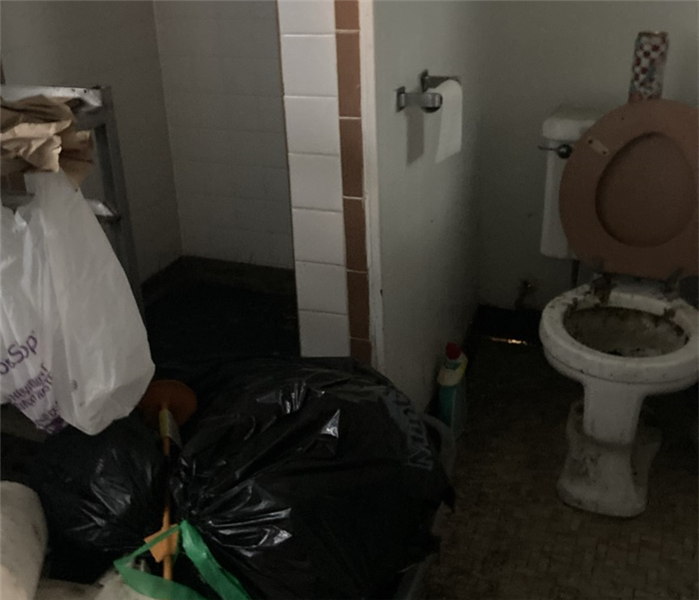 Black water from a sewage back up can not only cause a lot of damage but create an unhealthy living environment
Black water from a sewage back up can not only cause a lot of damage but create an unhealthy living environment
There is so much more to water damage than what you can see that is wet. Along with hidden damage you have to be aware that water damage can come from a wide variety of sources. Some of which may be in your home while others could be caused by nature. That being said where the water comes from is all classified and treated differently. It is important to understand these different types of water classifications as they should all be treated differently.
One important thing to keep in mind is that these water classifications do not have much if anything to do with the actual color of the water but more so the level of contaminants in the water itself. There could be a lot of bacteria, virus, or chemicals in the water that you can not see. It is essential that you keep out of the water if you are not sure of its contamination level or if you think that it could be Black water. Reducing exposure to your self or spreading the contamination around to other unaffected areas of your home.
Lets take a look at the types of water that can cause water damage.
Clean Water:
Clean water is also known as category one water, the safest of all water damage. This type of damage usually comes from an unattended overflowing sink or a broken water line. Consuming this type of water would pose no health risks to humans or animals and thus, is usually the easiest to fix.
Most cleaning companies would go in, inspect the incident, extract the water, and then thoroughly dry the area. Because there are no microbes in clean water, the process isn’t as complex as it would be with more serious cases.
Gray Water:
Gray water is more serious than clean water and can occur if you leave clean water dormant for a period of over 24 hours. A good example of a gray water incident would be a toilet overflowing. There are microbes in toilet water and consumption of that water could lead to illness and at the very least, an upset stomach.
One of the most important pieces to gray water is preventing the spread of the microbes inside the water. That’s why you usually leave the work to the professionals. But if you want to start the restoration process before the service crew arrives, make sure to keep your skin covered at all times to minimize the risk of exposure to your body and to other areas of your household.
Black Water:
Black water is the most serious of all three water damages. This type of damage usually occurs due to sewage or, in some cases, natural disasters such as hurricanes and heavy flooding. It’s extremely important that you keep yourself away from black water as it can contain anything from chemicals and pesticides to bacterial diseases that will do serious bodily harm if they get inside you.
If you are in a situation where black water has contaminated your home, call the professionals Do not clean it up yourself. You won’t have the proper equipment or knowledge to properly clean and remediate your home.
The dangers of Black Water shouldn’t be ignored. Even being exposed to the air around black water can lead to serious respiratory problems. Coming in contact with it can lead to serious illness and even death in some cases.
Please keep in mind that often times this water is not actually black in color. Where the water comes from determines its classification. This could be water that comes up through a toilet or sewer system as an example. Visually the water could look very normal yet contain chemicals, microbes, virus and or bacteria. If you have water damage in your home and you are not 100% sure where it came from call the professionals.
Do you have time if it is clean water?
No you do not have extra time. Once clean water leaves the confines of its controlled source it is exposed to a lot of different ways. Water can pass through a wall that a rodent may have left some droppings. It could be left pooling and an insect could come in contact with it. As it sits it is possible spores and fungi can begin to make their homes on wet materials become permanently ruined or worse grow something more sinister.
Regardless of where the water comes from damage seems to come from an overflowed bathtub or leaking pipes, immediately call for help. If allowed to sit, clean water can turn into gray water which will only do more damage to your home. This can make things worse and it can also cause permanent damage. If this is an insurance claim the insurance company could determine this to be secondary damage and deny coverage for it leaving you on the hook for some serious expenses.
No matter what the cause of the water loss Say you find yourself in a situation where the water damage was out of your control. It can bring its own series of problems such as mold, sewage, or traditional flood damage from a storm. There are also solutions for these types of problems as well.
What to Do in the Case of Molding
One of the biggest problems that can arise from water damage is molding. This can occur whenever water damage is present for a long period of time, usually in the case of heavy flooding or sink overflow.
If mold is left by itself, it can easily destroy the structure of your home and cause damage that’s permanent. It can make furniture useless and decorate your walls with green spots. Therefore, it’s important to call right away if you start seeing mold show up.
Companies that have 24/7 emergency cleaning services are especially good to know about because they can assist you whenever and however you want. This makes mold removal much easier to handle.
DO NOT tackle Sewage Damage
If you have sewer damage make sure you call a professional immediately. It’s not only black water but once the water subsides, there’s going to be bacteria on bacteria–not to mention the bad smell–inside your home and only the qualified professionals will know how to take care of it.
If not taken care of right away, the sewage damage will eventually lead to structural injuries and contamination.
Flood Damage
We have seen increasing flood events here in the Northeast coupled with failing drainage systems, flooding is becoming a more serious issue that affects homeowners across. Sometimes, even with your best efforts, the damage occurs, nonetheless. So, what do you do?
Number one thing to do is get out of flood waters the speed at which they travel can even be life threatening in as little as an inch of moving water. Once you are able to safely return to your home it is important to take an inventory of what is and is not still within the home. Coupled with what is and is not damaged. Call your insurance company and start talking about rebuilding. Checking your policies before you need them is the best way to ensure you are covered for wat ever life throws at you.
Major Flooding events are on the rise.
9/22/2020 (Permalink)
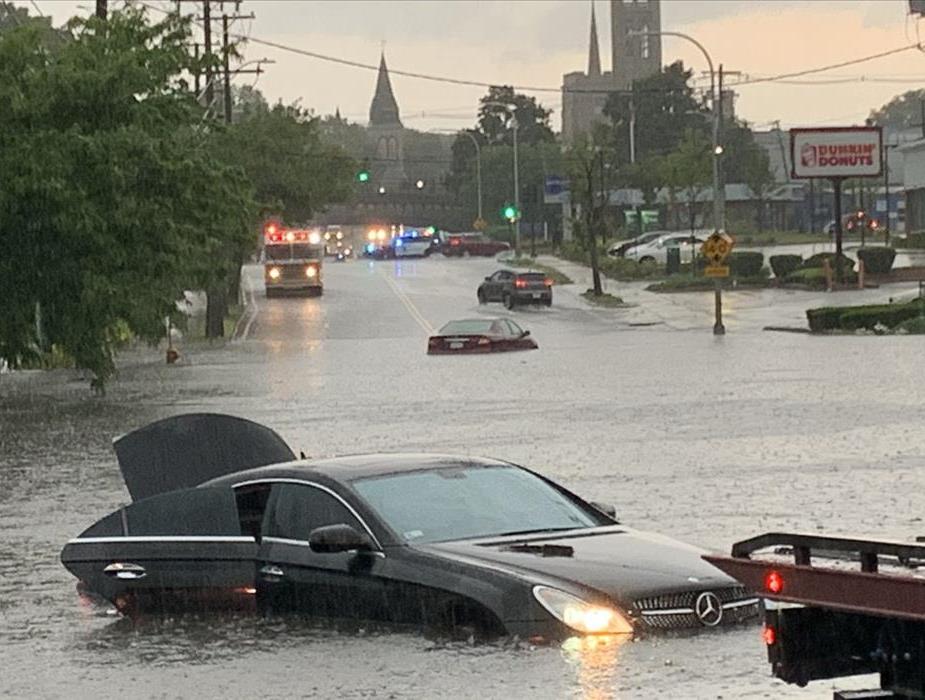 Due to aging sewer systems, increased storm events and rising seas Mass towns are experiencing more flooding than ever.
Due to aging sewer systems, increased storm events and rising seas Mass towns are experiencing more flooding than ever.
A story published by the Guardian back in 2018 indicated that flooding events were on a significant rise.
Global floods and extreme rainfall events have surged by more than 50% this decade, and are now occurring at a rate four times higher than in 1980, according to a new report.
Other extreme climatological events such as storms, droughts and heatwaves have increased by more than a third this decade and are being recorded twice as frequently as in 1980, the paper by the European Academies’ Science Advisory Council (Easac) says.
The paper, based partly on figures compiled by the German insurance company Munich Re, also shows that climate-related loss and damage events have risen by 92% since 2010.
Prof Michael Norton, Easac’s environmental program director, said that greenhouse gas emissions were “fundamentally responsible for driving these changes”.
Trends towards extremes are continuing,” he said. “People have experienced extreme weather already - big switches [between] warm and cold winters - but the frequency of these shifts may be changing.”
“Some of the underlying drivers of extreme weather which were speculative four years ago are now looking less speculative and [more like] credible hypotheses. That is the weakening of the Gulf Stream and the meandering behavior of the jet stream.”
The Easac study, Extreme weather events in Europe: Preparing for climate change adaptation, looked at new data and models focused on a potential slowdown of the Atlantic Gulf Stream, due to an influx of freshwater from melted ice sheets in Greenland.
It was compiled by experts from 27 national science academies in the EU, Norway and Switzerland, although the data was not peer-reviewed.
The UN’s Intergovernmental Panel on Climate Change (IPCC) has assessed the probability of a slowdown before 2100 at more than 90% - or “very likely”. However, a complete “switch off of the gulf stream – or Atlantic Meridional Overturning Circulation (AMOC) – is increasingly thought possible by some scientists.
Some studies say this could lower land temperatures in the UK, Greenland, Iceland and Scandinavia by up to 9C.
UK arrays positioned in the north Atlantic measured a 30% drop in AMOC strength between 2009-10, the Easac study says. And while uncertainties persist about the pace and scale of possible future changes, the decline in Gulf Stream strength itself has now been “confirmed”.
Citing “gathering evidence of an emerging negative phase” in Atlantic temperature swings driven by a weakening Gulf Stream, the study calls for research to be stepped up.
Did you know there are different types of flood events. They are all dangerous yet all come with very different types dangers. Knowing where you live and the type of flood your family and home could be subjected too is essential in how you prepare for them. Zurich insurance put a wonderful article about the various types of flood for you to assess.
To plan for floods, you need to understand the type - or types - of flood you may face. Each one bears a different impact in terms of how it occurs, how it is forecast, the damage it causes, and type of protection you need.
Fluvial floods (river floods)
A fluvial, or river flood, occurs when the water level in a river, lake or stream rises and overflows onto the surrounding banks, shores and neighboring land. The water level rise could be due to excessive rain or snowmelt.
The damage from a river flood can be widespread as the overflow affects smaller rivers downstream, which can cause dams and dikes to break and swamp nearby areas..
To determine the probability of river flooding, models consider past precipitation, forecasted precipitation, current river levels, and well as soil and terrain conditions.
The severity of a river flood is determined by the duration and intensity (volume) of rainfall in the catchment area of the river. Other factors include soil water saturation due to previous rainfall, and the terrain surrounding the river system. In flatter areas, floodwater tends to rise more slowly and be shallower, and it often remains for days. In hilly or mountainous areas, floods can occur within minutes after a heavy rain, drain very quickly, and cause damage due to debris flow.
To determine the probability of river flooding, models consider past precipitation, forecasted precipitation, current river levels, and well as soil and terrain conditions.
Pluvial floods (flash floods and surface water)
A pluvial flood occurs when an extreme rainfall event creates a flood independent of an overflowing water body. A common misconception about flood is that you must be located near a body of water to be at risk. Yet pluvial flooding can happen in any location, urban or rural; even in areas with no water bodies in the vicinity. There are two common types of pluvial flooding:
- Surface water floods occur when an urban drainage system is overwhelmed and water flows out into streets and nearby structures. It occurs gradually, which provides people time to move to safe locations, and the level of water is usually shallow (rarely more than 1 meter deep). It creates no immediate threat to lives but may cause significant economic damage.
- Flash floods are characterized by an intense, high velocity torrent of water triggered by torrential rain falling within a short amount of time within the vicinity or on nearby elevated terrain. They can also occur via sudden release of water from an upstream levee or a dam. Flash floods are very dangerous and destructive not only because of the force of the water, but also the hurtling debris that is often swept up in the flow.
Coastal flood (storm surge)
Coastal flooding is the inundation of land areas along the coast by seawater. Common causes of coastal flooding are intense windstorm events occurring at the same time as high tide (storm surge), and tsunamis.
Storm surge is created when high winds from a windstorm force water onshore — this is the leading cause of coastal flooding and often the greatest threat associated with a windstorm. The effects increase depending on the tide - windstorms that occur during high tide result in devastating storm surge floods. In this type of flood, water overwhelms low-lying land and often causes devastating loss of life and property.
The severity of a coastal flood is determined by several other factors, including the strength, size, speed, and direction of the windstorm. The onshore and offshore topography also plays an important role. To determine the probability and magnitude of a storm surge, coastal flood models consider this information in addition to data from historical storms that have affected the area.
Below you will find a link not including 2020 as we are still running through the list of named storm for the seasons. We are currently in one of the most active seasons in recorded history.
https://www.usgs.gov/mission-areas/water-resources/science/historical-flooding?qt-science_center_objects=0#qt-science_center_objects
This
Guardian Article.
https://www.theguardian.com/environment/2018/mar/21/flooding-and-heavy-rains-rise-50-worldwide-in-a-decade-figures-show
Zurich Article
https://www.zurich.com/en/knowledge/topics/flood-and-water-damage/three-common-types-of-flood
Image Used from
https://www.masslive.com/weather/2020/06/holy-flash-flooding-massachusetts-residents-share-photos-of-golfball-sized-hail-lightning-strikes-and-street-flooding-from-sunday-night-storm.html
2020 hurricane season in full force
9/22/2020 (Permalink)
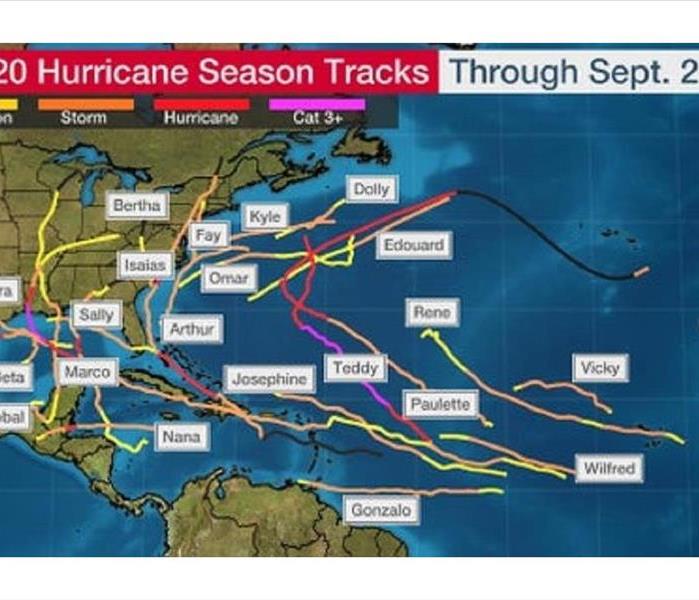 We are in unprecedented hurricane season with some of the strongest storms ever to hit land & possibly the largest number of named storms
We are in unprecedented hurricane season with some of the strongest storms ever to hit land & possibly the largest number of named storms
2020 is shaping up to quite the year. Not only from the infamous Covid-19 virus but the weather has us all a bit on edge. The challenge of facing this virus outside of the safety of your own home can be daunting.
There have been more named storms during this season than any, other than the 2005 season where they ran out of letters and actually got to Zeta in the Greek alphabet. This season has produced some of the strongest storms ever to make landfall.
USA today had an article back in June in which Rachel Cleetus, also of the Union of Concerned Scientists, said that even without the pandemic, this "would be a challenging hurricane season," due to the predicted number of storms. It really positioned the nation’s ability to keep people safe to be severely tested, she added, and in large part depends on how well FEMA and state and local authorities work together under these unprecedented circumstances.
FEMA said it's ready for hurricane season: "While FEMA continues to lead federal operations during the whole-of-America's COVID-19 response, we continue to take deliberate and proactive steps to respond to and recover from future disasters, such as hurricanes, while responding to COVID-19."
Nursing homes are at particular risk during a hurricane, according to Weather.us meteorologist Ryan Maue.
"(What's) very important during hurricane season is to prepare those in elderly housing including nursing homes for potential storm impacts," he said. "This is just one of many areas where the coronavirus pandemic and hurricane season intersect."
Cleetus pointed out that hurricane season lasts until Nov. 30, and public health experts are warning of a surge in infections later this year.
"We're not out of the woods in terms of the public health challenge," she said.
At the American Red Cross, Trevor Riggen, senior vice president of disaster services, said, "disasters won’t stop during the coronavirus outbreak – so as we head into hurricane season, our goal is to provide anyone in need after a disaster with comfort and support."
He added that amid the coronavirus crisis, Red Cross will provide some relief services virtually, including mental health support and financial assistance, thanks to investments in items like laptops, wireless hotspots and mobile devices.
"Instead of opening shelters, we’re prioritizing individual hotel rooms or dormitory style rooms to make sure people have a safe place to stay if they can’t return home after a disaster," Riggen said.
Know where your loved ones are, understand the plan if and when disasters strike. Being prepared is your best defense.
As the enclosed article by popular science states we are in a very active pattern and it is not done with us yet.
The frighteningly active hurricane season is continuing to live up to meteorologists' predictions. Just a few weeks after Hurricane Laura—the strongest storm on record to make landfall in Louisiana—brought devastating storm surges and rainfall to the Gulf Coast, there are now five more named storms in the Atlantic. The last time this many storms occupied this area was 1971, when there were six storm systems that were tropical depressions or greater.
Hurricane Sally is now a Category 1 storm, but is expected to bring a “historic flood event” to coastal Alabama and the western Florida panhandle. Though the storm isn’t as ferocious in terms of wind speed, it’s moving slowly. Hurricanes that inch along can actually bring more destruction as they hover over an area, dumping immense amounts of water in one spot. The governors of Alabama, Mississippi, and Louisiana have all declared states of emergency.
Hurricane Paulette made landfall in Bermuda On Monday, and will likely peter out over the open ocean in the coming days. Tropical storms Teddy and Vicky are still out in the middle of the Atlantic. Teddy is likely to strengthen as it heads towards Bermuda, while Vicky is expected to dissipate by the end of the week. There’s also a tropical depression and an area to watch off the western coast of Africa.
The 2020 hurricane season has been staggeringly active. We are already at V on this year’s list of storm names. We previously reached this point with Hurricane Vince in 2005, but that’s the only other time since record-keeping began in 1851—and we’re 25 days ahead of that record. Hurricane season stretches into November, which means we have at least another month of storms.
At this rate, we’re likely to run out of names. The only other season in which that happened was, again, 2005. Our current naming system is run by the World Meteorological Organization, which keeps a list of names to cycle through in each storm basin. Here in the Atlantic we have one list, but storm systems in the Indian Ocean have their own names to work through, as do those near Australia and in different parts of the Pacific.
There’s currently just one left to use in the Atlantic basin—Wilfred—since the list of names doesn’t actually encompass all 26 letters. Should we run out of names, we’ll move on to the Greek alphabet. In 2005, we got through to Zeta (the sixth letter of the Greek alphabet), since there were a record-breaking 27 named storms. (Yes, this is a confusing system.)
The original prediction for this year was some 19 to 25 named storms, but so far we seem to be outpacing the most active Atlantic hurricane season on record.
To top it off, smoke from the fires on the west coast are drifting out east and are likely to get wrapped up in Paulette.
Hurricane seasons like this—and intense, slow-moving storms in particular—are only more likely to occur as our planet warms. We now have studies that confirm the fact that hurricanes are becoming more destructive as the ocean heats up, providing more fuel for storm systems. In addition to having more people living on the coasts than ever before, the hurricanes themselves are getting stronger. If we do nothing to slow or halt the climate crisis, our future is going to have a lot more hurricane seasons like this one.
USA Today Article
https://www.usatoday.com/story/news/nation/2020/06/01/hurricane-season-2020-coronavirus-may-cataclysmic-scenario/5274713002/
Popular science Article
https://www.popsci.com/story/environment/five-hurricanes-atlantic-2020-season/
Image from Weather.com article
Smoke from fire can be dangerous.
9/18/2020 (Permalink)
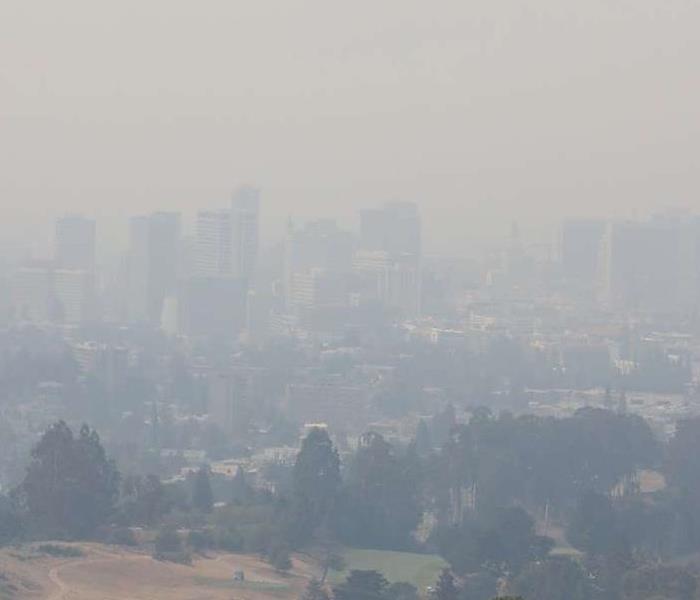 Smoke can make it hard to breathe, see, and even orient yourself. Get as low as you can and make your way to open spaces
Smoke can make it hard to breathe, see, and even orient yourself. Get as low as you can and make your way to open spaces
Here in New England we have been kept relatively safe from the perils of the extreme weather events that have pushed many areas of the world and this country to their limits.
As we continue to not get very little rain and more and more areas of the Northeast are showing up on the drought monitor. We could be subjected to these fires with one wrong spark.
It is important to know that when there is fire there is smoke. Smoke can contain a lot of deadly toxins and being prepared can make the world of difference. Since we all have access to masks these days it is important to keep one with you if you notice smoke in the air.
A lot of products burn when there is a fire, containing a wide array of chemicals beyond just wood. Keep this in mind if there is a fire in your area and you try and stay to defend your home. You can easily overcome with smoke long before the flames arrive. It is best to just get to safety.
We have enclosed some recommendations and guidelines from the CDC. Familiarize yourself with them and keep a spare one in all places you may go if you are every caught in the cross hairs of a fire.
Wildfire smoke can harm you in multiple ways. Smoke can hurt your eyes, irritate your respiratory system, and worsen chronic heart and lung diseases. This fact sheet tells you how you can protect your health and be safe if you are exposed to wildfire smoke.
What is Wildfire Smoke and Can it Make Me Sick?
Wildfire smoke is a mix of gases and fine particles from burning vegetation, building materials, and other materials. Wildfire smoke can make anyone sick. Even someone who is healthy can get sick if there is enough smoke in the air. Breathing in smoke can have immediate health effects, including:
- Coughing
- Trouble breathing normally
- Stinging eyes
- A scratchy throat
- Runny nose
- Irritated sinuses
- Wheezing and shortness of breath
- Chest pain
- Headaches
- An asthma attack
- Tiredness
- Fast heartbeat
Older adults, pregnant women, children, and people with preexisting respiratory and heart conditions may be more likely to get sick if they breathe in wildfire smoke.
Wildfire Smoke Can Affect High Risk Groups
Eight Tips for Protecting Yourself from Breathing Wildfire Smoke
If possible, limit your exposure to smoke. Here are eight tips to help you protect your health:
- Pay attention to local air quality reports and the US Air Quality Index External. When a wildfire occurs in your area, watch for news or health warnings about smoke. Pay attention to public health messages and take extra safety measures such as avoiding spending time outdoors.
- Pay attention to visibility guides if they are available. Although not every community measures the amount of particles in the air, some communities in the western United States have guidelines to help people estimate air quality based on how far they can see.
- If you are told to stay indoors, stay indoors and keep your indoor air as clean as possible. Keep windows and doors closed unless it is very hot outside. Run an air conditioner if you have one, but keep the fresh-air intake closed and the filter clean to prevent outdoor smoke from getting inside. Seek shelter elsewhere if you do not have an air conditioner and it is too warm to stay inside with the windows closed.
- Use an air filter. Use a freestanding indoor air filter with particle removal to help protect people with heart disease, asthma or other respiratory conditions and the elderly and children from the effects of wildfire smoke. Follow the manufacturer’s instructions on filter replacement and where to place the device.
- Do not add to indoor pollution. When smoke levels are high, do not use anything that burns, such as candles and fireplaces. Do not vacuum, because vacuuming stirs up particles already inside your home. Do not smoke tobacco or other products, because smoking puts even more pollution into the air.
- Follow your doctor’s advice about medicines and about your respiratory management plan if you have asthma or another lung disease or cardiovascular disease. Call your doctor if your symptoms worsen.
- Do not rely on dust masks for protection. Paper “comfort” or “dust” masks commonly found at hardware stores trap large particles, such as sawdust. These masks will not protect your lungs from smoke. An “N95” mask, properly worn, will offer some protection. If you decide to keep a mask on hand, see the Respirator Fact Sheet provided by CDC’s National Institute for Occupational Safety and Health.
- Avoid smoke exposure during outdoor recreation. Wildfires and prescribed burns—fires that are set on purpose to manage land—can create smoky conditions. Before you travel to a park or forest, check to see if any wildfires are happening or if any prescribed burns are planned.
https://www.cdc.gov/disasters/wildfires/smoke.html
Photo: Yalonda M. James / The Chronicle
Fireworks should be left to the professionals
6/30/2020 (Permalink)
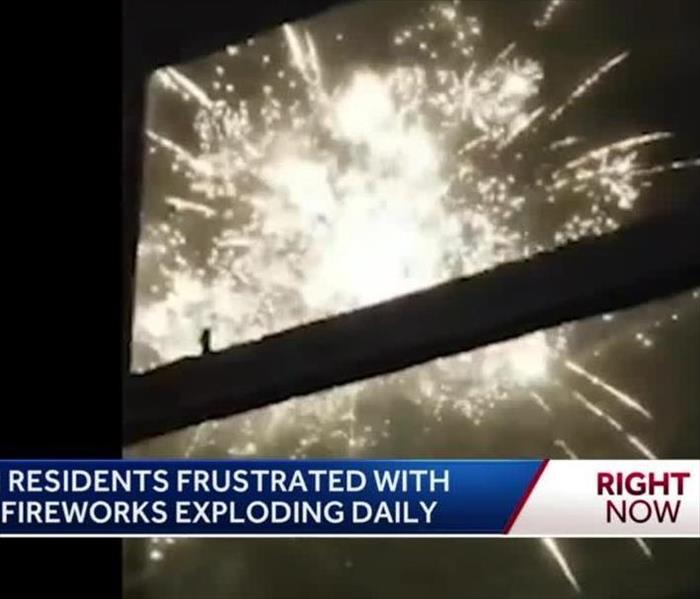 Firework complaints have gone up more than 500% in some communities. Let us all take a break from this year and find something else to do
Firework complaints have gone up more than 500% in some communities. Let us all take a break from this year and find something else to do
Fireworks have been all over the news as of late in Massachusetts. There are a number or reasons for the news stories. Some have been to notify us of cancelled town 4th of July events. Others have been to warn of their dangers due to buildings catching fire from a stray ember or rouge projectile. Yet one other news worth story is the fact the fireworks are illegal in this state for use by non-professional persons.
With so many of us home more and looking for things to do, many are turning to fireworks with NH being just such a short drive. We at SERVPRO of East Boston, Chelsea, Revere we urge you to refrain from using fireworks.
There are a lot of safety reasons to not use they. Personal safety is the key reason. One of our employees know someone who lost their hand to one a few years ago. Any firework injury could result in a hospital visit, which for an unavoidable issue during these novel times is not ideal.
Another reason to refrain from the use of fireworks is that many pets and people have PTSD and fear of the noise from it. Our friends family and especially our neighbors need our support more than ever. We may even see our neighbors more than we see our family these days. Trying to be mindful of everyone within the communities needs is more important than ever. The needs goes far beyond our desire for something to do here and there.
Our most cautionary reason for refraining from the fireworks is the damage to your home or someone else’s. Things are not what they normally are. Staying in a hotel while a home is fixed from the fire and water damage is not an easy decision or in many instances not an option. Having to leave your home or live in a partially ruined home for the sake of a firework is not an appealing thing to think about.
Below you will find an article from the National Safety Council that highlights some of the key points we have discussed more in depth. Let us all stay safe healthy and happy. This July 4th holiday.
https://www.nsc.org/home-safety/tools-resources/seasonal-safety/summer/fireworks
Summer is synonymous with barbecues, parades and fireworks. The National Safety Council advises everyone to enjoy fireworks at public displays conducted by professionals, and not to use any fireworks at home. They may be legal but they are not safe.
In 2017, eight people died and over 12,000 were injured badly enough to require medical treatment after fireworks-related incidents. Of these, 50% of the injuries were to children and young adults under age 20. Over two-thirds (67%) of injuries took place from June 16 to July 16. And while the majority of these incidents were due to amateurs attempting to use professional-grade, homemade or other illegal fireworks or explosives, an estimated 1,200 injuries were from less powerful devices like small firecrackers and sparklers.
Additionally, fireworks start an average of 18,500 fires each year, including 1,300 structure fires, 300 vehicle fires and nearly 17,000 other fires.
If You Choose to Use Legal Fireworks
If consumer fireworks are legal to buy where you live and you choose to use them, be sure to follow the following safety tips:
- Never allow young children to handle fireworks
- Older children should use them only under close adult supervision
- Never use fireworks while impaired by drugs or alcohol
- Anyone using fireworks or standing nearby should wear protective eyewear
- Never hold lighted fireworks in your hands
- Never light them indoors
- Only use them away from people, houses and flammable material
- Never point or throw fireworks at another person
- Only light one device at a time and maintain a safe distance after lighting
- Never ignite devices in a container
- Do not try to re-light or handle malfunctioning fireworks
- Soak both spent and unused fireworks in water for a few hours before discarding
- Keep a bucket of water nearby to fully extinguish fireworks that don't go off or in case of fire
- Never use illegal fireworksSparklers Are DangerousSparklers burn at about 2,000 degrees – hot enough to melt some metals. Sparklers can quickly ignite clothing, and children have received severe burns from dropping sparklers on their feet. According to the National Fire Protection Association, sparklers alone account for more than 25% of emergency room visits for fireworks injuries. For children under 5 years of age, sparklers accounted for nearly half of the total estimated injuries.
- Consider using safer alternatives, such as glow sticks, confetti poppers or colored streamers.
- Every year, young children can be found along parade routes and at festivals with sparklers in hand, but sparklers are a lot more dangerous than most people think.
- Better yet, grab a blanket and a patch of lawn, kick back and let the experts handle the fireworks show.
Photo Credit WCVB Channel 5
Rise in water damage claims
6/30/2020 (Permalink)
 Flooding and water damage events are on the rise. So too are water damage claims for homes and businesses
Flooding and water damage events are on the rise. So too are water damage claims for homes and businesses
An article from March of 2019 highlights key numbers on water damage claims from insurance companies. Surges in water damage claims along with the climbing average cost of each claim is alarming.
With all the technology and advancements we have to wonder what is going on. People maybe not being home as often could play a major role in the length of time water problems go unnoticed.
Another reason for a rise in the water damage claims are overloaded drainage systems and major rain and flood events. While we have periods of drought these major rain events quickly overload systems and cannot be absorbed by the earth fast enough. Running into roads, drains, homes, and businesses.
What kind of water damage you have is another major player in the cost of the damages. We here at SERVPRO of East Boston Chelsea, Revere have seen a major uptick in sewage calls. This damage requires immediate response as well as a lot more demolition due to nature of the potential contaminates within the water.
A new report has found that the number of water damage claims resulting from leaks have surged in recent years, as other types of claims have declined in frequency.
The report, prepared by Verisk Analytics’ ISO unit, found that one in 50 homeowners filed a water damage claim each year, between 2013 and 2017. This 2.05% frequency rate is a noticeable increase from the 1.44% frequency rate annually for the period between 2005 and 2009. Industry figures have also highlighted that the increase in water damage claims occurred even as other types of claims (such as for fire) have declined in frequency.
ISO additionally found that, in 2017, the total amount of insurance payouts for water damage was $13 billion. The average claim cost about $10,000.
Several industry leaders have confirmed that water damage is just as rampant as the data reveals.
“Wildfires, hurricanes and tornadoes catch headlines, but the reality is that the No. 1 kind of risk that the everyday consumer has is a water claim,” USAA assistant vice-president of P&C innovation Jon-Mike Kowall told Wall Street Journal.
Major insurer Chubb has also recently released data outlining that the number of annual water claims costing more than $500,000 has doubled since 2015, while those that cost over $1 million have tripled.
Insurance executives say that there are several factors driving the costs higher. These include: aging homes with potential plumbing failures waiting to happen; expensive homes filled with valuables that are vulnerable to water damage; and more homeowners wanting their laundry room on an upstairs floor.
Although insurer’s payments are increasing, it does not mean they are obligated to pay every water damage claim. Wall Street Journal reported that, since the 1960s, standard homeowners’ policies have excluded storm surge and river flooding. Similarly, homeowners’ policies typically cover “sudden and accidental” damage, not routine plumbing maintenance. Insurance executives have warned that homeowners who neglect an obvious slow leak for months until the damage reaches critical levels could get into a coverage dispute.
https://www.insurancebusinessmag.com/us/news/breaking-news/study-water-damage-claims-surging-161741.aspx
Getting back to business to find water damage
6/29/2020 (Permalink)
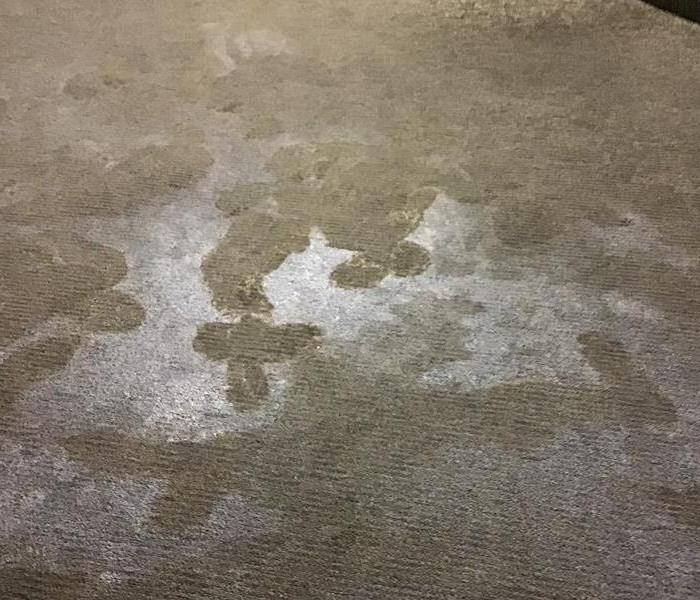 When water damage sits on a carpet for months you are bound to see some things growing from it. This was very slippery
When water damage sits on a carpet for months you are bound to see some things growing from it. This was very slippery
Water.
Water is the life force of the planet. Nothing would survive without it. Yet it can be one of the most destructive forces we know. The funny thing about water its destruction can be instantaneous or slow and steady over the course of days weeks months or even years.
Today SERVPRO of East Boston would like to show you a case study on the various ways a water loss can affect your building.
Let us start out by setting the stage:
Unprecedented times have forced your business to close. You send your employees home for their own safety. You have the management team set the building into idol mode. For the HVAC system and lights to ensure you are saving on costs and you have them lock it up and go home for their safety as well.
Time moves on and still you remain closed. You determine you do not need to act on the building because you shut it down and no clients have been in or out. Right? Weeks turn into months and still no signs of opening. All of a sudden there seems to be a light at the end of the tunnel word is out that you may be able to open your doors soon. New protocols will need to be implemented the whole building needs to be cleaned all your equipment needs to be wiped down and situated. Staff needs to be trained.
You call up your regional manager to set the wheels in motion to get things going. The area managers are all called up for action. They head into the buildings and start to assess in the equipment and building for cleaning, get the air turned on and so forth. Laying
out equipment, created one way paths, assess what else is needed.
Then it happens one of your area managers calls after arrival to the building. Something is really wrong there is water everywhere. The whole place is flooded. You ponder and thing to yourself that is not really possible we have a big place send me some photos. One photo is a bubbler leaking water all over the locker room area. Ok well the locker room area is mostly tile so that can’t be too bad.
The images continue into the main hallway. Which by the way is carpeted, as you follow the carpeted hallways it becomes clear there is a slippery film coating the entire top of the carpet. How long does it take for a film like that to develop?
You keep walking it flows through walls, into other areas where you have thick rubber flooring cemented to the floor below. Did it get under this this layer of rubber? Is that possible. How far into the main area of room did this water go. As you walk through increasingly wondering how bad can it be?
You see the water line it is halfway through the building. As you stand there saying well its only half way its manageable. You see more walls that it looks like it went through. Oh no please not in that room you think to yourself as you anxiously walk towards the swinging glass doors. Slowly opening them to find your wood floors look intact. With a big sigh of relief you say wow we dodged a bullet.
Time to call the professionals to assess what the next steps will be. Enter the professionals. You meet them at the building the next day to show them everything you found proud of the fact that the water was only half way through the building and that you do found that your precious floors were not affected.
Then they do something you did not do.. They look up noticing a lot of black spots on the ceilings and walls by the windows and the AC vents. The then look down but not the way you looked down they peel away a rubber vinyl baseboard just a little bit. They do this in a few rooms finding a lot of evidence of trapped water as they go.
They walk into that room you were so proud to tell them that they water did not look like it went into that room. They pull at the baseboard on the wall next to that rubber floor you know water affected. What happens next brings you to your knees. That wood floors is a raised floor built on another subfloor built on another subfloor. sitting on top of a liner sitting on top of cement. There is trapped water under it under almost all of it. While topically this whole room looks fine. Hidden behind a wall, under a floor water trapped in a dark space where the air does not move and the heat builds as temperatures outside continue to climb.
Finding out it is not what you can see that is the problem or where you look. It is what you look behind and what you pull away from walls and floors that show the true extent of the damage. As you absorb that the damage is far more extensive than you imagined reality sets in. Your light at that end of the tunnel just moved a lot further way. How do you get through all of this? Will you be able to hold out long enough for the repairs to be made? Will your customers come back when you are re-opened? Where do you start with fixing all this?
SERVPRO of East Boston is here to help. We have a vast network of vendors that will allow us to get your project going as soon as possible. We also always work closely with every insurance company. They know that SERVPRO has a reputation for being efficient and through. We are a trusted resource for getting the project done and getting you back to “Like it never even happened.”
2020 has been a doozy hurricane season could be too
6/29/2020 (Permalink)
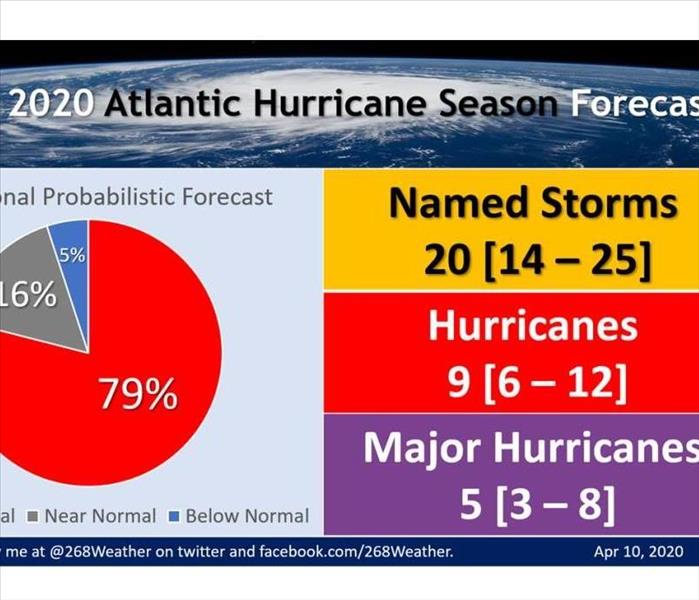 Hurricane season is set to be busier than normal. NOAA has their annual report and we could be in for a ride.
Hurricane season is set to be busier than normal. NOAA has their annual report and we could be in for a ride.
SERVPRO of East Boston Strives to be your premier source for not only water and fire damage restoration but up to date information on possible upcoming weather forecast for the year.
With 2020 having already been quite the unpredictable one already. The planet has seemingly been one high weather event after another. Below you will find the NOAA weather predictions for the upcoming year that is just getting started.
The 2020 Atlantic hurricane season is predicted to be more active than usual, according to an outlook released Thursday by NOAA’s Climate Prediction Center, a division of the National Weather Service.
The NOAA outlook calls for 13 to 19 named storms, six to 10 hurricanes and three to six major hurricanes – one that is Category 3 or higher (115-plus-mph winds) on the Saffir-Simpson Hurricane Wind Scale.
This forecast is above the 30-year (1981-2010) average of 13 named storms, seven hurricanes and three major hurricanes.
NOAA's outlook is in agreement with that released in April by The Weather Company, an IBM Business, which calls for 18 named storms, nine hurricanes and four major hurricanes.
Numbers of Atlantic Basin named storms (those that attain at least tropical or subtropical storm strength), hurricanes and hurricanes of Category 3 or higher intensity forecast by NOAA, Colorado State University and The Weather Company, an IBM Business, compared to the 30-year average (1981 to 2010).
Though the official Atlantic hurricane season runs from June through November, storms can occasionally develop outside those months. This was the case earlier in May when Tropical Storm Arthur formed, as well as the past five seasons with Subtropical Storm Andrea in May 2019, Tropical Storm Alberto in May 2018, Tropical Storm Arlene in April 2017, Tropical Storm Bonnie in May 2016, Hurricane Alex in January 2016 and Tropical Storm Ana in May 2015.
Arthur is included in NOAA's tally of the 13 to 19 named storms it expects this season.
(MORE: What the Most Active Atlantic Hurricane Seasons Have Delivered in June, or Earlier)
NOAA's outlook is based on a number of climate factors, including the El Niño-Southern Oscillation (ENSO) and sea-surface temperatures in the Atlantic Basin.
ENSO conditions are expected to remain either neutral (neither El Niño nor La Niña) or trend toward La Niña, which means El Niño will not be present to suppress hurricane activity.
Additionally, warmer-than-average sea-surface temperatures in the tropical Atlantic Ocean and Caribbean Sea, combined with reduced wind shear – the change in wind speed and/or direction with height – weaker trade winds in the tropical Atlantic and an enhanced west African monsoon all increase the odds of an above-above hurricane season.
Similar conditions have been producing more active seasons since the current high-activity era began in 1995, NOAA said.
For example, 2010 tied for the third-most-active Atlantic hurricane season on record for named storms, with 19, 12 of which became hurricanes. 2017 was the fifth-most-active season, with 17 named storms and 10 hurricanes, including major hurricanes Harvey, Irma and Maria.
"NOAA’s analysis of current and seasonal atmospheric conditions reveals a recipe for an active Atlantic hurricane season this year," said Dr. Neil Jacobs, acting NOAA administrator. "Our skilled forecasters, coupled with upgrades to our computer models and observing technologies, will provide accurate and timely forecasts to protect life and property."
While you should prepare for hurricane season every year, it is critically important to do so this year.
"As Americans focus their attention on a safe and healthy reopening of our country, it remains critically important that we also remember to make the necessary preparations for the upcoming hurricane season," said Secretary of Commerce Wilbur Ross. "Just as in years past, NOAA experts will stay ahead of developing hurricanes and tropical storms and provide the forecasts and warnings we depend on to stay safe."
NOAA’s outlook is for overall activity expected during the hurricane season and is not a landfall forecast. It will update the 2020 seasonal outlook in August prior to the historical peak of the Atlantic season.
Here are some questions and answers about what this outlook means.
What Does This Mean for the United States?
There is no strong correlation between the number of storms or hurricanes and U.S. landfalls in any given season. One or more of the 13 to 19 named storms predicted to develop this season could hit the U.S. or none at all. That's why residents of the coastal U.S. should prepare each year no matter the forecast.
A couple of examples of why you need to be prepared each year occurred in 1992 and 1983.
The 1992 season produced only six named storms and one subtropical storm. However, one of those was Hurricane Andrew, which devastated South Florida as a Category 5 hurricane.
In 1983, there were only four named storms, but one was Alicia. The Category 3 hurricane hit the Houston-Galveston area and caused almost as many direct fatalities there as Andrew did in South Florida.
In contrast, the 2010 Atlantic season was quite active, with 19 named storms and 12 hurricanes. Despite the high number of storms that year, no hurricanes and only one tropical storm made landfall in the U.S.
In other words, a season can deliver many storms but have little impact, or deliver few storms and have one or more hitting the U.S. coast with major impact.
Named storm tracks in the 2019 Atlantic hurricane season. The colors correspond to intensities of each named storm during that section of the track, except for the black sections, which correspond to either a remnant or the time during which a system was a tropical wave before forming into a depression or storm.
The U.S. averages one to two hurricane landfalls each season, according to NOAA's Hurricane Research Division statistics.
In 2019, there were two U.S. hurricane landfalls – Barry in Louisiana and Dorian in North Carolina.
(MORE: Why 2019's Hurricane Dorian Wasn't Retired by the World Meteorological Organization)
In 2018, four named storms impacted the U.S. coastline, most notably hurricanes Florence and Michael within a month of each other.
In 2017, seven named storms impacted the U.S. coast, including Puerto Rico, most notably hurricanes Harvey, Irma and Maria, which battered Texas, Florida and Puerto Rico, respectively.
(MORE: Three Category 4 Hurricanes Made a U.S. Landfall in 2017)
Before that, the U.S. was on a bit of a lucky streak.
The 10-year running total of U.S. hurricane landfalls from 2006 through 2015 was seven, according to Alex Lamers, a meteorologist at the National Weather Service. This was a record low for any 10-year period dating to 1850, and considerably lower than the average of 17 per 10-year period in that same span.
None of the U.S. landfalls from 2006 through 2015 were from major hurricanes.
So it's impossible to know for certain if a U.S. hurricane strike will occur this season. Keep in mind that even a weak tropical storm hitting the U.S. can cause major impacts, particularly if it moves slowly and triggers flooding rainfall.
How Much of a Role Will El Niño or La Niña Play?
El Niño/La Niña, the periodic warming/cooling of the equatorial eastern and central Pacific Ocean, can shift weather patterns over a period of months. Its status is always one factor that's considered in hurricane season forecasting.
As of late spring, neither El Niño nor La Niña were in place. NOAA forecasts a 65% chance of these neutral conditions continuing during the summer ahead.
Long-range forecasters at both The Weather Company, an IBM Business, and Colorado State University were generally in agreement with NOAA, suggesting that neutral conditions are anticipated through at least the first half of the hurricane season (June through August, or JJA), with either neutral or La Niña conditions possible in the second half (September through November, or SON).
We should note here, before talking about the impacts of a possible La Niña, that the status of the El Niño-Southern Oscillation (ENSO) is notoriously difficult to predict. This is especially true from February to May, when the "spring predictability barrier" is in play, a period when forecast skill is lower than the rest of the year.
La Niña generally acts as a speed boost to the Atlantic hurricane season, but it is just one factor that can lead to an active year. Hurricane seasons can be active even if La Niña is not in play.
La Niña typically corresponds with a more active hurricane season because the cooler waters of the Eastern Pacific Ocean end up causing less wind shear along with weaker low-level winds in the Caribbean Sea. La Niña can also enhance rising motion over the Atlantic Basin, making it easier for storms to develop.
The La Niña years of 2010 and 2011 are among several tied for the third-most-active Atlantic seasons on record (both years had 19 named storms). The next La Niña year, 2016, was also active, with 15 named storms that included Category 5 Matthew and three other major hurricanes. La Niña conditions recurred midway through the hyperactive and catastrophic 2017 season that produced Harvey, Irma and Maria.
Other Factors in Play
One of the other ingredients that meteorologists, including those at NOAA, are considering for hurricane season is current sea-surface temperatures across the Atlantic Ocean.
Much of the Atlantic's waters are already warmer than average as of late May. The Gulf of Mexico is also several degrees above average, given the hot temperatures and lack of rain over the Southeast earlier in the spring.
But it isn't ocean temperatures in April that will help boost or curtail tropical systems; rather, it is water temperatures during the hurricane season.
Climate models suggest that most of, if not the entire, Atlantic Basin will be warmer than average during the peak of the hurricane season.
Forecast Sea-Surface Temperature Anomalies for August through October 2020
(Levi Cowan/TropicalTidbits.com)
An above-average number of tropical storms and hurricanes is more likely if temperatures in the main development region (MDR) between Africa and the Caribbean Sea are warmer than average. Conversely, below-average ocean temperatures can lead to fewer tropical systems than if waters were warmer.
Assuming atmospheric factors are favorable, warmer waters in the MDR allow tropical waves – the formative engines that can eventually become tropical storms – to get closer to the Caribbean and the U.S.
The prevalence of wind shear and dry air across the Atlantic will also need to be watched over the next six to eight months.
If neutral or La Niña conditions do lock in, as most forecasters expect, and the atmosphere responds to it, there could be less wind shear and more favorable conditions for hurricane growth toward the end of the season.
How much dry air rolls off the coast of Africa will also need to be monitored. Even if water temperatures are very warm and there is little wind shear, dry air can still disrupt developing tropical cyclones and even prohibit their birth.
Hurricanes need a precise set of ingredients to come together in order for them to fester, and those ingredients will need to be monitored this year.
The Atlantic hurricane season officially begins June 1 and runs through Nov. 30. This article provides a list of potentially life-saving tips to help you prepare for a hurricane.
The Weather Company’s primary journalistic mission is to report on breaking weather news, the environment and the importance of science to our lives. This story does not necessarily represent the position of our parent company, IBM.
The Weather Company’s primary journalistic mission is to report on breaking weather news, the environment and the importance of science to our lives. This story does not necessarily represent the position of our parent company, IBM.
What lies beneath and under your home
6/29/2020 (Permalink)
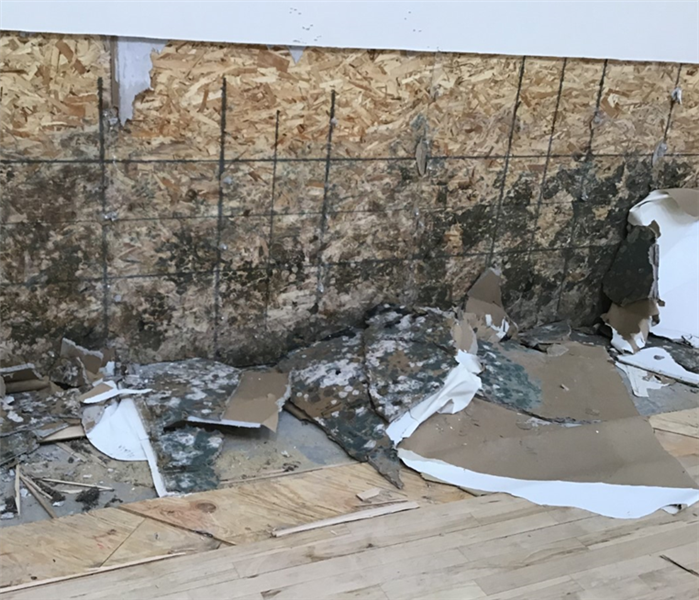 This wall appeared to the untrained eye totally unaffected by the water damage at this commercial property. We knew better.
This wall appeared to the untrained eye totally unaffected by the water damage at this commercial property. We knew better.
Modern homes are a marvel with all their energy efficiency, water saving devices, specialty windows and a litany of modern technological advancements. Yes despite all these fancy amenities one thing can bring any family to its knees. Mold.
We are not here to scare you nor are we trying to tell you all mold is bad. We are here to educate you on the little things that can make a big difference. It is also important to know that modern insurance policies have become hip to the mold game and many of them have exclusions for the mold that may be found within the home. Mold is considered secondary damage from a water issue of some sort. Damage that would not have occurred if the damage was rectified in a timely fashion.
Below is an ABC news article from 2006. It is still very relevant today and is worthy of a resurgence of the information with all of us at home a lot more these days. With a lot more time on our hands it would be worthy to get into those hard to reach places and see what is really going on in the dark places within our homes that we tend to ignore.
Because modern homes are more tightly sealed for energy efficiency, water — which mold needs to survive — gets trapped inside.
Modern building materials like wood, drywall, wallpaper and fabric are appealing food sources for mold, while building technologies such as synthetic stucco can leak and trap moisture inside. Home appliances including clothes dryers and dishwashers also generate water vapor, again creating the type of environment.
"Mold spores are everywhere," said Meg Hamilton, CEO of Hamilton Thorne Biosciences. "They're in your house, in your attic, on the street, in your living room, in your kitchen. It's a question really of how much and what species." Some molds are worse than others, said Tom Kelly, a director of the indoor environments division at the federal Environmental Protection Agency.
"There are a relatively small number of mold species that have been identified as producing a kind of toxin called mycotoxin," Kelly said. "What's not clear is whether they are toxic to human beings."
There are more than 100,000 mold species, and about 50 are considered toxic. He has invented a DNA-based technology that spotlights the bad ones.
Destroying Home Values
The fungus can affect more than just health. Dan Sitomer, an attorney specializing in mold litigation, says it could destroy the value of your home.
"For the moment in time that that building is viewed as a problem its value goes to zero," Sitomer said. "The litigation is so aggressive and has multiplied so quickly that it has frightened the insurance industry. The damages can include almost anything. Pain and suffering, negligence, the claims go on and on."
Most insurance policies do not cover damages related to mold, according to Gordon Stewart, president of the Insurance Information Institute. "In 44 states, mold is excluded, unless it is the direct result of a peril that is covered," Stewart said. For example, some insurance companies do not cover mold, but do cover water leakage, which can cause mold to grow.
Meanwhile, articles about mold — like one in the magazine Redbook headlined "It's Invisible. It's Deadly. And It's in your home" — have made many homeowners nervous. With unanswered health questions, the looming risk of litigation, prospects of nose-diving property values and no insurance safety net, what's a homeowner to do?
Experts agree on one thing: If you've got mold you need to get rid of it. More importantly, you need to eliminate the cause.
"We say: 'Find the moisture, eliminate the moisture, clean up the mold,' " Kelly said. "Come back a month later, make sure it's still gone."
It is possible to have mold and not know it. If you can't find it yourself, a "mold dog" may be able to help. Jason Earl, a mold inspector works with a mold dog named Oreo. In the same way dogs can be trained to detect drugs and explosives, Oreo can find mold, he says.
Tracking Mold in Your Home
How does mold get into houses?
Mold is everywhere, in the air indoors and out. To reproduce, mold generates spores (seeds) that become airborne. These spores can remain dormant for 50 years or more.
They become active when they come into contact with moisture and food. Where there's mold there is always water. Mold colonies develop which, in turn, release more spores into the air. How do you know if you might have mold?
Visual Signs:
Surface mold. Signs of water intrusion (discoloration, peeling or bubbling paint, bulging walls or ceilings). Water intrusion (broken pipe, flooded basement, roof leak, etc.) that wasn't completely dried out within 24 - 48 hours. A musty smell.
Health effects seem to lessen when the sufferer is not at home. If you see mold on the walls or floors of your home, and it's less than a 3-foot by 3-foot patch, clean it using bleach and water, and let it dry completely. If you see any spots larger than that, contact an industrial hygienist. (Try the American Industrial Hygiene Association at aiha.org for a referral.)
When should you consider a mold inspection?
When there is a musty smell, but you cannot find any visual evidence.
If there is visual evidence and you need to determine the extent of infestation and damage.
Is there no visual evidence or smell, but a member of the family shows health effects (sensitivities vary by individual)?
If you need help locating the source of the water that's causing the mold.
When you're buying or selling a home.
When you are ready, formalize the plan to remove the mold and repair the damage.
Getting someone certified to supervise mold removal and repairs.
How do you select someone to remove the mold and fix the damage?
It is recommended that inspection and remediation not be done by the same person/firm. Insist that the firm/person have a contractor's license. Look for remediators who are certified. Check with the licensing board and Better Business Bureau for complaints. Ask for references for similar jobs. Call references and ask if the job was done properly, on time and within budget. Inquire if a mold test was done after the remediation work. If you see mold, find the source of moisture, correct it and clean up the mold. If you see signs of water leaks, investigate for mold.
If you smell mold, consider having a qualified mold inspection firm test for mold, locate the mold, determine the extent of the mold, determine the source of moisture and come up with a remediation plan.
How do you prevent mold?
Locate and fix water leaks immediately. Dry water from water leaks within 48 hours. Make sure clothes dryers are properly vented to the outside. Use exhaust fans when cooking, showering or using dishwasher. Insulate exterior walls to prevent condensation inside. Keep indoor humidity below 50 percent. Remember: Just cleaning up mold is not enough. You must find the water source and eliminate it.
How do you clean up mold? This is one that is best left to the professionals as doing it incorrectly could lead to a recurrence.
Your best bet is to call the professionals and ensure that you are finding the true source. It is also imperative that you properly seal off the area from the rest of the house so no spores become airborne.
SERVPRO of East Boston, Chelsea Revere has a specially trained team on hand to ensure that you are taken care of properly and safely. If you have a funny odor that you can not pin point call our team today and we will work with you. To make it “Like it never even happened.”
Bulk of this article is from
https://abcnews.go.com/WNT/story?id=131638&page=1
For more information on mold, here are some online resources:
Centers for Disease Control and Prevention: http://www.cdc.gov/nceh/airpollution/mold/stachy.htm
U.S. Environmental Protection Agency: http://www.ep
Why property managers are important
6/23/2020 (Permalink)
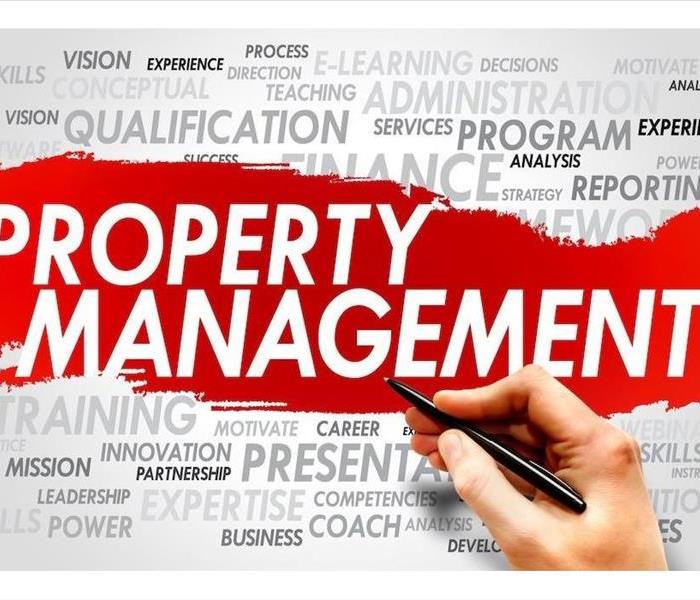 Commercial Property management is so much more than collecting rent. It is a pivotal part of retaining tenants, engaging clients & Building health
Commercial Property management is so much more than collecting rent. It is a pivotal part of retaining tenants, engaging clients & Building health
Why it is important to hire a property management company
Commercial properties have unique needs and should not be left to amateurs. As any property owner knows it is not a matter of will something happen it is a matter of when, and how bad will it be. How bad could it really be? Right?
Many commercial properties are multi-use facilities. Some have multiple businesses with various needs. Some have both business and residential tenants. In addition to the individual needs of each tenant there are building needs and the efficiency of the equipment that keeps the building running.
With the novel nature of the current economy and many commercial buildings being shut down for upwards of three months. As companies start to prepare for their reopening many are walking in to find quite a bit of damage.
When they shut the buildings down, they did so with costs in mind. Many buildings were put into an idol mode. Lower heat or AC settings, lights tuned off ,etc.
While in doing so was an effort to save money. Many failed to schedule walk throughs to ensure that the building was still healthy. That it had the proper air movement to prevent warm humid temperatures from building up inside?
Were rising temperatures outside taken into account as the sun beamed through the windows? When the building was shut down was the water to the building turned off or allowed to remain on? Did the building electricity get turned off at the breakers or did just a light switch get turned off? . As the time was getting closer and closer to looking like it was going to be time to reopen it was time to get the buildings ready.
As the reality of our new normal set it companies sent small number of staff back into these buildings. To prepare for the new way of doing business, deep cleans were set to be done, IN/OUT rules needed to be established, Protocols for client interaction and safety for all involved needed to be implemented. When employees were walking into these buildings they were finding multitudes of problems
Water bubbler or a pipe has been broken and leaking unchecked for upwards of 3+ months. Where carpets are slippery with bacterial growth, Walls are saturated, air quality poor, trapped water in and around every aspect of the building.
Mold at all of the HVAC vents and all of the windows from lack of air movement and improper humidity levels. Resulting in unsafe air quality. Hotter or colder than normal temperatures resulting in unhealthy work environments.
Did someone take advantage of the building being shut down and break in to live as a squatter? Did they use the toilet, shower, fridge microwave? Did this use result in filthy conditions in your facility? Was there a sewage back up because of it ? Did the empty building become filled with a squatters things?
Maybe you get a late night call from the fire department that there is a fire on site and that the smoke and efforts to put out the fire have caused more damage to not only your building but adjacent buildings. With a property management company in your corner theses issues can be handled properly, quickly and efficiently. Trying to navigate the landscape of the unknown is always a challenge. Insurance companies can be cumbersome if you are not used to it.
If only a property management if had been hired. They can do periodic walk throughs. When would that water leak been noticed? How much water damage could have been prevented? Would all this growth on the walls, floors, carpets, and ceiling tiles been thwarted? Would that fire have occurred? Could all that smoke that ruined the computers been avoided? Would people have realized that the building was not empty and moved on to another?
If there was a property management company that checked on everything and made recommendations for equipment replacement or upgrades. They would have been periodically in the and out of the building to lend the perception of partially occupied.
Would they have noticed that your exhaust pipe for the carbon dioxide was rusted out? Maybe they could have pointed out that your four $10,000+ water heaters should not be in the same room as the corrosive equipment you use for the pool chemicals.
They may have noticed that your HVAC unit was building up too much condensation and that you needed to replace it before the moisture resulted in mold throughout all the vents and around the windows in the building?
They could have provided you with a proper shut down procedure to best mitigate any potential damages. Could they have the right connections know the right vendors to immediately address any and all issues quickly to reduce the secondary damage when something was amiss.
Walking away from a building for even a week can result in some very costly damage if not done properly. Working with property managers is your best bet for keeping your building and tenants happy healthy and safe.
SERVPRO of East Boston is here to help when you are working towards getting back into your building. We will work with you through any surprises you find so that you do not miss a beat. Should you find yourself walking into a mess. Please know our reputation and our vast network of vendors will work tirelessly to get you back to "Like it never even happened."
Hoarding and Fires do not mix
1/27/2020 (Permalink)
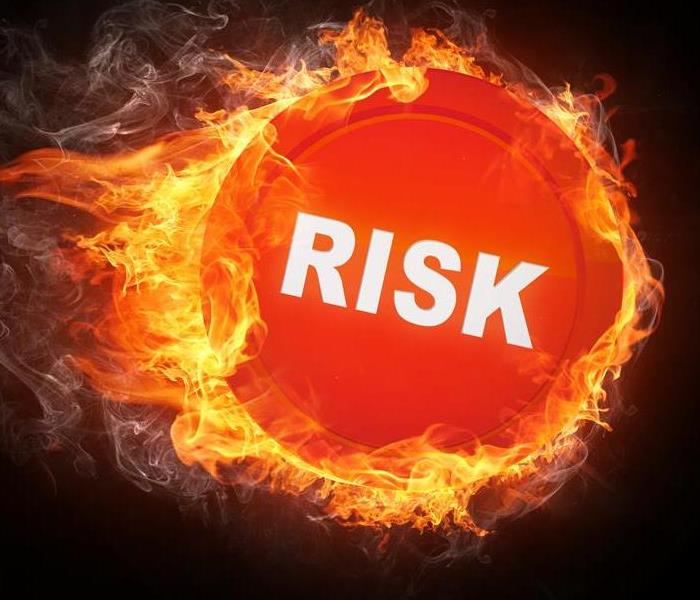 Risk of death and injury increase with a home that is a hoarding situation. Keep your home neat organized and under control.
Risk of death and injury increase with a home that is a hoarding situation. Keep your home neat organized and under control.
So you have a lot of stuff. It is your home you can do with it what you want right? Well technically yes, however that stuff can become a very dangerous and real hazard very quickly. Fire danger is a very real thing in any home exacerbated by excessive stuff can really posse a larger danger.
Fires on a normal day run through homes at a rapid rate. When your home is full of clutter and excessive stuff it can move that much faster. In as little as 30 seconds a fire can be well underway. Once you reach 1 minute the room can be full of thick black toxic smoke. The fire itself can reach temperatures of more than 600 degrees in no time. If this does not sound like an ideal environment for living things you would be right. These statistics are under normal living conditions things move a great deal faster when there is excess.
Many times, when you have things lining the walls you find that telling yourself it is stacked neatly so its not a hoard. This means you can be blocking an outlet, visibility to things plugged into those outlets mat be hindered. You may even have chemicals for cleaning lined up. Are they next to a heat source? Did you even think of that? Have you forgotten about one and the cap was off and spilled as you piled a bag of newspapers on top? As you add to the piles you can be pushing a plug into an outlet fraying the cord.
But it is neat and organized. If you cannot sweep a floor all the way over to the edges it is not neat and organized. If you have a hallway for example that has boxes running on each side and you have a pathway through the middle. While moving through this on a normal day you may something you can do with ease. If the home were to be full of smoke and you have to rely on feeling your way through that same hallway. As you reach for an edge the precariously stacked boxes may begin to tumble. You continue to reach, and they continue to fall. The smoke can hinder your breathing, you try to get lower to the ground because that was what you were taught. You are met with a pile of boxes that you cannot crawl through. Your path is now blocked.
Homes are set up for a reason with multiple entrance and exit routes. While on a daily basis you may not use them with frequency or maybe not at all. They still provide a valuable exit from a home. If you have decided the back door is not used so you will just pretend it is a corner, you can be in real trouble. Your main point of entry and exit could be blocked via the fire or items that have fallen. This could become a deadly decision in minutes.
In addition to the reduced entry and exit ways there is something to be said for the weight of the items that you keep within the home. While each floor has a specific load weight that it can hold. Once there is a fire involved these items will be doused with water adding significant weight to the floor load Often times this will cause a collapse that would not have normally happened. This adds to the danger, cost of the damages and can even prohibit rescue.
Large quantity of items add fuel to your current fire. It also creates a more difficult rescue attempt. It puts rescuers lives in danger, adds to the time it takes to reach you. If you are now trapped and having trouble getting out, they too are having trouble getting in. These blocked areas could be entry ways/ hallways/ stairwells. Your items could not only be blocking a pathway they could in fact be on fire.
Work on keeping hallways, and doorways free and clear of clutter and excessive furniture. Old mail, newspapers, magazines need to be discarded with the trash once they have been read or not needed anymore. Do not just put them in a bag or a box to save for later. The internet allows you to look up and reference most information saving you from needing a printed copy in your home.
Another key thing to helping reduce fire risk in your home is keeping electrical outlets free and clear of blockages. Do not pack items in front of them especially if you have things plugged into them. Not overloading an outlet and not using too many power strips or extension cords can also reduce potential for fires.
Please know that while we are living in a consumer driven time it is essential to keep your home in control. This will not only save you money, time and peace of mind. It just might save your life.
So you want an Aquarium...
1/15/2020 (Permalink)
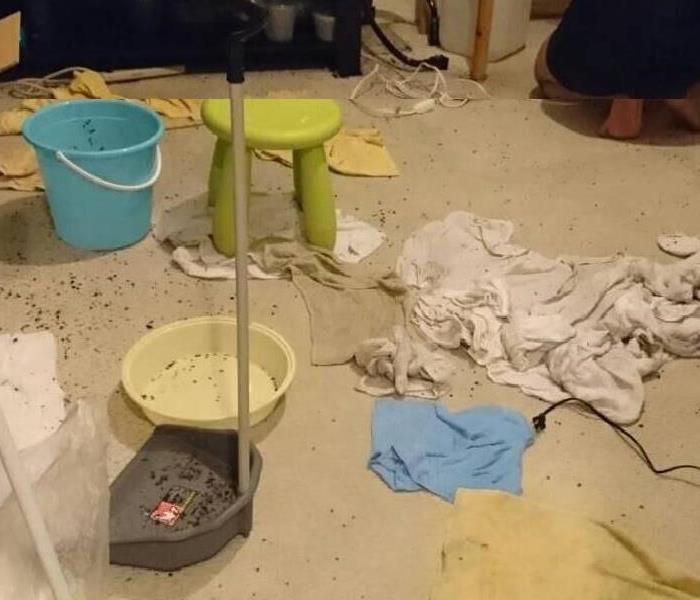 Fish are pretty water damage is not
Fish are pretty water damage is not
The weight of water
So, you binge watched that aquarium show. Saw these beautiful show tanks mostly saltwater that have eccentric designs, ornate fixtures and some of the most colorful fish you could imagine. What could be the harm. I can watch a YouTube video on properly setting up the take with the filtration system and get this done or something similar that I can maintain, and my friends will love it. A stunning piece in your home to be the center of conversation.
What do you do not see on those shows are the homes structure, foundation improvements or assessments? Safeguards that will reduce tank failure, or equipment failure. The other problems that many do not think about is the weight of the water.
Water typically weights 8.34 pounds per gallon. A tank you see on that show typically has two systems. A front show tank and a back of the house tank that typically has the same volume of water. You then need to have another tank that will cure at least 10% of the total volume of water you have in the two tanks.
Let us take a modest 90-gallon show tank for this example. The tank size will be approx. L: 48” W” 18 H: 25”. You are looking at the weight of the tank to be 160 pounds, full of water it will be about 1050. This is before you add the weight of any rocks, or ornamental decorations. The lighting too will all add weight as well as the pumps and such for circulation.
What sort of support structure do you have existing that can hold this level of weight? Oh, you are going to custom build one. That is great that too will add to the load you are putting on that floor area will you be using 4 points of contact or will you be doing a continuous brace support across the footprint of the structure? Once you have thought of all of this have you considered the added load on that floor and the structure that it is in. Can your floor hold and extra 1200 pounds of weight safely?
Let us dive into a structural engineers thoughts and ensure that we know what we are doing. The basic constructs of a home. There are multiple factors and many added weights to consider. The dead load of the floor is everything that will always be there, pipes, joists, ductwork, flooring materials this is approx. 15 Pounds per square foot. There is also the live load which is the furniture, decorations, appliances, people and aquarium. Now these two are not the only thing you need to look at one must use the safety factor which is usually between 1.5-2. So the home is safe with 1000 pounds but could collapse with 1500 pounds of weight.
The other factor is that people walking around for short amounts of time does not put the same pressure on these areas as something stagnant that will sit for potentially years on end. People will get up and move over time even furniture will be moved around and changed. An aquarium will remain stagnant.
SO you have assessed that your floor can hold the water and extra weight. How much damage could 90 gallons of water really cause for damage anyways. Yes water always wins, no matter what you are doing. If you have a slow leak and do not notice from a pipe that runs behind or under the take this can be extremely costly. To put it into perspective Typical appliance leaks on average cost well over $13,467 dollars to correct. Chalk it up to faulty pluming and you are looking at over $17,250 . These figures do not take into account the materials you have in your home. Do you have carpet, laminate, wood floors, tile. What floor is this tank on the first floor or do you have a split level ranch? If there is a finished floor underneath where you place this tank these costs could be much more.
All of this being said did you know there a lot of key ways an aquarium can leak. Here are some of the things that can happen a hose can split or burst off of a fitting, A connector could fail, a skimmer can overflow, drains could get blocked, one of the check valves could fail, a pump could stop working, a siphon could happen, the tank itself could fail. While making water you could forget about the hose running that is filling the container, float valves and sensors could get stuck or just not work. The powerhead could come unattached, algae and salt can build up and change the waters flow. An O-ring just as on a toilet could let go. Did you think of any of this while you were watching that show? They did.
Did you add additional coverage onto your homeowner’s insurance for this new addition to your home? Does it even matter? Water damage is water damage, right?
Wrong water damage caused by a fish tank falls under pets. Since damage to your own home caused by pets is typically not covered by insurance you will be on the hook for this damage on your own. If you live in an apartment even having additional coverage may not be enough.
These statistics are not meant to scare you, but they are meant to get you thinking. We do not imply or suggest that meeting specification requirements alone will ensure you do not have any problems and we do not guarantee that any of the advice on costs of repairs or coverage issues are set in stone. We do advise you talk to professionals in various industries prior to getting too far into the process of setting up a fish tank in your home ensure you are not subjected to surprises. This information is for informational purposes only and each situation is different and must be properly researched.
Statistics for water damage numbers were found on.
https://www.waterdamagedefense.com/pages/water-damage-by-the-numbers
Structural information was supplied in part by
http://www.african-cichlid.com/Structure.htm
Fire risk with Aquarium
1/15/2020 (Permalink)
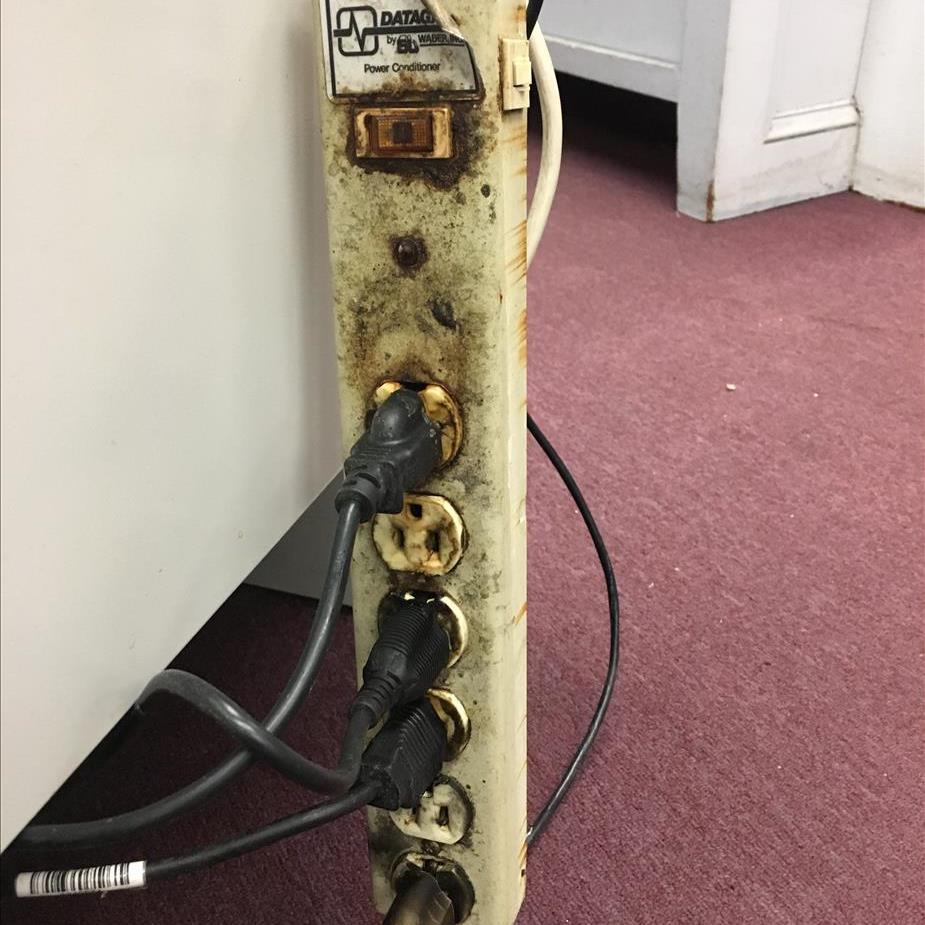 Power strip left sitting on the floor that then had a water damage problem
Power strip left sitting on the floor that then had a water damage problem
Fire damage with a home aquarium.
Aside from the obvious water damage they can cause. The old adage that water and electricity do not mix is there for a reason.
Well let us start with the basics of an aquarium and what sort of electrical power they really need. I mean they are tanks full of water what could they possibly need.
Lighting
Heating
Filtration
Pumps
So let us get started on the things to be careful about. A short circuit in a frayed or improperly placed wire can be detrimental to the overall safety of your home. This is an obvious one to most but what can come as a surprise is getting the improperly sized equipment for the volume of water that you have.
Some less obvious ones start at the very outlet your equipment will be plugged into. The law requires any outlet near water to be GFCI ( the ones with the test/ reset buttons in the middle) which is why you see them in bathrooms all the time. Most people do not have them outside of kitchen and bathroom areas and fail to consult with an electrician prior to setting up their aquarium.
While we are on the topic of outlets let us talk about how much electricity a standard outlet can handle because it is so easy to overload the outlet. A standard single outlet can hold approximately 2400 watts. Wattage can be tricky with equipment that needs to turn on and off. This creates a surge to the system that must be accounted for.
We see this most often with Christmas decorations during the holidays. Power strips and extension cords does not increase the number of things that can be safely plugged into it. It does give us a sense of false security especially if we got a fancy one with a lot of bells and whistles. Where we place these can play a roll in their safety. Make sure you never plug a power strip into an extension cord. Also avoid hiding the cord behind the aquarium for an out of site out of mind mentality can hide damage. You can not see if water is splashing over onto the tops of the cords, if somethings has fallen on top of them or if you have kinked up one of the cords causing it to break.
Heaters for example can have dire consequences. If the motor burns out can be an obvious danger, if he heater is too small and needs to run constantly to try and keep the water at the desired temperature. Should your system require multiple heaters you must ensure they are always fully submerged . Water changes and or drops to the water level must be met with heaters being turned off at least 20 minutes prior to the adjustment. This allows the mechanism time to cool down and avoid a short to the unit.
Lighting is often very close to the water and may not have the proper protection from splash back or spill overs creating shorts in the ballasts. These shorts can result in sparks flying over to a curtain or wall. They can also burn out the lighting unit itself and cause a fire. Lighting is also not meant to be in the water unlike the heater. This means extra care must be taken to keep the cords out of the way.
Filtration systems for many aquariums are set up in a separate room. That being said it is imperative that these systems be on all the time for the health and safety of the plants and animals. While daily monitoring for these is not necessary it is a good habit to get into daily equipment checks. A failure or blockage of a filter can result in an overload on the system that will try and keep running it. Burning out the motor. This motor burn out can simply stop working or it can start a fire in an unmonitored section of your home going unnoticed longer than normal.
Pumps water pumps are another thing that need to run constantly and since water pumps through them failure and overloading is imminent. It is not a matter of if it is a matter of when. This means you have to check this equipment often and you have to ensure you have the proper size pump for adequate water movement. It is also essential for you to have it plugged into an outlet that can handle the power.
Misuse of power strips and extension cords cause more than 3000 home fires every year, resulting in 4000 trips to the emergency room killing over 50 people. Now while all of these are not from aquariums this is still a staggering number. Electricity is not a hobby and we always suggest consulting experts for every aspect of your projects that involve electricity. This article is meant to be informative and get you to understand the damage that could occur. This is not meant to be advise or guidance on any aquarium work that you undertake.
The tide is changing in Boston
1/15/2020 (Permalink)
 The brown is areas that were tidal flats and filled in to create more land.
The brown is areas that were tidal flats and filled in to create more land.
Is Boston Ready for the next major storm and what is it doing to prepare for the rising tides. A town almost entirely built through human design in the middle of a bay is subjected to the ebb and flow of the tide more than most and its lack of elevation adds to the problem. To better understand this problem let us take a quick look at the history of Boston and how it came to be.
Tidal flats were filled in to create shipping ports. They were filled in with rocks, dirt and yes trash. A lot of the quaint neighborhoods such as the Back Bay, East Boston, Charlestown and the South End were built on landfills. I know shocking right. Needless to say, they are low-lying areas susceptible to the rising seas. Even the airport used to be a collection of 5 islands filled in to serve a purpose.
Ok so that is a very quick back story so what dangers does this possess. To understand this, you need to know how high everything is. At best Boston is considered 14 meters above sea level, with many spots being directly at sea level. In recent years and by recent we mean the last century sea levels have risen 28 centimeters. There is talk about as much as a 3 meter rise due to greenhouse gases by 2100. This puts Boston in line to be one of the top 10 most vulnerable cities in the world.
You just did the math the city is still not underwater. Well let us take a look at high tides, storm surges and damage than can result from it. Storm surge tides are on the rise just ask an adjacent town like Winthrop or Dorchester about high tides during storms. These homes have been damaged in recent years resulting catastrophic damage.
Homes built at sea level, condos below grade even by as little as a half an inch are being denied coverage or being subjected to very limited coverage. So limited in fact it is only the drywall being covered for demolition and replacement. Often we are seeing that none of the contents, electrical systems, plumbing, insulation, flooring is being covered. This is very stressful for all involved. Especially since the corrosive nature of salt water is that more damaging than traditional water damage.
Understanding your policies and exclusionary clauses as flood plains are redrawn is essential FEMA has a flood map page where you can input your address and get a quick assessment of your homes risk. This will allow you to prepare for upcoming storms and possibly reassess your coverage for insurance.
NOAA estimates from May of 2019 to April of this year 2020 there will be 12-19 flooding events. How many have you already seen? Boston is working hard to prepare for these events. They have developed a Climate preparedness plan. There is a website you can follow and stay up to date on the latest meetings, proposals and individual neighborhoods plans for their specific needs. This website is full of reports, strategies, design and technology initiatives.
The city needs your help be it actively attending meetings to keep pulse with the changes and provide input on the impact these plans could have on your daily living. There are surveys for various community projects that will provide developers with real world feedback on things like commuting challenges projects may pose. We all know you want to be heard about the increased commuting problems.
There are even links and access to the Greenovate Boston Leaders action board. Providing you with materials to hold local meeting and discuss climate change within your neighborhood. This program allow you to focus not only on climate change but the issues that drive and affect the community.
There is access to open house summits, forums for discussion, plan and initiatives as well as ways to get involved. We are all in this together. We at SERVPRO of East Boston, Chelsea, & Revere see firsthand effects from these flooding events. We see the devastation that they cause, and we are seeing increasing restrictions on insurance coverage from these events. We have also seen Facebook pages dedicated to community discussions as well as grassroots efforts to find solutions to pollution. Keeping pollution out of the streets and in the trash barrels where they belong will ensure sewer drains maintain the flow of water. Less clogging means less flooding. We can all make a difference in how climate change affects our communities.
We are providing you with some of the key links we discussed above. Many will have sub-links to specific neighborhoods within the city. Lets all get involved and work together. This sense of community is essential for our safety and allows us all to breathe a little better at night. With all the bad things in the world let us be the difference together.
Boston Climate change portals
https://www.boston.gov/departments/environment/preparing-climate-change
FEMA Flood Plain maps
https://msc.fema.gov/portal/home
Greenovate Boston Leaders
https://www.boston.gov/departments/environment/greenovate-boston-leaders
Commercial Fire Loss!! Are you prepared??
3/19/2019 (Permalink)
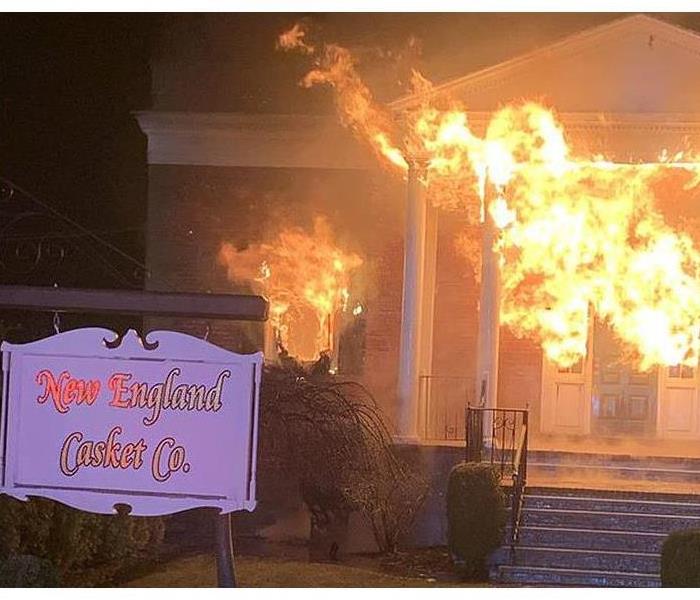 When a local business burns we all give pause. We all rise up to support in any way we can. Here at SERVPRO we inspire to be prepared. Ask us how.
When a local business burns we all give pause. We all rise up to support in any way we can. Here at SERVPRO we inspire to be prepared. Ask us how.
When owning a business, it is not a question of if we will have a disaster but when. These issues can be something such as and IT services breech, to a cataclysmic event such as a total business loss of building, materials, merchandise, equipment. Among some of the most devastating occurrences to a business is a fire. These business interruptions can be devastating. Not having a plan can make it that much worse.
Fire damage is one of the most devastating forms of loss that can occur within a business. There is so much damage beyond the fire itself. There can be toxic smoke, soot and sediment that lands on everything along with water damage. Depending on where the fire occurs and the type of business you are running can all have an impact on how much damage occurs. As with the large casket fire in East Boston the other day it is an example to us all just how devastating a fire can be. A company that deals with wood, finishes, lacquer, fabrics will ignite and have a fire spread much faster than other companies none the less the damage can and will be extensive.
When there is a commercial loss there are many other lives affected beyond your own. The business owner has to worry about the employees, customers, facility, equipment and many other things. What really happens and what is the process to fixing it.
Well before the fire is put out the items that catch on fire will release chemicals into the air within the smoke rendering it very unsafe to breath in and very corrosive to anything it happens to settle on over time. When someone arrives to put out the fire you are now adding water damage to the soot, smoke and fire damage. Often the damage can create holes in the structure expose unaffected and affected areas to outside elements causing even further damage. Once the fire is out the physical assessment of the property, equipment and merchandise must begin. Another problem as in the recent casket company fire is the building is a total loss. Meaning months of sifting through for a true cause and waiting for judgments from the insurance companies. It also means either rebuilding the facility from scratch or finding a new facility all together. Which ever ends up happening things will take time to get back to normal.
There is a lot more that a commercial property owner or business owner must assess. One of which how will this impact their business, employees, and clients. These are not as tangible as the physical items are. The impact affects all three different ways. Most of which will be determined by the length of time it will take for the business to re-open.
Business interruption is a tough one to swallow. There must be safe guard measure taken to mitigate your damages until all the repairs can be completed. This can include temporary tarps one roofs, board ups on windows doors or even sides of buildings. Removing all the wet materials from the building to reduce the risk of mold and fungus growth. This can include but is not limited to clothing/fabric, insulation, paperwork, wood, drywall etc..
Employee interruption can prove difficult. They have bills to pay and often your insurance will not be covering their lost wages. Waiting around for things to get going again is not always feasible for them. For your business if you do not have business interruption insurance you many be covered for every day you are not open making money. Subsequently in the event that the building is deemed a total loss you can expect some employees to move on for other reasons. They may not be willing or able to get to a new location.
Clients that are displaced do not have the loyalty they once did. They will seek out alternatives even within just a few days. While this is ok for the short term as time moves on things change. Once a client is in the habit of a certain location, they do not adjust well to change but will adopt a new course of action should it solve the problem at hand, meaning getting your product from somewhere else. A location move can mean you need to start with a whole new pool of clients as many will only drive just so far for an item.
Just remember when there is a fire loss at a commercial property there a lot of moving pieces. You need to surround yourself with those with the know how to get you back up and running as soon as possible. Developing a core group of professionals adept at each aspect of your business is essential in getting you back up and running as soon as possible. Having no options in times of an emergency can become very costly. Developing vendor relations now while you have the time to negotiate pricing, establish a procedure, and build a rapport significantly reduces the cost on the back end when these services are needed in an emergency. At SERVPRO of Arlington Somerville and Charlestown we strive to aid, assist, and educate our clients in all aspects of emergency services. This will allow you to be better prepared when disaster strikes. We will work with you quickly to make it “Like it never even happened”
Frostbite and Hypothermia.. What Is It and How to Stay Safe
1/2/2019 (Permalink)
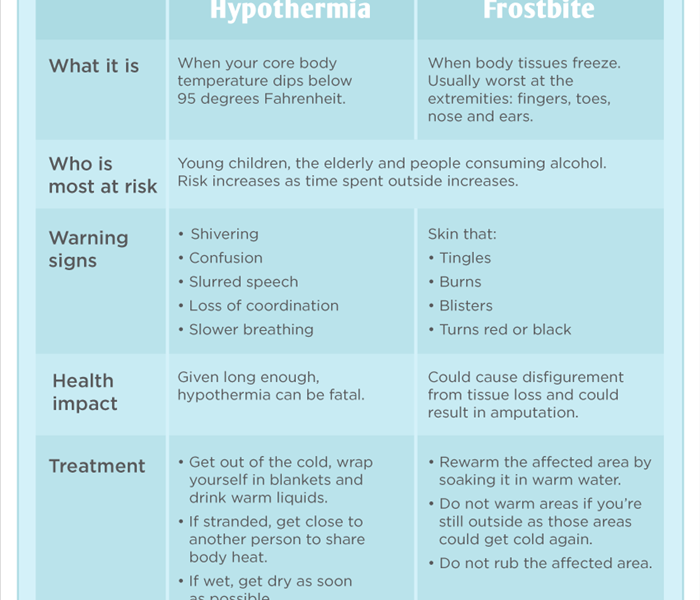 Frostbite and Hypothermia can take its toll. It can come on quickly and many do not notice. Please pay attention to the early warning signs.
Frostbite and Hypothermia can take its toll. It can come on quickly and many do not notice. Please pay attention to the early warning signs.
Frostbit and Hypothermia safety
It is New England and while the weather so far this season has lent itself to being a mild one we are not out of the woods yet. Typically a mild December lends itself to wild weather at the end of January and February. Many days have allowed those die hard New Englanders to continue to tough it out with shorts and tee shirts. That being said it is a good time for a reminder about how quickly our weather can change and what you can expect in the new two coming months.
Frost bite.
This is a very big concern that many all too often through caution to the wind. We wear the shorts, do not use the gloves, grab the flip flops and socks (WHY WHY JUST WHY), those high fashion shoes that go with your outfit that you cannot even walk on and if it is not a baseball hat who needs it. Well you do!! We have had a lot of wind this season. The wind takes those mild temperatures we have had and drastically alters them. The wind pushes the air allowing it to move through clothing easier. It also brings the real feel temperature down. If you do not have the right clothing. When you are trying to look a part you run the risk of some very severe consequences.
What is frostbite and how to tell if you have it.
There are two stages to frostbite Superficial frostbite and traditional frostbite. With any frostbite the extremities are more susceptible. Fingers, toes, nose, ears, cheeks, and chins. Some of the first indicators of frostbite are extremities start to turn red. You may also have a feeling of pins and needles in the area being affected by the cold. It can start to sting, burn or even become itchy. Looking at the color is essential it can initially be red but will start to turn gray or white maybe even a little yellow looking as the tissue becomes more damaged. If you do not rectify these issues soon enough and in the right way your skin may start to become hard and feel waxy as the cold gets into the deep parts of the tissue. Blisters may start to form especially you try to warm up the affected area the improper way.
What you should do if you suspect you are getting frostbite. First and foremost get out of the cold. Get any wet clothes off, and also get any jewelry off as it will be cold. You can put the affected area into warm water between 100-105 degrees to warm it up slowly. You can also individually wrap the area with a gauze. If your hands or feet were affected it is important that you wrap each one separately. If you are unsure about how your feeling always check with a professional and seek out emergency help right away. Once color changes start to set in you can have permanent damage up to and including amputation.
Hypothermia
This type of issue is much more drastic and affects the entire bodies core temperature when the core temperature drops to 95 and below is when trouble starts. The body tries to protect itself but routing blood to vital organs and extremities. This can result in a dangerous situation. As with any uncertainty it is imperative to seek out professional medical assistance. Until that happens there are steps you can take to help the person. Remove any wet clothes, get them into a warm environment. Surround them with warm layers of blankets and pillows for insulation. Make sure you are covering feet, hands, arms, head. It is also important to lay them down to make sure that the blood can flow easily and reduces how hard the heart has to work to move the blood around. Do not move anyone suspected of hypothermia too quickly because they are more susceptible to a cardiac event. Should something happen CPR may need to be administered until help arrives.
There are 3 stages of hypothermia they are all based on the ambient temperature of the body.
Mild: 90-95 degrees: The body tries to protect itself by increasing rate of breathing to pull in more oxygen to improve blood flow. It will also start to make you feel tired and fatigued so that major organs get more care. Blood pressure will tend to rise and shivering will commence. Coordination and judgment will begin to be impaired.
Moderate: 82.4-90 degrees: At this stage the blood pressure tends to start falling, your reflexes are more affected. Breathing heart rate and coordination become more labored and more difficult.
Severe: Less than 82.4 degrees: This is a highly critical stage in which breathing is much more difficult as the body tries to protect the brain. Your pupils will become less reactive heart attacks and full heart failure are more predominant at this point. Risk for a pulmonary edema is likely at this point.
Keep an eye out for any of these issues and try to get into a warm safe place as soon as possible. Once memory becomes impaired there is a tendency and desire to remove clothes. They can become combative and irrational.
While we are hardy New Englanders we can be too hardy and stubborn at time. The desire to look fashionable and show we can handle the cold. This can prove to have dire consequences. Please pay attention to the weather, include the wind chill in your assessment, stay alert (you are not being a baby), be smart. Making winter fun requires a little bit of safety awareness.
Extension cords, power strips and more...
12/18/2018 (Permalink)
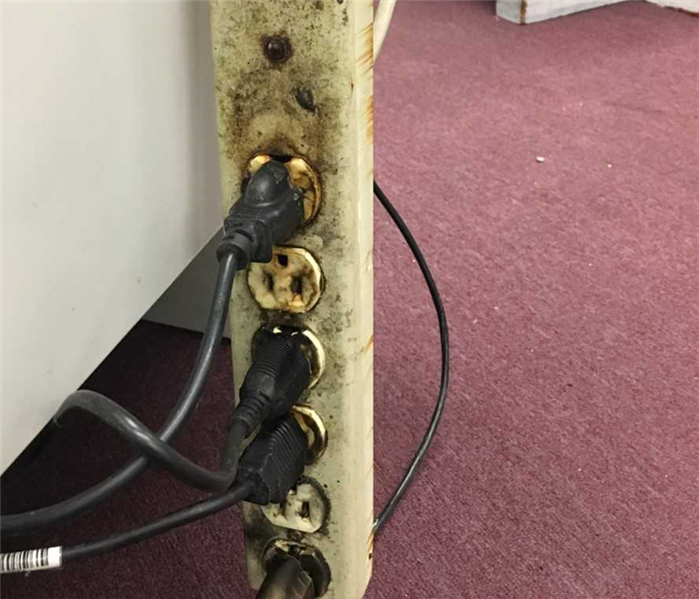 There are so many things wrong with this picture. 1) it was on the floor thus got wet. 2) Note that on the bottom is another extension cord plugged in
There are so many things wrong with this picture. 1) it was on the floor thus got wet. 2) Note that on the bottom is another extension cord plugged in
It is that time of the year again, fires lots of fires.
Let us have a real talk about the power cords, extension cords, outlet plugs, and power strips. They are not the same thing and they are not meant to be plugged into each other. The only time a power strip can have an extension cord plugged into it is when it has been hard wired into the system.
Power strips/ surge protectors/ Hard wired power strips: They are different. But we use them for the same purpose added outlets and to extend the reach of our outlets to something further away. There are some precautions that many do not know or tend to ignore for convenience. Two different types of power are drawn from various equipment high power and low power. High power equipment tends to be stuff that turns one and off ovens, toasters, coffee pots, microwaves, space heaters, refrigerators etc. Low powered equipment tends to be more steady with its power use. Computers, cell phones, Radios, TV’s etc. Know what you are trying to plug in and make sure that you stay safe.
Extension cords: We all use them. Are we using them properly? Most likely NO. Did you know they are not meant for long term use. There is also a purpose to that pesky 3rd prong on the end. The one that many of you cut off. It is a grounding wire. Ok so you didn’t break it off on purpose. It got stepped on by accident and broke off. The fact that it is missing renders the cord no good. The equipment and items that are plugged into it are not grounded. (We will get into that later) If the extension cord is not being used do not leave it plugged in. It too can not handle high powered equipment.
3 prong vs 2 prong: OK this is a simple visual but has lasting consequences. So you have a wall plug that allows only 2 prong devices. You bought one of those 3 prong adapters, and it has that weird metal thing that you have no idea why it is there. So you plug it into the outlet plug in your device and carry on with your day. Guess what that’s wrong. That little metal piece has a purpose. You are supposed to plug the adapter in such a fashion that the metal piece hangs over the screw in the middle. You are supposed to remove the screw and secure this metal hook to the faceplate. That is what converts it to a grounded outlet. ( MIND BLOWN>>>WE KNOW)
Overloading: This is another step that many ignore. They think because they have space left on the power strip they can keep plugging things in. Or if they have something like Christmas lights they can connect an infinite number of strings together to get from one side to the other. You have to take into account the capacity load that the strip can take and how much energy each piece of equipment that is being plugged is going to draw. This will avoid over loading not only the strip or power cord but also the outlet. Many outlets are tied to others and do not run on an independent power source. Understanding how everything is connected can cut down on electrical issues.
Frayed cords ( NO duct tape is not a proper fix) Before you use any electrical cords, power cords, power strips, even the cords to the items you are trying to use. It is important to inspect them. Items that have been stored could have cracked or become frayed from age. They could have been gnawed at by an animal over the course of being stored. Place duct tape over the cord does not make it safe. Will it make the item work? Probably but it is NOT safe.
Grounding: So if you are not sure what grounding is or why it is important. It gives electrical surges a place to go other than into your home or office. Providing pathways for it to travel that are safe and less conductive. Easy enough. OK so your building or home is not properly grounded. What does that mean? It means all metal becomes a conductor. You along with the static in the air also becomes a conductor. In a power surge situation the energy will escape into the building. Your body can become the conductor as electrical currents flow through easily. Fires start more easily, electrical noises increases, as does the risk of electrical shock. The Electric Power Research Institute (EPRI) states that "better than 80% of all electronic system failures that are attributed to power anomalies are actually the result of electrical wiring or grounding errors or are generated by other loads within the customer's facility.
Being electrician is not for everyone. It is also not a part time hobby like a handy-man. Make sure that you are hiring a properly license and certified electrician. For those basics around the house have a light understanding of how all of your various options work. This will keep you and everyone in your home safe.
Why SERVPRO? We are a small business too
12/11/2018 (Permalink)
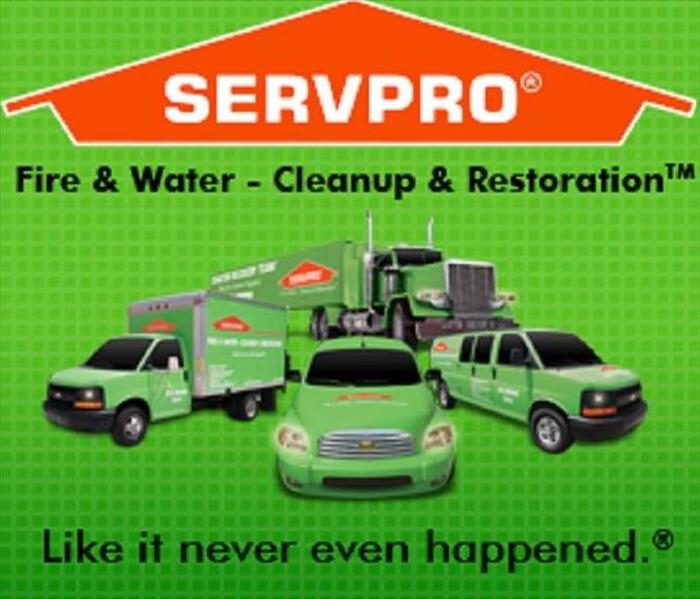 SERVPRO of East Boston, Chelsea, Revere is your local Water, Fire, Mold Remediation company that delivers you corporate service with local flair.
SERVPRO of East Boston, Chelsea, Revere is your local Water, Fire, Mold Remediation company that delivers you corporate service with local flair.
Did you know that SERVPRO is a local small business? Yes that is right while we have a strong brand behind us supporting our efforts we are a local business. We live in and around the community that we serve. We suffer the same environmental disasters that you do. Our houses have roof leaks in torrential rains. The yards and basements flood when the tides are too high or the storm drains are overloaded.
This pulse on the community separates us from those that live outside of the area or do not understand the challenges of the area. Our team sits on the same streets day in and day out that you do trying to get in to the tunnel out of eastie. We also tug along the bridge driving out of Chelsea. When the lanes on the bridge are closed and 4st exit is inaccessible it affects our teams just as much as it does our clients and those who live out that way. If your street and homes are flooded because the ocean spilled over the causeway again. Know that we will work and do our best to reach you as soon as it reopens up.
As a small local business we work to promote others. Over Small business Saturday we were out in full force with the Revere Chamber of commerce promoting small business in the community. We went and visited some great local business getting ideas for the holiday season of gifting coming up.
Making some local connections is not only the life blood of a small business but it is also the life blood of the cities that we work in. Knowing what the needs of the community are helps us to provide a better service for our clients. Understanding everything from dangerous intersections for pedestrians, to which areas are more prone to flooding. Allows us to better navigate along the roads keeping everyone as safe as possible.
Some of the key places that are strong members of the community are Oceanview kennels who takes in all the pups that have been lost until their families can be found. Or Beach sales that makes sure the best options are available for all your home needs. When we popped over to Kinship florist and saw the beauty that they bring with each display handmade with that little something special. Walking into The Good Diner is like walking into your mother’s kitchen with the wonderful smells and big smiles always welcoming and glad to see you if you stay for a spell or take it to go. Luberto’s was hard at work setting up their window displays for the holiday season. We can not wait to see what they do. It is always such a beautiful store front. Sitting with these businesses allows to add a personal touch to the mundane every day things that we do.
We have a strong relationship with not only the local Chambers of commerce but also the Cities that we work in. Being a community means taking the good with the bad. Which means when there are problems that arise, we try to hear the call and do what we can. We have worked on collecting coats and clothing for an ever growing list kids in need within the city. There have been donations to Oceanview Kennels for the pups to have warm blankets while they wait for new homes or their owners to show up to the bail them out. We have spoken with town officials about the opioid problem and worked to clean up areas of the city for beautification process. Participating in the mutli-cultural events such as the Moroccan festival celebrating the diversity of our service area. These events and more really keep us in touch with the cities. There are members of our team that are even on the Board of directors for some of the local chambers and actively participate in others as well.
As this year comes to a close it is also important to know we support the local first responders that keep our cities safe. They daily put their lives on the line. Supporting the fire and police departments especially when they lose one of there own is essential. It has been a tough year for local engine houses. Fires during the winter months are especially tough. Coming off of the Merrimack Valley gas disaster has tested our first responders to the limits. We want them to know we are thankful for every day they show up and put their lives on the line for our safety.
So when you say why SERVPRO .. you have to really look at the fact that we have the backing of the corporate brand to handle any size disaster that comes our way with the local home town feel. We can be faster to any disaster and will work with you to make it “Like it never even happened.”
Water Water everywhere!!!
11/26/2018 (Permalink)
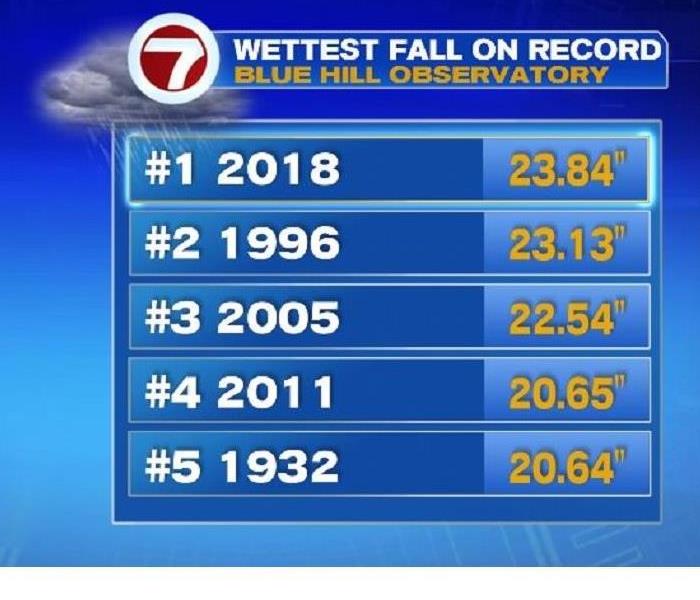 Fall in Massachusetts has been the wettest on record with still a few days and inches to go. This spring we could be in for some serious flooding.
Fall in Massachusetts has been the wettest on record with still a few days and inches to go. This spring we could be in for some serious flooding.
Do you feel like it has been an endless rainy season in what is notoriously a dry season? You would be right. We have some of the oldest records for weather in the country right here in Mass. Blue Hill records date back to the late 1800’s and as of November 26, 2018 we had achieved the wettest fall on record. With more rain on the way it is shaping up to be a wet one.
This rain can have a big impact on winter storm damage to homes and businesses. How can that be you ask? Here are just a few examples.
Freezing: Water is unlike any other element on the planet. It expands as it cools rather than shrink. This causes all sorts of problems. If you have a small leak in the home from all this rain that is out of sight. When the cold weather sets in it will freeze. Many times, this freezing will occur and cause a lot of damage. Since water expands as it freezes any area that is saturated will expand either allowing more water in or cracking any materials that is stuck inside of. Be it a roof, wood framing, corner of a home or foundation, etc..
So, what can you do: Have a trusted contractor walk around the house look into the attic, basement, crawlspace and work on detecting anything out of the normal. Any edges of your home that show signs of rot, or water damage, Check inside the attic for any damp or wet insulation. Look in the crawl space for any signs of water coming through the foundation. Damage to any flooring, place any insulation over pipes that may have fallen off. Clear out all the gutters so that nothing is blocking the down spouts either from the top or at the output on the bottom.
Saturated soil: Soil that is unnaturally wet for extended periods of time can have damaging effects on trees. Many times, the roots have a hard time holding onto the soil and in high wind events can cause the tree to topple over many onto a home or car. There is also the effect water has on the roots themselves. If the tree is not prone to doing well in significantly wet soil the roots can start to rot. This rot can happen in even a healthy-looking tree causing it too to fall over.
So, what can you do: Walk your property ideally with a tree care professional. Have any leaders removed. Trim any branches that seem precarious. Inspect the trees and roots for any thing that looks like it will not hold during a storm.
Water intrusion: All this water has to go somewhere many times it does not have the ability to run off or be absorbed by the ground at the same rate when frost starts to set it. This allows the water to travel further than it normally would. Meaning there could be flooding events in areas that there are not normally any. It may also travel for a distance then a cold snap will freeze it in place. This causes a crack in a foundation. Allowing the warm air from your home to get out thawing out the water. This water will travel into your home as it thaws if left unnoticed you will have a major problem on your hands
As we continue to see rivers rise during a time of year that they normally slow to a trickle we have to be worried about what will happen. In the spring when all the snow melt, and runoff drains into already overloaded springs, streams, and rivers. We will see a lot more flooding events and now is the time to prepare.
So, what can you do: You can learn where your existing flood zones for your area are. See if you are downhill from any streams, rivers, ponds really any bodies of water. Follow the link below if you are not sure. https://msc.fema.gov/portal/search
It is a great time to look at your insurance policies. Make sure you have flood coverage. This will not be tied to the regular home owner’s insurance you have. It is a separate policy. Look it over, make sure you have both home coverage as well as contents. If you are not in a flood zone that is the best time to get flood insurance, it is much more cost effective. It can also protect you should the zoning change during a reevaluation time.
As our climate changes, storms become more intense and the extreme weather. It is important to know that those hundred-year storms events will be more like 3-year storm events if not more frequent than that. Knowing what water can do the soil, trees, and your home is key. Being prepared is more important than ever. Finding water damage before it becomes a major problem is going to help you keep things under control. Developing good home inspection habits will help avoid costly repairs later.
Space Heater Safety
11/23/2018 (Permalink)
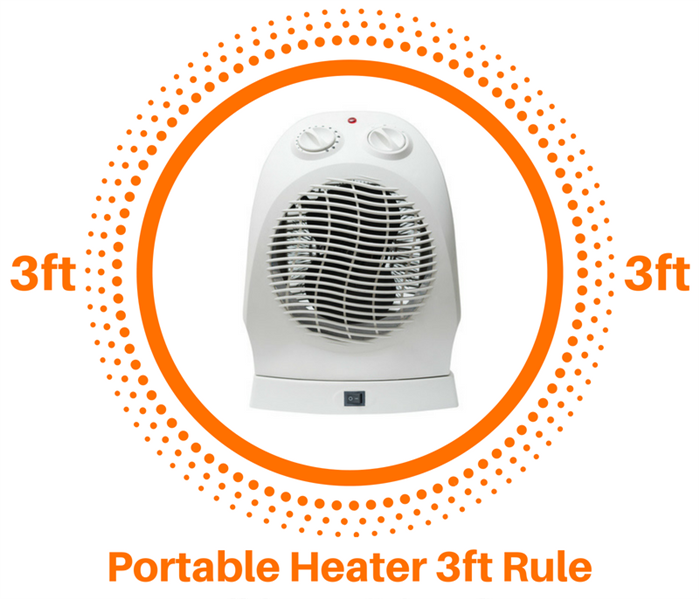 Space heaters are a great way to add warmth to a room. Being safe and understanding the best way to do that is essential.
Space heaters are a great way to add warmth to a room. Being safe and understanding the best way to do that is essential.
It may not be officially winter in New England but it is sure has not stopped mother nature from delivering us some snow and arctic blasts. With century breaking cold coming for Thanksgiving this year we really need to look at home heating. Many in Massachusetts are not even in their homes due to fires in the Merrimack Valley area. That means more people will be using space heaters to stay warm. They are small, portable and cost effective. That alone does not make them safe.
Space heaters and other heating equipment causes almost 70,000 fires every year. Damages both monetarily, physically and emotionally are insurmountable and sadly as is the case in California can often times spread having devastating results. Winter is a dry season with a lot of leaves on the ground. That being said let us focus on how to stay safe while we all try to stay warm.
Heating equipment is the second leading cause of home fires in the United States. More than 65,000 home fires are attributed to heating equipment each year. These fire result in hundreds of deaths, thousands of injuries and millions of dollars in property damage.
When you get a space heater making sure that the new one is the right fit for you needs will help with keeping everyone safe. Space heaters use electricity which means these is a risk of sparks, frayed or faulty wiring. Below you will find some key point to use as consideration when using them.
Choosing the right heater for your space can go a long ways in terms of keeping you safe. There is a little bit of math involved but it is relatively easy. Get the square footage of the room, it takes approximately 10 watts per square foot. So a 12X12 SQ Ft room needs about 1,440 watts to heat. Ok but the packaging for the heaters say BTU’s so now what. Multiply the watts by 3.41. A single watt is equivalent to 3.41 watts. So that sized room needs about 4,910 BTU unit heater. Guess what unless your room is much bigger than that most heaters run in at 5,100 BTU’s or 1500 watts. Pretty convenient right. Yes we thought so to. Just like a lot of products out there are counterfeit or knock offs. It is important to avoid these as they will have not been safety tested properly.
So now you have the proper sized space heater. Let us take a look at where the best place is to put it, along with what are some basic safety tips.
Make sure your space heater has the label showing that it is listed by a recognized testing laboratory.
- Make sure you are familiar with how your specific unit works. Read all the warnings and labels. The instructions can vary from unit to unit so do not assume the one you had years ago functions the same. Technology and requirements change. .
- Before use it is important to inspect the unit for broken cords, frayed wires, any damage or cracks. If any of that is found DO NOT USE
- Never leave a space heater unattended. Turn it off when you're leaving a room or going to sleep, and don't let pets or children play too close to a space heater.
- DO NOT use these units to try and cook food, dry anything or warm up a bed. Space heaters are only meant to provide heat to a space only. Woman in Lowell caused a fire 2 day after she was given a space heater for misusing it.
- Change all batteries in every smoke alarm in the house before using a space heater. There needs to be one on every floor. Make sure you conduct monthly tests to ensure proper working order.
- Keep them at least 3 ft away from anything flammable. This includes rugs, curtains, blankets and paper products.
- Keep cords and placement location out of main high traffic areas of your home. If you have to run the cord through an area that is walked through a lot tape the cord down. As flush against a wall as possible.
- They go directly into WALL outlets. DO NOT ***DO NOT*** use an extension cord or power strip. It is also important to not plug other high energy draining devices into the outlet. Sudden surges such as a toaster oven can cause overheating and start fires.
- The best places for a space heater is on the floor. For a few reasons. One of which is that heat rises and you want as much warm air to move throughout the room. The other is that it is a flat surface. If placed on a table or piece of furniture you run the risk of something else being placed on or near it increasing the risk of fire.
- If you are not using the space heater, make sure it is always unplugged.
Ok so now that you know how to stay safe and properly use a space heater lets get to enjoying the warmth. Have a safe and happy holiday season.
Water Prevention Technology
11/13/2018 (Permalink)
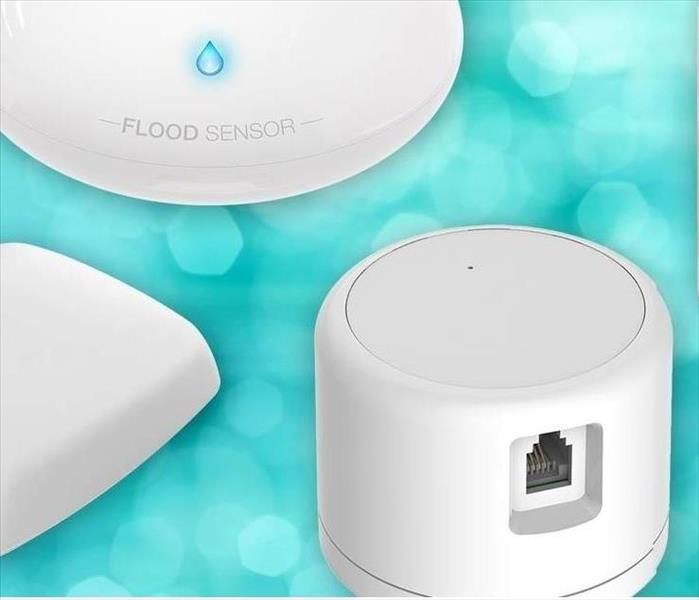 Water damage even a small leak can result in big damage. Learn what options are available and best suit your lifestyle and needs.
Water damage even a small leak can result in big damage. Learn what options are available and best suit your lifestyle and needs.
SERVPRO of East Boston Chelsea & Revere we see our fair share of the intense damage cause by water. We are always trying to keep a pulse on how these damages can be prevented. Searching out new technologies for our clients and putting the information out for our clients to find.
Over the years we have seen great advances in these areas. Streets that can absorb gallons upon gallons of water which aids in reducing run off and drainage and sewer system overload. The ability to recycle and clean water to reduce pollutants and contaminates within the environment. There has also been extensive research on ways to harness water for electricity consumption. The ones that directly affect your homes and businesses are the ones that get us the most excited.
We should all be aware by now of the importance of smoke detectors and Carbon monoxide detectors. Many of us even keep a fire extinguisher on hand. Yet so many of us fail to take the same precautions with water.
While the amount of damage caused by a fire is extensive and does cost the most. I highest number of claims called in comes from water damage. Often times these claims stem from leaks that have gone unnoticed or have happened when no one was home. A poorly timed disaster could happen while you are on a vacation, at a family function or away for work. Having no alarm system or warning system in place can lead to a great deal of damage.
There are answers and they can be autonomous and tied directly to apps on your phone to ensure damages are mitigated and any potential issues are caught as soon as possible. The variety of options run the gamut in price, engagement and notification options.
Simplicity and ease of use for some basic peace of mind comes in the way of battery-operated or simple plug ins. Some of the most cost-effective devices in this category can tie directly to your cell phone. The water will prompt the device to send a message to your cell phone. They often will not have an alarm that would go off within the home.
Others are a bit more intricate and required them to be built into the infrastructure of the home. These are similar to the built-in smoke detectors in your home. These devices may require to be plugged into an actual outlet but will work with your homes WIFI. They have water sensors you can place in front of items such as boilers or even on pipes directly that will alert you of temperature changes.
There are more that are full smart home ready devices. They can not only tie to your smart phone but also your Alexa or google home devices providing automatic shut off options as well. These smart home devices have some intricate features that allow them to go as far as turning off the water if a leak is detected. Due to this feature you will need the aid of a certified plumber to install them making the upfront costs a bit more.
As with some of the higher end home service options there are monitoring centers staffed with trained individuals that can call and notify you of any changes within your system. This could even assist with troubleshooting what the problem could be and how to fix it.
Do you have a property that you rent out? Are you a property management company that has a new tenant and seen a spike in the water usage of a particular unit? Well they have a device for that as well. It will monitor water pressure, temperature and which devices are consuming the water. Do you have toilet that is running constantly that a tenant did not tell your about? Has the washing machine see its last day and uses far more water than the newer models. Does that dishwasher have a leak that no one sees? These sensors can help to assess and determine your best options as well as catching a problem long before it even becomes one.
As time progresses and more of these items are adapted and technology changes. There will be more sensor options. Some have even begun to offer them for Gas shut offs as well. Commercial businesses are always looking for cost cutting measures. These water sensors can be an integral part of the assessments on when to upgrade appliances and aging systems.
It is imperative with water being such a scarce commodity with essential for life be we all take steps to ensure it is not wasted. Saving us all money and protecting the planet. Here at SERVPRO we must ensure our team and our clients know about the options out there for protecting their homes and businesses.
Below you will find a link to some of the key products that have been rated. While we understand it is a somewhat older article it is a great assessment of the range of products available.
https://www.tomsguide.com/us/best-water-leak-protectors,review-4953.html
Holidays and Fire safety
11/12/2018 (Permalink)
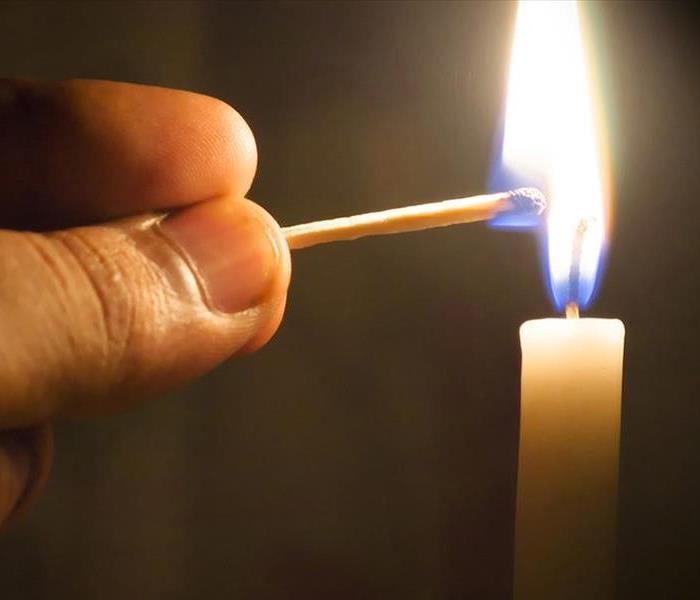 Fire risk in homes increases during the holiday season. Candles, cooking, fireplaces and dried trees all add to the risk. Prepare, plan, prevent.
Fire risk in homes increases during the holiday season. Candles, cooking, fireplaces and dried trees all add to the risk. Prepare, plan, prevent.
Fire safety…
With the recent infernos spreading throughout California we feel the need to remind people about fire dangers here at home. The holidays are fast approaching being able to spend time with the ones that we love. Often that time is spent in the kitchen, next to a roaring fire, creating a mood with some extra candles, curled up in an electric blanket , or even just getting out the chill with a boost of heat from a space heater. With temperatures dipping there is also an increased instance of smoking within in the home as it is simply too cold for some to go outside.
Many of these things are traditions that shape our lives. Yet these are the same traditions that see a spike in disaster this time of the year. We will dissect each of these to ensure you have the tips you need to keep you and the traditions alive.
Smoking inside, this is actually the easiest one to avoid. JUST DO NOT DO IT… The number one cause of deaths from fires every year is this one thing. Many times it is out of exhaustion or combined with something else such as alcohol. Falling asleep with a lit cigarette or other similar device has devastating consequences. So how do you stay safe with this one..
- Stay outside
- Use a deep ashtray ( not the ground is not safe to toss it)
- Fill the ashtray with a sand water combination & keep it far away from anything that can burn
- Stay away from flammable materials such as oxygen and gasoline ( Yup that’s right no smoking in the garage either)
- Use fire safe cigarettes (Yes they exist)
- E-Cigarettes count too…they can explode.. ignite while charging or even in transport be wary and use the same precautions
Electrical Fires
These fires are caused by a number of different things. Over the holiday season many of us have more lights plugged in to illuminate our lives during season. Extra lights, extension cords, power strips and additional strain on many of the outlets within your home. Before you get started any additional cords need to be checked for frayed wires, cracked, chipped, or chewed( animals like to do that) . Do not overload any one outlet, if you are not sure which outlet coincides with what have a certified electrician check it out for you. Do not run a cord in main walking paths they can pose a tripping hazard but could also be partially pulled out. This could cause serious fire risk from an improper connection. Never use an outlet that does not have the faceplate properly installed. Below is a more entailed punchlist.
- Ensure bulbs match the wattage output of the device
- Do not REPETE DO NOT plug a power strip into another power strip.
- Do not overload an outlet
- Avoid tripping the breaker if you do you have overloaded the outlet.
- Check for frayed, chipped, cracked or chewed wires.
- Place all power strips up off of the floor. ( This keeps it out of reach of kids and pets and water should you have a pipe break.
- Use only 1 heat producing items per outlet. (i.e coffee pot, space heater, toaster etc.
Candles
Candles so many people add candles for both religious and aesthetical reasons over the holiday season. The top 3 days for candle fires are Christmas, New Years Eve and New Years day. Falling asleep with a lit candle is a key factor to these fires. Almost 60% were caused because a combustible material was left too close to the lit candle itself. So what do you do to have them safely in your home.
- Blow them out when you leave the room for an extended period of time.
- Keep them 1ft at a minimum away in all directions from flammable materials.
- Use a steady surface
- Use a candle holder with a wide base.
- Do not place in a window
- Keep all matches, ignition materials or combustible materials out of reach of children.
- If someone in the home uses oxygen DO NOT use them no matter the reason.
Heating fires.
These are the peak months for heating fires. December, January, February. Many of the electrical and smoking safety tips apply here. Increasing the usage of fireplaces & space heaters. It is essential for all outlets to not be overloaded. Ensure that only one heat producing appliance or large use appliance is plugged into the outlet. Do not under any circumstances use a power strip, or extension cord for these devices.
- Provide proper fire safety glass. ( regular glass will explode)
- Add any necessary screening metal / glass combinations
- Fireplace extensions that are non-flammable to catch any escaping embers or ashes
- Never transfer hot ashes
- No frayed wires
- Keep all heat sources 3ft away from any flammable
Cooking:
Last but certainly not least. Cooking is a significant cause of fires in this country. Most home fires actually stem from cooking. Be it deep frying a turkey ( BAD IDEA), Grease fires, oven or stove top cooking . Cooking is fun, engaging and full of memories made. Make them happy ones. Develop good habits.
- Never leave a flame unattended.
- Keep flammable materials away from the stove. ( towels, oven mitts, wooden utensils etc.)
- Keep decorations away from stoves as well
- Always set incremental timers to periodically check on items in oven 15 min is a good recommendation.
- Use splatter shields.
- Have a portable fire extinguisher with the proper fire rating code on hand.
- Fighting the fire yourself can result in serious injuries. Best to get out and call a professional.
Nothing is guaranteed. Accidents do happen and the best things we can do is be prepared and cautious. It is important to know that if a fire breaks out knowing as soon as possible can and will save your life. Changing the batteries in your smoke and carbon monoxide detectors every 6 months is the best way to get make sure you are notified right away. You can have a little as 2 minutes to get out of the house once a fire takes hold in a home. Check your cords on everything replace or adjust accordingly, have safe distance from any flammable materials, be diligent about the kids, and pets around kids electricity and flames.
While nothing is 100% guaranteed taking steps to protect yourself, your loved ones as well as neighbors can go a long way. Develop good habits that allow all memories to be ones that we can share and cherish.
Training
11/12/2018 (Permalink)
 Training your staff and having the proper relationships with all that you work with. That is what makes the difference between good and great.
Training your staff and having the proper relationships with all that you work with. That is what makes the difference between good and great.
Why SERVPRO?
The training SERVPRO has as minimum requirements is extensive. Throughout each division of the company training is a vital part of everything that we do. SERVPRO has dedicated a great deal of time and energy into proprietary software to log, track, manage and process your claim. Members of staff at every level have a working knowledge of this software allowing us to track your job progress, log adjusters’ notes, questions and concerns so everyone is aware of its status.
Many members of our team are also cross-trained. This makes sure each person knows what is expected, how things affect our clients and what should be done on each call.
A strong understanding of each community coupled with the ability to address those needs is an important part of every business. Having the right people to address those needs is what makes every business great. We at SERVPRO are committed to this process. Training and development of our staff is the best way we know how.
Field training: Our on-site team receives hours of hands on training in all various aspects of our service offerings. Various techniques are required for each type of job we do. While every job we encounter is very different as are the needs of each client. When a Fire, Water, Mold, Smoke disaster strikes it is comforting to know that the experience that comes with those working in your home eases the process.
Supervisor Training: Our field supervisors training is a step above the rest with a litany of certifications ranging from EPA Lead Safe Renovation, Applied Structural Drying, Water Restoration Training, Subrogation training. Estimating writing certifications for the same software that the insurance adjusters use is also obtained. These certifications help provide peace of mind that the job will be done correctly the first time.
Office Training: Our office staff works tirelessly reviewing your claim prior to sending it off to the insurance company. Each insurance company has varied requirements for what they want to see when they are processing a claim. Working closely with the field team our office staff produces just what each agent is looking for. Smoothing out and streamlining the process ensures that your claim is paid quickly and your rebuild can begin promptly. Bi- annual training sessions that encourage team collaboration really strengthens the resolve to be the best. It allows provides various team members that would not otherwise meet to put a face to the name.
Operational training: The operational teams training is very similar to the office team. There are added levels of knowledge of things such as Human Resources, Accounts receivable and payable. The operational team also works with various vendors to promote the smoothest transition possible. Maintaining relationships with plumbers, electricians, reconstruction teams, dumpster companies and other various companies. These strong relationships are crucial in determining the speed at which we can work through your claim.
Sales/marketing Training: Marketing degrees are held by our team members in this position. Having a solid understanding of our how and what happens through a claim is extremely important. They have a lot of the same certifications and training that the field receives. With working hands on working days as well. Our sales and marketing team must have a pulse on the community. Understanding the needs of the variety of clients we serve both commercially and residentially. What happens on one side of the city may be very different on the other. Through local chamber of commerce participation, networking groups and many other community involvement activities we are able to stay right on top of everything. They have degrees in marketing along with a lot of field certifications. The team also works to highlight the first responders of each area. Maintaining relations with city officials and holding the SERVPRO brand to a higher standard.
So when you are asking Why SERVPRO? It may be easier to say Why not SERVPRO? There are many moving pieces to your claim. Having the properly certified, insured and registered professionals at your fingertips is the key to getting back to “Like it never even happened”
Large Commercial Loss.... What do you do first?
9/10/2018 (Permalink)
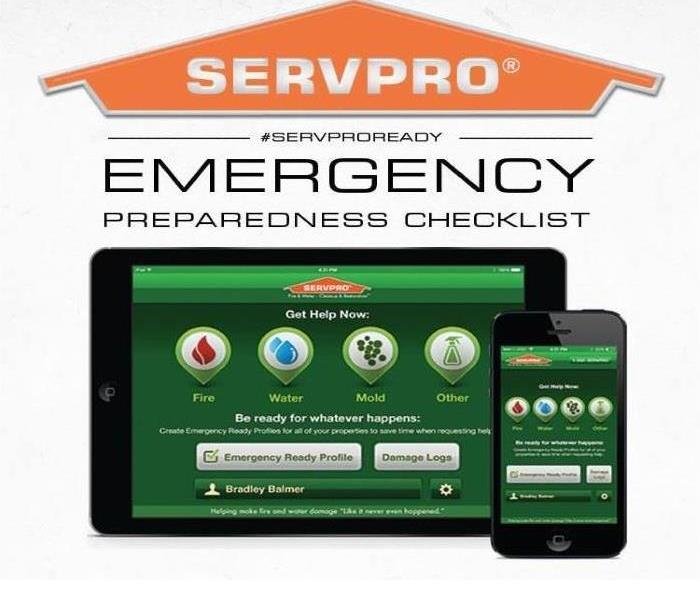 Having a plan before an emergency strikes allows you to be more likely bounce back. "Like it never even happened"
Having a plan before an emergency strikes allows you to be more likely bounce back. "Like it never even happened"
Did you know that SERVPRO team member and staff receive extensive training on commercial property losses? There are more moving pieces to a commercial property loss than a residential loss.
While the scope of the work is the same, remove the damaged materials, clean the affected areas, dry out the area. Many businesses have special requirements. Some need to stay open during the process. Others are dealing with food and or patient care. Certain businesses have sensitive documents that require specialty handling. Patient privacy and HIPPA regulations many times dictate who can handle their documents.
Immediate responses are essential to getting things back on track. Coordination with priority responders for gaining access to the facility. Scoping out the loss along with developing a plan. Communicating with IT services, plumbing, electrical and cubical management companies is pivotal. Ensuring that each moving piece of the business is coordinated.
Larger commercial projects require more resources, staffing, equipment and time. Major damage can result in significant business interruption. Everything from the entrance that employees use, where they park along with where they will be working. Has their equipment been damaged, document access been restricted or destroyed?
Commercial properties
Strategic containment barriers should be set up in multi-use buildings that allow the work to be done with out risk of cross contamination. Many times, multiple floors will have been affected in these large buildings. Working with property managers allow us to get into all floors quickly to ensure building safety through building stabilization, wall ceiling and floor demolition. Along with clear moisture mapping to ensure structural drying, all mechanicals and air systems can be cleaned as well.
Many businesses that maintain large file systems, such as lawyers, doctors’ offices, veterinarians, hospitals, tax accountants need special care with their documents. If they have not transitioned over to a scanning system, the documents will need to be salvaged. There are special freeze-drying chambers to accommodate such a process. Some of these some businesses handle special documents covered by HIPPA regulations or client/ patient confidentiality. Do those coming in to handle these personal documents have the proper certifications or security clearance to handle them?
Coordination is key when dealing with a large loss. Making sure all the appropriate connections ahead of time is essential to creating a seamless remediation process. Developing relationships with a variety of vendors before problems arise ensures that immediate response times are kept to a minimum. Just some of the vendors we build relationships with are temporary Labor, scaffolding, high lift equipment, document drying, ice house, moving companies, portable power, dumpster/waste companies, desiccant/ climate control, portable toilet services, dry cleaning, construction, emergency/ temp fencing, board up & roofing, IT services, fine art restoration, as well as temporary warehouse space.
The best way a business can recover from any disaster is to be prepared. Does someone in your company know where all the shut of valves are for your floor or the entire building? Where are essential electrical shut off locations? Where is the HVAC unit kept? What is the emergency evacuation plan for the building and where is your companies meeting place? Aside from emergency personnel who is the first person you should be contacting?
If even one of these questions cannot be answered you need to create an Emergency Ready Profile. Preparing you, your building, staff and tenants.
Sinkholes and waters role
8/9/2018 (Permalink)
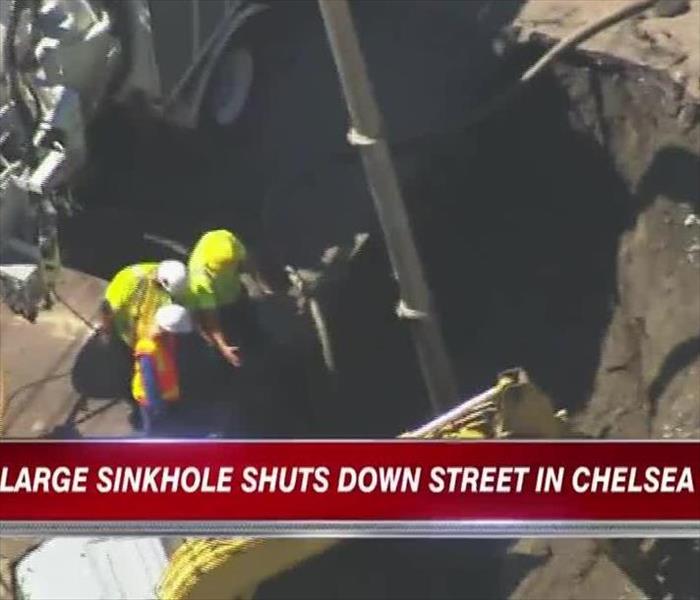 Water is really to blame for all sinkholes be it a natural occurring event or a man-made problem from aging pipes breaks.
Water is really to blame for all sinkholes be it a natural occurring event or a man-made problem from aging pipes breaks.
Sink holes. What causes them? How does water affect them? What to do when one opens up near you.? Is it covered by insurance?
Florida is not the only area that can experience a sink hole. To better understand how and why they happen a little geology lesson is needed.
What causes them?
Bedrock that has a lot of limestone, carbonate rock or salt deposits will be more likely to erode. Resulting in holes that can no longer support the ground above it. Sink holes can also develop if an object such as a building is built on soil it too soft to support the weight.
How does water affect them?
The cause of this erosion is from water. As water passes through the top layers of soil, plants, roots and decaying materials making the water more acidic. As more material is eroded out of the rock the hole becomes larger eventually too large to sustain the earth that remains above it. These holes can open on a street, under a building, or on the edge of a cliff.
What to do if a sinkhole opens on your property?
Vacate your home or office immediately. Contact emergency professionals to have the area roped off. Reach out to your insurance company to have them send out an adjuster to make an initial assessment. Sinkholes NEVER get better. You will have to work with engineers to decide on the proper course of action. Getting someone to come out and take soil samples every 5 ft will provide a good picture of what is going on. Note this testing can take 3-5 weeks and may require payment from you. It is not cheap with average cost running $4,000-$8,000. Also know many insurance companies do not cover sinkhole damage unless you have separate insurance similar to flood insurance. Know what your policy covers if you think you are in a high-risk area.
As more and more flooding events occur these events will increase. As aging pipes fail and water is forced out into these already susceptible areas washing out the support materials even faster that normal.
There are 3 different kinds of sink holes cover collapses sink holes, cover substance & solution sink holes. They also have two ways they are created naturally and manmade. There is nothing that can be done about the naturally occurring ones. The man-made ones that is a whole different story.
The man-made ones stem from pipes underground breaking and washing away the soil they are sitting in. In turn they are compromising the materials above them. While natural sink holes have the same risks and cause the same problems. Maintaining pipes and catching small leaks before they become big problems is essential to reducing the damage that they can cause.
Watermain breaks and sewer systems that are overloaded. are a contributing factor to sink hole development. When the pipe breaks the water will find a way to go somewhere. The force pushing the water through those pipes is immense and will continue to push water through if it is broken or not. Water will expand out from the break forcing the earth away as well.
Sewer systems that become overloaded will force water out of a controlled pipe system onto the streets, sidewalks, front yards allowing it to get into a lot of developed ground that has been leveled with sand allowing it to wash away.
Which is why it is essential to never drive through a flooded area. You can not see if a sink hole has been created. Water is level with the surface that it sits on. This water is always muddy and the bottom where the ground is can never been properly assessed. These sink holes can be a few feet or upwards or 50ft or more. They can also release a lot of toxic fumes contaminating the water. Please stay out of the waters and wait, go around and seek alternate route.
Treating a flooded road or area the same as if there was a storm event is essential for your safety. Only 6inches of moving water can knock someone off their feet. If you are off balance and fall into contaminated water, you should seek medical attention and rinse the water off immediately. Taking a sample of the water to the doctors office can help them assess your real risk. Toxic chemical, bacteria, and virus thrive in water and can be ingested if you are yelling for help or over exerted and are breathing through your mouth. Allowing that bacteria to enter your digestive system and or your lungs.
It is better to just be smart and stay out of the area. Do not drive around barriers. Do not walk through the flooded water if you can avoid it. Do not drive your car through these roads or flooded our areas. Again it is impossible to know how deep they are.
Remember get out of immediate danger, call authorities, and DO NOT DRIVE OR WALK through flood waters.
Photo courtesy of
https://whdh.com/news/large-sinkhole-rips-open-street-in-chelsea/
Freeze drying and why you should care
7/31/2018 (Permalink)
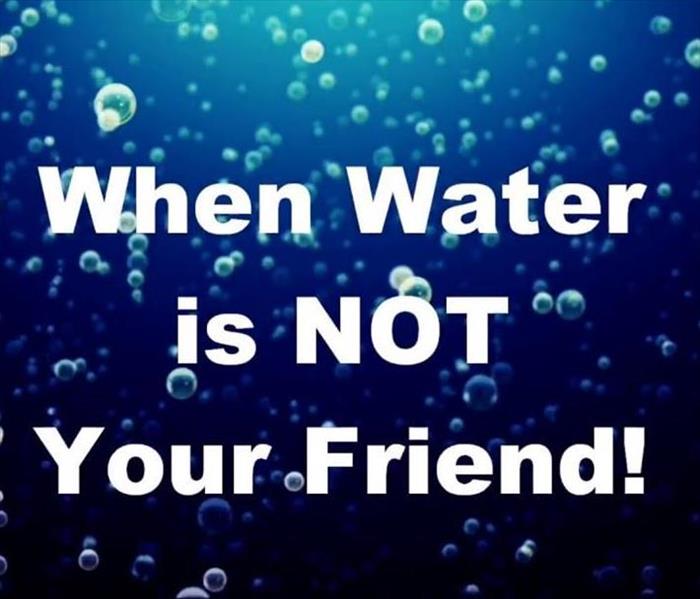 Water is not always your friend. Especially if you run an office that requires a lot of documents and secure information to be kept.
Water is not always your friend. Especially if you run an office that requires a lot of documents and secure information to be kept.
Do you have a lot of important documents in your office?
Is your office subjected to HIPPA regulations or client and patient confidentiality laws?
What is your plan for all those if you have a water damage event?
Did you know that SERVPRO has a solution for that?
It starts with a relationship with your facility and an understanding about what the process is and how it works. Here is a snapshot. We need to have someone from your office that can assist with proper labeling of the boxes so none of the files are misfiled.
The next steps are critical and will ensure the largest number of documents survive.
Freezing Documents/Cold Storage
Where to find Cold Storage Facilities. Grocery Stores tend to have a vendor in their area that rents cold storage spaces to store their excess frozen goods until they are ready to be put on the shelf. These facilities regularly have extra space and will store documents as well. Price may vary depending on your location. However the average rate around the country is roughly $4 a cubic foot per month. These facilities should be used primarily if you need Long-Term storage. SERVPRO Industries, Inc. also has cold storage available. Call and ask about available space and pricing. Documents should be sent to SERVPRO Industries, Inc. as soon as possible in order to minimize damage to documents and facilitate drying procedures to ensure efficient return.
Shipping
Any of the major shipping carriers (UPS, FedEx, USPS) will work for smaller orders. Overnight Shipping is a MUST. Whether the documents are frozen or not. It is crucial that we receive these documents as soon as possible in order to keep them frozen until they are ready to be cycled through the chamber. This prevents further damage and deterioration. Overnight shipping is most important when dealing with documents that have not been frozen PRIOR to shipping. The sooner we receive documents that have not been frozen the sooner we can freeze them and stop them from further damage/deterioration. Refrigerated Trucks and Trailers (Reefer Trucks) Reefer trucks come in many different sizes, ranging from 16’ box trucks all the way to 53’ tractor trailers. They can be rented from a lot of the major rental companies like Penske, and Ryder. There are even smaller rental companies all over the nation that rent reefer trucks. Reefer trucks work the best when dealing with larger quantities of documents. This is because it doubles as your cold storage as well as shipping! Once you have the truck packed, all you have to do is find a driver to drive it to us and we’ll handle the rest!
Benefits of Vacuum Freeze Drying
- Vacuum Freeze drying
- Process in which an item containing moisture is frozen anddried using various vacuums and pressures to achieve sublimation.
- Sublimation is the direct conversion of a solid (Ice) into a gas (water vapor), without passage through a liquid stage. Take Dry Ice for example. Dry ice is made of Carbon Dioxide, not water. When dry ice is exposed to normal atmospheric conditions it begins to sublimate, it turns directly from its sold stage into its gaseous stage bypassing the liquid stage
- Why Vacuum Freeze Drying?
- Vacuum Freeze Drying is the most efficient and effective way to salvage water damaged documents. It is the only method that is approved by NARA (National Archives and Records Administration) and the GSA (General Services Administration). Other Methods such as dehumidification can alter the structure of the paper’s fibers and cause the papers to become more brittle, and is not recommended by any means.
Other Services Provided
- Digitizing
- With the new age of technology majority of people have begun digitizing their documentation rather than keeping the hard paper copies. However, businesses that have been around for a long time (Hospitals, Law Firms, State and Federal Governments) still have a surplus of paper documentation. Most of these businesses do not have the time to digitize these old files. In the event that these documents need to be salvaged, digitizing may also be a good option. It makes them easier to access as well as easier to store. Many businesses have storage facilities that are specifically for documents, or they subcontract the storage and upkeep to a company like Iron Mountain. This makes accessing a particular file very difficult and painstaking.
In a contaminated water situation (Sewage or Flood water) documents are not only deteriorating but are also infected with all types of bacteria. As you all know in most storm situations you are dealing with contaminated water, therefore most of the affected documents that you will encounter will be contaminated. If this is the case than de-contamination is always a must.
Certified destruction:
Health Insurance Portability and Accountability Act (HIPAA) Compliance
What is HIPAA?
Requires the protection and confidential handling of protected health information.
Why HIPAA is important?
- Doctors by law cannot release PHI (Protected Health Information) to just anyone. With that being said, covered entities (Hospitals, Physicians, Doctors, etc.) cannot release PHI for the purpose of recovery and/or restoration to anyone unless that Business Associate (BA) is HIPAA compliant. This is to ensure that their patient records are being handled properly and with minimal risk for any PHI to be compromised.
- Chain of Custody is the tracking of sensitive documents (or any documents) through a process. This depicts whose hands the documents passed through and when, allowing any company to track down any leaks of sensitive information (if such situation where to occur). It is crucial when handling sensitive documentation, especially when dealing with protected health information (Commonly Referred to as PHI).
- HIPAA Certifications ensure that personnel are Master HIPAA certified to handle PHI. This certification allows SERVPRO not only to handle PHI, but tells Covered Entities that we are held to a high standard and can and will be held accountable if any information is compromised.
We hope that this has given you something to think about. Should you like us to go through this further with those at your office please call us at 617-567-3777 and set up your appointment today.
Fire Fire everywhere … What do you do ...
7/30/2018 (Permalink)
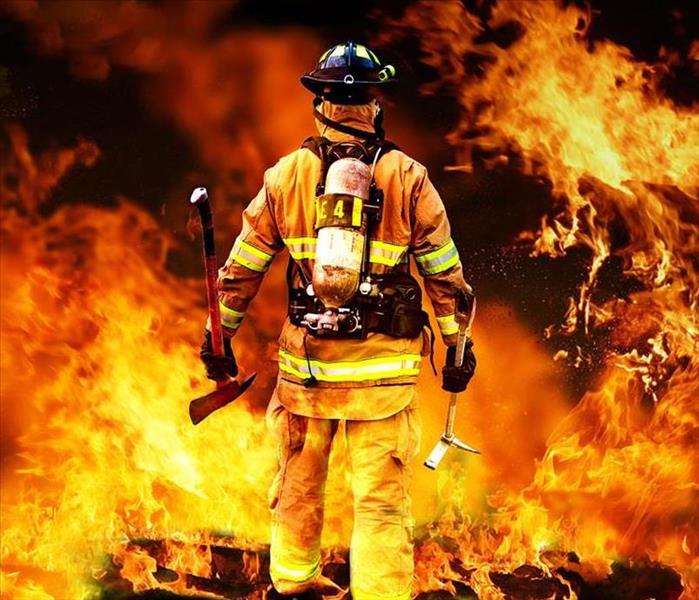 These men and women put their lives on the line daily for us. Please take steps, be cautious, and mindful so they do not have to.
These men and women put their lives on the line daily for us. Please take steps, be cautious, and mindful so they do not have to.
Our friends at NFPA have some great tips and ideas on how to prevent fires. Due to the fires out west that are leveling homes and killing both firefighters and those who live in that area.
These fires are fast moving and the amount of smoke they cause can be just as deadly as the flames. Please use caution when presented with a fire situation. Even better is to use caution to prevent them.
Today, people who die in fires typically die in ones and twos, in their own homes and vehicles.
Fire in the home
Home is the place people feel safest from fire, but it’s actually the place they’re at greatest risk. Approximately 80% of all U.S. fire deaths occur in the home; an average of seven people die in home fires every day.
According to NFPA’s latest reports, home fires and home fire deaths declined by about 50% since 1980. However, the 7.8 deaths per 1,000 reported home fires reflects a 10% increase over the 7.1 rate in 1980. In other words, while the number of U.S. home fires and home fire deaths has significantly declined over the past few decades, the death rate per 1,000 reported fires is actually a little higher. These numbers show that while we’ve made strong progress in preventing fires, mitigating their effects when they do happen remains a challenge.
Today’s homes burn faster than ever. Experts say you may have a little as two minutes (or even less) to safely escape a typical home fire from the time the smoke alarm sounds. Modern home furnishings, along with the fact that newer homes tend to be built with more open spaces and unprotected lightweight wood construction, all contribute to the increased rate at which home fires burn.
The death toll of home fires can be reduced through:
- Cooking. Cooking is by far the leading cause of home fires and injuries in the U.S. each year, and is the second-leading cause of home fire deaths. Unattended cooking represents the leading cause of these fire. People get distracted by children, pets or visitors, sometimes forgetting that they left food cooking. There is no safe period of time to leave cooking unattended. Almost two-thirds of home cooking fires involve the range, especially the cooktop. A 1999 CPSC study found that about two-thirds of home range fires started within the first 15 minutes of cooking; this increased to 83% for frying fires.
- Heating equipment. Heating equipment is the second leading cause of home fires, and third leading cause of home fire deaths. Most heating-related fire deaths can be traced to space heaters—a category that includes fixed and portable space heaters, including wood stoves. Space heaters (excluding fireplaces and chimney) most often caused fires when something that could catch fire was left too close. Most fireplace and chimney fires were caused by creosote buildup. These can be prevented by regular cleaning.
- Electrical. Flipping a light switch. Plugging in a coffeemaker. Charging a laptop computer. Electricity is such a ubiquitous part of our daily lives that it’s easy to overlook its power and potential for fire-related hazards. In fact, electrical distribution and lighting equipment represents the third-leading cause of fires. Wiring and related equipment was involved in 70 percent of these incidents; cords or plugs were involved in only 10 percent of the electrical distribution or lighting fires, but these fires caused more than one-quarter (28 percent) of the associated deaths.
- Smoking materials. Lighted tobacco products — almost always cigarettes — are the leading cause of fatal fires in the home, causing an average of 560 deaths per year. Typically, abandoned or discarded smoking materials ignite trash, mattresses and bedding, or upholstered furniture, with the majority of fatal smoking-related fires starting in the bedroom, living room, family room or den.
- Wildfires. While wildfires have traditionally been considered a concern only in the western half of the U.S., hotter temperatures, severe drought and a growing number of people living in the wildland-urban interface have played a role in increasing the risk in states all across the country. And with some of the hottest summers and winters on record in recent years, wildfires are burning larger than ever before and destroying twice as much land area each year as they did 40 years ago, and the threat continues to increase.Most fire deaths are not caused by burns, but by smoke inhalation. Often smoke incapacitates so quickly that people are overcome and can’t make it to an otherwise accessible exit. The synthetic materials commonplace in today’s homes produce especially dangerous substances. As a fire grows inside a building, it will often consume most of the available oxygen, slowing the burning process. This “incomplete combustion” results in toxic gases.particles: Unburned, partially burned, and completely burned substances can be so small they penetrate the respiratory system’s protective filters, and lodge in the lungs. Some are actively toxic; others are irritating to the eyes and digestive system.toxic gases: The most common, carbon monoxide (CO), can be deadly, even in small quantities, as it replaced oxygen in the bloodstream. Hydrogen cyanide results from the burning of plastics, such as PVC pipe, and interferes with cellular respiration. Phosgene is formed when household products, such as vinyl materials, are burned. At low levels, phosgene can cause itchy eyes and a sore throat; at higher levels it can cause pulmonary edema and death.
- In addition to producing smoke, fire can incapacitate or kill by reducing oxygen levels, either by consuming the oxygen, or by displacing it with other gases. Heat is also a respiratory hazard, as superheated gases burn the respiratory tract. When the air is hot enough, one breath can kill.
- vapors: Foglike droplets of liquid can poison if inhaled or absorbed through the skin.
- Smoke is made of components that can each be lethal in its own way:
- The killing fumes
When oxygen levels are at...
...a person experiences:
21 percent
Normal outside air
17 percent
Impaired judgment and coordination
12 percent
Headache, dizziness, nausea, fatigue
9 percent
Unconsciousness
6 percent
Respiratory arrest, cardiac arrest, death
https://www.nfpa.org/News-and-Research/News-and-media/Press-Room/Reporters-Guide-to-Fire-and-NFPA/Consequences-of-fire
Summer Storms in New England
7/26/2018 (Permalink)
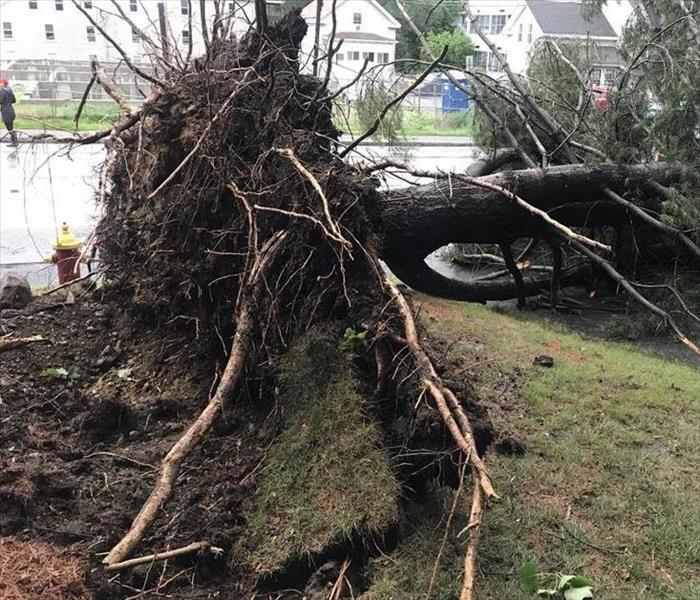 Trees who had a dry summer and suddenly become saturated have nothing to hold them in place
Trees who had a dry summer and suddenly become saturated have nothing to hold them in place
In New England we tend to think of storms being something that we need to worry about during our harsh winters. The storms that swept through Upton, Douglas and other western MA we are reminded we are not 100 % safe from the raging storms of the summer.
There are some key things that you can do to protect your home that will last through out the year.
Insurance Coverage
If you are the homeowner or a renter. it is important to start with your insurance coverage. Renters you need to have renters coverage because a home owner is not responsible for your stuff. Home owners make sure you have the right coverage for your property based on the area. This will be the catalyst for what will be covered and what will not be covered. For example, if you are in an area prone to flood but not an official flood zone it may make sense to get flood coverage for example and want to reach out to your agent and review your policy. Coverage options for the structure and contents is also two different things. That too may be something worth looking into. If you have any valuables that would be over and above a specific value such as jewelry check your policy. They have the limits on these types of items unless there is a stipulation otherwise. Having proper documentation along with proper coverage is essential for getting you back to normal as fast as possible.
Air Conditioners
Not that many of us needed to be told this but according to the National Weather Service, there is a 50 percent to 60 percent chance New England could experience higher-than-normal temperatures this summer. A lot of us have bought air conditioners that have never used them before. Maybe even added one to another part of the house. Check which outlets are connected as older wiring that is found throughout New England may have more units connected than you think. Having more than one large draining device can cause fires.
Check your Gutters
The run off water from your roof has to be directed away from your home. If it is safe to do so check your gutters or hire a professional to keep them clean and free from debris. There are covers that can be put over the top to aid in the long term. Again while you are out walking around check out your roof look for any warped or have any holes. Use a garden hose and empty water to the gutter system to see if you have any leaks in the seams or corners of your gutters. Make sure you check all of the elbows and down spouts for any large items or accumulation of debris. These clogs can cause the water to back up into your home. Using extenders on the bottom of the down spouts to direct the water away you’re your home and route it safely to a place where it will not collect.
Look at those trees
Are any branches touching the house? Does it look like the trees have leaned more towards your home than they were before. Trees can twist in the wind look up where large branches diverge from the stem. Inspect them from the ground and if you are questioning them at all call a specialist and put the wheels in motion. Due diligence is an imperative part of being a home owner.
Use generators safely
Here in New England we should be familiar with the use of generators. Yet we feel the need to remind those using them for a power outage in the summer is no different than using them in the winter. They need to out in the open. Away from the house out of garages. Do not put them on porches or near any open vents, doors or windows. It is also important to keep the fuel that you use to power it away from it unless it is off and being refueled. Depending on how it is fueled or its type will determine if it needs to be professionally installed and grounded or just plugged in. Be in the know before you need it so it is ready when you do.
Protect against Lightening
Did you know that you can get a surge protector (yes like the ones you have all your electronics plugged into) for your house. It is a whole home surge protector. It is installed by an electrician directly to your electrical panel. Each outlet can have its own surge protector those are the strips as well depending on what the home size is and what your goals and budget are.
Developing a plan now for the storms and unsettled season that we seem to be having is going to be pivotal to how well you get through any difficulties that arise. Preparedness is something we strive to achieve and help our clients achieve as well.
Roofs, Gutters, Snow and Rain do not mix......
1/11/2018 (Permalink)
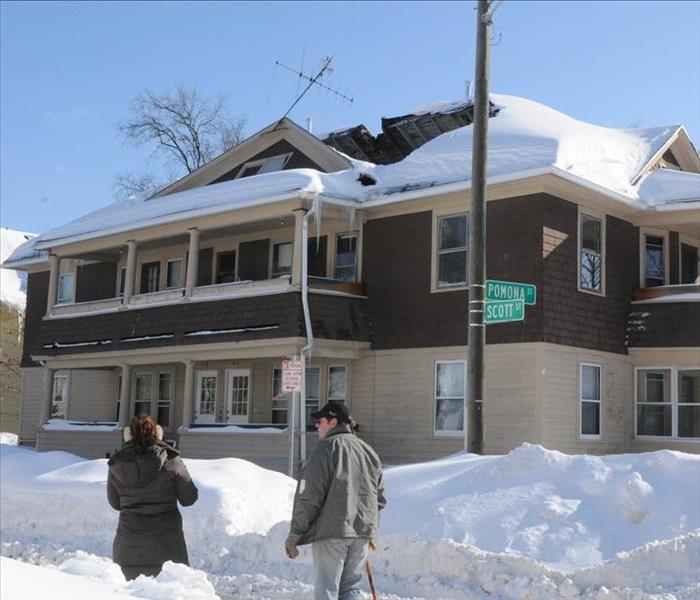 Clearing the snow off the roof and shoveling out the down spouts to your gutters and sewer drains is going to help with all the rain coming to Boston
Clearing the snow off the roof and shoveling out the down spouts to your gutters and sewer drains is going to help with all the rain coming to Boston
Having a hard time shoveling/Walking/ driving with all the ice and snow in and around Boston???? Yes we know you are we see the posts..
It is heavy.. Hard to move. .Frozen solid.. Sidewalks not shoveled///
OK so it is warming we are all looking forward to it... We are in the clear.. Its going to rain and be almost 50 right..... Ummmm No not even close..GET THOSE ROOFS SHOVELED OFF BEFORE IT RAINS and clean out those down spouts so the water has somewhere to go. This is very important because behind this rain will be another blast of cold air which means more freezing. Even measurable icing event behind the rain.
Did you know.
Total accumulated weight: 2 feet of old snow and 2 feet of new snow could weigh as much as 60 lb per square foot of roof space, which is beyond the typical snow load capacity of most roofs. Ice: 1 inch of ice equals 1 foot of fresh snow.
Do you have icicles hanging from your roof?
Do you have snow on your roof?
Do you have gutters?
Are the downspouts blocked by snow?
If you answered yes to any one of these questions you have a major problem on your hands.
Ice causes melting snow to stop up and back up onto your roof and possibly into your home. If not it will stay and create more ice. If it gets under a shingle , breaks your gutter off or even cracks a corner of your home you will have a major water problem in your home most likely between the walls. Icicles also mean heavier water on your roof.
If you still have measurable snow with the temperatures warming up you will most likely see some rapid melting provided you have a good drainage system with no ice. ( but hey we have only had -25 wind chills I am sure you don't have ice hahah) You will be fine.
We have a major rain event set for Friday.. with excess of 2.5 inches of rain on the way. Couple that with the snow already on roofs with little or any place to go. You are at risk for a roof collapse
Got Gutters?????
We talked about roof shoveling and it’s importance. Did you get it done? Hope so because now you have more work to do. Snow on roofs..sidewalks and streets are frozen and making a mess of walking and getting around. We know we have seen all the issues online...
We all have to look out for one another as well as ourselves from time to time. Relying on the city, a business or a landlord to do something does not always work law or otherwise.. As we have seen. Let’s all help out this was a bad storm with another on the way.
Find your gutters ... the down spouts are buried by all the snow that we got or got put out of the way. GUESS WHAT....Its in the way.
We are getting 2-3 inches of rain it needs a place to go.
Storm drains are blocked by snow..
Gutters are totally covered.
Sidewalks and streets have solid bricks of snow encased in ice.
Open up a drain If it is in front of your house
Shovel out the down spouts ALL of them
If you don’t that water is going to flood into homes
If you do not have flood insurance this will not be a covered event. A little bit of shoveling is worth it trust me. Even if you do it is very limited so just get it done. Landlords are tapped out. City’s are over extended. Complaining will not stop the water from coming Friday let’s just get this done.
Nor'Easter
1/2/2018 (Permalink)
 Boston looks picturesque at this height during this time of the year. However the bitter cold sets in and a Nor'Easter this view changes quickly
Boston looks picturesque at this height during this time of the year. However the bitter cold sets in and a Nor'Easter this view changes quickly
Did you know that MA has a website that can provide you with emergency information and assistance on how to find help. I know right who knew?
http://mass211.org/
From here you can get a lot of information fast and accurate. Should you need help during this intense record breaking winter season here in New England.
Record breaking cold rounded out our 2017 year bring it all into the start of 2018. Creating havoc. Our aging water systems pipes cannot handle the frigid temperatures and have had more water main breaks than we care to talk about. There have been gas line fires, house fires started from people trying to keep warm and improperly using space heaters. There have been some unintelligent uses of blow torches, as well as pipes bursting. We know there are a lot of ice dams on peoples roofs we can see them, but no one has called us for damage yet because they are not melting very fast due to the cold but they will.
Being prepared and knowing what the forecasts are saying is your only way to stay ahead of everything this season. There are numerous ways to stay informed and up to date. Below is a link for choosing the right way for you to receive your information. There are even apps that you can download to your phone.
https://www.weather.gov/subscribe
Did you know that preparing for a Nor’Easter is almost the same as preparing for a hurricane. Yes it can be that serious. Having a weather app on your phone to listen for updates is the first step to being in the know. Ensuring your car has plenty of gas so that if you lose heat or power you can at least be warm until you make other arrangements. . Making sure your phone is charged before you lose power is key, and having a car charger will help keep you in the loop while you search out your options.
Know where the warming stations in your town are and being prepared to leave with your family to go to them if necessary. Many town buildings like libraries have opened their doors to those who need it . There are a number of local churches and shelters that have extended capacity to make sure everyone that needs it will have a place to go. So do your research on that now.
Alternative and additional heat sources. Yes we know that it is cold and the house may be drafty so what do you do. Crank up a wood stove or fire place if you have it. Great but please be safe, clean and empty the ashes into fireproof tins and outside on a non flammable surface (NOT YOUR PORCH). So you have a space heater, wonderful, are you following the 3ft rule? Not sure what that is keep everything 3ft away yes everything clothes, furniture, curtains, kids, pets, rugs everything. Oh and for the sake of good sense only directly plug them into wall units.
Food preparedness: With the cold of the winter we have a bit of a reprieve than what we do in the summer. If you are out for more than 4 hours get your refrigerator cleaned out and put it all outside on the porch in containers this will ensure you do not lose any of that food. The freezer would be a good idea to but if you get the power on before the 8 hour mark that stuff should be ok. Also make sure you have some foods that are non-perishable and that you have extra food on hand for your pets. It could be a while until you get to a store. Keep an eye on things but remember animals are looking for food this time of the year so make sure the food is in a container and covered.
So you have food taken care of, you have found places to go if necessary, you are getting ready to leave your home for what could be a few days depending on when you get your heat back on. You need to get your home ready. Turn every faucet in the house on and let it run while you are going to be gone. Open all of your cabinets and doors this will let the air circulate and help to try and keep the pipes from freezing.( Hopefully)
Is your Car prepared? There are a few things you should always keep in your car, Shovel, cat litter or sand, extra chargers, blankets as well. Flashlights, knife, jumper cables road maps (yes the paper ones), an extra set of clothes and some drinking water and food. These are just the basic suggestions depending on how many people, or animals you are going to be with will determine how much you actually need.
Being prepared will help you survive and stay safe during emergency situations. Knowing where to go to get and getting there safely may just save your life. Be in the know and be prepared.
Watch/Warning/Advisory .. What do you know??
12/28/2017 (Permalink)
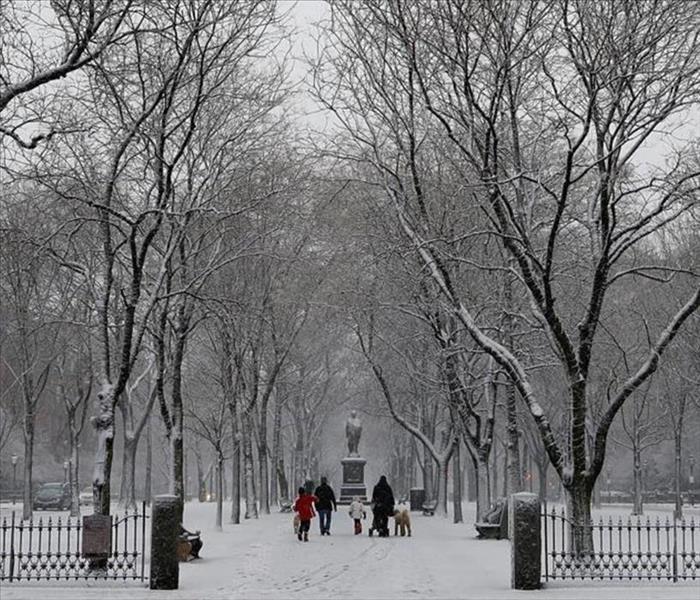 Winters in Boston can get pretty intense if you are not prepared you could be in for some trouble. Know the warnings and be ready
Winters in Boston can get pretty intense if you are not prepared you could be in for some trouble. Know the warnings and be ready
WE are in the thick of winter here in New England. With all the weather we have already had we thought it would be a good idea to keep you up to date with all the watches, warnings, and advisories that can be issued. They can be confusing and if you do not know which one is worse you could be in some trouble.
Hazardous Weather Outlook
The Hazardous Weather Outlook will describe potential hazardous weather and hydrologic information of concern in Days 1 through 7.
The outlook contains two segments: One segment for the marine zones and adjacent land-based (i.e., coastal) zones and the other segment for the rest of the land-based zones. Each segment of the HWO will contain 3 sections: short term through Day 1, long term for Days 2-7, and spotter information.
Winter Storm Watch
A Winter Storm Watch is issued when there is the potential for significant and hazardous winter weather within 48 hours. It does not mean that significant and hazardous winter weather will occur...it only means it is possible.
Significant and hazardous winter weather is defined as a combination of: 1) 5 inches or more of snow/sleet within a 12-hour period or 7 inches or more of snow/sleet within a 24-hour period AND/OR 2) Enough ice accumulation to cause damage to trees or powerlines. AND/OR 3) a life threatening or damaging combination of snow and/or ice accumulation with wind.
The snow/sleet criteria for a Winter Storm Watch for the five westernmost counties (Allegany, Mineral, Grant, Pendleton, and Highland) is higher (6 inches or more within a 12-hour period; 8 inches or more within a 24-hour period).
Blizzard Warning
A Blizzard Warning means that the following conditions are occurring or expected within the next 12 to 18 hours. 1) Snow and/or blowing snow reducing visibility to 1/4 mile or less for 3 hours or longer AND 2) Sustained winds of 35 mph or greater or frequent gusts to 35 mph or greater. There is no temperature requirement that must be met to achieve blizzard conditions.
Winter Storm Warning
A Winter Storm Warning is issued when a significant combination of hazardous winter weather is occurring or imminent.
Significant and hazardous winter weather is defined as a combination of: 1) 5 inches or more of snow/sleet within a 12-hour period or 7 inches or more of snow/sleet within a 24-hour period AND/OR 2) Enough ice accumulation to cause damage to trees or powerlines. AND/OR 3) a life threatening or damaging combination of snow and/or ice accumulation with wind.
The snow/sleet criteria for a Winter Storm Warning for the five westernmost counties (Allegany, Mineral, Grant, Pendleton, and Highland) is higher (6 inches or more within a 12-hour period; 8 inches or more within a 24-hour period).
Ice Storm Warning
¼ inch or more of ice accumulation.
Winter Weather Advisory
A Winter Weather Advisory will be issued for any amount of freezing rain, or when 2 to 4 inches of snow (alone or in combination with sleet and freezing rain), is expected to cause a significant inconvenience, but not serious enough to warrant a warning.
If the event is expected to impact the Baltimore/Washington metro areas during rush hours (4-9 am or 2-7 pm on weekdays) forecasted snow totals of one inch will necessitate the issuance of a winter weather advisory. The snow/sleet criteria for a Winter Weather Advisory for the five westernmost counties (Allegany, Mineral, Grant, Pendleton, and Highland) is higher (3-5 inches).
Freeze Watch
A Freeze Watch is issued when there is a potential for significant, widespread freezing temperatures within the next 24-36 hours.
A Freeze Watch is issued in the autumn until the end of the growing season (marked by the occurrence of first widespread freeze). The normal end of the growing season is mid to late October west of the Blue Ridge and early November east of the Blue Ridge. However, during anomalously warm autumns, the growing season may be extended past the normal end of the growing season.
A Freeze Watch is issued in the spring at the start of the growing season (when it is late enough to cause damage to new plants and crops).
Freeze Warning
A Freeze Warning is issued when significant, widespread freezing temperatures are expected.
A Freeze Warning is issued in the autumn until the end of the growing season (marked by the occurrence of first widespread freeze). The normal end of the growing season is mid to late October west of the Blue Ridge and early November east of the Blue Ridge. However, during anomalously warm autumns, the growing season may be extended past the normal end of the growing season.
A Freeze Warning is issued in the spring at the start of the growing season (when it is late enough to cause damage to new plants and crops).
Frost Advisory
A Frost Advisory is issued when the minimum temperature is forecast to be 33 to 36 degrees on clear and calm nights during the growing season.
A Frost Advisory is issued in the autumn until the end of the growing season (marked by the occurrence of first widespread freeze). The normal end of the growing season is mid to late October west of the Blue Ridge and early November east of the Blue Ridge. However, during anomalously warm autumns, the growing season may be extended past the normal end of the growing season.
A Frost Advisory is issued in the spring at the start of the growing season (when it is late enough to cause damage to new plants and crops).
Wind Chill Advisory
A Wind Chill Advisory is issued when wind chills of -5F to -19F are expected east of the Blue Ridge Mountains, and when wind chills of -10 to -24F are expected along and west of the Blue Ridge Mountains and in Frederick and Carroll Counties in Maryland.
Wind Chill Warning
A Wind Chill Warning is issued when wind chills of -20F or lower are expected east of the Blue Ridge Mountains, and when wind chills of -25F or lower are expected along and west of the Blue Ridge Mountains and in Frederick and Carroll Counties in Maryland.
Courtesy of our friends over at the National weather service. You can visit their website at
www.weather.gov for more information and to stay up to date on the latest weather for your area.
Space Heaters and Smoking Material Fire Safety..
11/27/2017 (Permalink)
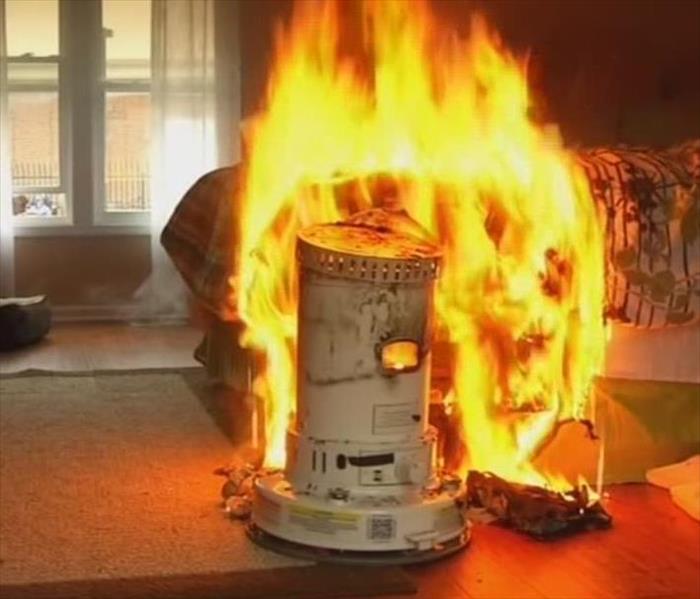 Space heaters even infrared ones need to be attended to. Just like Smoking materials .. Please stay alert to remain safe...
Space heaters even infrared ones need to be attended to. Just like Smoking materials .. Please stay alert to remain safe...
With the first few major fires of the season having tragic results in and around Boston, we feel the need to write this article.
Two of the deadly fires were a result of improperly disposed of smoking materials while the other was a space heater. We have written article in depth about these topics but really need to reiterate the fact that these are quick moving and fast spreading. Many of which occur at night while these materials are unattended.
Let us start with the smoking materials.
This is the number one cause of death in home fires.
Many industries have made efforts to aid in the reduction of death and injury from these kinds of fires. The mattress and furniture industry have been required to use flame resistant materials in manufacturing. New fire safe cigarettes have been developed and are required to aid in reduction of fires starting in the first place. These measures cannot and should not replace the smokers properly disposing of lit or smoldering products. We need to change our mindset and not rely on companies to make things safer for our friends and families.
We all know the dangers that smoking has on our overall health yet many still continue to smoke. All too often while driving down the road someone will toss a lit cigarette they are done without the window. While seemingly innocent when it comes in contact with the dry under brush and fallen leaves this can spark a major problems for so many. This is not an ideal way to dispose of a lit object period.
With the holiday season upon us many of us will partake in joyous occasions which often includes alcohol. While we support good time these drinks do impede judgment, make you sleepy, and reduce awareness. Coupled with many do smoke socially this can be a recipe for a disaster. When you have a smoke right before bed, but you are tired all too often many will fall asleep with the cigarette in their hand or even more scary in their mouth. The images of someone sleeping with a cigarette hanging out of their mouth is often a funny thing yet is a very dangerous event. As they sleep and muscles relax those funny images become deadly. Cigarettes falling out of the mouth or hand unknowingly onto the floor. Allowed to go unchecked, smoldering on a dry article of clothing, carpet or bed can quickly get out of hand. Deaths in these types of fires are often NOT the individual that was smoking the cigarette.
Please stay aware and if you see something say or do something you may just save a life. Properly dispose of the smoking materials even if they are not yours.
Here are some tips from our friends at National Fire Protection Association
- If you smoke, smoke outside.
- Whenever you smoke, use deep, wide, sturdy ashtrays. Ashtrays should be set on something sturdy and hard to ignite, like an end table.
- Before you throw out butts and ashes, make sure they are out. Dowsing in water or sand is the best way to do that.
- Check under furniture cushions and in other places people smoke for cigarette butts that may have fallen out of sight.
- Smoking should not be allowed in a home where medical oxygen is used. ( Someone in Maine just had a home explosion due to this) .. Oxygen is flammable ….Very FLAMMABLE… Be smart and safe…. Others will be affected.
- To prevent a deadly cigarette fire, you have to be alert. You won’t be if you are sleepy, have been drinking, or have taken medicine or other drugs. These are the second leading cause of home fires and injuries and the third cause of death. As Temperatures dip and the cold settles into the homes we all seek to stay warm, many of us turn to space heaters. While this is a great way to provide an infusion of concentrated heat into the areas of the home we are in or live in they can be very dangerous if not used properly.
- The second is the space heater.
- Keep them at least 3ft away from any and all flammable materials.
- This includes curtains, furniture, rugs, bedding, paper, Christmas trees, and holiday decorations.
- Turn them off when you are not home or cannot monitor properly i.e. when you are sleeping. Warm up the room and get an extra blanket to hold in the heat but turn that heater off when you go to sleep
- When buying a heater, look for one that has been tested and labeled by a nationally recognized testing company, such as Underwriter’s Laboratories Inc. (UL).
- Place the heater on a level surface away from areas where someone might bump into it and knock it over.
- Avoid using extension cords. If you must use an extension cord, make sure it is a heavy duty cord marked with a power rating at least as high as that on the label of the heater itself.
- Supervise children and pets when a space heater is in use.
- Keep electric heaters away from water. Never use them near a sink or in the bathroom.
- The sale and use of unvented kerosene heaters is illegal in Massachusetts.
- We hope this will make you think about these two causes of fires and use even just one tip to save a life maybe even your own. Share this tip with anyone you know that smokes or uses space heaters. Have a safe and happy holiday season with your friends and family. Let us work together to create lasting memories we can all be happy about. Not the memories that bring sadness over the holiday season. Being with our loved ones is precious and every moment we can add to it should be treasured. DO NOT cut those memories short because of a careless mistake. Check back with us often for this and other important safety tips and tricks.
Holiday Fire Statistics
11/1/2017 (Permalink)
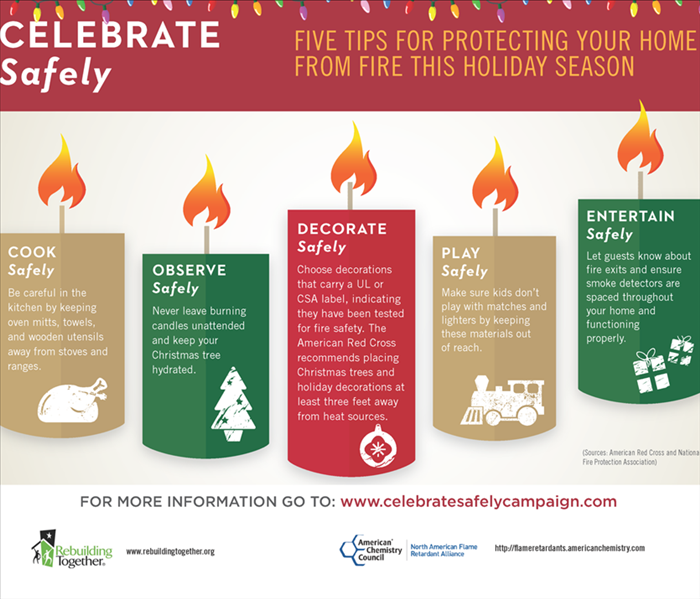 Having the holiday season fast approaching the need to remind everyone of home fire safety.. Please make this holiday season SAFE AND FUN..
Having the holiday season fast approaching the need to remind everyone of home fire safety.. Please make this holiday season SAFE AND FUN..
Home Fire statistics are an important way to stay safe this holiday season. Knowing where most problems stem from can lead to more attention being paid to those areas or activities .We have borrowed this information from NFPA ( National Fire Protection Association). Hoping to keep you safe and secure this Holiday season
Christmas trees
- Between 2010-2014, U.S. fire departments responded to an average of 210 home fires that started with Christmas trees per year. These fires caused an average of 6 deaths, 16 injuries, and $16.2 million in direct property damage annually.
- On average, one of every 34 reported home fires that began with a Christmas tree resulted in a death, compared to an average of one death per 142 total reported home fires.
- Some type of electrical distribution or lighting equipment was involved in one-third (35%) of home Christmas tree fires.
- Twenty-three percent of Christmas tree fires were intentional.
- Two of every five (38%) home Christmas tree fires started in the living room, family room, or den.Holiday decorations
- A live Christmas tree burn conducted by the U.S. Consumer Product Safety Commission (CPSC) shows just how quickly a dried out Christmas tree fire burns, with flashover occurring in less than one minute, as compared to a well-watered tree, which burns at a much slower rate.
- U.S. fire departments responded to an estimated average of 860 home structure fires per year that began with decorations, excluding Christmas trees, in 2009-2013. These fires caused an annual average of one civilian fire death, 41 civilian fire injuries and $13.4 million in direct property damage.
- Ten percent of decoration fires were intentional.
- The decoration was too close to a heat source such as a candle or equipment in nearly half (45%) of the fires.
- One-fifth (20%) of the decoration fires started in the kitchen. One out of six (17%) started in the living room, family room or den.
- One-fifth (20%) of the home decoration fires occurred in December.
- Candles
- Candles started 38% of home decoration structure fires.
- Half (51%) of the December home decoration fires were started by candles, compared to one-third (35%) in January to November.
- The top three days for home candle fires were Christmas, New Year’s Day, and Christmas Eve.Holiday cooking
- Source: NFPA's "Home Structure Fires Involving Decorations" report
- Thanksgiving is the peak day for home cooking fires, followed by Christmas Day and Christmas Eve.
- Cooking equipment was involved in 18% of home decoration fires. This can happen when a decoration is left on or too close to a stove or other cooking equipment.Fireworks
- Source: NFPA's "Home Fires Involving Cooking Equipment" report
Water Damage Emergency Process
10/23/2017 (Permalink)
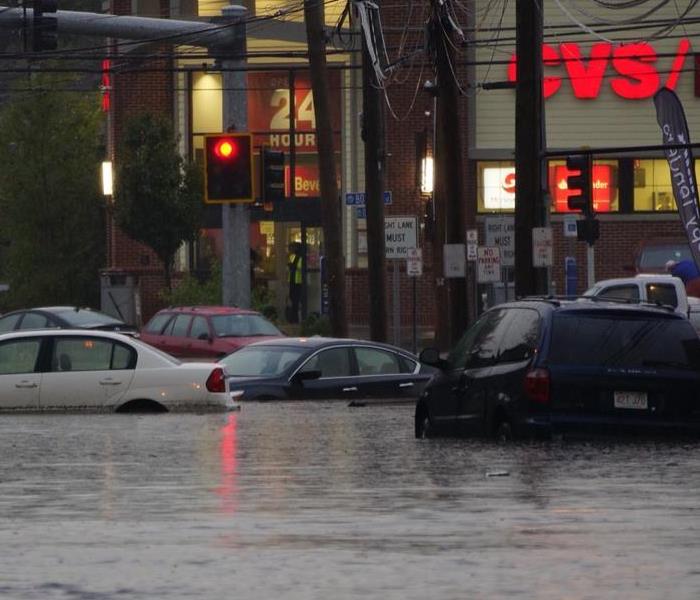 Flooding can occur with out warning despite the advanced weather technology. Having a plan and knowing how to react makes all the difference.
Flooding can occur with out warning despite the advanced weather technology. Having a plan and knowing how to react makes all the difference.
So you got flooded.. Now what do you do
Everyone always wants to get back to normal as soon as possible, with as little cost and intrusion into their life as possible. Guess what??? That expectation is the worst way to approach this kind of water loss. While it sounds great what is the big deal. Let us explore the things that can happen when you actually move too quickly.
Having anything submerged in water means it was able to saturate. Saturated clothing can be wrung out but is still wet at the fiber level. Guess what wood does the same thing. Unlike clothing wood structures cannot be thrown into a dryer. That is right inside those beams are still wet. Behind that wall is soaked, oh your home is insulated yeah that’s wet too. That beautiful wood floor is sitting on a subfloor that space is wet too. However will you get it dry. Well if you do not have high powered fans and commercial grade dehumidifiers it can take months yes months to air dry.
Aside from the fact that everything is wet, said you were flooded right? Guess what dispite what you think flood water is not clean. At all!!!! It is flooded because the water did not have a normal place to drain. Where does most city water drain into??? That is right the sewer system.. Sooo if you are flooded because the sewer system is not working that is right folks you have been flooded with sewer water.
CHECK FIRST
- Is mold already growing
- Is electricity on & active ( Never walk through water to power off electricity)
- Check for gas leaks
- Is the structure safe
- Wear protective eye glasses, Shoes and gloves and respirator if you suspect mold.
- Do not mix chemicals the vapors can be deadly ( Especially Bleach and Vinegar)
Step by Step guide:
- Get to safety: If the rain has stopped flooding is still possible as the water drains from some areas and into others. Makes sure you stay safe. Once it is safe to do so start assessing the personal damage you have incurred.
- Insurance: Most people have home owners insurance. Guess what they do not cover flood insurance so start there. If you were flooded and do not have flood insurance you are on your own. Even if you do it is your responsibility to keep the home safe and reduce damages as much as you can. Which means you cannot wait to hear from the insurance company. Should you get mold or rot from waiting most likely it will not be covered due to the fact that it is considered secondary damage. Meaning it would not occur if you had started to clean up immediately.
The clean up: What can you do before the adjuster arrived from the insurance company.
- Take pictures of everything, before you or anyone do any work what so ever.
- Clean up areas of the house so that wall, and floor damage can be easily seen.
- There can be hidden damage, such as behind the walls so it will be reassessed as work begins.
- Reach out to government agencies for potential assistance for aid. ( Please note that a federal disaster must be declared for you to apply for this type of assistance.
- Hire an electrician to come in and assess the safety of electrical system of the home. This will tell you what is safe and not safe to turn on ( Never turn on equipment that was submerged any salvageable items could spark and become a total loss)
- Check with the local town to see if the water is safe to use or if it was adversely affected by the flood waters.
- Go through your food and make sure you throw out anything not in a metal can. Make sure you get rid of the labels and get new ones. To identify the food later. The cans must be washed if you are going to keep them . o.
- All your silverware and utensils have to be cleaned and sorted. Wood, plastic or anything no metal or ceramic needs to go
- Cut and remove walls ( Even if they do not look damaged)
- If you see a water line ..Cut the wall at a minimum of 2 feet above that line.
- Remove insulation and yes throw it away.
- Take off the base boards , they may be able to be dried and saved but at least removing them assured they are not holding in moisture.
- It is recommended anything that cannot be dry cleaned should be thrown away. This includes but is not limited to furniture, clothing, and blankets.
- Carpets must be pulled up and while the carpet may be able to be cleaned and dried the pad cannot so throw that way.. Do not re-attach the carpet before the floor it sits on is fully dry ( Yes we have to say that again) To avoid any issues make sure that you do this within 48hrs after the water goes down so that it does not have a chance to grow anything it should not be growing ( which is anything)
- Flooring: Be it if you have wood, vinyl, laminate or tile if it was submerged in flood water it really has to go.
- If you are not sure if the tile or its adhesive is asbestos get it tested.
- If it is a painted surface and you are not sure about the presence of Lead that too should be tested.
- This step while will be a bit of a delay keeps you, your family and the workers safe.
- Subfloors: Guess what your floors sit on a floor and regardless of what sort of main floor you have most of the time the subfloor is plywood and will be affected by the water. The top floor must be removed so that this level of floor can dry fully. Make sure you do not have any buckling before you put a new floor on top once it is dry. If so you may need to replace that.
- Set up fans and Dehumidifiers to created a vortex to encourage drying. Proper fan positioning and temperature regulation will speed up the drying process.
- ****BLEACH**** DOES NOT KILL MOLD… PERIOD….
- If you see mold… There is a very specific process that must be followed. The most important step is to NOT spread the spores all over the house. So DO NOT VACCUM them unless you have a hepa-vaccum.
Contact a professional and keep in mind this is not a two or three day process. Have the right expectations going in to this. It will ease your mind and reduce the amount of stress that you have. Expecting something to be done to fast can result in long term damage that will cost more. It will also put undue stress on all involved. Take a step back and know that it could be a month or even more depending on how extensive the damage is.
Holiday season is fast approaching..
10/19/2017 (Permalink)
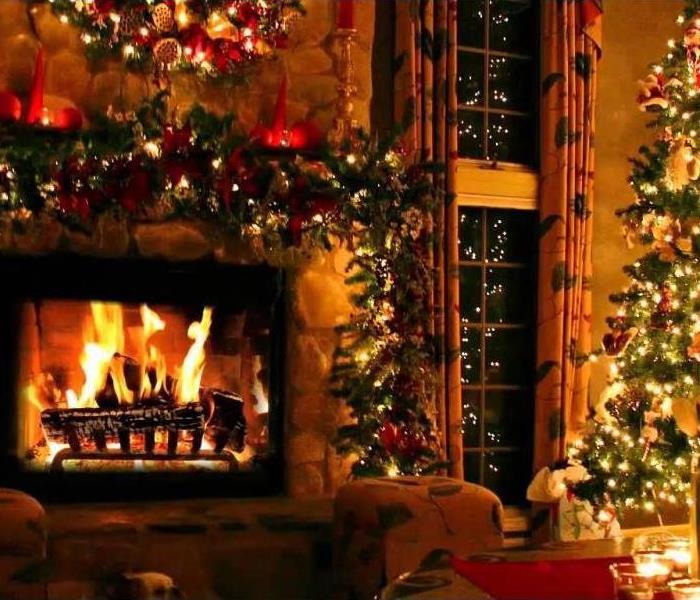 Home fires are a big threat to Americans. Knowing what causes them and how to prevent them can be all the difference.
Home fires are a big threat to Americans. Knowing what causes them and how to prevent them can be all the difference.
With holiday season just around the corner. Tips to ensure you all stay safe. We want the holidays to be full of cheer, fun, and wonderful memories.
Holiday home fires can put a damper on that. Here some facts on what to keep an eye out for.
Fast Facts
• Nearly 47,000 fires occur during the winter
holidays claiming more than 500 lives,
causing more than 2,200 injuries, and costing
$554 million in property damage.**
• On average, one of every 22 home fires
started by Christmas trees result in death.***
• Candle fires are four times as likely to occur
during the winter holidays.**
• During the winter holiday season, an average
of 40 home fires per day are caused by
children playing.**
• The number of home fires the American Red
Cross has responded to has risen 10% since
2000.*
• Having a working smoke alarm reduces one’s
chances of dying in a fire by nearly half.**
Preparedness Tips
Place Christmas trees, candles, and other holiday decorations at least three feet away from heat
sources like fireplaces, portable heaters, radiators, heat vents and candles.
Purchase flame retardant metallic or artificial trees. If you purchase a real tree, make sure that it
has fresh, green needles that aren’t easily broken. Keep live trees as moist as possible by giving
them plenty of water.
Make sure that light strings and other holiday decorations are in good condition. Do not use
anything with frayed electrical cords and always follow the manufacturer’s instructions.
Always unplug tree and holiday lights before leaving home or going to bed.
Never use lit candles to decorate a tree. Always extinguish candles before leaving the room or
going to bed.
Use only sturdy tree stands designed not to tip over. Keep curious pets and children away from
Christmas trees.
Keep anything that can catch on fire—pot holders, oven mitts, wooden utensils, paper or plastic
bags, food packaging, and towels or curtains—away from your stove top.
Designate one person to walk around your home to make sure that all candles and smoking
materials are properly extinguished after guests leave.
Smoke alarms save lives. Install a smoke alarm near your kitchen, on each level of your home,
near sleeping areas, and inside and outside bedrooms if you sleep with doors closed. Use the
test button to check it each month. Replace all batteries at least once a year.
Visit www.redcross.org/homefires for more information on how to keep your home fire safe during
the holidays.
Sources: American Red Cross,* U.S. Fire Administration,** and the National Fire Protection Association.***
Water on the rise in New England
9/14/2017 (Permalink)
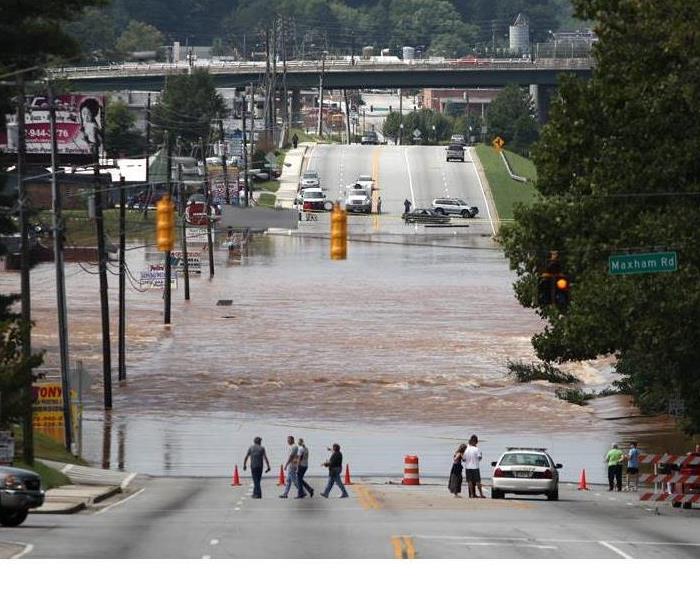 Flooding is going to become an increasing problem in and around the Boston area over the next few years. Being prepared is going to be pivotal.
Flooding is going to become an increasing problem in and around the Boston area over the next few years. Being prepared is going to be pivotal.
Massachusetts
Storms and their frequency are on the rise. In addition so too is the intensity of each event. In the United states there has been a 74% increase in the top tier precipitation events since 1958. Flood events have risen along with this severely altering the environment, wildlife, and financial obligations of cities, towns, and individual residents. With flooding of sewer systems there comes an increase of pollution to fresh drinking water access. Being prepared for these types of events is pivotal.
The areas impacted the most from these rain events has actually been the northern costal and mountainous regions of the country. Areas in Eastern Massachusetts have seen an uptick in rain event days that have more than 2 inches of rain per event. The average rainfall has also seen a 1 to 2 inch increase since the 1970’s. The major Connecticut river basin alone has seen double the heavy rain events over the last 60 years. Most of this rain has occurred from May to September.
This shift has also changed the frequency of coastal storms. The rising sea levels are changing the shape of the coast and what is actually considered the coast. We must all be prepared. These storms are what are known as hurricanes and Nor’Easters. Those alone are not the only threats. Increased intensity of Thunderstorms, tornado frequency and even damaging hail events are on the rise. The structural damage that is caused to homes, cars and the natural environment around you can be catastrophic.
Key findings on a recent survey stated that sea level rising by 2030 is estimated to rise by another 8 inches. These higher water levels also mean stronger waves as well as farther reaching damage. While there is protection from areas like Winthrop, Hull and Harbor Islands this is not a guarantee of safety. These sea level rises coupled with the increased intensity of storm level events the sewer systems can be quickly overloaded. River flooding and their overflow channels will be overwhelmed and run off into streets, yards, homes and fields.
What scientists call the 100 Year flood is now being seen every 60 years or so. By the year 2050 these flood level events will be every 10-20 years. In Boston alone these 100 year flooding events are projected to recur every 1-2 years. For many subsets of Boston such as East Boston which are built up and used to be the harbor flooding is a serious concern. Costal Massachusetts is at high risk due to the rising rain fall and sea levels. We are already seeing an uptick in claims and severity of the claims. If you are not currently in a sanctioned flood zone yet, get flood insurance now. This will grandfather you into the policy. Should your area reclassified you will not have to pay new premiums on rates for the new requirements.
Please be aware and be prepared for these events. Check out our preparedness plans for what to have ready and on hand now so you can be safe later.
So you sent the remediation company home early
7/27/2017 (Permalink)
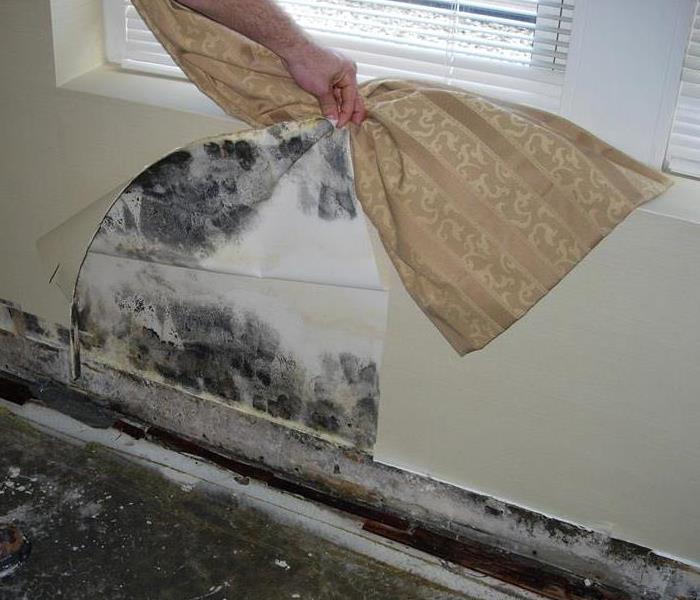 Look closely.. the wallpaper looks as though it is in good shape. As it peeled away from the wall it revealed the scope of the mold problem.
Look closely.. the wallpaper looks as though it is in good shape. As it peeled away from the wall it revealed the scope of the mold problem.
A home owner or business owner wants to get back to normal as soon as possible. Working to make that happen is our goal. That being said water damage or fire damage is never a pretty thing. The right expectations need to be understood. Beyond that what needs to be understood is the reason for the time frame and process.
Let me explain. All too often especially with water damage issues we are asked to cease and desist. Pack up our stuff and leave before the work is done. There are even times that we recommend opening a wall, or pulling up the floor. Home owners and business owners will refuse to let us to do this sort of work. Why would they do that you ask. There are a number of reasons but the main one is that they do not want the inconvenience of more intrusion into their home. This is always a bad idea.
Restoration companies have extensive training and certifications that most do not. They also have years of experience working with insurance companies and property adjusters. This leads to a great understanding of the scope of work that is needed to properly mitigate your building. This ensures what they call secondary damage is not an option.
First let us get into what secondary damage actually is. Secondary damage is something that would not have happened even if the first occurred. Let me explain. If you do have a pipe break, you call and get the plumber out and stop the water. Moisture damage is what happens when you do not mitigate the water that intruded into your home fast enough.
Some key examples of what is considered secondary damage is when your wood floors start to buckle. This is not from the water intrusion it is from the wood sitting in the water that is underneath . The wood warps. This warping forces the finish to crack and the floors are not salvage able.
Ok so you don’t have wood floors. Vinyl is not much better, look at that edging popping up. That is damage from the water getting under the floor and damaging the glue.
Cracks in sheet rock and sagging ceiling are a result of moisture continuing to collect if they did not have an outlet to release the water.
Mold colonization. This is probably the most problematic. The challenge here is many times it will be somewhere you cannot see until it is a real problem. Similar to an iceberg you only see a fraction what is there. Lurking behind a wall under a floor or even where you see nothing at all such as in a duct system.
Let us get back to the reason for this post. We have clients that ask us to leave early and no explanation in the world is going to change their minds. Business owners are looking at the short term issue they have to be closed. Closing means so money is coming in and many do not have the proper insurance to cover loss of business. Additionally they tend to have very high deductibles or inadequate coverage. Coupled with lack of income there are a lot of bad decision made. They only want the visible water dried out. They will not allow demolition to occur for it will delay the process of reopening. Another problem is that they do not want to pay for anything more than absolutely necessary.
Home owners often as us to leave early but not always for the same reasons as a business owner. The equipment that is used in the drying process is industrial. It is not like the fan you put on your night stand to lull you to sleep. These are high powered fans used to circulate the air and create a tornado like event that forces strong air movement. They are positioned in such a fashion that they are pointed at wet objects , such as a wall. This positioning is tied directly to where the dehumidifiers are located as well. This will force the air to push the moisture out of the wet materials into the air and the dehumidifier will capture the wet air and release it as drier air. This requires the area to be warm. We ask people to turn up their heat and the equipment itself gives off quite a bit. All too often the home owner will say the fans are too loud. They are too big and in the way. I have a party planned for this weekend. It is just too hot inside I cannot stand it anymore.
All of these decisions are bad ideas. We have 3 different kinds of waivers that are required. One that states you know we do not advise removal of equipment. One that advises you are declining the scope of work we are recommending. There is also a limitation on standard compliance form when we are not allowed to perform the necessary scope of the work. We have to make sure when the mold appears down the road we are not held liable and the parties in question were explained the scope of possibilities for this refusal.
We try to work with the residents of the property to the best of our ability. At the end of the day they are the ones affected and we will honor their wishes. You must know the potential ramifications for your actions and know that down the road be it 1 week, month, one year or even several years later. Mold can be a very serious problem. Kicking off a professional can be expensive. Now we agree not everyone may be doing the work up to par and that is your right to change whom it is that is doing the work. Have a plan in place to get it completed in a timely fashion. Do not kick them off totally without a solid replacement plan.
The cost associated with Mold Remediation far exceeds what a few days of inconvenience could ever be. So before you kick a remediation company off the job, think about what is going on and have a plan.
Increase in Storms and Water events in Massachusetts
7/24/2017 (Permalink)
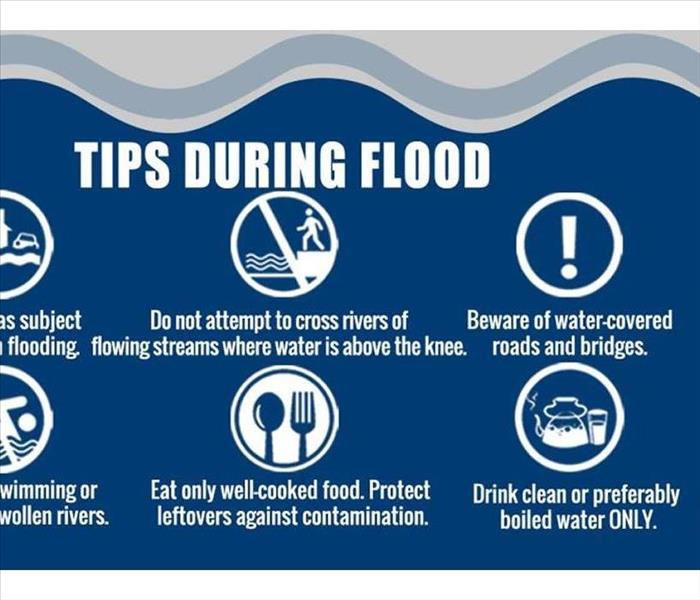 Having a plan and enacting that plan are two different things. Practice and know how to react follow the advice.
Having a plan and enacting that plan are two different things. Practice and know how to react follow the advice.
Storms and their frequency are on the rise. In addition so too is the intensity of each event. In the United states there has been a 74% increase in the top tier precipitation events since 1958. Flood events have risen along with this severely altering the environment, wildlife, and financial obligations of cities, towns, and individual residents. With flooding of sewer systems there comes an increase of pollution to fresh drinking water access. Being prepared for these types of events is pivotal.
The areas impacted the most from these rain events has actually been the northern costal and mountainous regions of the country. Areas in Eastern Massachusetts have seen an uptick in rain event days that have more than 2 inches of rain per event. The average rainfall has also seen a 1 to 2 inch increase since the 1970’s. The major Connecticut river basin alone has seen double the heavy rain events over the last 60 years. Most of this rain has occurred from May to September.
This shift has also changed the frequency of coastal storms. The rising sea levels are changing the shape of the coast and what is actually considered the coast. We must all be prepared. These storms are what are known as hurricanes and Nor’Easters. Those alone are not the only threats. Increased intensity of Thunderstorms, tornado frequency and even damaging hail events are on the rise. The structural damage that is caused to homes, cars and the natural environment around you can be catastrophic.
What scientist call the 100 Year flood is now being seen every 60 years or so. By the year 2050 these flood level events will be every 10-20 years. In Boston alone these 100 year flooding events are projected to recur every 1-2 years. For many subsets of Boston such as East Boston which are built up and used to be the harbor flooding is a serious concern. Costal Massachusetts is at high risk due to the rising rain fall and sea levels. We are already seeing an uptick in claims and severity of the claims. If you are not currently in a sanctioned flood zone yet, get flood insurance now. This will grandfather you into the policy. Should your area reclassified you will not have to pay new premiums on rates for the new requirements.
Please be aware and be prepared for these events. Check out our preparedness plans for what to have ready and on hand now so you can be safe later.
https://climateactiontool.org/content/storms-and-floods
Water Energy technology ...
7/21/2017 (Permalink)
 Water is beautiful, powerful, and can be destructive. Harnessing that power can be the difference between water damage and water energy
Water is beautiful, powerful, and can be destructive. Harnessing that power can be the difference between water damage and water energy
This link for ways to harness energy could be just the thing we need to increase renewable energy resources.
In turn through a better harness of the energy could we reduce the damage it causes when we have an influx. While these questions may be a long way off the technology is there. That is a start of new beginnings. Energy.gov shares wonderful news about technological advances so check back often.
https://energy.gov/eere/articles/5-promising-water-power-technologies
The world’s first hydroelectric power plant, located along the Fox River in Appleton, Wisconsin, started illuminating the home of plant-builder H.J. Roger and a nearby building on Sept. 30, 1882. Afterward, and for the next hundred years, hydropower plants grew in size and number. Today more than 2,000 hydropower plants generate clean, reliable energy across America.
But for water power to realize its full potential, innovative technologies are needed to meet new challenges and harness new resource types, from streams to the ocean. Below are five promising water power technologies under research now:
5 Promising Water TechnologiesWater InfographicModular hydropower
While existing hydropower is among the least expensive sources of electricity, building a new plant can be expensive. Modern technologies are needed to reduce installation and civil works costs. One potential answer is modular hydropower, which uses separate, similar components that can be constructed off-site then easily integrated into new or existing sites and scaled to greater capacities.
Modular hydropower systems for non-powered dams and other untapped sites can lower construction costs and reduce environmental impacts. For example, a 24-foot long and 16-foot high prototype dam, composed of six precast blocks, was built in Massachusetts as part of the HydroNext Initative in order to lower cost, improve performance, and promote environmental stewardship of hydropower development.
Powering non-powered dams
Today hydropower is the largest renewable energy source in the U.S. Still, tens of thousands of dams across the country don’t produce power. Adding generation equipment to these sites could add up to 12 GW of new hydropower capacity to the grid, and using existing dam infrastructure can lower construction costs and reduce permitting time—meaning hydropower is added to the grid faster. Because 49% of hydropower capacity is owned by the U.S. Government, federal dams represent a big opportunity to develop non-powered dams.
Pumped-storage hydropower
Pumped-storage hydropower (PSH) works like a big battery. It pumps water to a higher elevation, which can then be released at any time to turn turbines and meet energy demand. As the largest form of utility-scale energy storage, PSH helps stabilize America’s power grid. It can respond quickly to grid instability or power outages and balance variable generation, such as from wind and solar. The country’s 42 PSH plants help make the electric grid reliable and resilient, but Energy Department-funded research shows we can add even larger amounts of new, flexible, low-cost PSH.
Tidal energy
Tides occur worldwide, but making electricity out of them requires a 16-foot difference between low and high tides. While there are no permanent tidal power plants in the United States yet, conditions are good for tidal power generation in the Pacific Northwest and the Atlantic Northeast regions. The Energy Department has funded research to develop new ways to install, maintain, and decommission tidal power plants. Recently, the Energy Department continued funding for Verdant Power, Inc. to optimize a way to deploy and retrieve three tidal turbines together as a single system with one on-water operation without diver support.
Wave Energy
Ocean waves pack immense energy. The challenge for scientists—and a focus of the Energy Department—is developing technology that can safely, reliably, and cost-effectively convert wave energy into usable electricity. But once that’s done, the potential for wave energy to supply power to major cities and distributed applications—like naval bases, desalination plants, and subsea data centers—is high. To address this challenge, the Energy Department-funded the Wave Energy Prize, an 18-month public competition, that ended with prize winner AquaHarmonics demonstrating a five-fold increase in the energy capture potential of their MHK device—which the two-person team built in a garage.
Why is there a Mushroom inside my home
7/6/2017 (Permalink)
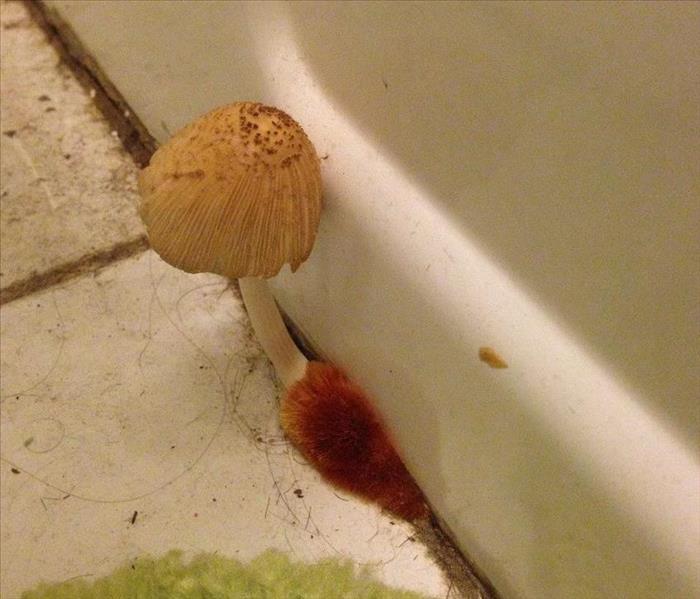 Mushrooms will grow with the right conditions. Please do not try to handle this yourself there is a bigger problem going on than just a mushroom
Mushrooms will grow with the right conditions. Please do not try to handle this yourself there is a bigger problem going on than just a mushroom
Mushrooms..
Many people like mushrooms and the vaiety and textures available are endless. That being said, from time to time we get calls that people have mushrooms are growing in their home. On a ceiling, out of a wall or floor. What is going on in the home that this is happening? We will dive into that a bit more and explain what conditions are needed for this to happen. One thing to know is that you do have an underlying problem and it is not going to be just as simple as getting rid of the mushrooms.
What is a mushroom? It is a variety of plant that grows in very specific conditions. Since it does not use chlorophyll to grow it actually does much better in darker environments. Even indirect light from a florescent lamp can do the trick. One key thing that they do need is moisture, a high humidity environment is always present. While too much water will kill them moist environments are ripe for growth. They tend to grow on decomposing materials such as trees, leaves, mulch, soil, compost wood. An ideal temperature for mushrooms is 70 degrees F but a wild mushroom with the right environment can grow in a range from 40 to 90 degrees F.
With that out of the way let us explore why that matters to you and your home. Do you have a basement, attic or crawl space? Do you have a bathroom that is used at all? Is there a toilet in your home that has water in it? You are halfway there to having the right environment for growth. Do you live in an area with humidity levels that are tracked by the local weatherman? Yikes you are getting closer. Does the interior of your home feel humid and sticky? Have you ever had a water leak that you cleaned up on your own? How is the pitch and grade of the water away from your home? Do you live in a flood zone or have had more rain than normal? Was there a flood on your street due to a pipe break or excessive rain? If you answered yes to any of these questions you could have the right environment for mushrooms in your home.
Let me first explain that if you see a mushroom in your home you have mold in the house somewhere. You also have water that is getting onto surfaces that you do not want it on. Should you see mushrooms you must immediately work on finding the water source. A slow drip pipe leak, a toilet whose seal has broken even just a little bit could be the reason. There could a number of reasons for the water intrusion. Just removing the mushroom will not alleviate the problem. Once you find the source of the water and stop it, you much assess the true damage. Follow the path from the water source to the mushroom.
Let us provide you with a real life example.
Toilet leak: Owner knew about the toilet leak: It dripped from the 2nd floor bathroom down into their dining room and into the basement. The owner initially elected to clean it up on their own. Wiping everything down and cleaning the walls and ceiling they thought were affected. The unfinished basement was nominal in their eyes and they threw some cat litter on the floor to absorb the water. Thinking all was fine they went about their lives. Days later the dining room ceiling had mushrooms growing from it. What the owners did not do was clean between the walls nor did they dry out the spaces between them. The contaminated water that was trapped between the walls provided a prime environment for the spores of the mushrooms to grow and spread out from the mold that had started to run along the wood beams. There was a great deal of work that needed to be done to open up the walls and decontaminate everything that the water had touched and spread to. Had a professional been called initially they could have opened smaller sections and reduced the damage. There is more to the story but the moral is just because you cannot see it does not mean it is not there.
There are steps you can take to reduce moisture in your home.
Keep bathrooms as dry as possible when done using it.
Wipe the inside of the shower down.
Keep all towels off the floor
Use mats at all major entrances and especially in shower and bathroom areas
Have a professional check all the pipes for leaks
Inspect the toilet for a proper seal.
Call a professional if you have a water intrusion in your home.
The most important part of seeing a mushroom in your home is knowing that you have something bigger going on. You have to accept this and know that it is not as easy as getting rid of the visible problem. Even if you call a professional it is important to trust what they are saying to you and not be solely driven by money there can be major consequences should you ignore or not properly treat a mold problem. Remember there are all sorts of tips and tricks online not all of them are accurate.
Bleach may work on the mushrooms in your home but they do not work on the mold. Where there is mushroom there is mold. Be sure you do your research and don’t try to tackle this problem on your own.
Revere Chamber of Commerce Awards Ceremony
4/25/2017 (Permalink)
 Veterans Service Awards Issued to those that have served proudly and continue to invest in the community. Thank you for all that you do
Veterans Service Awards Issued to those that have served proudly and continue to invest in the community. Thank you for all that you do
We were so proud to be part of the 4th Annual Revere Chamber of Commerce Community Awards Reception. It was a night filled with community pride and some wonderful people striving to make a difference.
Join us in congratulating the winners.
New Business Award: Aladdin’s Grill & Brewing Café
Community Service Award: The Neighborhood Developers
Coaches Award: Revere Youth Sports; Eddie Sullivan/Donnie
Coaches Award: Revere High School; Lianne O’Hara Girls Basketball/ David Leary Boys Basketball
Educator of the Year: Tom Misci Principal of Seacoast Academy
Education and Business Partnership Award: Inversant
Veterans Service Award
- VFW Post 6712 Beachmont
- VFW Post 4524 Joseph Leon J. Mottola
- American Legion Post 61
- Revere Jewish War Veterans Post 161
- Revere Veterans Committee
- City of Revere Veterans Service Office
- Nick Bua
- Donna Dreezen
Visual Achievement Award
Four Points by Sheraton Hotel
Lifetime Achievement Award
Mickey “Say No to Drugs” Casoli
Business of the Year
Waterfront Square Developers
Eurovest Development Inc.
Covington Realty Partners
TA Realty
Upton and Partners
Water Damage more than meets the Eye
4/4/2017 (Permalink)
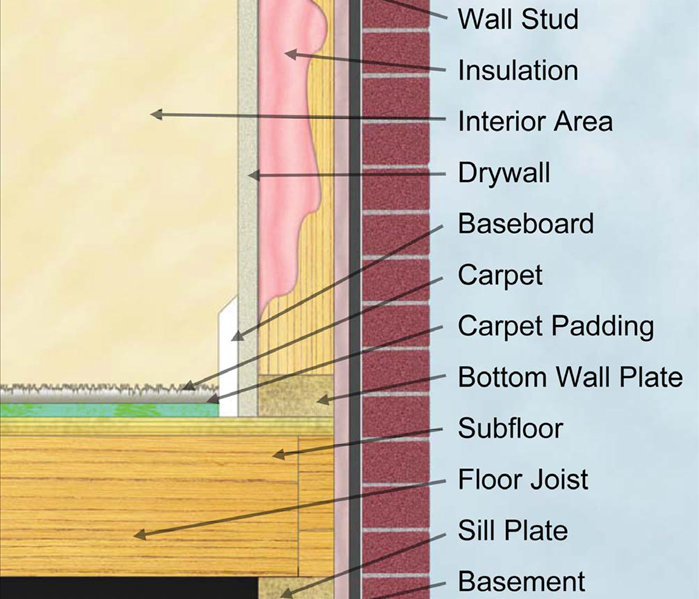 There a lot of layers behind a wall.. When your home gets flooded are you sure you dried it all out.
There a lot of layers behind a wall.. When your home gets flooded are you sure you dried it all out.
Your home should be your place of rest. When water begins leaking – even small leaks in areas you can’t see inside your home could quickly become a source of stress. The possibility of harmful mold, rot and unseen damage may affect the value of your home and the health of loved ones. Professionals understand how disruptive water damages can be for your entire family and will help ensure the water is identified, regardless of where it hides. That’s why we offer 24-hour
emergency response by trained, uniformed restoration professionals. With top-of-the line equipment and time-tested cleanup and restoration techniques, and have the expertise to help make your house feel like home again.
After all, when it comes to your home and family even a small disaster can feel like a huge problem. So if water damage occurs in your home just call a professional and get the job done right the first time.
The professionals you call should be able offer the following. Please keep in mind these professionals while adept at water damage and clean up they are not plumbers and cannot fix the underlying cause of the water.
Identify the Source/Type of Water.
Measure Temperature and Humidity for Drying Analysis.
Survey the Extent of Damage and Inspect the Premises For Hidden Moisture.
Perform Emergency Water Extraction.
Move and Block Furniture and Contents.
Inspect Carpet Pad/Carpet and Provide Service.
Apply Necessary Treatments (Disinfectants/Deodorization).
Utilize Advanced Drying and Monitoring Equipment.
Dispose of Refuse.
Water damage that you do not see is the most worrisome to us. People are always looking to save money and we get that. This results in attempts to clean up water damage themselves. Not only is this a bad idea it can be dangerous.
Water backup is from improper drainage to the sewer lines on the streets. Think about that for a moment. ..Sewer line back up, Contamination bacteria and a host of other hidden potentials. The other problem with this self clean up all too often people forget about what you cannot see. For example water comes in through the home, passes through your wall to get into your home. What is in your wall that you do not see? Insullation, Drywall, electrical wiring, maybe even insects and animal dropping or carcasses can all be behind there. When dirty water passes through there a lot that can go wrong, especially when you do not know it is even there.
Water restoration companies have special equipment that allows them to determine how wet certain materials are behind the scenes. They also have the training to understand water migration and that what is not always visible can still be there. Special training and equipment allows them to know to pull off baseboards, proper angle of fans in conjunction with industrial styled dehumidifiers to properly push the water out from behind walls into the air and extract it directly out of the air. There is a lot more to water remediation than getting it off the floor. You must then have the proper cleaners and anti-microbial sprays to rid the surfaces of all the bacteria and contaminants the water touched.
Please make sure you reach out to your local remediation company whenever you have water intruding into your home so that you can get back to normal as quickly and safely as possible.
Why having an actual office can grow your ROI
3/27/2017 (Permalink)
 Why having an actual office can grow your ROI...
Why having an actual office can grow your ROI...
Do you offer products and services to a client? Have you given up paying for physical space and set up shop in your garage with a desk in the living room? You may want to think again
While cost savings and a reduced back end operating cost is always important it may not be the best way to maximize your profit margins and control cost. There is a new emergence and longing for a connection from consumers. They are seeking out the differentiator. While still price driven they strive for the best for their money and many times the personal touch and extraordinary service that online outlets lack is just what they are looking for. Many are willing to pay a little extra to get so much more. There is an element of connection that is lost with only an online venue for goods and even services.
There is a shift with many consumers looking to enhance their experience with personal connections. The ability to stop into the local shop and talk to “Jerry”; have all your questions answered, items received, and problems solved immediately. Without a call tree, 40 lines of script back and forth with what seems like a computer or even a sent email into the abyss hoping for a reply up to a week later.
Having a fixed location can set you apart from your competition. So you are service driven company, how could spending money on an office possibly help you? Let us take a look at that. Which one of your key competitors has an office? How knowledgeable are you about your industry? What information would you like clients to know about that won’t fit on flier? Bet your wondering why we just asked you all these things.
If you have something your competitors do not you are already better off. An office can be a way to differentiate yourself. Clients can come into your office sit with you; understand what you are doing and how you can help them. Providing them an option other than their home gives you more control over the situation and could lead to better job conversion.
Your knowledge of your industry can prove pivotal if you have an office. You can hold seminars or lunch and learns for potential clients. This will show you are an industry leader and provide a smaller more intimate one on one learning environment to interact with potential clients. It also allows you to separate the more challenging things you come across. Common and frequently asked questions can be explained one time to a larger group reducing lost production time.
Developing a sense of who you are can earn you bonus points and getting to know the community beyond those you currently know is essential for growing your business. Most industries cannot rely on repeat and referral only. There was a time you actually went out and got new clients, you would not have a business if you had not. Why did you stop, get it going. Every year through attrition you lose up to a third of your business. What are doing to replace it?
The office can be the perfect way to engage, educate and encourage new clients to choose you over a competitor. One to one meetings you have control over, educational seminars to prove you’re a leader in your industry, Q&A sessions for potential new clients to get to know you and the services you offer. Win win all round..
So work on finding that office and get out of the truck, garage, or house and stop letting your business run you.
Prepare Now...Weather through later.....
3/8/2017 (Permalink)
 Preparing for a disaster is the best way to make it through the disaster. Plan Prepare Persevere
Preparing for a disaster is the best way to make it through the disaster. Plan Prepare Persevere
IPAWS…. No it is not a fancy term for a program for pet lovers… it is an Integrated Public Alert and Warning System ( IPAWS)
Created by FEMA, to provide an effective way to get information quickly and accurately out to the public in times of emergencies. It is able to tap into all the major emergency networks such as Emergency Alert System (EAS), National Oceanic and Atmospheric Administration (NOAA) for any weather related problems, Wireless Emergency Alerts (WEA) It is also used to send Presidential, AMBER and imminent threat alerts out. These messages can be sent through one or all of these channels to ensure that everyone that needs to be reached can be.
So what is NOAA.. It is a nationwide network of radio stations broadcasting forecasts, warnings, and emergency information 24 hours a day. It is a comprehensive weather and emergency information service available to the public. All Hazards messages include weather events, technological incidents such a chemical spills, AMBER alerts, and national emergencies. NWR also broadcasts EAS notices. A special radio receiver is required to receive NWR broadcasts. You can buy these receivers at many retail electronic stores, department stores, big box stores or even online. Make sure you are looking for the Public alert or NWR logo to ensure the radio meets the requirements. Models that identify as SAME ( Specific Area Message Encoding) will allow users to select alerts for specific geographic areas. For information on NOAA Weather radio All Hazards visit.
www.nws.noaa.gov
Local Jurisdiction Emergency Notification System:
Many local jurisdictions have an opt-in public alert and warning system. The opt-in systems requires you to sign up in order to receive the alert. Once you have signed up officials in your area can send you a text or email messages about local emergencies. Most opt-in systems all subscribers to choose the devices that receive alerts as well as the type of alerts. You may not be near a television or a radio when something happens a local text or email can be an extremely useful source for critical information. Small costs may be associated with receipt of the text message from your mobile carrier.
To find out what alerts are available in your area you can do a search online with your town, city, or county name and the word “Alerts”: You can go to the website for your local emergency management or public safety office, on contact these officials by phone.
Enhanced Telephone Notification (ETN) Systems;
In the event of an emergency local officials in many communities can send warning messages and instructions to individuals in an at risk areas through the ETN system. Such as a reverse 911 call. Most of these systems involve a land line phone system. At times they will allow a VOIP, and mobile through an opt-in process. So incase you do not have a land line check with local emergency management for information on this feature and its availability.
Out Door Sirens & or Voice Alert Systems
These systems are used to alert people outdoors of an immediate danger so they can take cover. It is not designed to be heard inside buildings or go through walls. Some communities while they have the siren in place it is no longer working. Please check with local officials to see if it is provided in your area.
Local School or Organization Notification Systems:
Many work places, schools, and community & Faith based organizations have systems in place to warn individuals of emergencies and provide tailored notifications to members. They are similar to the systems used but local emergency officials so check with the heads of these organizations and opt-in where you can.
Mobile APPS with Local alert functions.
FEMA APP ( Federal Emergency Management Association)
This will keep you updated on a vast array of emergency updates for up to 5 areas of the United States. There will be tips on how to stay safe, before, during and after over 20 various types of hazardous situations. You can customized it and save information for your families emergency plan. Receive and find driving directions to open shelters for disaster recovery. Submitting photos on the areas affected will help rescures find those most in need and keep tabs on everyone that needs assistance. This can be done through the disaster reporter feature. The app is available in English and Spanish and can be found through ITUNES or Google Play to learn more visit
www.fema.gov/mobile-app
American Red Cross APP
This app contains over 35 different types of severe weather and emergency alerts. You can choose the alerts you want to receive and that are important to you based on your location or that of your loved ones. There is a “Family Safe” feature that allows you to notify others if an alert has been issued in the area as well letting you check to see if they are safe. It also has tips on what to do before a disaster strikes, how to keep yourself safe during and what to do after. It will also keep you update on were Red Cross Shelters will be should you need help. This again is in English and Spanish and be found in either ITUNES or Google Play. To learn more visit…
www.redcross.org/prepare/mobile-apps
The Weather Channel App
This app tracks you guessed it weather and provides local forecasts. It will push out alerts of severe weathers to your mobile device as soon as they happen. This is free on ITUNES or Google Play. It can also be downloaded is APP world for black berry and windows phones at www.weather.com/apps
Recap of actions you can take to be prepared.
Confirm your mobile device can receive Wireless Emergency Alerts
Sign up for text or email alerts from your local jurisdiction
Consider purchasing a NOAA weather Radio All Hazards
If you do not have a land line check to see of your local community has operations set up for VOIP and or mobile phones to be connected to the ETN systems such as reverse 911.
Sign up for listservs and alerts for the workplace, schools, houses of worship or other community organizations you may want to hear from during an emergency
Download all relevant apps for appropriate alerts, hazards or warnings.
Create a list of all the alert systems available to you for your area. Make sure everyone in the household receives the alerts as part of your household communication system.
Organizations:
Test all of your emergency systems regularly to ensure proper working order. Also making sure everyone within the organization can be contacted.
Designate specific individuals to be responsible for distributing alerts from an official source.
Consider getting some NOAA Weather Radio All Hazards.
Develop a list of all the alert systems available for the communities surrounding the areas you service. This is especially important with multiple locations.
Encourage all of your employees to sign up for alerts and warnings. Assist them with finding the necessary information.
America’s PrepareAthon! Is a grassroots campaign for action to get more people prepared for emergencies. Make your actions count.
www.ready.gov/prepare
Interior Demolition Services
3/1/2017 (Permalink)
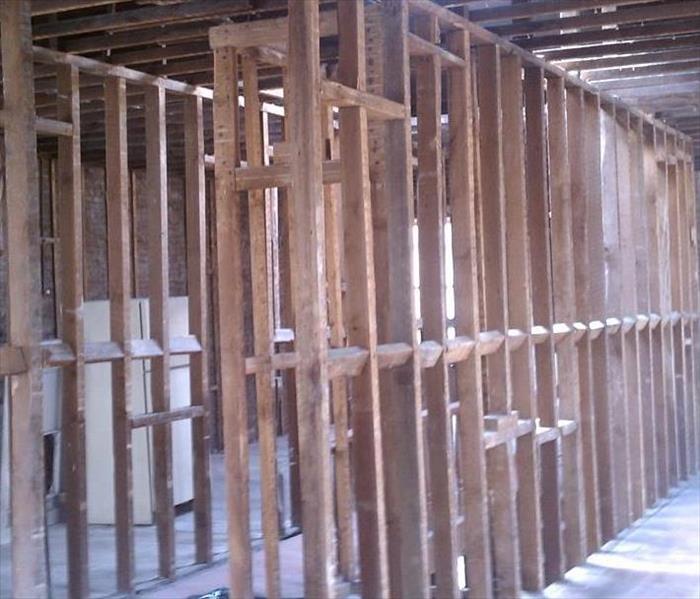 Clean interior demolition with no screws pieces of drywall or materials stuck to the floor is important when prepping a room
Clean interior demolition with no screws pieces of drywall or materials stuck to the floor is important when prepping a room
There are many types of demolition. However we are going to talk about interior non structural demolition. This occurs for many reasons, home remodel, Water, mold, or fire damage, asbestos or lead abatement and more. This work can be done on any building commercial, residential and in the public or private sector. Many times this work is a necessary as a result of damage of some sort. There are times that a home or building owner has decided to remodel and modernize an area or entire building.
Many remediation companies are called in after there has been some sort of catastrophe. When a pipe break, ice dam or even a fire occurs it can leave a home in ruins. At times they are called when you have tried to clean up some water damage yourself because if you cannot see it is gone right? Maybe you did not even know that you had the damage. This can result in mold, and a lot of it. When that happens there is a lot more work that needs to happen. These companies are trained to handle this sort of disaster and are adept at containing the damage to affected areas of your home as well as cutting down the dust and contaminates that could permeate to others areas of your home. With special equipment like HEPPA filters, air Scrubbers and professionally set up containment systems you can find confidence that they will keep you and your family or staff safe.
That knowledge and expertise makes them the perfect selection for a future remodel job that you are under taking. That same level of care with containment systems and air filters may be lacking in other construction companies as they do not deal with times that it may affect people’s health and safety. These containment areas also reduce the amount of dust that infiltrates your home which makes for a less costly and clean up once the job is done.
Many times there are abandoned, or foreclosed buildings that banks are trying to unload that have been damaged from neglect. This neglect can cost hundreds of thousands of dollars reducing the profit on getting the building sold. This results in great deals for those willing to do the work. Banks are not in the business of owning property so they must move on it as quickly as possible. General Contractors will many times buy these properties for very reasonable rates and refurbish them to sell a few months later. Most of these homes need to be fully gutted. While the foundation and the studs of the building are fine the rest needs to go.
Calling a company that deals with the interior of buildings such as fire water and mold restoration companies is a clear choice. They are have knowledge, man power and skills to get the building down to the studs with clean demolition (We will get into that in a moment). They are able to improve the air quality for your rebuild team to go in. In addition they are able to suppress any mold that is found before a rebuild team starts to cover it back up. They can remediate the existing mold and utilize their special anti- fungal and anti-microbial sprays to eliminate any issues that could pop up down the line if your guys did not see it or know what they were looking at.
Ok so clean demolition, what is that? Often a demolition company will come in and rip out a wall, pull down a ceiling and get to the studs of a home. They forget to take out all of the screws, leave a tack strip against the wall from a carpet that was laid down. Maybe they even make cuts that are well similar to what you 3 year old tried to do in the garage. We have seen it and it happens all the time. Clean demolition accounts for all of these things so that every screw is removed, every piece of drywall removed and done with precision cuts no jagged edges or ripped drywall. It ensures that there are no issues that will pop up later down the road from water damage that was not dried properly. Mold will not continue to grow if already present due to the anti- fungal and anti-microbial sprays. This can seem like a higher upfront cost than traditional demolition but trust us. In the long run there is always a savings in the end.
So when your home project needs some demolition turn to the companies that area already in the business with good habits and a keen eye. Because you never know what is behind those walls.
Mold: The Myth ; The Reality; The Solution
2/23/2017 (Permalink)
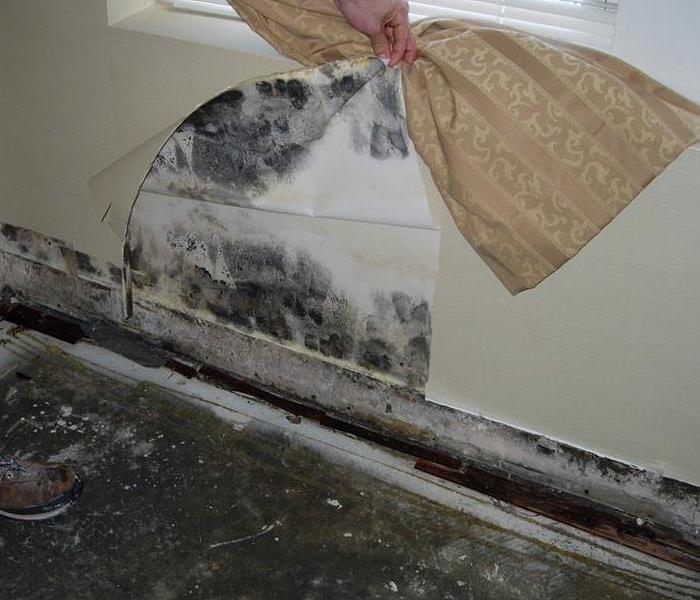 Great example of mold visibility and level of actual damage
Great example of mold visibility and level of actual damage
Mold is everywhere. Sorry to be the bearer of bad news. It is not always bad either. Many molds we embrace and some of us even eat as delicacies. Yeast, Mushrooms and Blue Cheese are great examples of molds we embrace and are widely consumed. In addition many are used in hospitals every day to fight and ward off infections such as Penicillin, Lovastatin, Clyclosprine and many more. We also find ourselves in contact with mold every time we go out. Most of this mold is harmless and does nothing to us. The damage lies in when we are in enclosed spaces with reduced circulation and a moist environment. There are specific types of mold that produce spores known as Mycotoxin these are the ones you do not really want around. That being said there are some myths about how to handle and clean this up should you find it within your home.
Let us take a look at the top 8 myths:
Mold is natural so you do not have to worry about it
If you only see a little bit of mold it is nothing to worry about it.
There should be no mold inside
All mold is bad
All mold causes health problems
Bleach Kills mold
Killing mold is enough I do not have to remove it
Cleaning up mold is not that hard you can do it yourself.
WOW ok that is a lot of information and very contradictory information at that. We have already debunked the idea that all molds are bad but what about the rest. While mold is a naturally occurring substance that does aid in decay it does not make it safe all the time. As we stated it is the type of mold that can be damaging not only to the air but also any building or area that it is found it. This is due to the way it feeds. It must absorb nutrients from the organism rather than directly eating it.
So when you can actually see the mold you have a much larger problem. Mold likes warm moist areas to live. All too often these are places you that go undisturbed for extended periods of time. When you can see the mold it is like an iceberg. The majority of it lives below the surface. When you open a container of fruit that was in the back of the refrigerator what you see is contained inside a sealed area. Your home attic, basement or forgotten closet is not quite as contained.
This is not to say that no mold should be inside a home at all. Mold is everywhere and all around you but acceptable levels and safe types of mold are the focus here. When an area is given ripe conditions for growing mold is where problems arise. Your health along with any allergies will determine how much mold you can tolerate within the environment. No one has set specific levels however within confined spaces vs outside our tolerance levels are drastically affected. There are a great number of contributing factors that come into play. Central heating and cooling for example allow for rapid air flow which can circulate spores faster as well create more air borne particles more likely to be breathed in than those that are not.
Having already determined that not all mold is bad, let us examine what happens to your health when you do come into contact with mold. First and foremost it does not mean you will get sick. Just like anything else there are varying degrees. Let us just say that you are very sensitive to the environment, already sick, or have severe allergies to other things. This could lead to a more intense reaction to mold spores. This does not mean a lack of a reaction means it is safe left un-treated it will continue to grow and can quickly become out of control.
So how do you get rid of it.. Bleach right… WRONG.. Understanding basic science helps here. Bleach is meant for topical treatments and does not soak into materials. Bleach is also very strong and can damage many surfaces that it comes into contact with. So anything porous gets a good cleaning from the surface could be ruined and you still have mold. Mold does not live on the surface of materials which we already discussed. It is a deep down organism. It needs the same to combat it. Concrobium ( Commercial grade) has these properties. It gets through the surface deep down into the materials. It then finds the mold spores and wraps itself around then and crushes them as it dries. While doing so the anti-microbial barrier remains on the surface to protect against future mold growth. Bleach dries and evaporates. Remember mold is under surfaces just like the iceberg.
Ok so I will go to the store and get some of that and I am all set right?? Well not exactly. Just wiping down a surface with the Concrobium will not do it. What caused the mold to grow in the first place. Did you use a scope and look behind the walls, get into the attic, or crawl space and see what was going on. Did you stop the problem? Did you remove the ruined insulation? What was the insulation rating, how thick was it and what did you do to replace it? How about that wall that is covered from the back? Were you able to get it all wiped and cleaned wait what about the front of the wall the pretty part? Did you spray and wash that down? What about the middle paint has a membrane that most moisture can not get through which is why you only saw it on the back of the wall. The middle of the wall though what did you do to access that! This is why you do not just wipe it down kill what you can see and move on.
Killing the spores that are there does not mean you still do not have a problem. If some of the spores were disturbed while you were spraying the solution and traveled outside of the treated area you will have this problem again. If too many of the spores became air borne they can get into vents and duct work and move to other areas of the house. Or even push down deeper into the materials affected and work from the other side that you may not have treated. Looking behind walls to determine the scope of the work needed is important. Many walls and beams can be affected and could need to be replaced. Calling a professional to assist in the proper remediation is the best way to get it taken care of properly.
Myths debunked. Check. Doctor visits are recommended if you suspect you have any issues that could stem from mold. Always call a professional and have them assess the situation before you try and handle it yourself. Be safe out there and makes sure you remember not all mold is bad.
Game changer if you have a fire at your business
2/22/2017 (Permalink)
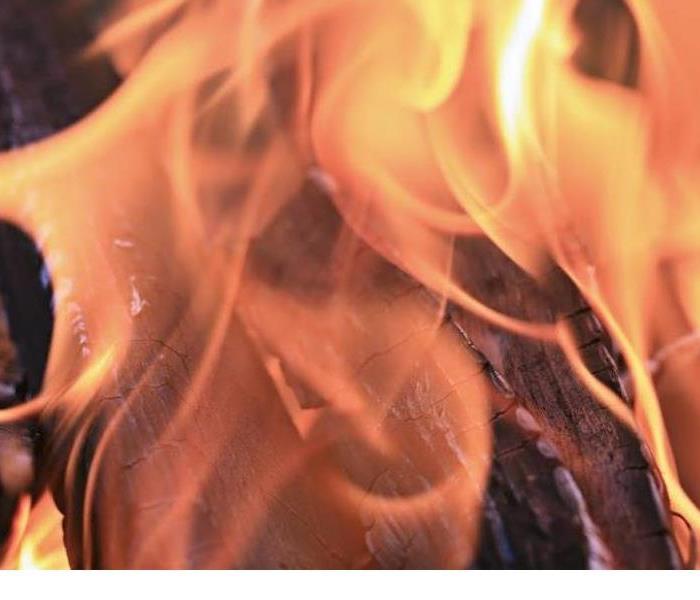 Fires at your business are devastating. Knowing what to do and who to call is a game changer..
Fires at your business are devastating. Knowing what to do and who to call is a game changer..
Fires at a business can be debilitating. There are many facets of business interruption that occur. Having to close your doors to clients, employees and revenue are the most disastrous. Many times businesses without a solid plan do not reopen. We are here to show you some ways to prevent that from happening. Timely responses are going to be your best friend when disaster strikes. Proper communication will provide you with a true scope of the damage as well as an explanation of how it will be handled.
First and foremost you must have a plan of action you will take prior to any major disaster. Whom it is you will be calling to get you back to normal. What company do you have to do the remediation process?? What you do not know, So you will be calling your agent they will know who you can call Right??? They are closed or on vacation. So you are going to call in a claim to the insurance company??? Where is your paperwork, in the desk where the fire just occurred? Probably as you have never had to use it before. So now without a plan you have just spent the better part of an hour trying to find someone to call.
Over an hour has passed and you are stuck in an endless call tree waiting for your insurance company claim department. Did you know most remediation companies can show up within 4 hours of the initial call. Many times it is much earlier than that. Starting the process of cleaning up your damage sooner rather than later will reduce the secondary damage that many insurance companies will not cover. . With solid knowledge of the claim process and the need for their services most insurance companies do not need prior approval or a claim number before services are started. Calling a restoration company and having one already in mind can save you valuable time.
There are restoration companies out there that provide emergency preparedness plans that are accessible from an app on your phone. All important contacts right at your finger tips. Filing a claim directly from the app allows you to put into motion the clean up process to ensure there is no lapse in executing a plan. These plans can also show emergency responders where your major shut off valves are so they are able to keep themselves safe as well as stop any additional damage from occurring.
Although a fire may be contained on one floor, the damage caused by the fire may affect other floors within the building. As a business owner your focus is on handling the job promptly and properly to minimize disruptions to your customers, employees and vendors. Prompt action by a professional helps reduce secondary or long term effects allowing you to return to business as usual. How you can prevent additional damage until a professional arrives is.
1) Limit movement within the affected area
2) Place towels, sheets or old linens on areas where traffic will occur to prevent additional contamination or tracking soil into unaffected areas.
3) DO NOT ..>DO NOT attempt to wipe off or remove any soot that sits on any walls furniture or stationary object. This can push the soot and odor deeper into the material making it more difficult or impossible to remove later.
4) DO NOT attempt to clean any carpets or upholstered furniture without speaking to a professional.
4) Turn off and or unplug all technology in affected areas and do not turn on until you consult a repair service
5) DO wipe chrome faucets, appliances or other non porous surfaces ( NO Stone counter tops do not count) The apply a light coating of lubricant.
A professionally trained individual is the best way to ensure that you have the most effective cleanup possible following a fire. Attempts to clean up the damage can result in improper drying resulting in mold. Smudging in the soot deeper into the materials can result in inability to remove the damage and lock in the odors.
Not every fire damage is the same but there are some basics of treating fire damage that remain constant.
What to expect:
Smoke and soot removal
Water Removal and dehumidification
Odor Removal
Many times restoration companies will contact you back to arrange services within 1 hour. Their arrival is usually no later than 4 hours after that initial phone call< many times earlier. They will communicate the scope of work and how things need to be handled within 8 hours. This ensures a solid foundation for getting you back up and running as soon as possible. They are available 24 hours a day 7 days a week including holidays so that you can start getting back to normal right away.
Weekend flooding ..Cleaning on your own !!!
1/31/2017 (Permalink)
 Water damage does not have to be this severe to be a problem. Cleaning it up yourself can be?
Water damage does not have to be this severe to be a problem. Cleaning it up yourself can be?
Over the weekend I heard a lot of people talking about getting flooded. When prompted about who they had come out and clean the water they most assuredly said they did it themselves. Below you will find what was done by the majority of people.
Step 1: Went out and bought a wet/dry vacuum.
Step 2: Get rid of water. Used a lot of rags, towels, New Vacuum
Step 3: Go through all the stuff that was wet repack what they thought could be saved and tossed out what was too wet.
Step 4: Found their home dehumidifier in the closet and placed it in the room. Left it on for a few hours and then turned it off.
Proudly showing off that there was no longer water in their basement and how they solved the problem.
YIKES>>>>>>>>>>> Few Steps missing
Step 4: has a lot more than setting up a dehumidifier for a few hours. Industrial dehumidifiers are set up in homes and left on for at least 3 days. They are also set up with industrial fans that circulate the air and blow directly on the wet materials so that they will dry faster. No fans were set up and the dehumidifier was not left on for nearly long enough.
Step 5: Take moisture readings after a few days to asses effectiveness of the drying process outlined above. If readings are not back to normal levels for the home you need more time to dry.
Step 6: Spray everything. Concrobium is an anti-mold growth spray that must be used to cover everything that was wet. Floors, walls, Appliances, any wood or furniture that was wet with the damage must be sprayed. This step is crucial to not get a musty smell in your home. That smell is a result of improperly drying from water damage.
Should you notice mold you must call a professional. Mold remediation is a much more intensive process and is a lot more costly. If you recently cleaned up a water damage problem yourself and skipped any steps above I suggest you call a professional to have them properly assess your situation. It only takes 24 hours for mold to start to grow. The water that you cannot see causes the most damage. Please make sure you are working with a professional when there is damage this can save you thousands down the road.
Burn Awareness Week is February 5-11
1/31/2017 (Permalink)
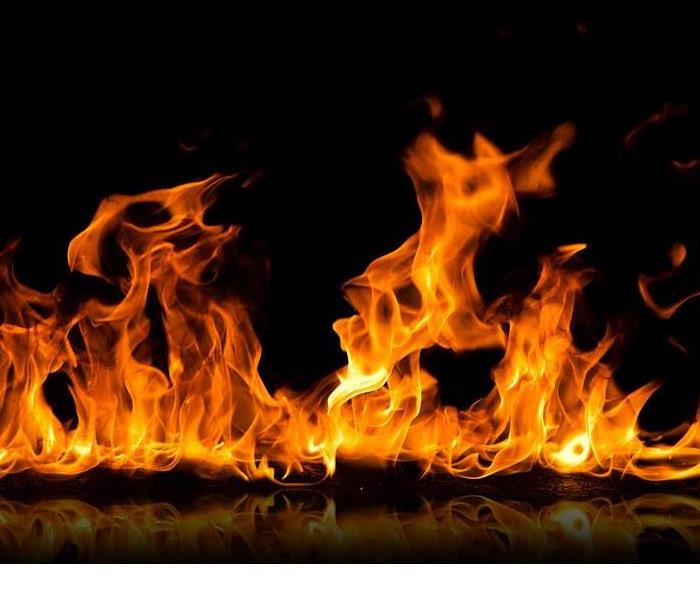 Fire, liquids, ands steam can all burn the same and the results can be devastating. Know how to stay safe.
Fire, liquids, ands steam can all burn the same and the results can be devastating. Know how to stay safe.
National Burn Awareness Week 2017
FACT SHEET
Burn injuries continue to be one of the leading causes of accidental death and injury in
the United States.
Between 2010 and 2014, approximately 486,000 people were seen in Emergency
Departments for treatment of non-fatal burn injuries.
In 2014 alone, there were 3,275 deaths from fires, which includes 2,795 deaths from
residential fires, 345 from vehicle crash fires, and 135 from other sources.
One civilian fire death occurs every 2 hours and 41 minutes.
The odds of a U.S. resident dying from exposure to fire, flames or smoke are 1 in 1442.
The primary causes of injury include fire-flame, scalds, electrical and chemicals.
Men are more likely to be burned than women (68% males and 32% females were seen
at a burn unit).
Most of the injuries occur in the home (73%) followed by work (8%).
Tragically, children, the elderly, and the disabled are especially vulnerable to burn injuries,
and almost one- third of all burn injuries occur in children under the age of 15.
Children under five are 2.4 times as likely as the general population to suffer burn injuries
that require emergency medical treatment.
Young adults ages 20-29 have a probability of burn injury that is roughly 1.5 times the risk
of the general population.
Today, 96.8% of those who suffer burn injuries will survive. Unfortunately, many of those
survivors will sustain serious scarring, life-long physical disabilities, and adjustment
difficulties.
Sources: 1. National Hospital Ambulatory Medical Care Survey: 2011 Emergency Department Summary Tables, Table 11 (accessed
at http://www.cdc.gov/nchs/data/ahcd/nhamcs_emergency/2011_ed_web_tables.pdf on June 2, 2016) and NEISS All Injury
Program operated by the Consumer Product Safety Commission for numbers of injuries. Bureau of Census for population estimates
(accessed at http://webappa.cdc.gov/sasweb/ncipc/nfirates2001.html on June 7, 2016). 2. National Fire Protection Association:
Fire Loss in the U.S. during 2014 (accessed on 2/8/16, at http://www.nfpa.org/research/reports-and-statistics/fires-in-theus/
overall-fire-problem/fire-loss-in-the-united-states). National Safety Council Injury Facts Sheet 2015 (accessed 2/8/16, at
http://www.nsc.org/learn/safety-knowledge/Pages/injury-facts-odds-of-dying.aspx). 3. National Inpatient Sample (HCUP-NIS:
2010 data); National Hospital Discharge Survey (2013 data); recent 100% hospitalization data from several states. 4. ABA National
Burn Repository 2015
Commercial Buildings Yeah we do that.....
1/4/2017 (Permalink)
 There area a lot of commercial properties in and around the Boston area. Is yours protected?
There area a lot of commercial properties in and around the Boston area. Is yours protected?
Did you know SERVPRO of East Boston provides services for your commercial properties?
Serving the local community when disaster strikes is always important. So is maintaining the cleanliness of your property as well as restoring it when an unforeseen issue occurs. Our services are not limited to residential
Commercial Cleaning:
Many times business owners and property owners will call us to assist in a thorough cleaning quarterly. This helps maintain high standards while taking the pressure and time off of your staff to focus on the money making aspects of the business. Restaurants in particular reach out to us due to the strict standards set forth by the board of health. When the grease has begun to build up, or the walk-in had just too many articles of food under the floor grate they will call for a once over.
Ok so what is a once over? It is a team of people that clean every nook and cranny, wiping it all down. It can mean trash removal, disinfecting, duct cleaning, brick cleaning, and even air quality checks. The list is exhaustive as we will customize every aspect of your needs to ensure your project is done.
Emergency Services:
When you do have an emergency is it important that you get back to normal as soon as possible with as little interruption to your clients and their access to your goods and services. There are so many reasons business interruption can occur but the most common for businesses are cooking, electrical, heating, arson, smoking and combustible materials. I see you already shaking your head, we only have a microwave and a coffee maker here. All of our employees go outside to smoke and our wiring is up to code. We do not have any combustible materials in our office and who would set fire to the building.
Guess what each and every one of the things listed above are plausible. While some may be more inclined to happen than others they are the top reasons for damage. We are able to help with each and every one in addition to a few extras. Think your building is too large or small for our services? Think again we have access to a full arsenal of resources to scale up or down based on the projects needs.
Emergency Ready Plans:
What do you do in an emergency? Who do you call? Great you know the plan, does everyone else? What happens when and if you something happens and you are not around? We have a solution for that. It puts vital information at your fingertips immediately. These plans outline where key shut off valves are within the building to mitigate damages. It will also supply everyone with immediate points of contact for starting the process of cleaning up as soon as possible so that loss of business can be reduced as much as possible. Ask us today about these FREE PLANS.. Yes you read that right. FREE>>
Water and Fire damage cleanup:
While this sounds straightforward enough there are a whole set of rules that come with the proper cleaning up of this sort of damage. Water damage rule number 1 just because you cannot see it does not mean it is not there. Unless you have moisture meters and know what the resting state of the building is vs the area where the water damage occurred you cannot tell if it is dry or not.
Oh and that soot you see all over the wall LEAVE IT ALONE… chances are you will clean it wrong and will not only make is worse but push it into the very fibers of whatever material it is on and make it impossible to get out. I bet you did not know that there are 3 different kind of smoke damage? Wet smoke, dry smoke, & protein fire residue, each one requires different treatments and some are invisible to the eye. Due to each cause of damage being different and having different chemical reactions that cause the residue it is important to understand analyzing the situation and selecting the right solution will be the only want to ensure that your problem is solved correctly the first time.
Mold & Air Quality:
Have you ever cleaned up a water loss with your own in house team? Did a pipe break get cleaned up professionally but everyone forgot about the duct work? Do you have a lot of employees calling out and taking sick days? This all costs time and money which is valuable. Have you ever looked internally to see if the culprit could be the building itself? Many times these overlooked areas of money saving attempts can be the cause of such issues. Providing proper air quality that is free of mold and contagions will keep your staff as healthy as you can control and in turn reduce time away from the office.
There are a lot of commercial properties in and around town. Is yours protected? If you are not sure we can assist you with your building give us a call and just ask chances are if we cannot assist we will surly know who can. SERVPRO of East Boston is here because life interrupted is no fun. 617-567-3777 serving the East Boston, Chelsea, Revere, Winthrop, & Charlestown areas .
Storms hit hard are you covered???
12/27/2016 (Permalink)
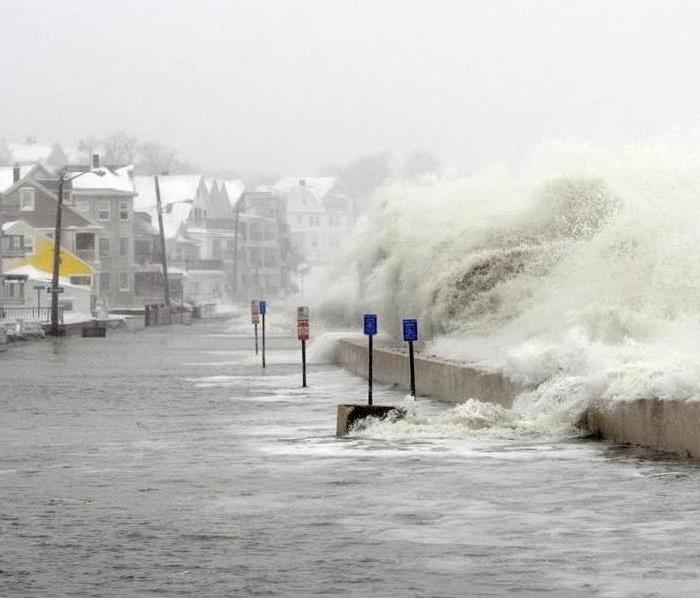 New England Storms vary from Water, Ice, Snow, Fire, and occasional tornado are you ready? Who do you call and are you covered
New England Storms vary from Water, Ice, Snow, Fire, and occasional tornado are you ready? Who do you call and are you covered
Storm damage to homes can vary greatly. The kind of storm, where you are located, and what is going on around your home can all impact what goes on.
For example if you live near the coast and there is a storm surge coupled with some high tide serious flooding can be a major concern. This can be amplified if you are on the edge and beach erosion occurs. Many home owners have the bare minimum coverage levels of insurance and if you are not in a flood zone many do not have flood insurance. Guess what this would be classified as a flood and you would not get any assistance with the process of getting back to normal.
Should you live further inland and be surrounded by nature. A strong storm with a lot of wind can be your down fall. A dry winter coupled with some rain will loosen the roots of those large trees that provide you shade in the summer. With nothing solid to hold onto these trees can be easily uprooted and topple over. Should your home be in the way there is a lot of trouble to be had. Many do not have storm damage coverage for such events and will have no assistance getting back to normal .
Storms can also bring heavy wet snow. This snow can sit on a roof or melt. Should it sit a little too long it will become heavy and possibly cause a crack or gap in the roof or foundation that is not able to support the weight. When this happens and then the snow eventually melts which it will a lot of damage can occur. This water will find the path of wet to dry and many time during that search it leads to the inside of your ho me.
If you live in an area of open fields and wide open view of flat land or have a farm. The storms that ravage through could include a tornado. We have all seen the destruction and devastation of those. When a home is flattened or a roof has been ripped off from the wind what is left to protect you from the onslaught of rain damaging your belongings inside. Many time this secondary damage has very limited coverage and will be dependent on the speed in which you called someone about the first part of the damage and their response time. Make sure you are calling a professional that can arrive quickly. Mitigating your response time is doing your part of the insurance process.
Drought while not an actual storm event can lead to devastation and destruction. Many times this dry debris on the ground can be ignited and cause a literal fire storm. Once a fire has started if your home is affected there is a lot to be done. Also an investigation will be conducted to find the cause of the fire. Should that lead to anything malicious it is important to know what is and is not covered. Subsequently if there is a fire in your area but not in your home it does not mean you will not be affected. The odor from a nearby fire can infiltrate your home and cause quite a bit of damage. Ensure you are ready and know if your policy will cover such an event.
Many times if an insurance policy does not say it, It is not covered. That can turn into a major disaster if you are left to fend for yourself during a significant loss beyond your control. It is always wise to review your policy and make sure you have coverage for as much as you can. No one has insurance because they want to and certainly not because they expect to need to use it. Yet finding out you do not have the right coverage when you need it most is not the time to find that out. Call your agent or broker today and make sure that any unforeseen issues are addressed before it is too late
Flies in School ... A lesson to be learned
12/21/2016 (Permalink)
 Local high school had a sewer line break went unnoticed until the school was infested with flies. The importance of assigned duties, & proper training
Local high school had a sewer line break went unnoticed until the school was infested with flies. The importance of assigned duties, & proper training
Did you know that SERVPRO helps schools stay up to code with clean healthy environments for your children. We will even respond to emergency clean up situations. Having seen in recent news the fly infestation that occurred at a local Chelsea School we were compelled to spread the word.
We can give schools a once over deep cleaning after summer breaks or vacation weeks to make sure that students come back to a fresh clean environment ideal for learning. If your school has recently updated its equipment or has a lot of broken desks and older books to get rid of let us know we can haul it away to free up more space for learning. Did one of the kids in protest vandalize the school in some way in protest of an event that occurred at the school let us know and we will respond to quickly get you cleaned up and back to normal learning . Prolonged distractions can be detrimental to the education process and even emotionally upset students if it was derogatory.
Smell something funny, see something on a wall that does not look just right, or some new visitors that you know should not be there. Well we are here to tell you if you can see it, smell it or even hear it the problems is far worse than what is within the range of our senses. It is very critical that you call in professionals to detect not only the immediate problem but also have the knowledge to detect the root reason that the problem exists in the first place.
Let me explain, with the case of the Chelsea school the problem was a fly infestation. They did not just appear for no reason. They had to have a ripe environment with an adequate food and water source, and an over abundance of sewer water was just the thing. The flies were not really the problem a broken sewer pipe was. Having gone undetected for an undetermined amount of time allowed for the flies to blossom and become the major issue that it was forcing a school closure.
We see this all too often within businesses and a lot of damage can occur from not having an assigned person trained to look for the subtle signs that prevent a much larger issue. Dedicating one person to do a once over the entire building daily and making notations of any odors, visual changes, as well as any animal or insect changes is pivotal to building health.
Along with several incidents of that same person not having the authority or not knowing what to do if there are changes to the environment. Emergency Ready Plans for businesses guide the individuals on the front lines through policy, procedures and protocols to make sure that issues are addressed quickly and correctly. They can be customized to the needs of your facility and can include evacuation routes and meeting points. Main points of contact in case of an emergency and closest emergency service locations can also be included. As a preparedness plan I ask you, if you asked your primary team where the water and electrical shut valves were for the building will they be able to tell you? Most will not our preparedness plan will put all that information at your fingertips from where ever you are.
It is a mobile app that will keep each locations information separated as well right at your fingertips. The best part is it can be shared with whomever you would like to share it with so long as they download the app to their phone. A version that can be edited is available to the key players while a non-editable version can be sent out to local managers.
No one plans for an emergency but having a plan in place and having people that know what to do should an emergency arise can be the difference between a slight issue and a major emergency. Working with a company whose network spans the country ensures 24 hours 7 days a week availability and response time mitigates the damages and provides solid clear cut direction for your staff.
Our staff is trained to clean and sanitize building materials, surfaces and contents following the restoration industry standards along with using FDA registered cleaners and disinfectants. Bleach does not get it done on pesky situations. Call the professionals at SERVPRO of East Boston to ensure your next problem does not become a major problem.
I am glad I did not have insurance for ....Said no one ever....
12/5/2016 (Permalink)
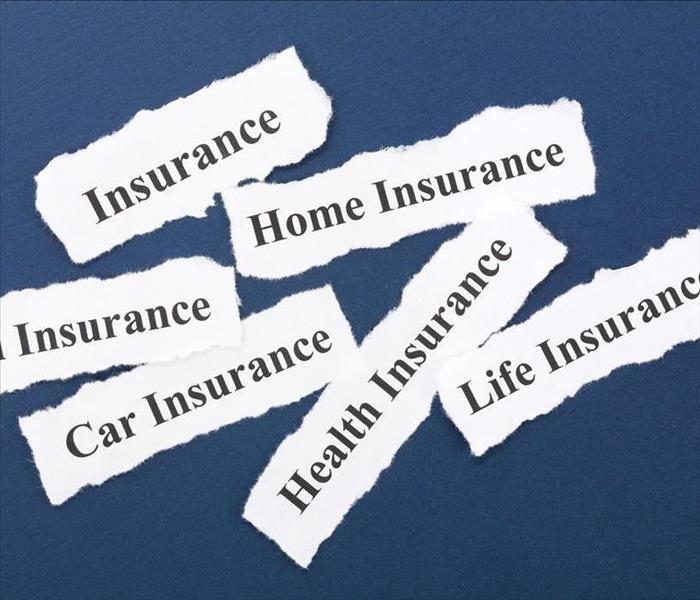 Having the right insurance and coverage can mean all the difference in the world
Having the right insurance and coverage can mean all the difference in the world
Never has anyone said I wish I did not have that health insurance after having a severe health scare.
Never has anyone said wow I sure am glad I did not have car insurance after getting into a bad car accident where there was personal property damage and an injury to themselves or others.
Never has anyone said wow that insurance was a waste of money after suffering devastation from a fire.
Never has a loved one said I am grateful that I got to pay for those funeral services myself, due to a family member not having death benefits laid out prior to something happening.
Never has anyone said it is a good thing I did not spend $30 a month on rental insurance when the lost everything in their apartment due to a frozen pipe break or fire in the home they were renting from
Sure everyone complains about insurance, and yes many many times it is an expense we all look at as wasteful and a crock especially if you have never had to use it on a larger scale. But let us examine some situations where this was not the case. These examples are real , we know these people personally and they have all occurred in the month of November of this year.
- Health Insurance
- This is a very large expense for most and with premiums, deductibles and co-pays going up can be something we look at to cut from our expenses. This is always a bad idea, all it takes is one accident, one injury and everything you have could be gone. Do you have enough money in your savings to be out of work with no income for 2 years or more? If you are like most Americans your answer is no. Well guess what then you cannot afford to not have health insurance.
- Health Insurance & Aflac coverage Example: Recently read a story about a gentleman that has cirrhosis of the liver. While undergoing testing for this they found prostate cancer. Both of which are painful and require aggressive treatment with inpatient and outpatient care for more than 3 months already. His wife was walking into the hospital during one of his admission days and she slipped and fell in the parking lot and broke her back. This is going to require surgery. Two people who can no longer work, which do not have a means of paying their regular bills nor the mounting hospital bills due to having no insurance.
- Obtaining insurance for your bills like Aflac and any sort of health insurance will provide a buffer for such care and would put them in a much better position to focus on their care and getting better rather than where they will live when they are released from the hospital.
- Home Owners Insurance with Fire Coverage Rental insurance & Health Insurance Example
- A family was trying to clean up a home they had rented which was trashed by the occupants. The owners had recently moved to Colorado and rented out a place in Florida. A faulty electrical wire sparked a major fire one night while the owner was trying to clean up the trashed Florida home. He suffered severe burns to a good percentage of his body specifically his hands and the home was burned to the ground. He has only been treated in the hospital for 2 weeks with weeks and weeks to go, as burns require constant care for high risk of infection. Medical bills alone are over $20K after 2 weeks. There was no insurance on the home in Florida and now they have nothing left what so ever. There is also no medical insurance so he checked himself out of the hospital and is trying to treat the painful burns on his own due to the expense of the proper care in the hospital.
- Rental Insurance:
- So you do not own a home. Does that mean you do not need to protect the things you do own? The items in your apartment are not covered by the home owners’ policy. If there is water damage from a broken pipe or fire and smoke damage that puts you out on the streets with nothing left can you start over easily? The answer is most likely no. Making sure you are able to replace items that you lost is very important this insurance is very cost effective and less than a dinner out once a month.
- Rental insurance example:
- A young couple with 2 children living in a 3 family home in the area. The home suffered a fire. Many of their belongings were lost in the fire. They were able to get in and look around but where told not to remove anything as they investigators were not done. Once the building was cleared for them to remove the few things that remained it was noticed they had been robbed. Not only do they have to come up with first, last and security deposit to find a new place to live. They must replace all items that were lost in the fire or stolen. Would you be able to recover and replace these items in less than a 2 week time frame. Why two weeks???? That is all that many assistance agencies will provide for shelter in regards to shelter and food.
- Death/ Funeral expenses & Health Insurance:
- Death benefits & Health Insurance Example:
- Many times death is not planned for and can be sudden or tied to an onset of an illness. Should a loved one die do you have $ 10K or more for their services. What will you have to sacrifice to give them the send off they deserve.
- Unexpected Death Example:
- A 38 year old father of 2 went to sleep and never woke up. He had a blood clot let go and went into his heart from his lungs. His family had to raise funds to be able to provide him with funeral services. This delayed the services by a few weeks. When dealing with a loved ones’ death trying to raise enough money for a proper burial is not what you want to deal with.
Will you have to choose between your health and a bill? Where is your line of care drawn and what will you be able to rebuild with when there is nothing left. These stories are not meant to have you roll your eyes and say it will not happen to me.
These are all real world examples of people we know just during the month of November. These personal accounts are near and dear to use as they are friends or family of friends. Insurance is the one items you spend money on that you want to be a waste of money but let me be the first to tell you it only takes one accident, on slip and fall, one bad day to make it the most valuable thing you have ever purchased.
If you are not sure what insurance is right for your specific situation or what you may need reach out to your local insurance agent. With everything being so customizable it is very easy to find what fits your needs. Please do your research, a lot of it is not as expensive as you may think and the peace of mind for you and your family can not have a price. Be safe out there we want you home with your family every day.
Preparing your home for winter in New England
11/30/2016 (Permalink)
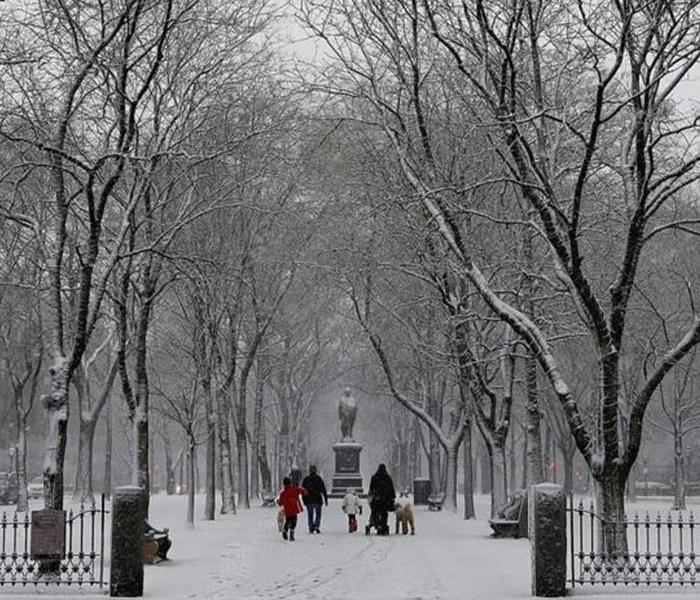 In and around Boston in the winter can be a beautiful. Ensuring your home does not suffer from any storm damage will help you enjoy the season
In and around Boston in the winter can be a beautiful. Ensuring your home does not suffer from any storm damage will help you enjoy the season
It is that time of the year again here in New England. Winter storm season. This 2016-2017 season is predicted to be much colder due to a weakened La Nina. NOAAs’ prediction is that the northern states will see a lot more snow than last year. Which was one of the warmest winters in 121 years. This year is predicted to be riddled with frequent storms and cold temperatures.
These colder temperatures and increased chance or more storms mean there could be more storm damage. This damage could be from the cold getting into your homes and freezing your pipes to heavy snow collapsing roofs. Now is the time to prepare and take steps to reduce the chances of damage to your home. Freezing pipe, ice dams and fires are the most common forms of damage during the winter season. Here are some key tips for helping to prevent major problems.
Insulate pipes..
We have said it before and we will say it again get some cheap foam from a home improvement store that rated for the type of water pipes you have. Put them on as many as you can find. Make sure you leave room when you get close to the heating units so that there is no risk of fire.
Open Cabinet doors
When the really deep cold sets in make sure you open cabinet doors. Ensuring under sinks, in bathrooms, cabinets and hutches that have piping running from one level to another are all open will help keep your pipes more warm
Run the water
Yes run the water. A slow moving water drip will help prevent freezing because moving water takes more time to freeze. This is not a full on high running water it is a slow stead stream. Know the difference. Remember that it is one and if you can collect the water and place in front of your heat source so that you can introduce moisture back into your home and conserve a little water in the process.
Search for Gaps
Look at pipes, vents especially dryer vents and electrical outlets that come in from the outside. If there are drafts fill the edges with caulking or spray foam. This will help keep the cold out.
Properly setting your thermostat
Many of you looking to escape the dull gray skies will go on vacation. In an effort to save money so many turn their heat way down or off. ***DO NOT DO THIS*** Keep your thermostat at a minimum of 55 degrees we like 60 or better, and open any and all cabinet doors. The last thing you want at the end of your vacation is to come home to a soaking wet house that has been running for days.
Knowing your home:
Where is your water shut of valve. Sure most of us know how to turn off the water if something happens to the toilet or the washing machine it is the valve right next to it. What about a pipe on the 2nd floor to mitigate your damages. Do you know where the main shut off valve is for the house? How about how to turn off your water heater? Learn where these things are and show everyone who is old enough how to do it as well. The sooner the water is shut off the less damage it can cause.
Ok so your home should be ok now we did not forget about your garden. We love the pops of color in the spring. The Home grown vegetables from the summer and the atmosphere of the leaves in the fall create a home outside for you and your family. It is important to take care of it during the winter months. Sure it will get covered in snow and there is not much you can do but before that happens here are few tips.
- Before the first Frost:
- Any attempt to protect plants should be done before the first frost. You can usually find some information online about your area and when that typically happens.
- Cultivation Protection:
- You can do a variety of things with the plants and their placement to aid in the winterization. Choosing sheltered spots will protect from wind damage and the sudden onset of cold weather. Know the North, South facing spots as well as how much sun these spots get this will aid in placement.
- Mulching
- I know mulching in the winter? It acts as a great insulator and holds a lot of soil from being washed away as the rain and snow move and.
- Planters and containers
- Create a portable garden that you can place anywhere based on the season.
- Special wrapping & Structures
- Insulating wrapping can be obtained to protect susceptible plants to keep the more warm during the freezing temperatures of the winter. Structures can also be built to protect from the heavy weight of the snow and any that could fall off of a roof onto plants near the house. “A” Frames are the easiest and most effective. Creating a windbreak or barrier can aid many plants as well. This can be achieved from other plants such as dense bushes or hedges. You can make one with some netting and posts staked into the ground
- Drainage
- It is important that you do not have pooling water in any areas of your yard. Extra wet soil just like extra dry soil will prevent the roots from holding firm and could have trees uproot. Ensure that your lawn is level and pooling does not occur.
Keeping these things in mind will help you have a worry free winter. Filled with family, friends, and fun. When spring comes you will ready to go with a lot less fuss. Have a wonderful holiday season and enjoy the winter.
Turkeys for the Chelsea Thanksgiving Feast
11/21/2016 (Permalink)
 Owner Ben Charwat with Rev. Gutierrez shaking hands after we delivered turkeys to feed the homeless on Thanksgiving in Chelsea.
Owner Ben Charwat with Rev. Gutierrez shaking hands after we delivered turkeys to feed the homeless on Thanksgiving in Chelsea.
We are always looking to serve our local community and helping with fire damage and water damage is not all we try to do. Giving back is very important to us, which is why we are always looking for areas of the greatest need with the communities we serve and try and do what we can.
After doing some research and making a few phone calls we were in touch with Saint Luke's-San Lucas Episcopal Church. We had heard they were having a hard time securing some turkeys for their Thanksgiving Day feast. We called to speak to the man in charge Rev. Edgar A. Gutiérrez-Duarte Vicar. We had a lovely meeting with him, he showed us around the church and also introduced to his team of volunteers there to unload the truck for their weekly food pantry they run. They feed over 1000 people a month.
We asked specifically about the holiday season and the needs that increase during this time of the year. Rev.Gutierrez told us they were having trouble securing turkeys for their Thanksgiving day meal for the homeless. They have more than a 100 people that show up for this meal and rely on it as their only place a holiday meal. He told me that on years they are not able to secure turkeys the rest of the meal is sacrificed and not as elaborate due to the expense.
We answered the call and delivered all the turkeys to them this week. Knowing that their only meal for the day will be the best it can, and should be, is part of what makes our community great. Developing strong bonds and getting to know the people within it is the only way to make it better. Sure if you have fire damage, water damage, or a mold problem will be there to help. For ensuring safe buildings will help the community, but there are additional needs.
This pantry is the largest in the Chelsea area and services over 1100 people a month taking in over 5 tons of food a week. This helps provide for many familys that are just hanging on.
We were told that they have seen a decline in non-perishable food items. Such staples as rice, beans, peanut butters, dry cereal, nuts and many other such items. The revered is not sure why this decline is happening but it is affecting the community. Many rely on these items to give them the substance to the meals and provide essential proteins and nutrients that otherwise go missing.
If there is anything that any of you can do please reach out to him.
Saint Luke's-San Lucas Episcopal Church
201 Washington Ave
Chelsea MA 02150
617-884-3300
Safely deep fry a turkey
11/16/2016 (Permalink)
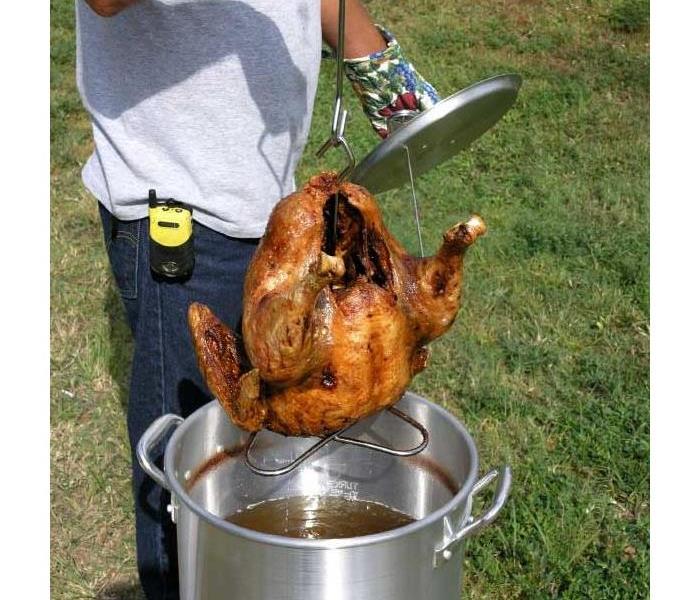 Properly deep frying a turkey can prevent dangerous fires.
Properly deep frying a turkey can prevent dangerous fires.
It is almost thanksgiving. Time for friend’s family and food. Many believe that turkey is the best thing to serve and while many have their own methods for preparing it deep frying it has really caught on in recent years. What else has caught on are the fires from doing it improperly. This is not the way to start the holiday season. So let us really take a look at the dos and don’ts of this time honored tradition.
Key things to know before you start even attempting to fry it. Oil is flammable. It requires a lot of oil to deep fry a turkey 3 gallons or more. Do not do it in your home or on the leaves you did not bother to rake. Also your porch which may be flat is not an appropriate place to place your fryer either.
- Use an official Fryer ( NOT A TRASH BARELL)
- Make sure that the surface is totally flat
- Be outside
- Keep kids and Pets and inebriated people away from the set up area.
- Thaw the turkey (DO NOT USE A FROZEN TURKEY) Better yet use a never been frozen one
- Oil and water do not mix Rule Number one
- Marinades must be dry rubs any wet marinade will add water to the turkey and cause a lot of issues when submerged
- Size matters 14lbs or less you can fry the whole thing larger than that you have to take the legs and wings off
- DO NOT STUFF YOUR TURKEY
- Do not just drop your turkey into the fryer ( have a basket which can be lowered slowly into the fryer)
- Remove the wrapper. .. ( yes it had to be said)
- Check how much oil you need before you start.
- Place turkey in container
- Fill with water until turkey is covered completely
- Remove turkey
- Mark with a line on the fryer or use a ruler to measure where the water level is
- This is your oil fill line
- MAKE SURE YOU DRAIN OUT THE WATER FULLY and dry your container before filling with oil ( YES THAT NEEDED TO BE SAID TOO)
- Heat oil to 375 degrees
- Cook until dark meat measures 175-180 and white meat measures 165-170
- Stay at least 10 ft away from everything
- Have a fire extinguisher on hand
- Fryer stays hot for HOURS.. stay safe and fully cool before attempting to empty or move
Why all the warning about water and thawing fully patting dry and fire extinguisher. Oil and water do not mix. Oil has a very different flash point than water so when water is introduced to hot oil the rapid cooling forces the oil to splatter this splatter hitting anything flammable will cause it to catch fire and cause serious damage.
Please know that frying a turkey is always a delicious way to cook it, but knowing how to do it safely is imperative.
Insurance do you have the right insurance and it is enough?
11/10/2016 (Permalink)
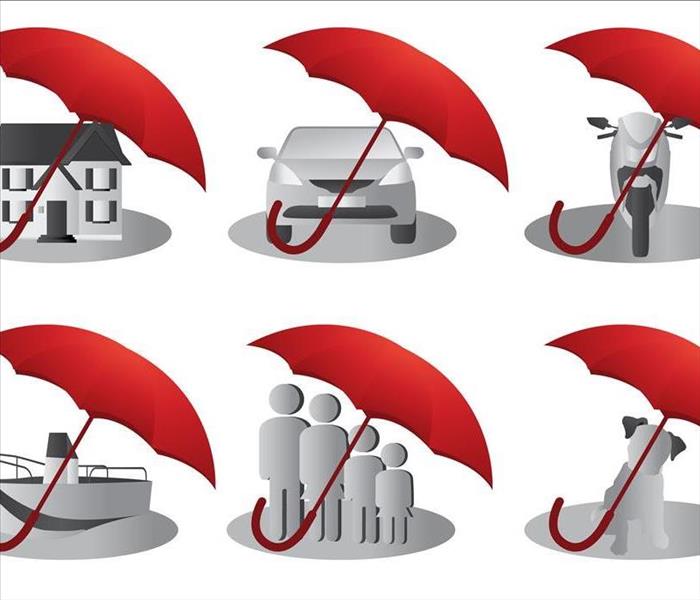 Do not get caught in the rain with out the right coverage will your business survive?
Do not get caught in the rain with out the right coverage will your business survive?
Insurance
We need to take time out from our normal blogs to talk about small businesses and the insurance coverage that many have and what is missing. When businesses call us it is usually because of an emergency situation. Of all the calls we get 50% of businesses will not reopen. Of the ones that do reopen most of them had an emergency plan in place as to how they will respond to the disaster and who to call. These disasters are costly in so many ways, another reason for an inability to reopen is the lack of the proper insurance that will cover all aspects of the business. Business insurance is not just one form of insurance it is an overall assessment of the type of business you do and what risks are involved with that and that area in which you work.
Let us dive into this a little bit more. What is a business, it is your livelihood, the way you provide for your family and its needs. The home that you live in, the food you eat, and the fun things you do together. Beyond just a business, it is your way to make your community better through job creation, solving a need within the area for your products and services. As well as a way of giving back to those less fortunate. Making sure all of these things are protected is important and while many of us look at insurance as scam or a requirement that is never used, talk to someone that has had a major life event and you will see it more than pays for itself with even just one problem.
Most business owners will obtain the lowest amounts of insurance coverage with a high deductable. This is due to the vast scope of the requirements. The main types of insurance required are general liability, Automobile, workers compensation, professional liability, Directors and officers insurance, data breach, home owners, renters, and life insurance. This sounds pretty inclusive right, very very wrong there are a few important insurance policies missing. Crime or Fidelity Insurance and business interruption insurance are very important.
What happens if there is a riot in the area and your business is looted and burned to the ground? Too extreme ok what if your business is robbed? These are crimes and without crime insurance could be your responsibility fully. How much money was taken, how much damage to the property did they cause, were your employees present and what lasting effects will they have from such a traumatic event? Still to unlikely for your business…Ok what about if some kids on a dare break in and graffiti the inside of your facility and leave a mess for you to comb through. Crime or fidelity insurance will protect you from this sort of damage. Of course no one thinks this will happen to them but if it does and a lot of damage is done it can put you quickly out of business.
Business interruption insurance. What is that you ask? Taking more of a look at what we said earlier about your business it is the way you make money. That can only be done when you are open for clients to come and partake in your services or buy your products. Many times a major event such as damage from storm or pipe burst can take more than 30-90 days for you to get back to normal. Do you have enough in reserves for your overhead to be covered for an extended period of time.
Should a major event cause you to close how does your money continue to be generated? How do your employees continue to be paid? Who is going to pay your bills?? If your employees will not be working for an extended period of time and they are a great staff will you lose them? They have bills to still pay and may not be able to afford to wait around for things to settle down. Business interruption insurance allocates for all of these things.
Businesses Owners Policy packages tend to have bundled insurance for all of your needs and can be customized based on the type of business you have. Bundles tend to save you money and allow for the fullest scope of coverage needed. Speak to your insurance broker today if you are not sure about the adequacy of the coverage you currently have. Being prepared is more than just having a plan, and knowing what to do. It is having everything in place and having the proper coverage before you need it.
Overdoses, Violent crimes, People passing away and Suicide
11/1/2016 (Permalink)
 Crime scene clean up is an essential part of life these days and making sure the area properly cleaned is pivotal.
Crime scene clean up is an essential part of life these days and making sure the area properly cleaned is pivotal.
When tragic events happen in and around your home it is never pleasant and very hard to emotionally recover from. These are never high on the list for topics of conversation and many feel isolated with the stigma associated with some of them. They are however a very real scenes for far too many people in the area. We want everyone to know we too are sensitive to these issues and can help your home get back to normal as quickly as possible .
When someone passes away in a home there is so much sadness it can be hard to see past the loss. However when you realize that you are here and must begin to heal, there is a lot of work that needs to be done. Many times there is a lot of clean up that occurs. Death of a family member can be a very messy process as many muscles relax that were holding in a variety of fluids. There may also be a great deal of items that need to be disposed of. Ease the process by hiring a professional cleaning service. They have the chemicals and the proper knowledge of handling of any potentially contaminated materials.
Sadly in East Boston, Chelsea, Charlestown, Revere and Winthrop area we see daily overdoses and suicides on the rise. These overdoses are never pretty and come with a lot of vomit, urine, feces, many times blood and feces. All of these materials are very hazardous and it is not recommended that you clean them up yourself. Getting help right away is very important and can save lives. We always encourage that if you see something say something. You never know the life you may save. That being said once the ambulance has gone there will still be a big mess to clean up. Do not touch any of the bodily fluids without protective gloves, face masks, goggles and a suit if possible. Is it highly recommended that you call a professional as there are a lot of germs that you cannot see that are not killed with things like bleach and other consumer grade cleaners.
Another thing that sadly occurs in this area, are a lot of violent crimes. These crimes could be domestic disputes or could result from an argument at a party. No matter their reason there is a great deal of damage that can occur. Items within the home could be broken beyond salvation. Injured people could have moved to various rooms within the home trying to stay safe. This can result in a very large clean up project coupled with some bodily fluids that need to be handled with care. Once the police have conducted their investigation and released the scene. Please make sure you call a professional who is capable a full rounded cleaning and disposal of any of the residual effects of the problem. Have a restored home can do wonders on the healing from any traumatic events that may occur.
Remembering that you are not alone when there is a traumatic event in your life is paramount to healing and moving forward. We will be here for you through the tough times and help you where we can. Creating a community of support and developing strong bonds with our neighbors will hopefully begin to reduce the number of overdoses, domestic disturbances, violent crimes and deaths that occur. Until then one home at the time is our mission to restore and hopefully rejuvenate the community.
Holidays and Fire damage
10/27/2016 (Permalink)
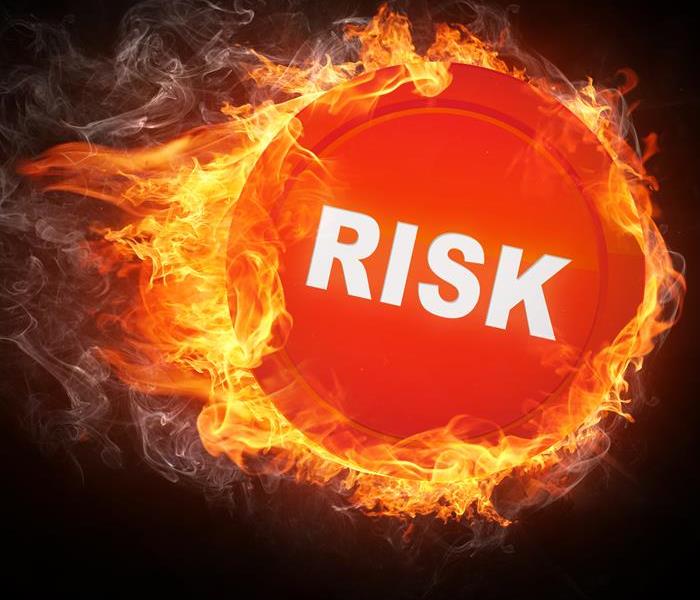 Fires increase during the holiday season. Know how to keep your family safe
Fires increase during the holiday season. Know how to keep your family safe
HOLIDAY HOME FIRES
Fast Facts
Nearly 47,000 fires occur during the winter holidays claiming more than 500 lives, causing more than 2,200 injuries, and costing $554 million in property damage.**
On average, one of every 22 home fires started by Christmas trees result in death.***
Candle fires are four times as likely to occur during the winter holidays.**
During the winter holiday season, an average of 40 home fires per day are caused by children playing.**
The number of home fires the American Red Cross has responded to has risen 10% since 2000.*
Having a working smoke alarm reduces one’s chances of dying in a fire by nearly half.**
Preparedness Tips
Place Christmas trees, candles, and other holiday decorations at least three feet away from heat sources like fireplaces, portable heaters, radiators, heat vents and candles.
Purchase flame retardant metallic or artificial trees. If you purchase a real tree, make sure that it
has fresh, green needles that aren’t easily broken. Keep live trees as moist as possible by giving them plenty of water.
Make sure that light strings and other holiday decorations are in good condition. Do not use anything with frayed electrical cords and always follow the manufacturer’s instructions.
Always unplug tree and holiday lights before leaving home or going to bed.
Never use lit candles to decorate a tree. Always extinguish candles before leaving the room or going to bed.
Use only sturdy tree stands designed not to tip over. Keep curious pets and children away from Christmas trees.
Keep anything that can catch on fire—pot holders, oven mitts, wooden utensils, paper or plastic bags, food packaging, and towels or curtains—away from your stove top.
Designate one person to walk around your home to make sure that all candles and smoking materials are properly extinguished after guests leave.
Smoke alarms save lives. Install a smoke alarm near your kitchen, on each level of your home,
near sleeping areas, and inside and outside bedrooms if you sleep with doors closed. Use the
test button to check it each month. Replace all batteries at least once a year.
Visit www.redcross.org/homefires for more information on how to keep your home fire safe during the holidays.
Sources: American Red Cross,* U.S. Fire Administration,** and the National Fire Protection Association.***
Fire Safety and why you should care !!!
10/11/2016 (Permalink)
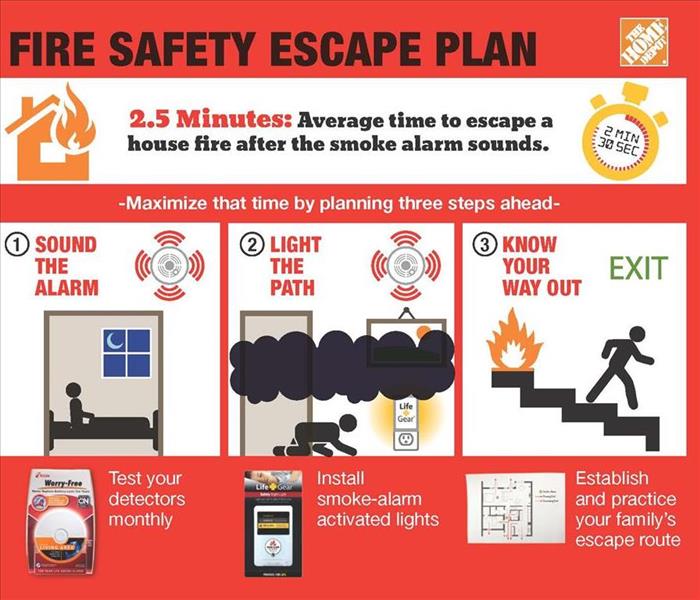 Having an escape plan for when a fire breaks out is important. Being prepared will make all the difference
Having an escape plan for when a fire breaks out is important. Being prepared will make all the difference
According to statistical data from the National Fire Protection Association (NFPA) in 2012 an estimated 1,375,500 fires were responded to in the United States. These blazes caused 2,855 deaths and 16,500 civilian injuries while costing more than $12.4 billion in damage.
Though some fires are unavoidable acts of nature or unpredictable accidents, many fires in the home and workplace are avoidable. The following tips, courtesy of the NFPA, can help reduce the likelihood of a fire in your business or home.
- Watch your cooking- Stay in the kitchen if you are frying, grilling or broiling food. Never allow young children around the stove or oven, especially if they are not closely attended.
- Give space heaters space- Keep space heaters at least three feet from anything that can burn
- Smoke outside- If you must smoke inside, have a sturdy, deep ashtray. Never smoke in bed
- Keep Matched and lighters out of reach- Keep matches and lighters in high cabinets, preferably under a child lock
- Inspect electrical cords- Replace cords that are cracked, damaged, have broken plugs or have loose connections.
- Be careful when using candles- Keep candles at least one foot from anything that can burn. Blow them out before you leave the room or go to sleep.
- Have a fire escape plan-Make a fire escape plan and practice it at least twice a year.
- Install smoke alarms- Install alarms on every level of your office or home and inside bedrooms. Interconnect them so they will all sound at once
- Test smoke alarms- Test alarms once per month. Replace batteries once per year as needed.
- Install sprinklers- Sprinklers can help maintain and sometimes even extinguish fires, giving your local fire department a better chance at saving your property.
Fire escape planning tips
Below you will find several tips that could potentially save your life or the life of a loved one should a fire break out in your home
- Install a smoke alarm on every level of your home
- Test smoke alarm batteries every month and change them at least ones a year.
- Consider installing a 10 year lithium battery powered smoke alarm
- Practice finding your way out of the house with your eyes closed, crawling or staying low and feeling your way out of the house.
- Remember escape first, then notify the fire department.
- **Tips courtesy of www.usfa.dhs.gov**
What to do until help arrives.
Do:
- Limit movement in the home to prevent soot particles from spreading and additional damage from occurring.
- Place clean towels or old linens in rugs and high traffic areas and upholstery
- Coat chrome faucets, trim and appliances with petroleum jelly or oil
- Place Aluminum foil or wood blocks between furniture legs and wet carpet.
Do Not:
- Wash any walls or painted surfaces.
- Shampoo carpet or upholstery
- Clean any electrical equipment.
- Send Clothing to dry cleaner since improper cleaning may set smoke odor.
Tips to help prevent a fire
10/4/2016 (Permalink)
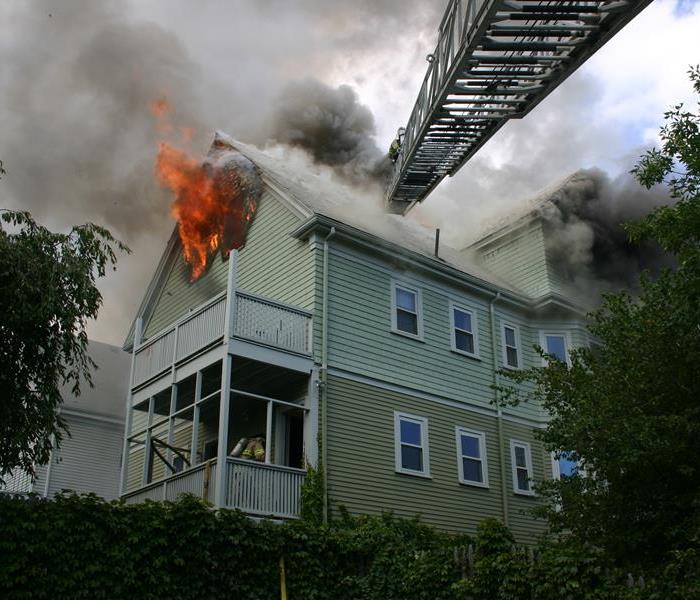 Fires in a home can quickly become out of control it is important to get out everyone out of the home rather than try and fight it yourself.
Fires in a home can quickly become out of control it is important to get out everyone out of the home rather than try and fight it yourself.
Getting out of the house is the most important thing to do when a fire breaks out. Time is not on your side. Having a plan, mapping escape routes, and doing practice scenarios can save your life. Make sure you call 911 as soon as possible, preferrably once you are outside. Have a central meeting point for your entire family a safe distance away from your home. Our partnership with the American Red Cross is to ensure you are prepared for anything, including fires.
Our friends at the National Fire Protection Association have some very interresting facts about fires we think you should know. You can always visit their website for this and other important information about fires at the following.
http://www.nfpa.org/public-education/campaigns/fire-prevention-week/fast-facts-about-fire
Home fires
- Half of home fire deaths result from fires reported between 11 p.m. and 7 a.m. when most people are asleep. Only one in five home fires were reported during these hours.
- One quarter of home fire deaths were caused by fires that started in the bedroom. Another quarter resulted from fires in the living room, family room or den.
- Three out of five home fire deaths happen from fires in homes with no smoke alarms or no working smoke alarms.
- In 2014, U.S. fire departments responded to an estimated 367,500 home structure fires. These fires caused 2,745 deaths, 11,825 civilian injuries, and $6.8 billion in direct damage.
- On average, seven people die in U.S. home fires per day.
- Cooking equipment is the leading cause of home fire injuries, followed by heating equipment.
- Smoking materials are the leading cause of home fire deaths.
- Most fatal fires kill one or two people. In 2014, 15 home fires killed five or more people resulting in a total of 88 deaths.
- During 2009-2013, roughly one of every 335 households had a reported home fire per year.
- Smoke alarms
- Three out of five home fire deaths in 2009-2013 were caused by fires in homes with no smoke alarms or no working smoke alarms.
- Working smoke alarms cut the risk of dying in reported home fires in half.
- In fires considered large enough to activate the smoke alarm, hardwired alarms operated 94% of the time, while battery powered alarms operated 80% of the time.
- When smoke alarms fail to operate, it is usually because batteries are missing, disconnected, or dead.
- An ionization smoke alarm is generally more responsive to flaming fires and a photoelectric smoke alarm is generally more responsive to smoldering fires. For the best protection, or where extra time is needed to awaken or assist others, both types of alarms, or combination ionization and photoelectric alarms are recommended.
- Escape planning
- According to an NFPA survey, only one-third of Americans have both developed and practiced a home fire escape plan.
- Almost three-quarters of Americans do have an escape plan; however, more than half never practiced it.
- One-third of survey respondents who made an estimate thought they would have at least 6 minutes before a fire in their home would become life threatening. The time available is often less. Only 8% said their first thought on hearing a smoke alarm would be to get out!
- Cooking
- U.S. fire departments responded to an estimated annual average of 162,400 cooking-related fires between 2009-2013 resulting in 430 civilian deaths, 5,400 civilian injuries and 1.1 billion in direct damage.
- Two of every five home fires started in the kitchen.
- Unattended cooking was a factor in one-third of reported home cooking fires.
- Two-thirds of home cooking fires started with ignition of food or other cooking materials.
- Ranges accounted for three of every five (61%) home cooking fire incidents. Ovens accounted for 13%.
- Children under five face a higher risk of non-fire burns associated with cooking and hot food and drinks than of being hurt in a cooking fire.
- Children under five accounted for 30% of the 4,300 microwave oven scald burns seen in hospital emergency rooms during 2014.
- Clothing was the item first ignited in less than 1% of home cooking fires, but these incidents accounted for 18% of the cooking fire deaths.
- More than half of people injured in home fires involving cooking equipment were hurt while attempting to fight the fire themselves.
- Frying is the leading activity associated with cooking fires.
- Heating
- The leading factor contributing to heating equipment fires was failure to clean. This usually involved creosote build-up in chimneys.
- Portable or fixed space heaters, including wood stoves, were involved in one-third (33%) of home heating fires and four out of five (81%) home heating deaths.
- Just over half of home heating fire deaths resulted from fires caused by heating equipment too close to things that can burn, such as upholstered furniture, clothing, mattresses or bedding.
- In most years, heating equipment is the second leading cause of home fires, fire deaths, and fire injuries.
- Once you are safe, the fire is out, and the emergency services are gone, what happens next? You have to focus on the clean up and getting back to normal. There is a lot more into cleaning up after a fire than you can imagine. Knowing who can work with fire restoration to get your home back to normal is so important. They must know how to get the smoke odor removed, what to remove that is not salvageable along with what can be saved.
- Here is to keeping you happy, healthy and safe as we approach the holiday season..
Tips to help prevent freezing pipes
9/29/2016 (Permalink)
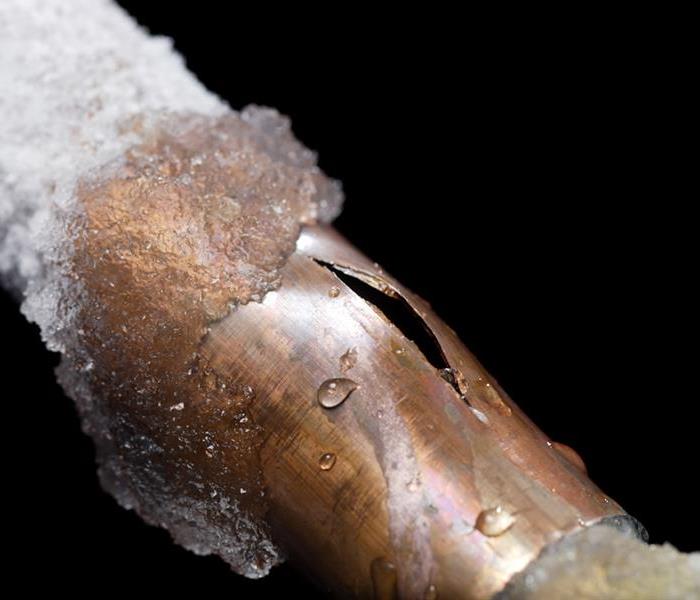 A tiny break like this can cause thousands of dollars of damage. Especially if you are away when it happens.
A tiny break like this can cause thousands of dollars of damage. Especially if you are away when it happens.
Accuweather is predicting a long winter with cold and snowy conditions late into the spring of 2017. They are even warning the citrus crops will be in danger. Now is the time to prepare yourself and your home for this forecast. Being prepared can mean the difference between turning on your water and having your water turn on you.
There are many cases the pipe insulation is not worth it, the time and effort is not worth it. You must consider the value beyond the initial dollar. If you forgo this step and we have excessive cold they have an increased chance of freezing and bursting. A broken pipe can cause 10’s of thousands of dollars worth of damage. The time effort and stress can be overwhelming.
Pipes freezing and breaking is our number one call is the winter. While we are always here to help with any water damage you may incur, ideally we would like to show you how to help prevent it. This is not a very difficult project nor is it overly time consuming. It can also serve two purpose one to keep your pipes from freezing and two will hold in the heat better and reduce energy consumption by 3 to 4% a year. Every little bit helps.
How to protect from pipes freezing this winter.
Select the best wrap for the job. Polyethylene or neoprene foams or fiberglass tend to be the easiest and most cost effective. This will typically cost 10-15 for a smaller home and go up a little based on the size of the house. You must look at the size and length of the pipes that you will be covering. Please note if choosing the fiberglass option gloves are advised. When working with the pipes make sure you stay at least 6 to 8 inches away from the flue. Place the insulation seam side down and secure with duct tape or wire. That is pretty much it.
Be safe Be Prepared……
Fall is the time to De-Clutter
9/13/2016 (Permalink)
 Breath in the crisp air of fall and open space in you home
Breath in the crisp air of fall and open space in you home
We have all heard of Spring cleaning and while it is nice to open the windows let the air circulate and remove the cobwebs of winter, But a fall cleaning???? The leaves are starting to fall, the weather has turned cooler and gone are blistering days in the sun. So what do you.. You De-clutter of course!!! Fall is not just for yard debris and leave raking. The fall is a perfect time to de-clutter, Why?
We are so glad that you asked. Attics and basements have started to cool off making it more manageable to get things done. With the holidays coming up organizing what you have to make the holidays less chaotic. If you have less stuff there is less cleaning that needs to be done daily and there is less to worry about.
Just like any project it is important to not get overwhelmed and stay organized. Take it one room or section at a time. Create an area where you can set up 4 sections to create a donate, sell, keep and trash pile. Make sure you are prepared to have a yard sale and once it is over everything that did not sell will not become donate or trash.
Making decisions can be daunting especially if money has been spent on a item. A good rule of thumb for many items is have you used it in the last 3-6 months, if it is not holiday or seasonal items and the answer is no chances are you do not really need it. With clothing if it does not fit, or in your eyes is out of style and you just will not wear it let it go.
Once you have gone through everything tackle the pile of trash, call a company that does junk removal . This will allow you to free up space immediately so you can sort through the sell pile. Organize and price the items you want to sell. A few noteworthy bits of advice, once you set the date for the yard sale call a donation company to come within the week following the yard sale so you do not delay the process. It is always advisable to keep your donation pile until after the yard sale so that they only have to come out once. Many places will come out for free so do your research and check out the dates that they have available try and coordinate your yard sale within the same week.
Your keep pile will be the last pile you put away as you could change your mind as you go and will not have the best view of how much space you have until the rest of the stuff is gone. Once you are done and have only the keep pile you can best assess where to put it all. However there are still steps to take before you put it all away.
The next phase is cleaning and no I do not mean sweeping the room. A good solid deep clean washing ceilings, walls light fixtures, switches, fans, floors anything in the room and yes you should move any remaining furniture and clean all around it. Windows and window sills are often overlooked but are as important to the total cleaning process. If this is too daunting or time consuming many companies are out there that can take care of this for you. While some companies come weekly there are companies out there that will do a once over from time to time, such as SERVPRO’s.
If you are starting to feel overwhelmed already its fine breathe look at one room make a checklist and start organizing your piles. You will be amazed at what happens when you get going.. Happy fall and say tuned for our next update.
National Prepardness Month
9/1/2016 (Permalink)
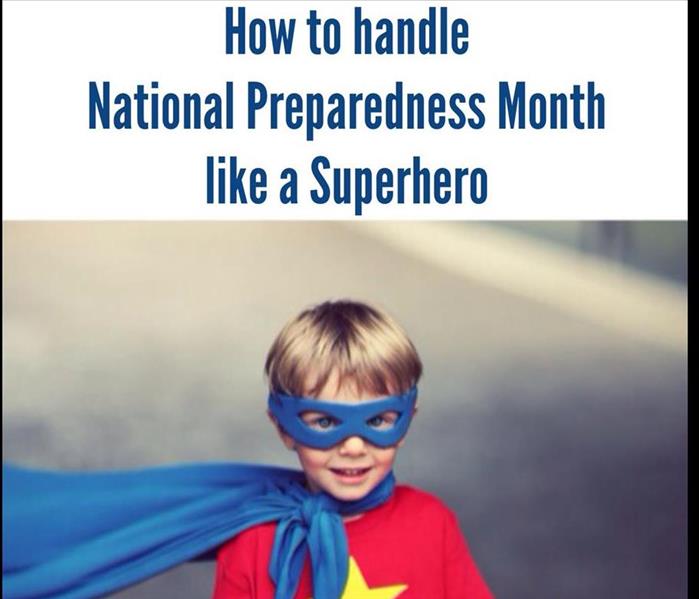 Be a leader and superhero to your community, Prepare for anything .. and share your ideas with others
Be a leader and superhero to your community, Prepare for anything .. and share your ideas with others
Extreme weather seems to be all around us and daily we turn on the news and there is another story of disaster striking. Tornados in the middle of the country, flooding in the south, drought in the western part of the state and the extremes seems to be becoming more frequent and more predominant than ever.
Did you know there is a website called Weather Ready Nation where you can find all sorts of information on global weather, how to be prepared and prevent problems during extreme weather. http://www.nws.noaa.gov/com/weatherreadynation/
Below you can find a list of some basic information that you can use to get you started.
What can you do to prepare for a disaster and where can you find the information for your area.
What can you do?
First and most important thing to know is what every emergency is different having a plan of action for how to respond is pivotal in recovery. Some of these emergencies can take place and cause days, weeks or months of recovery time. Understanding the area that you live in and its susceptibility to specific types of disasters can go a long ways. For example when you live in the middle of the united states it is important to know about tornados, when the season is at its peak and know how to stay safe during an actual tornado. Floridians especially need to know how to remain safe during a hurricane. That is not to say that these events do not happen outside of these areas but they are more prone to them than other areas of the country.
What do you need
It is also very wise to stock pile specific items that, many times can be overlooked in an emergency. Having an up to date emergency supply kit, an emergency family plan and access to news and weather updates will be key to easing the process.
Your emergency supply kit should contain some key essentials. Such as 3 days of food and water per person. The amount of water that you should have on hand should be one gallon per person per day for those 3 days. Radios and flashlights should always be battery operated and extra batteries should be included within the supply kit. A fully stocked first aid kit with no expired medicines should also be on hand, if you take your own personal medications it is always advisable to set 3 days worth aside within this kit to ensure you have what you need. ( Remember to rotate out the medicines over time to make sure nothing is expired). Wet naps, dust masks, plastic bags and plastic wrap with tape can help keep things sanitary and help prevent illness from contamination. Some tools are essential have either pliers or a wrench to turn off water valves or other utilities, manual can openers and maps will also be useful to have on hand. Cell phone are pivotal but maintaining a charge for days on end can be a challenge look into solar options for your type of phone. There are other essentials if you have pets it is important to take their needs into account when you are getting your emergency kit ready Please visit www.ready.gove/kit for more ideas
A Plan
You also need a plan to make sure that everyone will be able find each other should you all be away from the home at the time an issue arises. Having a central meeting point, and a means of free flowing communication to verify that everyone is safe will remove a great deal of stress from an already stressful situation. Talking about it is not enough though make sure it is written down and everyone has a copy they are able to keep with them.
Share your plan..
We all talk and communicate with others daily via various forms of social media and technology. Sharing with them your plan could encourage them to get one together for their family and just might make the difference. Show them images of your kits, where you found your information and what you are doing to try and make sure your ready.
Sewage Damage is on the rise
8/24/2016 (Permalink)
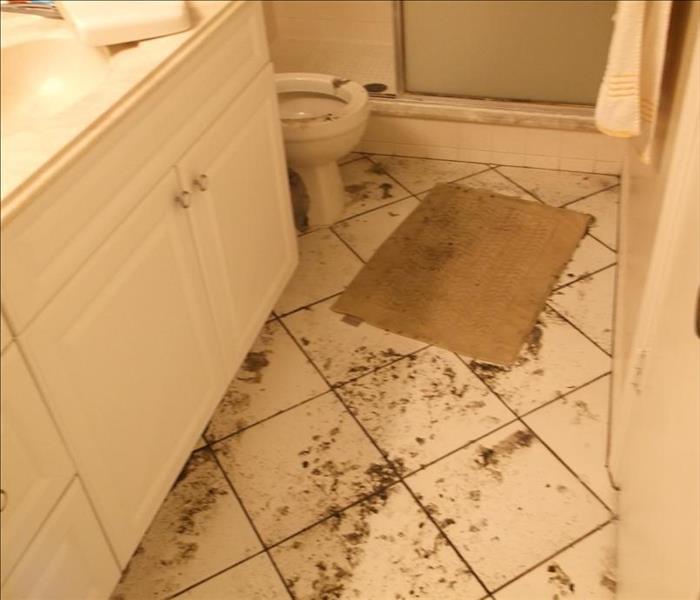 Sewage damage is not something you should clean up yourself. It is contaminated and dangerous
Sewage damage is not something you should clean up yourself. It is contaminated and dangerous
Sewage back ups and sewage damage is becoming a big problem. We are seeing a lot of homes and businesses damaged by sewage. This article with provide you with some key ways to hopefully prevent any such damage to your property.
Many people think that all sewage backups are the cities responsibility if they have a public system. This is simply not the case. The city is responsible for the main sewage line and the homeowner or property owner is responsible for the anything that happens from that main line to the property.
Sewage damage can be a major expense as there is quite a bit of contamination involved. They can cause severe health risks, and property damage. Making sure you have sewage damage within your insurance property is the best way to protect your investment. Review your policy to make sure it is available. If it is not on your policy please contact your agent and discuss having it added.
That being said there are some preventative steps that can be taken to help keep you protected and help prevent a sewage backup to begin with. Ok so knowing what the main causes of a backup are is the key to prevention. Tree roots and grease poured down the drains are the key reasons a back up occurs.
Grease you say!!! But it is a liquid.. Sure it is a liquid when it was hot off the stove from cooking your morning bacon but before that at room temperature or colder if coming out of the refrigerator it was solid. When you pour it down the drain and it cools it hardens and attached to the sides of the drain limiting the flow of water. Eventually over time it will continue to build up and fully block the drain and depending on where that occurs can involve your sewage. Fun right.. So take all that grease dump it into a can and make sure that you wait for it to solidify and toss it out in the trash. Every little bit will help.
Tree roots!!! But it is a solid pipe how could that happen. Lets explore that a bit. Have you ever tripped over a raised sidewalk? Most likely it is raised because of a tree root pushing its way underneath the concrete. Roots are very intrusive and can make their way through the metal and once inside are provided with a great deal of nutrients and water they will grow and expand down the pipe and eventually clog the pipe and trap debris to the point a back up will occur. When you are landscaping your yard know where the pipes run under your property and plant away from them to help prevent roots from taking hold in the lines.
Making sure that the debris that is put into the drains is easily bio-degradable such toilet paper only is key to keeping the flow moving as well. Items larger or more dense that do not break down quickly should be thrown away with the regular trash. It is especially important to keep plastic bags, paper towels, diapers, washcloths, and towels out of the drains at all times. Many times it is kids not knowing or attemting to see what will happen when something larger goes down the drain. It is important to teach children to not put these things down drains. It is also important to remember these are not items for a drain due to their bulky nature. Convenience now can result in big problems later.
Storm drains can sometimes be connected to sewer lines and when there are storms it is possible the water will exceed the capacity of the drain and force backups to occur. If you discover a sewer problem in your home it is important to call your local city water department immediately unless you are 100% sure that the problem is coming from the part of the sewer lines that are your responsibility. It is also very important to stay away from the water and do not touch anything that the water has come into contact with it will be very contaminated. Do not walk through it if at all possible and it is not to be played in. Turn off all of your water sources at a main valve if possible and make your second phone call to a remediation company that can help get your home back to normal. Sewage damage is not something that you should try and clean up yourself it is too hazardous.
Water quality can change quickly
8/17/2016 (Permalink)
 Water quality and safety can change in the matter of one day. Improper knowledge of chemical mixures and their effect is pivotal.
Water quality and safety can change in the matter of one day. Improper knowledge of chemical mixures and their effect is pivotal.
Water with chemical imbalances can be a huge problem just ask the Rio Olympic committee. The first week of the Olympics two of the pools turns a mucky colored green and then began to smell up the arena. This is a huge problem for the athletes that were competing because the algae bloom could cause potential health risks along with affecting their ability to perform. Synchronized swimming for example relies on all members of a team being able to see each other underwater, impossible to do with unclear water.
The main issue was, not understanding how various chemical combinations affect one another. Chlorine was originally used in the pools which is a great way to neutralize algae. The testing for the proper levels was conducted and all showed they were being maintained at proper levels. Introduce here the hydrogen peroxide, and before you say it yes you can uses hydrogen peroxide to maintain a pool. The problem lies in the combination of the two. Hydrogen peroxide neutralizes the effect of the chlorine. That leaves room for algae to thrive and created the problem.
Understanding basic chemicals and the effect when combined with others can not only save you a lot of work could potentially save your life. Chemicals do not always mean man made either. Something seemingly innocuous as vinegar can be deadly if combined with bleach the fumes can kill you. Ammonia and bleach can result in very similar gases and even produce chemical burns if inhaled. Did you know rubbing alcohol and bleach can damage your nervous system eyes liver and more?
Those are just a few examples there are even examples of chemicals that are found within the foods that we eat that when combined can be dangerous. Energy drinks for example when combined with milk can cause vomiting and severe stomach aches. Milk will also even reduce the effectiveness of antibiotics on your system. Grapefruits interact with many medications resulting in death. When on blood thinners many vitamin K enriched foods can alter the way that they work. WE are not doctors nor do we pretend to be. Always discuss any changed with a professional and if you are ever questioning how you feel seek help immediately.
It is important to question any chemical mixture before you do so. It is pivotal to keeping you safe. Dirty water in your home can change just as quickly with the absence or presence of just one speck of bacteria or one wrong chemical introduction. Please make sure if you ever have a question a professional is called and consulted.
Not all graffiti is created equal..
8/4/2016 (Permalink)
 A graffiti mural is very different than graffiti damage..
A graffiti mural is very different than graffiti damage..
Victim of Graffiti or Vandalism?? Here is what you can do
Has your home or business become the victim of a vandalism or graffiti? This is never a pleasant situation and can be difficult to remove. One very important part of the process is removing it as quickly as possible. The less time the graffiti is up the less likely it will continue to happen as it is meant to be seen and can also attract others to use your property, a battle ground of sorts. Also with the materials that are used the sooner they are removed the better as many can take time to set into the material they were sprayed on. Keep in mind graffiti is never easy to remove and will require some patience and elbow grease.
Prevention is ideal. What you can do.
Motion sensor lights
Covering your property with a protective coating that will prevent sticking on some materials
Securing the property with fences or structures that will block access to the building
Use darker colors for painting outside this will deter due to visibility issues
Participate in Neighborhood watch groups.
Plant taller shrubs, climbing vines, or thorny plants on the edges of the property
Use graffiti art or murals to deter other unwanted artists.
Should you still become a victim of graffiti here are some tips for removing it. Depending on the scope of the damage, location, and material the damage is on you may need to hire a professional cleaning company. No matter if you hire someone or do the work yourself knowing the material it is on an the proper way to remove it will make things go more smoothly. Also we cannot stress enough that you have 24-72 hours to remove the damage or things get more complicated. There are environmentally safe products that you can use to remove the damage and it is always recommended to use those. There are options at times to paint over the damage but making sure you the right paint so that the graffiti will not seep through the paint and continue to show. Some communities even have volunteer programs to help with such problems as part of community beautification. They may be able to help. Before you do any work lets talk about the best ways to clean off from some of the main materials.
Removing Graffiti on Specific Surface Types
The first thing you need to do is figure out how porous the surface is. The more porous the surface the longer you will need to let the cleaner sit for it to soak into the area. While the cleaner is soaking into the materials it is advised that you scrub it to ensure a deep penetration. This can be done with a strong bristled brush or hand held scrub pad.
For some jobs you will need a power washer even to mix in the cleaner with the water to deeply penetrate the area. Always test a small spot for color fastness as well to ensure it is compatible with the surface and that you are using it for its intended purpose. If you are going to paint over the affected area make sure that the color will match the rest of the building once dry and that it is thick enough to not allow the graffiti to bleed through. Making sure you are being safe and have the taken all precautionary steps prior to starting work is important. This will protect you, the building and the environment.
Glass Surfaces:
Scrape it off. Use a razor blade in a holder and scrape at a 30 degree angle to the glass.
If the paint does not come off completely after using the razor blade, use ultra-fine bronze wool with water to gently rub the remaining paint off.
Metal and masonry surfaces:
Power-wash with a pressure washerPaint over the graffitiPlastic Surfaces:
Try wiping it off with a light, penetrating oil. Do not use paint thinners as they can soften the plastic and can cause clouding (if clear plastic) or permanent tackiness of the surface.
If this does not work, you will have to paint over it.
Wood Surfaces:
If the wood is not weathered and is sealed with paint, stain or sealer, remove it by wiping it with mineral spirits
Power wash it with a pressure washer
We hope you never need to use these tips but in case you do we hope they were helpful. Remember help is only a phone call away.
Fires and summer safety
7/27/2016 (Permalink)
 Summers are a great time to tell stories and gather around a campfire or have cook out but these actvities all involve fire.Staying safe is important
Summers are a great time to tell stories and gather around a campfire or have cook out but these actvities all involve fire.Staying safe is important
Fires and summer safety
Did you know that summer is one of the most dangerous times for fires. With all of the recent fires in the area we thought we would use this time to educate you on how you can stay safe this summer while still having a great time. For those of you who do not know we are on the border of a severe drought in MA.
A number of towns have already imposed mandatory water restrictions with many asking the public to adhere to voluntary ones. We have provided you with a link to check and see what your town is asking of you.
http://www.mass.gov/eea/agencies/massdep/water/watersheds/municipal-water-use-restrictions.html
Typically water restrictions limit the use of water outside the home, meaning no lawn and flower watering, car washing, power washing sidewalks or siding on homes just to name a few. That being said these restrictions are to ensure everyone has water for drinking and bathing please adhere to them and do you part.
But water restrictions also mean there is a lack of rain fall. This lack of water has severe implications and does increase the fire risk. It is important to know ways you can help not only conserve water but reduce the risk of fire. With everything being so dry it does not take much for fire to get out of control. Please see the tips below to keep your summer fun and safe for everyone.
Camping is fun
Smores over a campfire is a great childhood memory but fire safety is very important especially during a drought. Below you will find some key points to keep you safe. If you'll be spending the summer camping or just toasting marshmallows in the back yard, it's a good idea to educate yourself about campfire safety. Keep the following tips in mind.
Rules Rules RulesFollow Area Rules
Campsites always have posted rules based on the area, season and local conditions. Be aware of what they are and know there is a reason they exist. Some times these rules will have fire bans or strict burning regulations so always check the regulations before you start the fire.
You can catch fire too
Embers from fires can land on clothing, causing them to catch on fire. Knowing the old adage stop drop and roll is important. Role playing is an important way to make sure everyone in the family knows how to put this sort of fire out. Practice will prevent panic.
Where to set up the fire
The spot you choose to set up your fire is vital for your safety. Making sure there is no loose brush such as leaves, grass, or underbrush and if there is clear it away first. It is also advisable to steer clear of overhanging branches. It is best to dig a pit to set up the fire in and surround it with rocks. These rocks create a barrier for debris as well as shields the fire from wind helping contain embers. .
Flammable materials
Guess what fluids like gas, lighter fluid and charcoal is flammable. Keep these items a safe distance away from the open flames and fire pit itself as stray flames can ignite them. Please Please Please keep your tent away from the fire. Being zippered into something on fire is never a good thing. It is advisable to buy a tent with a flame retardant material.
Bonfires Keep It Under Control
Large bonfires are great and the roar of the flames the good times as we gather around them but can easily become uncontrollable. Make sure you are able to manage the size of the fire and have all the safety equipment to douse any flames. Smaller fires are much more manageable and can be just as fun knowing everyone is safe.
Do not leave fire unattended.
Rule of thumb never ever leave a fire unattended last to bed extinguishes the fire. Dousing the flames and embers with water is not enough you must stir them and douse them again. This should be done several times until you are sure that it is safe and no lose embers will blow away. Keeping plenty of water or a fire extinguisher is always a good idea anytime you will near a fire. A shovel is just as important allowing you to extinguish areas that may get out of the main fire area.
Fire Safety Tips for Summer Travel
Source
Summer is a great time to take a road trip or go camping, but it's smart to stay away of fire safety on your trip. Keep these tips in mind.
Where to stay
Vacation is here, fire safety is very important and should be on your mind. Ensure where ever you stay has the proper fire safety equipment, smoke detectors, and sprinkler systems. It is a good idea to know where the emergency exits are and review the posted escape plan. They should also have a safety check list provided to you it is a good idea to review this as well. If these are missing choosing another location is best for you and your family.Many of us while on vacation will visit new sites and locations . It is vital to know know where all exits are located. Taking a few moments can make the world of difference. Should a fire or other emergency situation break out knowing how to evacuate is vital.
Do your part NEVER Throw Lit Cigarettes out of the Car
Never throw a lit cigarette, match, or cigar out of a car window or onto the ground. It could ignite dry vegetation or even in rare circumstances, ignite fumes from your vehicle.
Fireworks Safety
Its that times of the year the bright colors and the gathering to look up at the sky at night through the roar of the fireworks. This is a very real safety concern in the summer especially during a state of drought. Please make sure you are careful to familiarize yourself with fireworks safety tips provided by the United States Fire Safety Administration
Grill safety tips.
Outdoor grilling is great we love it just as much as everyone else but you must stay safe no matter what sort of grilling you plan on doing. See our earlier blog posts on our website about grilling safety tips. So that you can have a safe delicious time.
Your home and wildfires
Many parts of the US and Canada ( yes that massive fire is still burning) have fallen victim to a wild fire this summer. Natural disasters do not always involve tornados or water. Our friends at Federal Emergency Management Agency (FEMA) have to ways to keep you safe and updated with emergencies. Fires move quickly and time is of the essence if you have to evacuate. Preparedness is our mantra and these situations are no difference..
Making a plan
Map out an escape route from the home and a central meeting point along with a route you will take in your car along with a central meeting point should members of your home be away at the time of the evacuation. Make sure you have each access to the plan.
Emergency kit
Evacuation means you have to have at least 3 days worth of food and water. Ensure that the food is easy to open but will also last without refrigeration. Compile a supply of medicines and medical supplies such as band aids, ointments, and bandages. Store this in a convenient place that is easily accessible.
Created a buffer zone
Remove all yard loose debris such as leaves, sticks, twigs, vines, branches, any firewood, or other flammable materials. Keeping the grass short will ensure that the fuel for flames will be kept at a minimum. Move any oils, gas or combustible liquids as far away as you can get them. Extend this zone as far as you can FEMA recommends 30-100 ft
Mark you home clearly
Make sure your house number is visible from the street so if emergency services need to find the home it is easy for them to do so.
Enjoy the Summer
By knowing and practicing summer fire safety tips, you can enjoy many wonderful times in the great outdoors filled with laughter, happiness and safety.
What to do before help arrives!!!!!
7/19/2016 (Permalink)
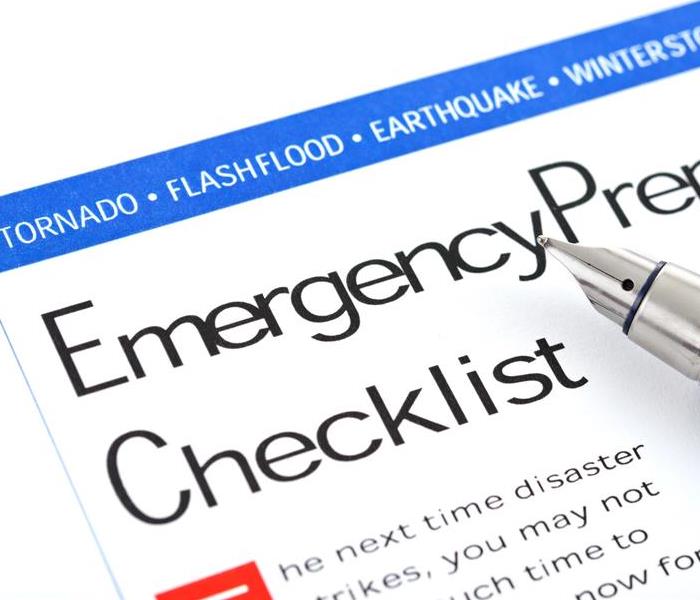 What to do until help arrives after an emergency strikes your home
What to do until help arrives after an emergency strikes your home
FIRE AND SMOKE DAMAGE:
Do:
Limit movement in the home to prevent soot particles from being embedded into upholstery and carpet.
Keep hands clean. Soot on hands can further soil upholstery, walls and woodwork.
Place dry, colorfast towels or old linens on rugs, upholstery and carpet traffic areas.
If electricity is off, empty freezer and refrigerator completely and prop doors open to help prevent odor.
Wipe soot from chrome on kitchen and bathroom faucets, trim and appliances, then protect these surfaces with a light coating of lubricant.
If heat is off during winter, pour RV antifreeze in sinks, toilet bowls, holding tanks and tubs to avoid freezing pipes and fixtures.
Wash both sides of leaves on house plants.
Change HVAC filter, but leave system off until a trained professional can check the system.
Tape double layers of cheesecloth over air registers to stop particles of soot from getting in or out of the HVAC system.
DON’T:
Attempt to wash any walls or painted surfaces without first contacting a professional.
Attempt to shampoo carpet or upholstered furniture without first consulting a professional.
Attempt to clean any electrical appliances (TVsets, radios, etc.) that may have been close to fire, heat or water without first consulting an authorized repair service.
Consume any food or beverages that may have been stored close to fire, heat or water. (They may be contaminated.)
Turn on ceiling fixtures if ceiling is wet. Wiring may be wet or damaged and cause electrical shock, and air movement may create secondary damage.
Send garments to the dry cleaner. Improper cleaning may set in smoke odor.
Water damage from clean water
Do:
Shut off the source of water if possible or contact a qualified party to stop the water source.
Turn off circuit breakers for wet areas of the building, when access to the power distribution panel is safe from electrical shock.
Remove as much excess water as possible by mopping and blotting.
Wipe excess water from wood furniture after removing lamps and tabletop items.
Remove and prop up wet upholstery cushions for even drying.
Place aluminum foil or wood blocks between furniture legs and wet carpeting.
Remove to a safe, dry place any paintings, art objects, computers, documents and other materials that are valuable or sensitive to moisture.
Use wooden clothespins to keep furniture skirting off damp floors.
Hang draperies with coated hangers to avoid contact with wet carpeting or floors.
Hang furs and leather goods to dry separately at room temperature.
DON’T:
Enter rooms with standing water where electrical shock hazards may exist.
Enter affected areas if electrical outlets, switches, circuit breakers or electrical equipment are exposed to water. Always avoid electrical shock hazards.
Leave books, newspapers, magazines or other colored items on wet carpets or floors to cause staining.
Leave Oriental rugs or other colored rugs on wet wall-to-wall carpets to cause staining.
Use your household vacuum cleaner to remove water, possibly causing electrical shock or damage to the vacuum cleaner.
Use TVs or other appliances while standing on wet carpets or floors, especially not on wet concrete floors.
Turn on ceiling fixtures if ceiling is wet or enter rooms where ceilings are sagging from retained water.
Water damage from contaminated water
DO:
Avoid all contact with sewage and items contaminated by sewage.
Wash your hands thoroughly after contact with contaminated items.
DON’T:
Spread contaminated water by walking unnecessarily on damaged or wet areas.
Turn on the HVAC system if there is a possibility of spreading contaminated air.
Use household fans to dry the structure and spread contaminants.
Use products for personal hygiene and cleanliness if exposed to the contaminated areas.
Note: If exposed to harmful waste, OSHA recommends a post-exposure medical evaluation.
Consult your local health department or physician.
Vandalism Damage
DO:
Hose or wash egg damage from building exterior as soon as possible.
Vacuum glass particles from carpets and upholstery.
Save containers which reveal the ingredients of spilled inks, cosmetics and paints.
DON’T:
Attempt to remove ink, paint or cosmetic stains.
Operate damaged lamps or appliances.
Discard furniture wood chips, broken pieces from porcelain, furniture or art objects.
HARMFUL WASTE
DO:
Stay out of affected areas.
Call emergency service personnel if the situation is life-threatening.
Treat all bodily fluids as if they are contaminated.
DON’T:
Attempt cleanup of any kind.
Touch or handle items that might be contaminated with bodily fluids.
Understanding Storms and How to prepare
7/14/2016 (Permalink)
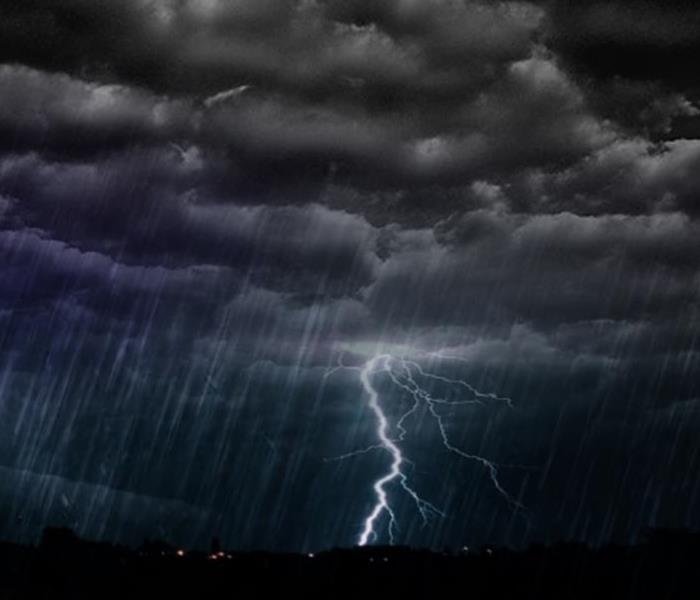 Storms can be very beautiful but dangerous, deadly and powerful,, Understand them respect them and know how to stay safe when they strike
Storms can be very beautiful but dangerous, deadly and powerful,, Understand them respect them and know how to stay safe when they strike
Storm Basics
A thunderstorm is a rain shower during which you hear thunder. Since thunder comes from lightning, all thunderstorms have lightning. It is classified as “severe” when itcontains one or more of the following:
Hail (one inch or greater)
Winds in excess of 58 mph
Structural wind damage
Tornado:
Tornadoes are arguably nature’s most violent storms. Generated from powerful thunderstorms, and generally appear as rotating, funnel-shaped clouds extending from the cloud base to the ground. With winds that can reach up to 300 miles per hour, tornadoes can cause massive destruction within seconds. Damage paths can be in excess of one mile wide and fifty miles long. The average tornado moves southwest to northeast, but tornadoes have been known to move in any direction. The average forward speed of a tornado is 30 miles per hour, but may vary from stationary to 70 miles per hour. Tornadoes can accompany tropical storms and hurricanes as they move onto land. Tornadoes are most frequently reported east of the Rocky Mountains during spring and summer months. Tornadoes are most likely to occur between 3 p.m. and 9 p.m.
Tornado Facts and Storm Tips (above) are provided by FEMA (Federal Emergency Management Agency).
Watch vs. Warning
A severe thunderstorm watch: means that the potential exists for the development of thunderstorms which may produce large hail or damaging winds. A watch is issued by the SPC (Storm Prediction Center).
A severe thunderstorm warning: means that a severe thunderstorm is occurring or is imminent based on Doppler radar information or a reliable spotter report. A warning is issued by the local National Weather Service office.
Watch vs. Warning and Storm Basics are provided by NOAA (National Oceanic and Atmospheric Administration). For more information visit their website: www.noaa.gov
Be prepared!! Emergency Supply Kit
Recommended items to include in a basic emergency supply kit:
Water (one gallon per person per day)
Food (non-perishable 3-day supply)
Manual can opener
Battery operated radio, preferably a NOAA Weather Radio with tone alert and extra batteries
Flashlight and extra batteries
First aid kit
Whistle to signal for help
Clothing
Dust masks or bandanas
Plastic sheeting, garbage bags and duct tape
Wrench or pliers to turn off utilities
Local maps
Hygiene items
Important documents such as copies of insurance policies, identification and bank account information
Cash
Fire extinguisher
Matches in a waterproof container
Before the storm
To begin preparing, you should build an emergency supply kit and make a family communication plan.
Remove dead or rotting trees and branches that could fall and cause injury or damage during a severe thunderstorm.
Postpone outdoor activities.
Remember the 30/30 Lightning Safety Rule: Go indoors if, after seeing lightning, you cannot count to 30 before hearing thunder. Stay indoors for 30 minutes after hearing the last clap of thunder.
Secure outdoor objects that could blow away or cause damage.
Get inside a home, building, or hard top automobile (not a convertible). Although you may be injured if lightning strikes your car, you are much safer inside a vehicle than outside.
Remember, rubber-soled shoes and rubber tires provide NO protection from lightning. However, the steel frame of a hard-topped vehicle provides increased protection if you are not touching metal.
Shutter windows and secure outside doors. If shutters are not available, close window blinds, shades or curtains.
Unplug any electronic equipment well before the storm arrives.
Use your battery-operated NOAA Weather Radio for updates from local officials.
Avoid contact with corded phones. Use a corded telephone only for emergencies. Cordless and cellular telephones are safe to use.
Avoid contact with electrical equipment or cords.
Unplug appliances and other electrical items such as computers and turn off air conditioners. Power surges from lightning can cause serious damage.
Avoid contact with plumbing. Do not wash your hands, do not take a shower, do not wash dishes, and do not do laundry. Plumbing and bathroom fixture can conduct electricity.
Stay away from windows and doors, and stay off porches.
Do not lie on concrete floors and do not lean against concrete walls.
Avoid natural lightning rods such as a tall, isolated tree in an open area.
Avoid hilltops, open fields, the beach or a boat on the water.
Take shelter in a sturdy building.
Avoid isolated sheds or other small structures in open areas.
Avoid contact with anything metal—tractors, farm equipment, motorcycles, golf carts, golf clubs, and bicycles.
If you are driving, try to safely exit the roadway and park. Stay in the vehicle and turn on the emergency flashers until the heavy rain ends.
Avoid touching metal or other surfaces that conduct electricity in and outside the vehicle.
After the storm
Never drive through a flooded roadway.
Stay away from storm-damaged areas to keep from putting yourself at risk from the effects of severe thunderstorms.
Continue to listen to a NOAA Weather Radio or to local radio and television stations for updated information or instructions, as access to roads or some parts of the community may be blocked.
Help people who may require special assistance, such as infants, children and the elderly or those with access or functional needs.
Stay away from downed power lines and report them immediately.
Watch your animals closely. Keep them under your direct control.
If you have storm damage to your home or property call your local professional immediately. Timely mitigation is key to minimize secondary damages caused by severe storms.
-SERVPRO 1-800-SERVPRO
When the severe storm rolls out ...
we roll in.
Mold Testing Yes we do that too!!!
7/8/2016 (Permalink)
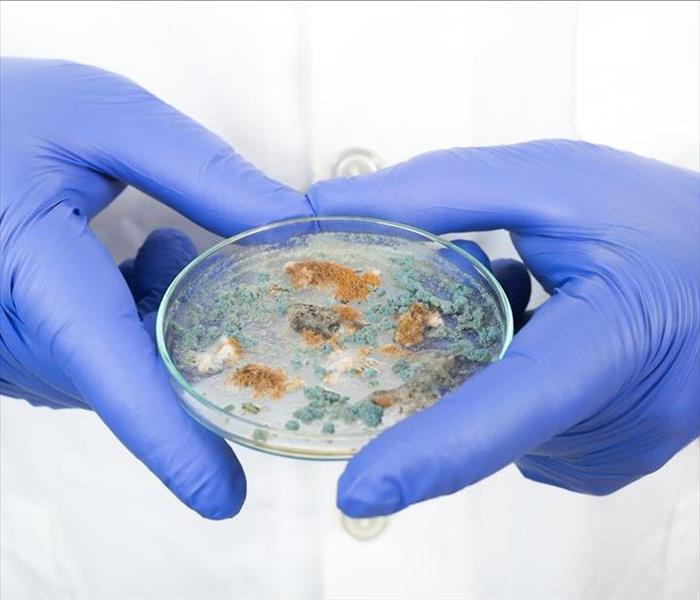 Mold testing can make all the difference in your home... Get yours done today
Mold testing can make all the difference in your home... Get yours done today
Mold Testing
When to have an indoor air quality test done, and how the test is done. The word mold is not as bad as everyone thinks it is. The only time it becomes a problem is when there is too much of it. Too much mold can cause health problems or damage to your property. Not every home needs testing and not all testing is the same.
What sort of things should you be on the look for to decide if you need any mold testing.
Any general concerns about the house where something just does not seem right and you cannot put your finger on it.
When a home has been empty with no occupants for an extended period of time
Past water damage that was not cleaned up by a professional or you suspect was not done properly
No home inspections have been done in a while you see or suspect there is mold somewhere
A musty smell that is notice upon entering the home
Anyone in the home that has repertory problems
Mold Remediation was done and you want to ensure it was effective.
Visually seeing anything that looks like mold
If mold removal or clean up was done
When a 3rd party is effecting repairs and you need to make sure they are done correctly
There are 3 main options for testing
Surface Testing
This is done to look for evidence of actual current or past mold growth. The tester will use either a swab or a tape lift to obtain their sample. These tests can tell if the growth is from actual water damage and intrusion or if it is excessively humid in the home. Dark and discolored growth is not always microbial and would mean it is not from a water damage situation. When you see visual growth it is always important to get a sample of it as well as an air quality sample to ensure spores have not been released into the air.
Indoor air quality testing
This is done by taking numerous samples from within the inside of the home as well as a base line sample of the air quality on the outside of the home. These samples will be able to tell if you have hidden moisture leaks.
Indoor Air Quality with Comprehensive moisture evaluation.
This testing is done to provide a full scope picture of what is really going on in the home. It is able to locate sources of moisture that overtime could damage the property or become a health concern. Mold and moisture damage can drastically affect the value of a home over time. So it is important to stay on top of things and help prevent any major damage. Identifying the damage early can save you in the long run.
Remember when you have any doubts or questions about mold in your home talk to a professional get your results and get it right the first time.
Introducing Waterless Masonry Cleaner
6/8/2016 (Permalink)
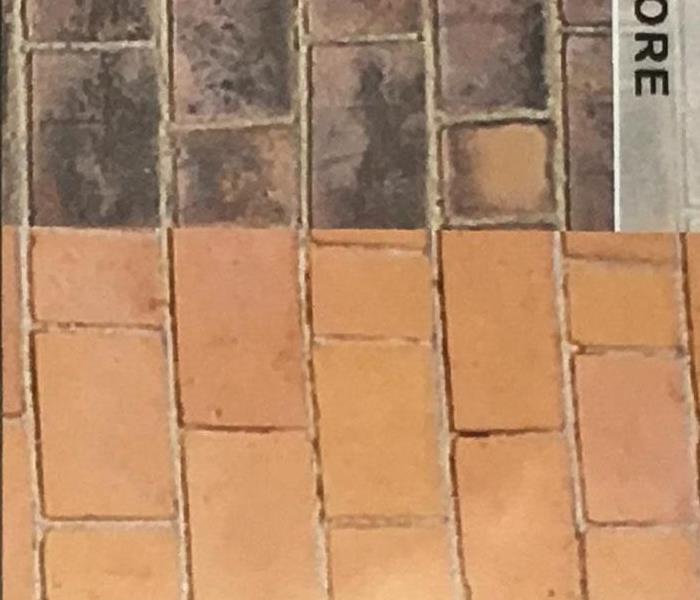 Before and after of brick work that hard to reach deep down dirt and grime imbedded into the stone.
Before and after of brick work that hard to reach deep down dirt and grime imbedded into the stone.
SERVPRO asked ENVIRO-SHIELD answered. Introducing a new product formulated with natural rubber that is intended to remove heavy dirt, grime, soot, nicotine and stains on limestone, sandstone, marble, concrete, plaster, brick and terra cotta. Designed for both interior and exterior use, its waterless application makes it a very safe, effective, acid free solution that can be used virtually anywhere without making a mess. It was specifically formulated to work below the surface and pull out ugly stains that penetrated deep into the pores of most masonry materials.
- No water required
Brush on spray application
Effective on smoke, dirt, soot, nicotine and more
Environmentally friendly
Spray on, let dry and peel off
Acid-Free/ Water Based
Zero VOC
ENVIRO-SHIELD Masonry Cleaner
This products is engineered for airless spray or brush application. By applying a thick even layer of Enviro-Shield masonry cleaner to the affected surface it will peel easily off once it has had a chance to dry. Once it has been applied it is left alone for 24-36 hours depending on the temperature. When it starts to turn a shade of yellow and becomes rubbery to the touch it is ready to be removed. One important point is that it can not be applied to exterior surfaces if the temperature will be over 90 degrees or it is raining out.
Grilling Safety Tips
6/1/2016 (Permalink)
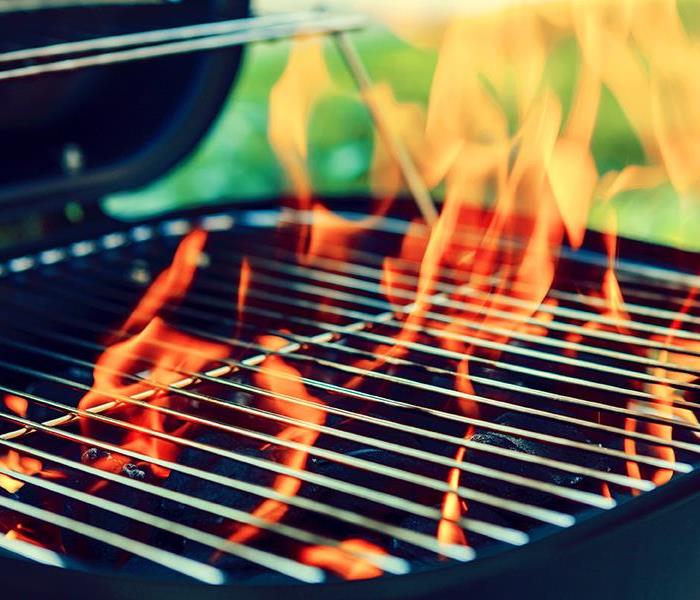 Grilling is a big part of summer ...preventing embers from catching fire, and smoke from damaging your home or your neighbors is very important
Grilling is a big part of summer ...preventing embers from catching fire, and smoke from damaging your home or your neighbors is very important
Grilling safety tips
Our Friends at National Fire Protection Association have put out this great article on Grilling safety and since most fires start with cooking we think it’s a pretty good idea to get some key tips now that Memorial day has come and gone.
http://www.google.com/url?sa=t&rct=j&q=&esrc=s&source=web&cd=2&ved=0ahUKEwiRssS8wsjNAhUFdj4KHazpCYUQFggiMAE&url=http%3A%2F%2Fwww.nfpa.org%2F~%2Fmedia%2Ffiles%2Fsafety-information%2Fsafety-tip-sheets%2Fgrilling_safety_tips.pdf%3Fla%3Den&usg=AFQjCNHLoEmZSOpc_BrwBk_NDvQ2lnL8PA&sig2=QJmDl8jj2w4k7O9MiPjnXg
Fire in the grill, under hot dogs and burgers, is a welcome sight at the family cookout. But fire anywhere else can make your summer kick-off barbecue memorable for all the wrong reasons. To keep you and your family safe while grilling, follow these general guidelines:
General grilling tips
Propane and charcoal BBQ grills should only be used outdoors.
The grill should be placed well away from the home, deck railings and out from under eaves and overhanging branches.
Keep children and pets away from the grill area.
Keep your grill clean by removing grease or fat buildup from the grills and in trays below the grill.
Never leave your grill unattended.
Propane grills
Video: Guy Colonna, NFPA Division Manager, Industrial & Chemical Engineering, gives some basic tips on how to prepare your grill before your first cookout of the season.
Before you use your grill:
Check the major connection points between the gas (propane) tank hose and the regulator and cylinder, and where the hose connects to the burners. Tighten if loose.
Check the gas (propane) tank hose for the potential (gas) leaks. To do that:
Apply a light soap and water solution to the hose using a brush or spray bottle.
Turn the propane tank on. If there is a gas leak, the propane will release bubbles around the hose (big enough to see).
If there are no bubbles, your grill is safe to use.
If there are bubbles, turn off the tank and check connections, then have your grill serviced by a professional before using it again.
If the leak doesn’t stop, call the fire department immediately.
When the grill is on:
As you are cooking, if you smell gas, turn off the gas tank and burners.
If the leak stops immediately, get the grill serviced by a professional before using it again.
If the smell continues, move away from the grill and call the fire department immediately. Do not move the grill.
Charcoal grills
There are several ways to get the charcoal ready to use. Charcoal chimney starters allow you to start the charcoal using newspaper as a fuel.
If you use a starter fluid, use only charcoal starter fluid. Never add charcoal fluid or any other flammable liquids to the fire.
Keep charcoal fluid out of the reach of children and away from heat sources.
There are also electric charcoal starters, which do not use fire. Be sure to use an extension cord for outdoor use.
When you are finished grilling, let the coals completely cool before disposing in a metal container.
Water damage, Ice Dams and Gutter Cleaning ?????
5/18/2016 (Permalink)
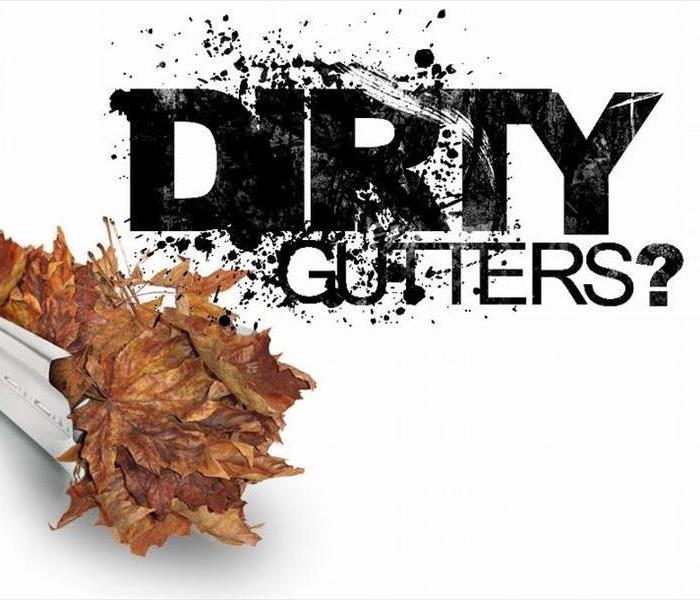 Cleaning your gutters helps prevent water damage
Cleaning your gutters helps prevent water damage
Water damage, ice dams, leaking roofs, and insect and animal infestations, and mold.. you may be wondering why we are talking about ice dams, water damage, and such in the spring, Well let me explain. Most ice dams are caused by issues with the roof, ventilation and insulation issues. That being said making sure that the water stays away from the wrong areas of your home is pivotal.
Gutters that are free and clear of debris will do just that. When there is debris in the spring summer and fall sure the water will back up and many times overflow and follow the path of least resistance. When there is no freezing going on. It can push up onto the roof overflow the gutter and spill down the side of the home and along the edges of the house. A gutter that is full of debris can make a great home for rodents and insects. Now you may be thinking no big deal. Let us look at that a bit more.
We live in New England and freezing temperatures and melting ice and snow are inevitable. With that comes the problems. Ice and snow melt and too follow the path of least resistance. This becomes especially problematic when it moves further away from the heat source and refreezes. Because when it gets under shingles, in-between the framing, and in any crevice that it wants it enlarges and can create holes. These holes will allow more heat to escape and a larger path for the water to travel through. The warmth from the hole will attract the insects and animals that are living in you gutter and can become large enough for them to enter. If it is not the may be willing to make it larger. As you can see an endless cycle.
Having your gutters cleaned regularly in the spring and again in the fall after the leaves have fallen will make sure water has a clear safe place to travel. While this may not prevent every ice dam from forming it will certainly help keep water where it should be. Prevention is the far less costly than repairs.
Should you notice any funny odors, holes, or bee hives on an edging of your home call a professional to have it inspected so that you can fix the problem before it gets worse.
It is Spring Time... Spring Cleaning musts to stay healthy
5/10/2016 (Permalink)
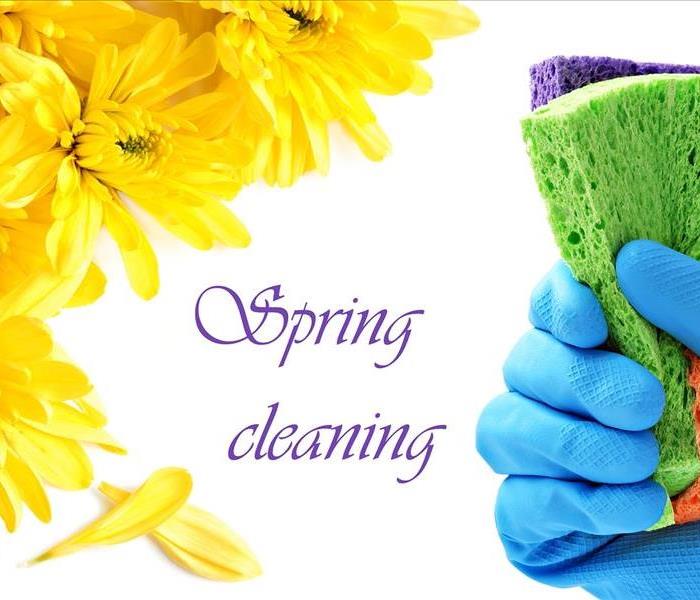 Spring Cleaning... Rid your home of mold
Spring Cleaning... Rid your home of mold
It is spring time… The flowers are opening, trees are blooming, birds are chirping and you want to open your home. Refresh the air that has been cooped up all winter long with little to no circulation. Your home still smells funny. Well with the spring comes spring cleaning. This cleaning is a deep down get into places you may never have. Because once summer comes those air conditioners are going in and your house will be shut up tight keeping the hot air out.
Washing Machines
So over the holidays you got a fancy new washing machine. One of those front loaders that holds that queen sized comforter so you no longer have to go the laundry mat once a week or month because you put it off. Or the one you got because the sensor on your old one did not sense when it was fully and your laundry room and basement were flooded beyond reproach. That is wonderful and it has been working like a charm but what in the world is that smell coming from the inside of it . You clean it with laundry detergent 5-6 times a week why on earth does it have an odor. The gasket and the glass that your cat marvels at as your clothes tumble around stay wet. The door is usually closed when you are not using it so the gasket and the glass stay wet. Coupled with the pieces of lint that fell off while the laundry was in there makes a perfect breeding ground for mold. We suggest wiping the gasket inside and out weekly and giving your machine a once over with bleach and no clothes. This will kill any of the bacteria that could be growing inside the crevasses.
Refrigerator
Yes you know that place you use day in and day out for your family meals, the on the go rush out the door grab the apple place. There is a tray underneath it that will sit and collect condensation for you so that your floor is not ruined. Guess what, it collects condensation which is a fancy term for water. That water sits for weeks, months maybe years on end because you did not know it was there. Particles of food and dust get pushed into it when you sweep and it all starts to do what nature does best. GROW.. You mat not smell it right away or at all but trust us it is there. We have seen it at our own homes, yes even we get busy. Make cleaning the drip pans part of your spring cleaning. Natural cleaning solutions work best our suggestion would be to mix hydrogen peroxide in a cup of water and spray the pan thoroughly. Take a rag and soak it in white vinegar and wipe clean. Make sure you are cleaning the floor around the pan as well leaving nothing to chance. Once a year should do the trick.
Dishes
Yes your dishes can become moldy. What tends to happen is you ask your kids to help you and they “DRY” the dishes and they get put away in the cabinets. The water that is still left on them drips onto the shelving and sits there. Especially on holidays with dishes that are not used very often. Many times the water will stay on the dish in the bottom and just festers there until they are used again. If it is the shelving that gets wet, it goes un-noticed as many times it is over head. Ways to prevent this is to make sure dishes are fully dried before they are put away. Should you run into mold we suggest you clean all dishes in the cabinet and wipe the shoveling down with a wet rag soaked in vinegar and let dry thoroughly before you put everything away.
Air Conditioners.
Ok so the spring air has turned to the heat of summer and you want to start up that air conditioner. Before you do it is advised you clean it through and through. Air conditioning units are made to trap pollen and dust along with moisture from the air. All of which is the food and water mold needs to grow. In as little as 24 hours in warm weather mold can start to grow and if you have a central air conditioning unit and you suspect mold you must call a mold remediation company to clean the duct work, drain pans and coils. Should you have a window unit remove the front panels, flush the drain pan and the coils with a 1:1 bleach to water ration and, use a HEPA vacuum to clean out the blower.
No matter what you have on your agenda for this spring and summer make sure you start off on the right foot by staying safe and clean. Should you have any question about things you find in your home never take chances call a mold remediation company to review your problem and provide you with the expert advice to make it like it never even happened
Sense of Belonging
5/5/2016 (Permalink)
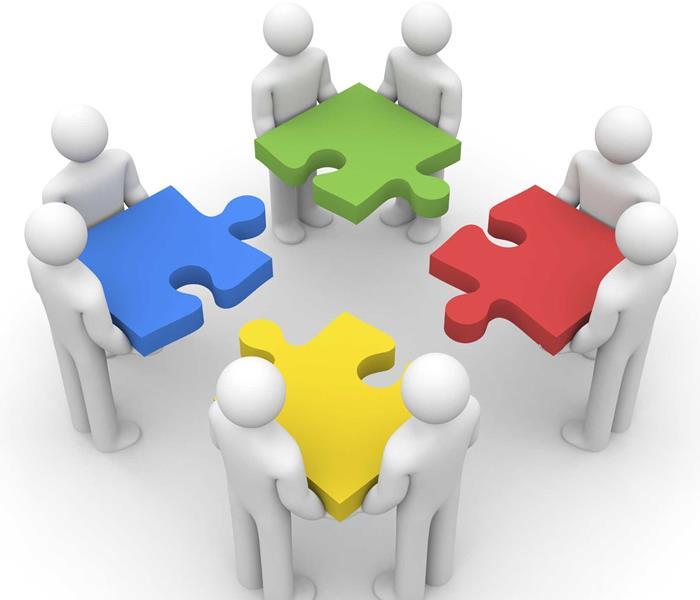 Fitting the community together one piece at a time
Fitting the community together one piece at a time
SERVPRO of East Boston still believes that shaking some ones hand is the best way to do business and earn your trust. With technology today that is a little harder to do than it used to be but we strive on achieving that goal. We joined the Business Networking International group ( BNI) This has allowed us to connect with others and assess their needs within the community.
Developing, maintaining relationships and keeping a pulse on the needs of our customers is pivotal to us. Having a pipe break in your home, or sewage backup into your basement is a very devastating ordeal to have to go through. So to can the trials of everyday life, making decisions on what to do with all the stuff you have accumulated over the years, or just some basic spring cleaning. We will be there making it like it never happened.
One thing that resonates with us is the sense of community and team work that has been established through this network of professionals to help one another not only professionally but personally.
A younger new member of our group who just moved to the area, was in a car accident and was very shaken up and injured yet she was determined not to miss this weekly meeting. She reached out to one of the members to inform us she would be late. That member relayed the information to the chapter president as well as the chiropractor in the group. Upon her arrival she was given a brief exam by the chiropractor, whom advised her she should go to the hospital to get checked out. One of the attorneys in the group gave her a ride over and stayed with her at the hospital. A caterer of the group sent them over lunch while they waited for her to be seen. The acupuncturist and the physical therapist where able to step in and woke with her ongoing care once the extent of her injuries was assessed.
Where can you go in this day and age where so many people are in one place are able to care and look out for each other. This is the heart of the community and exactly what small businesses do, they take care of the community and the people in it. We are so proud to be part of such a great group and look forward to the new experience and opportunities that are sure to come.
Keep your eyes open and stay tuned you never know where we will pop up next
How clean is your air
4/22/2016 (Permalink)
 Typical duct work layout
Typical duct work layout
How is the air quality in your home?/
Sweeping away years of dust and dirt..Helping reduce potential for damage and health risks. Since the ventilation system is often the biggest culprit in poor indoor air quality, inspecting the ductwork should be a high priority. In most cases, the HVAC system has been operating for some time without much attention. Dirty ducts can circulate odors, contaminants such as mold and irritating dust throughout your building or home.
A routine part of service should include inspecting the heating, ventilation and air conditioning
unit (HVAC). Keeping the HVAC system and ductwork clean can potentially extend the life span of the equipment by allowing it to operate at peak condition, which may save you money.
Professionals that use a portable ventilation & air duct cleaning system to examine the ductwork and make a clean sweep, removing years of dust and grime. Will be able to provide a more thorough inspection and detailed cleaning ensuring it is done right the first time.
The process begins by using patented equipment including a roto-scraper, which automatically adapts to the duct’s shape and diameter while traveling through the duct, removing debris and filth before vacuuming begins. Next, a powerful push-pull air delivery and collection system transfers the debris from the ducting to a 16-gallon container. Air is filtered through a HEPA filtration system, removing 99.97 percent of particles in the airstream. HEPA filters capture debris and keep the environment clean. As an optional process, a sealant or coating product may be sprayed to address odor or microbial concerns. Filters will either be cleaned or replaced to remove odor and dirt.
A good company will inspect your HVAC system and ductwork; make recommendations about the best way to address any indoor air quality concerns. This inspection can save you money and provide peace of mind on the health of your HVAC system and ductwork. In some circumstances, such as after fire, smoke or suspected mold growth, duct cleaning becomes an essential part of the cleanup process. In many of these cases, your HVAC system can be restored.
This sort of maintenance can help with
Remediate Bacteria, Fungi and Mold.
Reduce Potential for Mold Growth.
Restore Peak Energy Efficiency.
Eliminate Offensive Odors.
Provide Free Written Inspections
and Estimates.
VICES
Prepping your home for sale
4/20/2016 (Permalink)
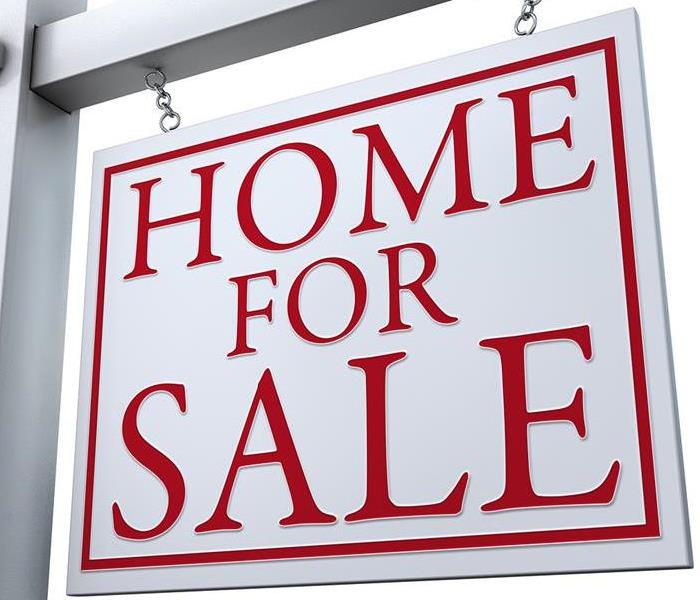 Cleaning your home for a quick sale
Cleaning your home for a quick sale
Preparing your home to sell
Want to see your home.. the easiest and most cost effective thing you can do is clean it up.. De-clutter .. and wipe your entire house. Following the simple methodology of Top to bottom and left to right you will ensure no corner is left untouched or missed. A great once over will really spruce up your efforts to provide the potential buyer with the right space to let their imagination run wild.
If you have a lot things all over the home many potential buyers may think there is not enough house for their things. Make it as open as possible. Cleaning up the pathways and stairs to eliminate any potential safety hazards is pivotal to the perception of the home and its inherent value to the potential buyer. Reducing the clutter and providing as much open space as possible invites creativity. This is not only limited to junk but making sure that your counter tops are cleared off daily, and mail is kept out of sight.
Finding a home for all of your appliances, equipment and cosmetics that are not used daily out of sight will really help open up the space. Using a small container or basket that can be quickly stored elsewhere quickly for things that are needed daily will make getting ready for a showing quick and easy. Another good practice is to sweep your floor nightly this will make sure you are ready at any time to have buyers come in
The main rooms that many buyers will focus on are the bathrooms and kitchen. While these rooms are the most important they can be the most challenging. There is usually a lot of opportunity for streaking as well as mold and mildew growth. Creating a clean environment in these two rooms will be very important for your showings. Ridding these two rooms of mold and mildew will ease the mind of potential buyers of the health concerns that have recently been in the public eye within regards to the mold and mildew. Bleach or cleaners that have bleach in them will be best for these types of situations. Should you think that the job it too large call a professional as they have sprays and sealants that can be used to eliminate and prevent future mold growth. Make sure that you wipe everything down, dry all faucets and handles to prevent water spots. Ensure you squeegee all doors walls and mirrors this will keep everything clean and fresh.
When you are cleaning all of the variable surfaces that are throughout your home please make sure you have the proper cleaner for each one, so as not to damage these surfaces before you even get someone to look at your property. With as many surfaces that you may have in your home they will have just as many cleaners. It is important to make sure you read the labels and use the right one. Powder are more abrasive than liquids which is great for deep down stains or dirt but used in the wrong surface and scratch and ruin it. If you are using a concentrate make sure you mix it with the right ratio ***DON’T WORRY the ratio will be right for proper cleaning *** using too much cleaning product will result in a film being left on the surface you are trying to clean resulting in a cloudy or dirty look. When cleaning a floor you must be sure to rinse the floor when finished or use a no rinse cleaner.
Surface cleaning is not the only cleaning that you should be doing when you are cleaning your home. This is one time you need to do a deep cleaning, this includes but is not limited windows, walls, carpets, drapes, tops of window and door frames. Ideally it is best to repaint but if your budget will not allow it make sure you wash the walls, testing in a small inconspicuous spot for the cleaning products interaction with the paint. Also come up with a checklist for the daily upkeep that will ensure a clean home at any moment. Vacuum all rugs and carpets using long slow strokes to get as much debris up as possible. When washing large vertical areas start at the bottom and work your way up in small circular strokes this will avoid any streaking that could occur from cleaner or dirt dripping down the wall.
Use this list of quick daily tips for maintaining a clean home during the sale process.
Use small area rugs at every entry from the outside into your home so that you can collect as much dirt before it enters your home. This will keep large build up of dirt and grime out of the main areas of your house.
Use hot water for a few minutes before you shower, at the end of the shower wipe all surfaces down, the steam that was created will loosed up any residue.
Scented cleaners should be used in the toilet every night to make sure it is always clean and fresh smelling.
Have 2 or 3 levels to your home keep a vacuum on each floor this will make cleanups a breeze and save you a lot of lugging around.
Have disposable wipes handy in the kitchen bathroom or any other high traffic areas of your home for quick clean up, or wipe downs after each use. Spills that are cleaned up immediately are much easier to handle and are less likely to leave a stain.
Fire Damage is just as important to clean up
4/4/2016 (Permalink)
 ABC's of Fire extinguishers... Getting the right one can be the difference between life and death... Know what you need
ABC's of Fire extinguishers... Getting the right one can be the difference between life and death... Know what you need
Fire Damage…..
Think water damage is the only thing that needs a quick response …Think again..
The number one cause of fires in the home are from cooking and 34% of them result from someone walking away from the stove.
Life is busy.. It is very easy to get distracted these days. Multi-tasking has become a habit and despite what we are taught it is not actually better.
Staying focused on the task at hand provides you with a more concise timely resolution with accurate results. No matter what sort of tasks you are doing and trying to accomplish. This is especially important when working in a kitchen.
No matter what you are using to cook… A microwave, toaster, hot plate, gas / electric stove, or even a crock pot which many of us set and forget can be dangerous. Walking away from something that is hot can have dire consequences.
Did you know that the numbers on your toaster are actually for minuets? So when you walk away from your toaster for the 2n time and your toast has burnt to a crisp and you had it on high you could have in theory had your bread in the toaster for upwards of 10 minutes. Dried out bread can catch fire very easily and cause an electrical fire in your home. Not being prepared can be very dangerous.
Fire can get out of control in as little as 30 seconds and more than 12K people are injured every year in a fire. A small home fire is nothing to mess around with. Having the right kind of fire extinguisher to put of various types of fires is very important. Just having a fire extinguisher is not enough , having the right one is pivotal..
For example electrical and grease fires cannot be put out in the same manner as a fire that starts from say a wood stove or fire place. Did you know that actually throwing water on a grease fire will make matters worse and cause the fire to expand more rapidly?
We use the term disaster to be all encompassing and maybe even a little too broad within our industry. Fire damage specifically kitchen fires can be broken down into some simple terms. Stove fires.. Toaster fires….Grease fires.. Vent and exhaust fires and even fires from your microwave.
Below you will find some statistics on home cooking fires.
42% of surveyed consumers say they have left the kitchen to talk or text on the phone, and 35 % have left to use the computer to check email while food is cooking. If you tend to do a lot of cooking, invest in a second or third timer. They're an inexpensive way to stay safe while ensuring that your food does not overcook.
Nearly half (45 %) of consumers say they have left the room to watch television or listen to music. Multi-tasking during the busy day is tempting. If you succumb, it's important not to leave the stove or oven unattended
Nearly one third (29 percent) of consumers reported that they have intentionally disabled smoke alarms while cooking. (YIKES!!!!)
More than half (56 percent) of surveyed consumers said they plan to cook for family or friends this year - with 42 percent of those cooking for groups of 11 or more.
Fire damage can be extensive and wide spread even to areas of the home that the flames did not reach. The small particles that burned travel in the air throughout the home and due to their small size and nature can stick to just about anything.
Taking care of smoke, fire and soot damage is necessary and here is why. There are various types of soot damage and some are acidic which can stain a variety of surfaces if not treated quickly . Within hours all surfaces that have come in contact with fire and smoke damage begin to feel its affects. Wood furniture, floors and molding will need to be refinished, Metal will begin to rust and corrode. Clothing can become permanently stained and need to be thrown away. Walls will begin to absorb the particles and start to turn yellow.
Within weeks if left untreated soot exposure embeds into fibers and deep into porous materials continuing to deteriorate the items or property if not properly restored in a timely manner.
Any clothing bedding , curtains and washable materials should too be professionally cleaned because an alkaline cleaner neutralizes the acid from the soot. Make sure it is someone that has experience specifically with smoke damage.
Professional Restoration companies have the proper tools and training to get you back to normal without these lingering effects. From special sponges for removing soot and ash from the walls, air purifiers to scrub out the particles that have not settled on the anything yet, right down to high efficiency vacuums that have a great filtration system that prevents the soot from being redistributed into the air, they are even able to clean the vents above your stove that collect the grease which can be helpful to prevent fires in the first plac. We strongly recommend a professional whenever there is fire soot and smoke damage because improper cleaning will continue to damage the property and increase the costs down the road.
Water and Sewage Backup
3/30/2016 (Permalink)
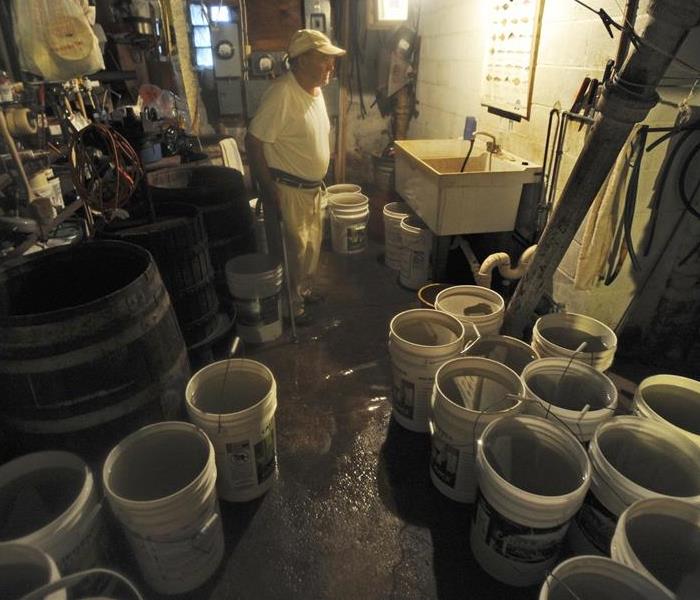 Image of water seeping into a basement
Image of water seeping into a basement
Water and Sewage Backup
There are 3 Categories of water damage..how dirty is your problem…..When you have a water damage in your home it is good to know how severe your problem is. No matter if the water damage is in your basement, from a washing machine overflowing, in your kitchen because your dish washer line let go while you were at work, or in the bathroom because the football team visited and your toilet overflowed and cannot handle 15 teenage boys. The type of water that is all over your home makes a huge difference.
Clean water -Broken pipe, leaky faucet
Gray water- dishwasher, Urine w no fecal matter, Washing machine
This water can quickly turn into stage 3 if not handled quickly.
Black water- Standing water overflow w fecal matter, Flooding waters
Note: Sewage back up should be handled immediately and considered an emergency since the water may contain viruses’ bacteria and other microbes that can cause serious illness. The severity of the health threat is going to depend on the source of the water and the extent of penetration into the home or business. How the water enters the area and the materials that are affected along with the time that the water sits will have an impact on extent of the damage is. Even floodwater or storm water which has not been directly impacted by sewage discharges is likely to contain a wide variety of microbiological organisms (e.g., from animal wastes, street runoff, etc.) and must be properly managed. Some of these pathogens, such as mold spores, can even establish themselves long after the water has receded.
Obviously the ideal thing to prevent the problem but that is not always feasible and sometimes being pro-active and taking quick action are paramount. Mitigating the risk of infection is important to keep you and your family healthy.
Prevention:
If a home is located in an area subject to periodic flooding (such as in a floodplain) or where sewage backups have occurred, the homeowner should implement "all feasible measures" to prevent/minimize the nature and extent of impacts from such situations. Such actions can be preventive or pro-active.
Preventive actions include:
1. waterproofing the building foundation and/or sealing cracks in foundation floor or walls;
2. installation of a check valve or shut-off valve on the building sewer close to where it enters the structure, which will protect your home from sewage back-ups due to surcharging conditions in the municipal sewerage system (you must check with the proper sewer authority prior to taking this action!!); and
3. raising or removing any sink, toilet, washing machine, etc. in the basement that may be subject to backups when the sewer system surcharges.
Pro-active measures include:
1. purchasing or installing a pump (e.g. sump pump) to pump out water that collects in the low point of the basement or structure;
2. ensure that building gutter downspouts and drains are directed away from the foundation and toward low points away from the home;
3. to the extent possible, keep furniture and valuables above flood levels where flooding has previously occurred; and
4. if minor flooding occurs, follow the water to its point-of-entry and seal cracks or defects to the extent possible.
Remember, an ounce of prevention is worth more than a pound of cure. Flood insurance is also vitally important where properties are known to be in floodplains or flood prone areas. More information on prevention and flood insurance is available on the FEMA website.
Cleanup of Internal Areas
Once the flood waters have receded and the property can be accessed safely, cleanup operations should commence -Remember to check with local emergency management officials before returning to a property affected by flooding! The most important steps are to restore the environment to a dry state and salvage any valuable property. The longer that water/waste are allowed to remain in your home or on your property, the greater the potential for illness and irreparable damage to your home, its contents, and environs. Where they may be operated safely, use of pumps and dehumidifiers will be helpful in restoring dry conditions. In any flood cleanup project regardless of the source,one should assume that pathogens are present and take appropriate precautions.
The survival of pathogens depends on a number of factors: location (indoors vs. outdoors), season, type of surface contaminated, whether disinfectants are used, and also on environmental conditions such as humidity, temperature, and sunlight. Sunlight (UV radiation) reduces the survival rate of pathogens with numbers decreasing rapidly with increasing exposure to UV radiation. Mild temperatures and higher humidity in external situations result in longer survival times.
As always when there is water damage assess the level of intrusion, type of water, and make sure when in doubt you call a professional there is a lot at stake, because at SERVPRO family matters. The guidance of experienced professionals and public health officials who are able to view a home and assess the needs of your particular situation can make all the difference
Why you should deep clean your carpet!!!
3/24/2016 (Permalink)
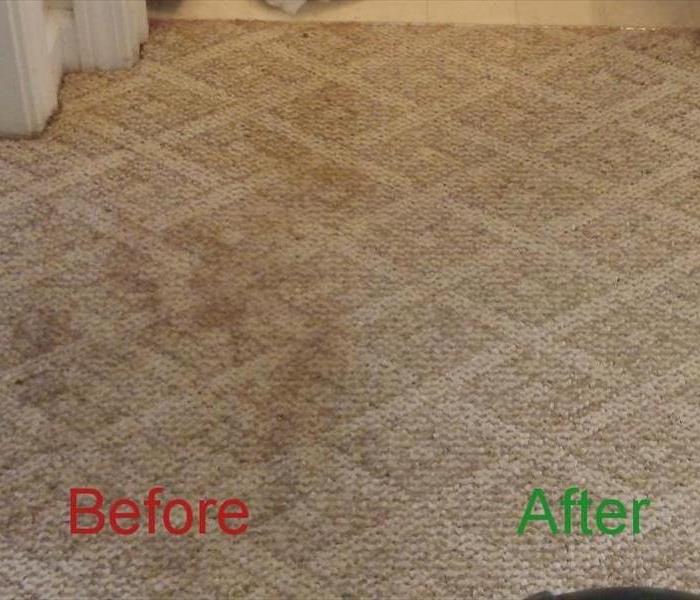 Before and after professional deep carpet cleaning
Before and after professional deep carpet cleaning
Spring cleaning time is upon us here in the Northeast. That means we can open our windows, fluff our pillows, discard, and make space for friends and family to visit. No matter if you are looking to spruce up your home or really get your business ready for some important visitors, part of your cleaning really needs to include a deep clean of your carpets. Here is a key list of reasons why carpet cleaning is so important
Properly cleaning and maintaining carpets:
Reduce expenses and maintain warranties. To maintain the warranty many require regular deep cleaning using extractor equipment every 12-18 months why not use spring as your marker.
Prolong the life of the carpet. Deep carpet cleaning is required for that to happen.
Improve air quality in your home. Carpets are very fibrous, those fibers trap and hold dirt, and even pollutants such as pollen and odor. Once at a saturation point they will look for somewhere else to go. The air, your bed, pillow furniture and many other places. Carpet cleaning will ensure this saturation point is never reached.
Increases ease of maintenance. When the dry particles are pulled from deep within the fibers of the carpet they are less likely to become impacted and build up over time.
Eliminate expanding spills and food stains by removing them right away. Stains have a tendency to attract more stains by sticking to the edges of the source expanding out to other areas. Using an extractor make sure there is nothing for other particles to stick to.
Bugs and mites also like to make their homes in your carpet. The fibers of a carpet are perfect for bed bugs and dust mites. Deep cleaning keeps them at bay and removing them reduces the allergens and particles they release into the air.
Improve overall health, as a lot of the build of particles in the fibers of the carpet are allergens that have settled in the air along with various bacteria that has tracked in on your shoes and clothes.
Visually it looks better, and sends an impression to those visiting that the rest of your home or business will be clean for them to enjoy. Carpet Cleaning creates a clean fresh look for your commercial properties and home
Improves the mental state of your employees or family. Clean environments do not illicit stress. It has been shown that clutter and dirt can increase stress within any environment.
5 Causes of water damage in the home:
3/22/2016 (Permalink)
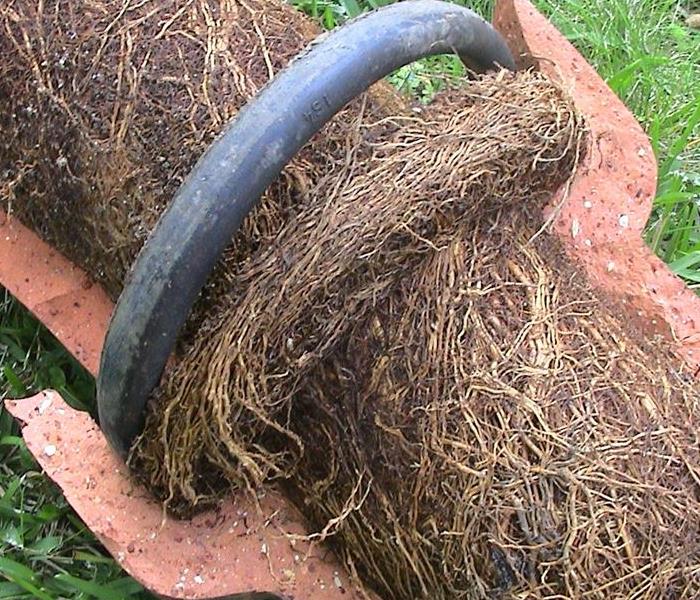 Roots in pipes cause major problems
Roots in pipes cause major problems
Water will not damage my home I am careful, I do not live in a cold climate my pipes will not burst. Let us examine that claim. Do you have kids, Washing machines, dish washers, Ice makers in your refrigerator, air conditioners, tress on your property, an older home or gutters then you are at risk.
Kids love things they do not understand and they love to try and figure it out with their hands if possible. Water is exceptionally fascinating especially since a great deal of time is spent trying to teach them how to use a toilet and have a sense of personal hygiene. That being said the drains in the sink, bathtub and toilet are an immediate fascination. Watching what happens as water swirls around and slips down into the abyss of the drain. What is even more fascinating is watching what happens as it bubbles up over the rim and begins to flow all over the bathroom. Kids will put many things into a toilet to force it to overflow. Drains will be clogged with all sorts of toys backing up the pipes forcing flooding the bathroom.
New technologies such as ice makers, dish washers and air conditioners have made our lives very convenient. Constant temperatures to keep us comfortable and ice when we want it for our favorite beverages and a hands free time free way to clean it all up allows us the finer things. There is a price to be paid for these luxuries.
Sometimes they fail resulting in flooded homes, flooded basements or water damage in the kitchen. Maintaining these appliances is crucial in making sure you check for ever small leaks as they can seep under the floor, water damage in between walls to porous materials can quickly becomes costly. New technological advances in types of hoses and piping techniques can reduce this problem inspect your home regularly and update any older hoses and piping areas to avoid massive water damage to your home.
Air Conditioning units are designed to collect water in a drain and transport it outside. If a blockage occurs your living room can soon become a serious source of water damage. These units are usually put on some sort of wooden structure which can and should be inspected frequently. Should you see your wood floors with water running over them or your carpet is saturated please call a professional as it is already too late to clean up this water damage yourself.
Trees and nature, while many of us like the convenience of the modern world we still want the beauty of the natural one. So you surrounded your property with trees, bushes, shrubs and flowers. Trees are tall, strong, and very resilient many surviving 100’s of years. This is in part to their ability to seek out food and water. The pipes are full of food and water and due to the strength we admire in the branches so to rings true for their roots. Many times trees will break through weak spots in a pipe and drink from the water and soak up the nutrients from the sewage contained within them. The roots will continue through it growing within the pipe itself thus supplying it with a constant food and water source. Roots in a pipe can be a very big problem and a great source of trouble for sewage damage and water damage in and around your home.
Gutters can also cause serious water damage to your roof and attic areas. Many times these are unchecked due to lack of consistent access to these areas of your home. When gutters get clogged with leaves, and branches the water will no longer be able to flow down and seeks an alternative path, this is usually onto and through your roof. Once it gets through your roof the water damage will invade your attic and left unnoticed or unchecked can result in mold growth.
So if you think that you would never have water damage in your home think again. Pipes bursting from the cold is not the only water damages your home. Be on the lookout and if you find something call a professional because you never know how long it has been going on.
Remember: With any kind of water damage in the home, time is of the essence! Drying the home in three days or less prevents the growth mold.
Odor? What is going on in your home
3/15/2016 (Permalink)
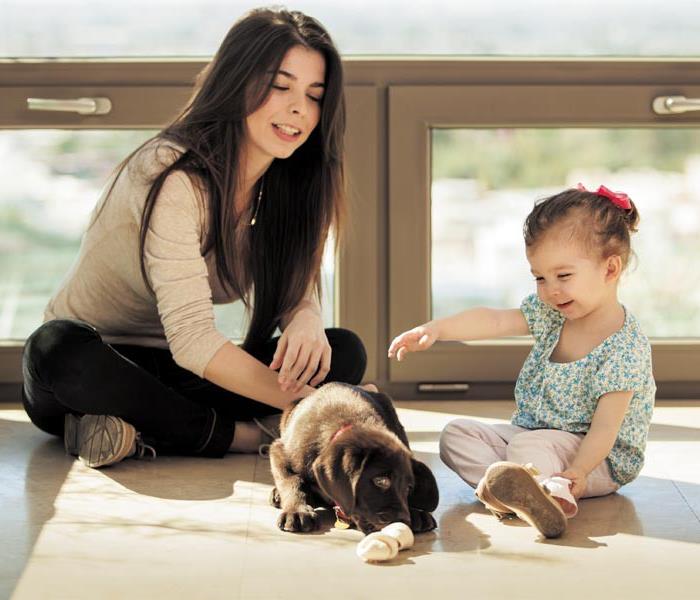 Floors and carpet clean?? let us do it for you
Floors and carpet clean?? let us do it for you
How clean is your home? Are odors in your home from being closed up all winter? Do you smoke inside your home? Do you have kids or pets?
Any of these things are applicable to you then listen up . While most homes can be cleaned or freshened up by you, there are times where it is best to bring in the professional. The cleanliness of a home is said by 80% of home owners to be determined by how clean their floors are yet only 15% have their carpets cleaned yearly. So I ask you again how clean is your home?
Lingering odors can be traced to numerous issues in and around your home that can be hazardous to you, your family and pets. Most home remedies can mask or provide a temporary solution to the issue. They will come back and just be covered up instead. It does not eliminate the hazard and so it remains while you think the problem has been solved.
There are 4 general rules of getting rid of unpleasant smells.
Locate and destroy the source of the smell
Thoroughly clean any surfaces or items that were affected by the source
Assess types of materials and cleaning products needed for each
Spray and Treat the area to deodorize the air and seal any remaining odors
The areas that see the most odor damage are carpets are often a primary spot for odors to take root, furniture, clothing, and drywall may also take on the scent if they are exposed long enough. These surfaces must be cleaned to prevent the smell from coming back. Every material has its own physical properties and professionals will be able to properly asses which cleaning and sealant products will best result in a permanent solution. They will clean the surfaces of all areas and then they will seal the rest in with special sprays. Due to smells being transferred through the air so sealing the odors away for good will eliminate their further spread through your home.
Many odors can be eliminated with the use of a professional such as, urine from pet and childern, mold from water damage you tried to clean up yourself, smoke and fire damage, Cigarette smoke, Closed house from the winter and many other sources. The scope of the work is not a problem large or small they will be able to help you eliminate the odor and get you back to normal.
Did you know SERVPRO is Green clean!!!
3/3/2016 (Permalink)
 Cleaning Products
Cleaning Products
SERVPRO Industries, Inc. is a member of the EPA’s Design for Environment (DFE) program. DFE evaluates human health and environmental concerns associated with traditional and alternative chemicals and processes in a range of industries.
These evaluations and analyses empower hundreds of businesses to select safer chemicals and technologies. The EPA/DFE has established a set of criteria for formulating environmentally friendly cleaning products, and has put together a listing of safe cleaning components that can be used in Green cleaning formulations.
As a member company, SERVPRO® can access this listing known as CleanGredients. From the listing, a formulation can be derived that incorporates “green”chemistry.
The SERVPRO® Professional Cleaning Products (SPCP) Division manufactures and distributes hero ready cleaning products to the entire all SERVPRO franchises. Made up of only 2 blenders, 1 chemist, and an assistant manager, the SPCP team supports the field by not only making quality products, but also being available anytime to the demand in the field and the need for cleaning advice, coaching, or assistance with cleaning emergencies.
There are roughly 10 products in our cleaning line that are considered environmentally friendly. SERVPRO Industries, Inc. has been a long time member of the EPA’s Design for Environment (EPA/DFE) initiative. As a member company, we can access a listing called CleanGredients. CleanGredients contain criteria for formulating environmentally friendly cleaning products, known as “green” chemistry.
Some of our most notable green cleaning products include Window Green Clean, All Surface Green Clean, and Carpet & Upholstery Green Clean. The SPCP team strives to keep 2-3 months’ worth of inventory on-hand at all times at our Corporate headquarters, so they can guarantee no back orders when disaster situations occur. SERVPRO’s Product Resource Center distributes cleaning products and equipment to field when responding to a disaster. Mitigating damages by reducing response times.
The RIGHT EXPECTATIONS!!!!
2/23/2016 (Permalink)
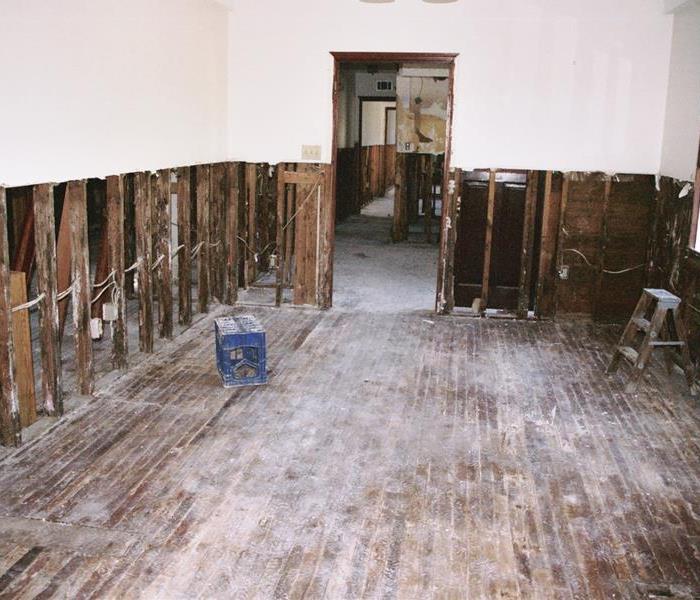 Water damage with cut due to water absorbing up into the wall. Cut made to prevent mold
Water damage with cut due to water absorbing up into the wall. Cut made to prevent mold
You have a water emergency...what to expect
We know your most valuable investment has been damaged along with many of your personal items. The loss and confusion you feel is high. It is understandable that you are upset and want it to be fixed as soon as possible. You call a 24/7 emergency service provider to come out and work towards getting you back to normal.
You expec t that they will be there from the moment you call to the moment you are back to normal. Yet they come in suck up all the water and leave. What in the world….. Why are they not pulling down your walls ripping up your floors and getting to work? Well let us examine that
Have you called your insurance company and received a claim number yet?
No well with no claim number there is no way to know if your damage was a coverable expense thus drastically changing the scope of the work. Should it not be covered all financial obligations will fall on you
Did they leave fans and what appears to be other drying equipment?
Yes. Well then they are trying to mitigate your losses and see how much can be salvaged through the drying process before just ripping it all out. The main reason for this is that many insurance companies require and attempt at salvaging as much as possible instead of resorting to just ripping it all out.
You have not seen anyone WORKING WORKING for 3-4 days in your home and are feeling forgotten!!!!
Guess what water takes a very specific amount of time to be extracted from walls, floors, and the air. That equipment that was left must remain on, and running for a certain amount of time and depending on the amount of water that you incurred this can be more than a full week.
AND NO Putting in more equipment will not help and speed up the process. It can make it worse so please be patient.
I turned off the equipment to sleep or have a dinner party as it was really loud. What is the big deal?
You wanted to sleep better and now do not understand how to turn the equipment back on to the proper settings. This is why many companies have you sign paperwork stating you will not turn off the equipment. It has to run for a certain amount of time shutting off the machines adds 8+ hours which is another whole day or more depending on how long it was off for. It also requires an equipment tech to come back out and reset all your machines increasing cost
My home was pretty hot and humid so I opened all the windows and doors to help circulate the air. Why is the technician telling me it will take more time now?
Guess what science majors cold air does not hold the moisture in the air the same way as warm air. The machines are made to pull the water out of the walls, floors and ceiling into the air and the machines scrub the air and put dry air back in. Opening the door changes the relative humidity in the home thus delaying the process despite what you think about it helping circulate. It prolongs the process
Why did the crew leave after only doing the demolition on part of the home?
The first is that getting things open to let the air moves try and dry out the walls and let them dry out.
The other reason is less understood but other clients now have the same issue you initially had with standing water and an immediate need to start the process. The EMERGENCY portion of your problem is over theirs is just beginning. It must be understood that the standing water and the flowing water is the priority and carries the highest health risks and must be addressed first. Demolition, drying and rebuild all take a back seat to the emergency part of the problem.
Water, Fire and mold remediation companies do have very specific training with all of this and while they are very busy in the northeast right now and may not relay all of this information to you please know they are not ignoring your problem nor are they trying to put you off. But you need to know that there is a process, and not every aspect has to be addressed all at once and many of it cannot be.
If you have questions please ask but also make sure you have reasonable and realistic expectations of the process. Many of the demolition teams are working 16+ hour days to get everyone back to normal.
Raising Temps...mean frozen pipes melting.. Be on the look out.
2/16/2016 (Permalink)
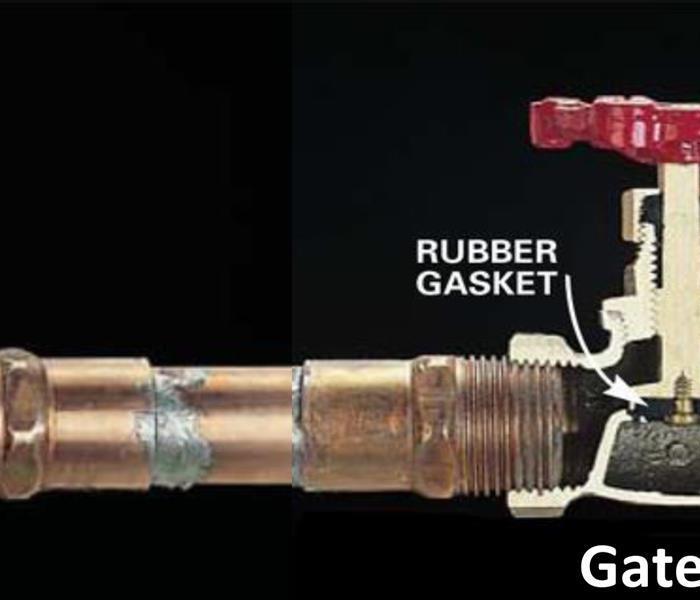 Find out where you main water shut off valve is
Find out where you main water shut off valve is
Temps are warming up.. You may have a frozen pipe and not know it. Make sure you know where your main water shut off is to mitigate damages. Find some useful tips below on what to look for.
Almost all water meters have one main shutoff valve directly before the meter and another directly after. Where the meter is located depends on the climate in your area.
In cold climates like we find in the New England area the meter and main shutoff valves are located inside, usually in a basement or other warm area to prevent freezing.
Cities and towns have their own shuts off valve for the point where the water enters your home from the main city supply that they can shut off but you can not access this. They prefer you turn your water off or on using the main valve on the house side of the meter. This valve will normally be a gate-type valve, with a round knurled handle, requiring several full clockwise rotations to turn off. In newer homes, it could be a ball valve.
In addition, most houses built today have small, localized shutoff valves called fixture supply stops installed on the supply lines leading to other utilities in within the house such as toilets, faucets, dishwashers, washing machines, and water heaters. These tend to each have their own individual shut off valve, usually a small round or oval handle that you turn clockwise two to four full turns to shut off the flow of water.
Depending on the age of the house this may only be found on a toilet if they even have that. If there are no individual item shut offs you must always shut off the main supply when doing any work what so ever. With supply valves, you can turn off the water to a single fixture while fixing or replacing that faucet.
If your plumbing system lacks supply stops, we suggest that if you ever have to install them when you shut off the main valve to repair a sink, toilet or appliance. Eventually you'll have supply stops at every fixture, remember, fixture supply stops must be easily accessible; you can't drywall or plaster over them without installing an access panel to reach them.
Supply stop problems
There are problems even with the individual fixture supply stops. Due tot Be aware of these common problems with fixture supply stops: Many water supply valves drip when turned off and then back on again after an extended period of disuse.
To fix a drippy supply valve, try gently tightening the packing nut with a wrench, or opening and shutting the valve several times until the drip stops. If a supply valve simply won't stop leaking, your only option is to replace it—which will require shutting off the main valve. In cold climates, most people remember to close the supply shutoffs for their outdoor spigots to prevent freezing, but many then forget to open the outside spigot to drain the remaining water.
If the water trapped between the spigot and supply shutoff valve freezes, it can burst that section of pipe. Since there's no water flowing through this short damaged section of pipe, there are no obvious leaks or sign of damage—yet. But when you turn the supply valve back on in the spring and pressure returns to that pipe, the burst section of pipe will leak like crazy—and often go unnoticed for hours or days. One plumber told me he's made dozens of repairs dealing with this mistake.
Finally, many icemakers and furnace humidifiers are fed by small flexible copper tubes that are connected to larger copper pipes via a very small T-handled device called a saddle valve These valves essentially bite into the larger pipe to feed the smaller one. Leaky saddle valves are a major cause of residential water damage and are no longer code-compliant in many areas. If you have saddle valves, replace them with standard supply stops.
Freezing Temps.. Freezing Pipes what you need to know
2/12/2016 (Permalink)
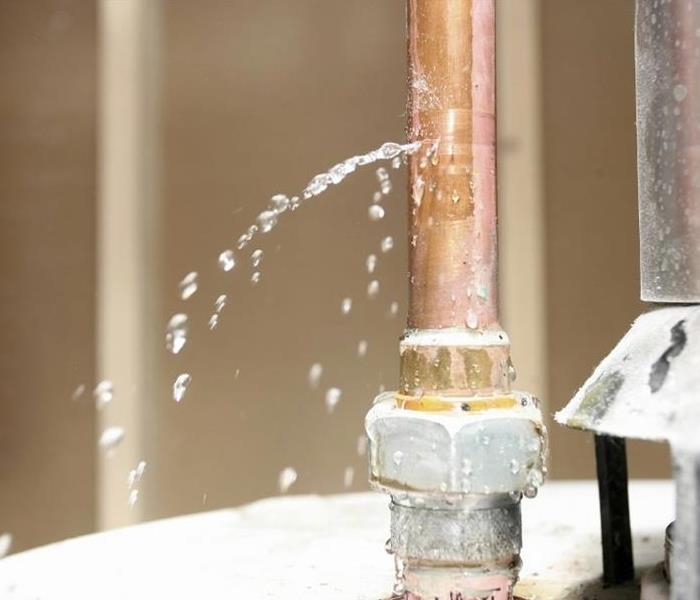 Frozen pipe
Frozen pipe
Frozen pipes are dangerous, costly and very terrifying. If you have ever lived through a burst pipe due to frozen water, you know just how damaging and devastating they can be. If you have not, follow the steps below to help prevent them. Should you have a pipe burst please make sure you call someone immediately .In as little as two days you will start to get mold growth creating an even larger issue
What causes frozen pipes?
The recent extreme cold temperatures coming in have will create an increased risk for a frozen or burst pipe. As the temperatures drop, water in your pipes starts turning to ice. The problem will be not when it is frozen but on Monday and Tuesday when the temperatures start to warm up and the ice melts and water starts to flow out of the cracks in the pipes.
Ice causes pressure and blockage. Over time, the pressure can cause a pip to burst. This ends water flow to fixtures, causes leaks and will end in a major damage not only to the pipe but to your home or office. It does not matter what the pipe is made out of the increased pressure occurs to all pipes, including plastic, copper or steel.
Even a tiny crack in your plumbing line can release more than 250 gallons of water in a single day. That much water gushing out of your plumbing system can cause significant damage and high repair costs. Any delay in remedying the situation can result in a more costly delay.
How can I prevent frozen pipes?
Open the cabinet doors under your sinks and in storage areas to allow heat from the room to circulate around un-insulated pipes.Allow a trickle of water to drip overnight; however, be careful not to run the water into a drain line that is exposed to the extreme cold because that line might freeze.Insulate all pipes in unheated areas or against un-insulated outside walls, in garages or crawl spaces.Apply heat tape or thermostat-controlled heat cables around pipes that are exposed and prone to freezing.If you are leaving for the a vacation it is very important that you make sure your heat is turned on and is set no lower than 55 degrees.What should I do if I have frozen pipes?
Sometimes, despite the best efforts, things happen. If you know or suspect you a problem with frozen pipes, here are some immediate steps to take:
Shut off the water main to reduce pressure on frozen pipes and minimize flooding if the pipes burst.If you don’t know where your water main is or have the tools to shut off the main, now would be a good time to get prepared.Do not use an open flame to thaw your pipes. If your pipe is exposed, you can try a hair dryer.If you suspect frozen pipes, contact your plumbing experts right away.If you notice slower water flow that may mean your pipes are starting to freeze, call a plumber immediately. Typically, issues like this can be resolved before any damage occurs. STAY SAFE, WARM, AND HAPPY!!!
HOVER BOARDS??? FUN or HAZARD.. BE SAFE
2/10/2016 (Permalink)
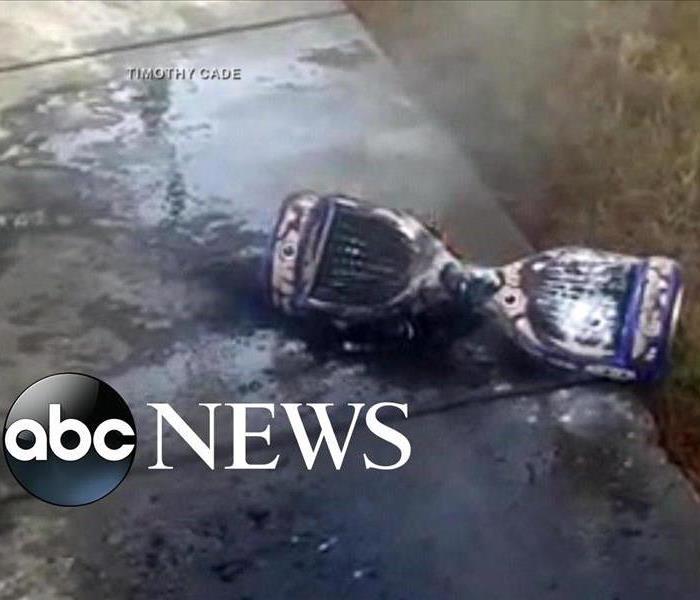 Hover Board injury/ fire danger
Hover Board injury/ fire danger
Hover boards
We are not really sure why these powered skateboards are being called hover boards but they are causing some serious problems and we want to make sure you are keeping your kids and your home safe.
Let us first examine the hover board itself. It is a battery powered scooter without handle bars. There are a variety of names for it but the design is simple. There are two wheels that have a small platform for your feet between them. The rider stands on the platform and a sensor on it then read your bodies movement and propels the board in the direction of travel desired or so it is supposed to do.
Emergency care facilities and emergency hospitals have seen an influx of visitors due to these new devices. This surge is in excess of 25% since Christmas along. They have seen such an increase that they have dubbed it the “Hover board Epidemic.” Think it is just the kids getting hurt on these devices nope they have seen patients’ age range from 10 to 50+. These injuries are just as varied from sprains to major fractures. Losing your balance, not taking the time to learn how properly mount and dismount the device and over confidence are all reasons for the increase in injuries. This device should be something that you learn carefully, in a safe setting not out on the street where a fall could lead to a car running you over or worse.
Injury is not the only danger lurking with these new devises. Fire, is a very real concern and below you will find what we were able to discover. Investigations are still ongoing and results could change through the continued research. We have seen far too many homes and images in the news about these little devices being the cause for some major fires. Please be safe and know the dangers and the steps you can take to prevent them.
Warnings have been issued and safety protocols have been set forth to aid in the prevention of a fire. It is recommended that the hover boards be purchased from a reputable dealer and not an off brand knock off. Also make sure the batteries and chargers are certified by a national testing lab such as Underwriters Laboratories. It is not clear the reason as to why they are catching fire, but it is clear they can easily overheat and burst into flames.
The charger could be partly to blame so make sure you are not charging them over night or when you are not home to monitor the situation and do not leave it on the charger and over charge. The boards are not only catching fire when they are being charged but when in use so please use caution and if it feels warm on your feet discontinue use immediately and bring it someplace safe to cool off.
If you wanted to bring it to your cousins’ house make sure you don’t have to fly many airlines have banned the shipment of the device due to the batteries claiming they are the main problem.
The batteries are lithium-ion batteries. What are they? And what makes them so dangerous? Lithium-Ion Batteries are an energy storage device which is generally safe unless shortcuts are made by less reputable firms. Which is why it is so important to be aware of where you product is coming from. Main failures are either normal failure rates tied to a very specific design flaws that can be recalled and corrected, but more concerning are those failures that do not point to a particular design flaw and are seemingly unexplained. Many of the failures of these batteries are said to be based on the cutting of corners from the design and build to improve profit margins on the products they are used in. Please be diligent and do not buy simply because it was the cheaper version. It could be deadly
SO what do you do? When these lithium-Ion batteries fail you will hear a hisses, see bulges. If safe to do so move the item away from anything combustible and place it on a non-combustible surface such as a sink or bathtub while you can use water we recommend a dry chemical see below Should you have time take the item outside get it outside and place on a paved area to burn itself out. Now while that is not always feasible there are ways to douse the devise to quell any flames. Fire extinguishers are best but it must be a Class D or and ABC Dry chemical extinguisher as water will make the fire worse. Dry powder will also work baking soda should be your first go to and most people will have this in their home but a copper powder, or a powdered graphite will also do the trick. We cannot emphasize enough we recommend a fire extinguisher on this type of fire.. While water is ok for the lithium-ion battery just not lithium metal it is a good idea to use the proper fire extinguisher. If you don’t already have one in your home it is a good idea to get one even if you don’t have a hover board.
We hope this helps keep you safe and happy surfing…
CARBON MONOXIDE?? KEEPING IT OUT OF YOUR HOME
2/9/2016 (Permalink)
 Carbon Monoxide keeping it out of your home
Carbon Monoxide keeping it out of your home
Carbon monoxide is a colorless, odorless, and tasteless gas that is less dense than air. In concentrations over 35 parts per million it is toxic. It is formed when there is not enough oxygen in the blood to convert the oxidization of compounds containing carbon.
It is used in the chemical industry for a variety of things some of which the processing of things like coal into diesel fuel itiis also used to make Acetic acid which is the main component of Vinegar, You have got that right it helps us make vinegar. Which is used for hundreds of things. So why does everyone make suck a big deal about it then?
It is found naturally within the environment and even used on purpose to keep things such as beef, pork, and fish looking more fresh as we stated earlier it does interact with the blood keeping it more cherry red and the appearance of freshness.
The amounts found naturally are not enough to really hurt you normally but the overall places it can be found in your home is another story.
Carbon monoxide inhibits the delivery of oxygen to the body and its tissues. Due to the fact that it is odorless, colorless, and tasteless makes it so dangerous. Making sure you have a battery backed up carbon monoxide detector in multiple rooms and levels of your home will ensure the best possible results.
Carbon Monoxide symptoms included but are not limited to fatigue, headache, nausea, vomiting, dizziness and overall weakness. Infants can seem overly irritable and feed poorly. There can be neurological symptoms such as confusion disorientation fainting and even seizures. Not all of these symptoms may be present nor does it mean that if you have these symptoms you have carbon monoxide poisoning but they are good things to keep in mind and be aware of.
In the United States an average of more than 500 people die every year and thousands are hospitalized. How does this happen? The main reason is we live indoors and utilize equipment within our homes that produce this toxic gas if it is not working properly. The right ventilation and some common sense are all extremely important in preventing problems from carbon monoxide.
Any equipment that burns fuel such as furnaces, water heaters, room heaters, stoves, portable generators, fireplaces, and even garages where there is not enough ventilation and a car that is left running or a small leak in the exhaust system can produce carbon monoxide and circulate it into the car or home. Below you will find a list from the center for disease control that will help prevent carbon monoxide within your home.
Install a battery-operated or battery back-up CO detector in your home and check or replace the battery when you change the time on your clocks each spring and fall. Place your detector where it will wake you up if it alarms, such as outside your bedroom. Consider buying a detector with a digital readout. This detector can tell you the highest level of CO concentration in your home in addition to alarming. Replace your CO detector every five years.
Have your heating system, water heater, and any other gas, oil, or coal burning appliances serviced by a qualified technician every year.
Do not use portable flameless chemical heaters indoors.
If you smell an odor from your gas refrigerator have an expert service it. An odor from your gas refrigerator can mean it could be leaking CO.
When you buy gas equipment, buy only equipment carrying the seal of a national testing agency, such as Underwriters’ Laboratories.
Make sure your gas appliances are vented properly. Horizontal vent pipes for appliances, such as a water heater, should go up slightly as they go toward outdoors, as shown below. This prevents CO from leaking if the joints or pipes aren’t fitted tightly.
Have your chimney checked or cleaned every year. Chimneys can be blocked by debris. This can cause CO to build up inside your home or cabin.
Never patch a vent pipe with tape, gum, or something else. This kind of patch can make CO build up in your home, cabin, or camper.
Never use a gas range or oven for heating. Using a gas range or oven for heating can cause a build up of CO inside your home, cabin, or camper.
Never burn charcoal indoors. Burning charcoal - red, gray, black, or white - gives off CO.
Never use a portable gas camp stove indoors. Using a gas camp stove indoors can cause CO to build up inside your home, cabin, or camper.
Never use a generator inside your home, basement, or garage or less than 20 feet from any window, door, or vent.
We want you to be safe and enjoy every bit of modern life but make sure you are doing so safely. If you have any questions please let us know and we will work with you to get your home as safe as possible. Remember when you do have an issue SERVPRO of East Boston Charlestown and Chelsea and Revere will make it like it never even happened.
Removing Junk??? Choose the right company
2/5/2016 (Permalink)
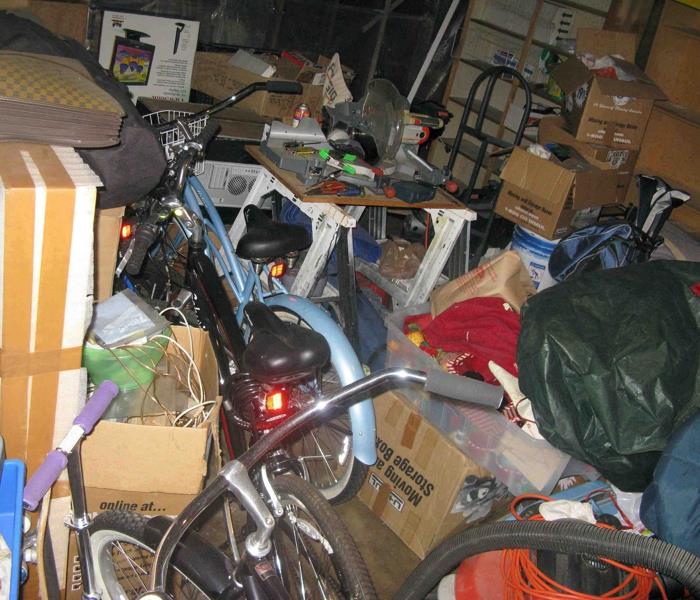 Junk Removal needed
Junk Removal needed
Making decisions is tough. When faced with the need to eliminate clutter, clean out a home from a loved ones passing or just down size there are always decisions to make. Some will be tough and during these difficult times you made need some help. Working with the right company will make all the difference. One suggestion we have is that you hire a professional organizer, they will provide you with guidance and suggestions on what is really necessary to keep, donate or toss. They will also be able to provide you with valuable information on how to maximize your space and be as efficient as possible.
Finding a company to help you get rid of stuff is easy they are all over the place. Finding the right one that will do the job properly is a very different story. Many companies are one guy and his truck making ends meet while others are part of a franchise. There are ways for you to make the right choice. There are companies out there that have the local connections with all the right professionals to make sure that you entire ordeal goes smoothly.
Besides being able to get rid of the items you need the best companies will have collaborations with professional organizers, Interior Designers, and contractors so that they can provide you a one stop resource to get back to living "Like it never even happened"
Below we have a few things for you to look out for when choosing the right company for help.
1. Quick removal.
A key measure of a good company is the speed at which they are able to get your task completed. Many clients have already made the decision that there are things that need to be removed. Meaning that they want them gone yesterday and will not wait a week for someone to show up and remove them. The good companies will be able to get to you and your stuff within 24-48 hours. Any more than that can highlight problems.
The junk removal industry considers the amount of time from customer contact to actual removal as one of the yard sticks of a good service provider. This is a service business and usually by the time a customer picks up the phone, the pile of debris is ready to go. The good ones can coordinate a pick-up with 24 to 48 hours of your call.
2. Every item goes.
There should be very few items that a good junk removal company will not take. Of those you can expect to see fertilizer, hazardous materials, and used oil. There are special companies for that. All of your other items they should be able to accommodate. If it is a reputable company they will find way to make your junk removal happen no matter the size of the job or items.
3. Adequate resources.
No matter the size of the job the company should show up with the right equipment and the proper manpower to handle the job. While the job size may vary you will find that the proper company will be able to remove one item from your home or everything from multiple locations. They should also have the ability to use dumpsters for larger jobs but also be able to work in tight area where the streets are narrower. The removal is only part of the job and while the items may not be your concern it is always a good idea to make sure they have a place to dispose of the items you want removed. There could be ramifications should the items be improperly disposed
4. Certifiable skills.
The staff should have proper training and proper crew size to handle the job at hand. The crew should be professional, courteous and diligent about the clean up process. Proper training ensures that all items are removed carefully without causing any damage and they do not leave more of a mess. and continues with how to carefully remove the items and not make more of a mess.
5. Competitive price.
Be wary of the pricing structure that is easy to follow. The easiest way to understand the pricing is if it is the volume or the amount of space it takes up. Many will base the pricing on the amount of time it takes along with the weight of the items. This makes it hard for you as the client to know the true price unless you go to the dump with the guys when the truck is weighed.
6. Proper disposal.
Speaking of disposal. The best companies will have the environment in mind and work to keep as much material out of landfills as possible. This means having a strong understanding of what is able to be recycled and having an established relationship with the facilities. They must also know the things that will be hazardous if put into a landfill and have the ability to dispose of them accordingly. If they are good at what they do as a worst case scenario they should be able to keep 50% of what you give them out of the landfill. Not only that but they should be able to provide you with that information about what will be happening to your stuff. That being said hoarding cases are a very different scenario as much of that stuff tends to be hazardous and cannot be recycled.
7. Clean-up.
This is probably the most important time of the process but is the pivotal piece of information you need to ask about upfront. They have to be willing to put the finishing touches on the work that they do. Sweeping up after the debris is gone and making sure the area is ready for the next stages. Be it new construction, design work, or just living less cluttered.
So the Fire is out... Now What????
2/2/2016 (Permalink)
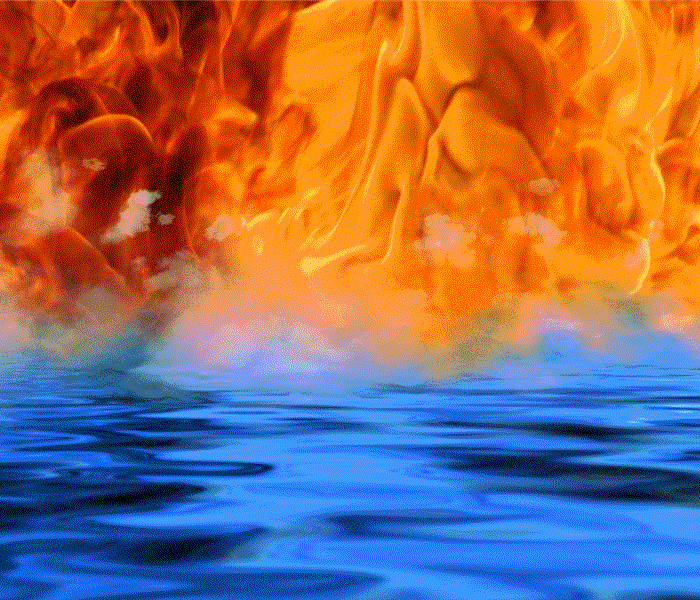 Fire Damage, How to ensure it is not there for ever
Fire Damage, How to ensure it is not there for ever
A back draft of emotions often sweeps over the homeowners after a fire ravages a home. Fear, uncertainty, stress and doubt about the future of the property can overwhelm the homeowner long after the flames have been extinguished and the smoke has cleared. So after the first wave of heroes have rescued the property, let your local SERVPRO professional help you restore it.
With the industry approved training to employ rapid response, the utmost professionalism, cutting-edge technology and open communication, we strive to restore not only the home, but your peace of mind, as well. So, before you risk doing further damage by attempting to clean up the damage yourself, call the fire damage cleanup and restoration professionals. Below you will find a list of services offered.
Restoration:
• Fire, Smoke and Soot
• Water Removal and Dehumidification
• Mold Mitigation and Remediation
• Catastrophic Storm Response
• Move Outs and Contents Restoration
• Electronics and Equipment
• Document Drying
• Contents Claim Inventory Service
Cleaning:
• Air Ducts and HVAC
• Biohazard, Crime Scene and Vandalism
• Carpet, Upholstery, Drapes and Blinds
• Ceilings, Walls and Hard Floors
• Deodorization
What You Can Do Until Help Arrives
The first 48 hours after a fire damage can make the difference between restoring versus replacing your property and personal belongings. Professionals can help prevent fire damage from creating long-term problems. They can also provide timely response with mitigation services ranging from fire, smoke and soot removal to contents claims inventory and document restoration. Quick action can help prevent fire damage from creating long-term problems these services help ensure your property, belongings and memories are restored to pre-loss condition when possible. Contacting a professional will help you regain control quickly. Despite the overwhelming desire to clean up as much as you can follow these steps to ensure that you have be end result.
1.Limit movement in the home to prevent soot particles from spreading and additional damage from occurring.
2.Place clean towels or old linens on rugs and highraffic areas and upholstery.
3.Coat chrome faucets, trim and appliances with petroleum jelly or oil.
4.Place aluminum foil or wood blocks between furniture legs and wet carpet.
****DO NOT DO ANY OF THE FOLLOWING****
Do not wash any walls or painted surfaces.
Do not shampoo carpet or upholstery.
Do not clean any electrical equipment.
Do not send clothing to a dry cleaner since improper cleaning may set smoke odor.
We hope that this helps you get back to “Like it never even happened”
Clutter..Storage... Hoarding
1/28/2016 (Permalink)
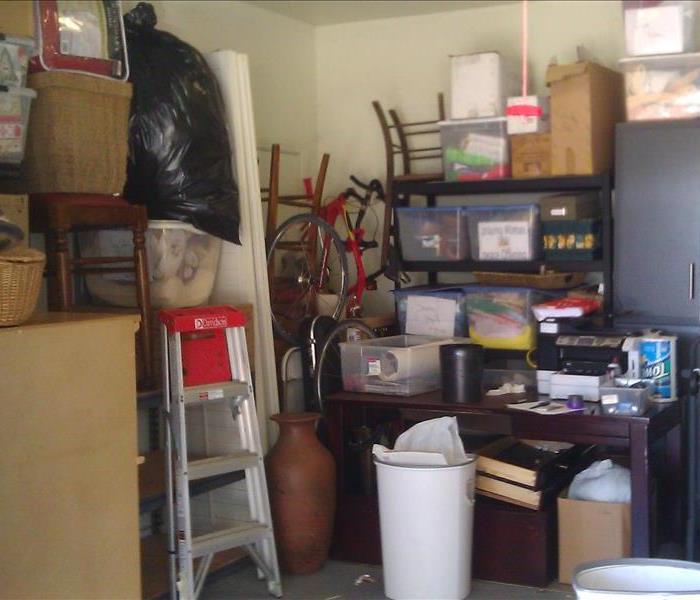 Do you have a room with too many thing Clutter storage and horarding cause stress.. Drop the excess weight
Do you have a room with too many thing Clutter storage and horarding cause stress.. Drop the excess weight
Do you have too much stuff?..Maybe a storage unit that is sucking money out of your monthly budget that you would like to get rid of. Do you or someone you know have a hoarding problem that you would like help?
Many
Storage units can cost an average of $100 upwards of $200 a month placing a burden on your monthly budget. Evaluating if you really need something and getting organized can save you a lot of time money and effort in the long run.
Why do people get a storage unit? They have a home down size, an affinity for being easily mobile with the possibility to settle down at some point, or they just plain have too much stuff. Storage units should be a short term solution for a home in chaos due to some sort of disruption remodel, fire, water damage or natural disaster. These are all good reasons to need and utilize storage units for a temporary situation but many forget they have them. They may like the new free and open space in their home or just not want to deal with eliminating these valued treasures that have great worth. No matter the reason
Storage units that you have had for more than 6 months mean you have far too much stuff and may have a problem. Facing that knowledge can allow you to start the process of saving money, making some money and maybe even saving relationships.
Things that do not fit in your home are going to cost you a fortune over the course of even just a year. Many once they get a storage unit do not keep it for just a year it is kept for a long time. Due to the fact that once the items are boxed and shoved into a square room it makes it a lot harder to go through. Task is more daunting. Once the bill becomes too much, many will just abandon the unit all together. They don’t have storage auctions for no reason. Losing valuables, family heir looms and money that could have obtained from selling the items themselves.
Have a place for extra storage can result in someone that has a borderline problem can blow up into a real case of hoarding or shopaholics being able to perpetuate the problem . Hoarding causes a number of health and safety problems with in a home or office environment. Health issues can range from the development of mold, to infestations of various types of animals that will leave urine and feces all over. Ruining your possessions and posing a safety risk for tripping and falling, fire hazards due to an over abundance, and even structural problems if there is enough and the weight is excessive.
Either way if you walking around your home and the path ways are not clear, heating vents are blocked, rooms are designated junk rooms or even have a storage unit…you need to get a handle on the situation as soon as possible.
Hiring a company to remove the junk is a good start but if you are having trouble deciding what you need to keep, sell, donate, and throw away a professional organizer is a wonderful resource. They have the knowledge and know how to get you back on track.
Feeling good in your home is the path to physical and mental wellness. A professional organizer will not only help you make decisions on what to keep, donate, sell, and discard but assist you in ways that will allow you to keep it that way. Decreasing clutter and easily being able to find items will reduce your stress levels significantly. Improving relationships all around you can be far more valuable. They even have software, calendar, and task management systems they can help you set up.
Cleaning and reducing clutter in your life will allow you to appreciate and enjoy what you have. It will also create a space is a true home and not just a place to put stuff. In an age where the materialistic is becoming more and more intrusive on our day to day interactions it is important that we hold on to as much of our family and friends interactions as we can. Eliminating what we do not need, letting go of the past and sometimes even tossing out old ways will keep those relationships strong.
SERVPRO of East Boston Chelsea and Charlestown has a qualified team on staff that can help remove the clutter as well as a professional organizer that will help you make the tough decisions. Set up your initial consultation and get ready for the spring and summer now…
MOLD IN YOUR COFFEE..MOLD IN YOUR COFFEE..THERE'S NO WAY..BET YOU THINK THIS ISNT ABOUT YOU..THERE'S NO WAY.. ( you know you sang that) But Seriousl
1/21/2016 (Permalink)
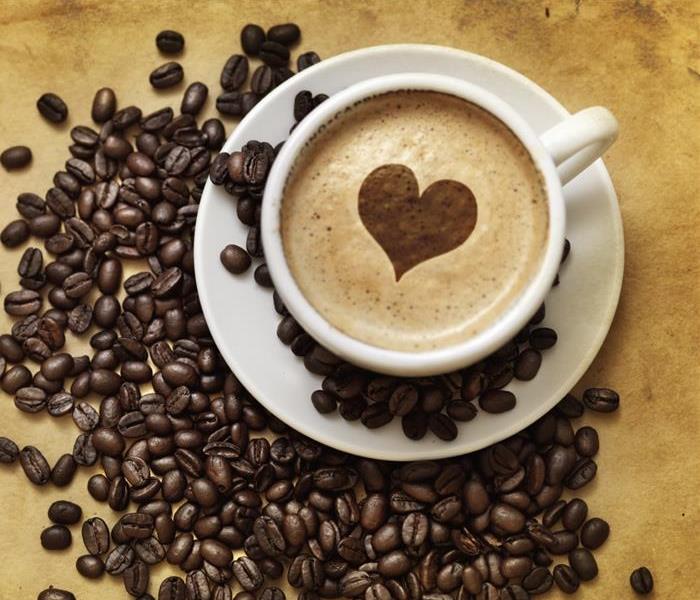 Mold in your coffee..YIKES!!!!! it looks so happy and make me function How does it have mold.
Mold in your coffee..YIKES!!!!! it looks so happy and make me function How does it have mold.
Your clean you wipe and wash your kitchen, keep your dishes done run hot water through your coffee machine from time to time. What are you talking about there is mold in my coffee???? A study done by National Science Foundation (NSF) found that the largest concentration of germs is located ( no not the bathroom) but in the kitchen. Guess what the top 10 dirtest items are Kitchen sponges, Kitchen Sink, Toothbrush Holder, Pet Bowl, COFFEE RESEVIOR, Faucet Handles, Pet toys, Countertops, Stove knobs, and Cutting boards..
See that nestled right in between pet bowls and faucet handles.. COFFEE RESEVIOR…A pets bowl is cleaner than your coffee resevior?? Inside half these reservoirs they found mold and yeast. A staggering 10% have been exposed to Coliform Bacteria. WHAT IN THE WORLD. In your coffee.
Ok so how is that even possible?
I run hot water through my machine to make the coffee. I also thought coffee had antibacterial properties to it. Should those two things be enough to keep the bacteria and mold at bay? Nope not even close for water to work it needs to be boiling NO coffee maker gets water to reach its boiling point. You would sue them for getting burned all the time. The acid in coffee only works on about half of the germs that are found in the pot and filter. If anything the warm moist environment makes it the perfect breeding ground for the bacteria and mold.
Another thing is the our bodies are great at adapting. We build up a resistance to these germs that are ingested in small amounts over the course of time. When ingesting a potentially harmful organisim our body does have the ability to filter out some of the infected particles. This is not ideal because the germs too adapt and can slip by your immune system eventually and make you sick.
Ok so how to clean the Coffee Maker:
The frequency is commensurate with how often you use your machine. If you use it for a pot per day I would suggest a through cleaning once a week. If you have a machine that gets more use like a communal one at work a few times a week would be advised.
Any parts of the coffee machine that can be removed should be for effective cleaning. This includes but is not limited to carafe if there is one, the basket that houses the filter and coffee itself, any parts of the machine that can be removed easily. Make sure you use hot soapy water to eliminate germs, stains, and residue oils left over from making the coffee. Once this is done make sure everything is fully dry before you put your machine all back together.
Great your done right? No one more step
Your water no matter how hot or soapy will leave behind elements that can encourage growth because there are minerals in the water. This will have to be removed. Because you drink from this machine it is suggested that you leave the chemicals behind and settle for some natural products. The suggestion is using a vinegar based solution at a minimum of once a month. This will decalcify the machine and produce a better cup of coffee.
Here the suggested way to get that done. Fill the water reservoir with half water and half vinegar… Pretend you are going to brew a pot of coffee and put the filter in where you normally would. **DO NOT PUT COFFEE IN IT** Brew this until almost half of the water has emptied into the pot turn off the machine. Walk away and leave everything for about a half an hour. Turn the machine back on and finish the brewing process. Once this is done remove the filter and just run some plain water through the machine. I would advise doing this two times to make sure the vinegar is fully out of the machine. Then do one more rinse of the hot soapy water that is being done once a week. This will ensure the bacteria and mold are not able to grow and make you sick.
The machine is clean and there is no more mold in your coffee. This should allow you to enjoy that cup of coffee the way it was meant to be enjoyed worry free……. Happy sipping
Do you really know what a BIOHAZARD is???
1/20/2016 (Permalink)
 SEWAGE BACKUP CLEANUP .. we have the right equipment and gear to keep everyone safe
SEWAGE BACKUP CLEANUP .. we have the right equipment and gear to keep everyone safe
Biohazard
What is a considered a biohazard? It is any waste products that have a risk of carrying human pathogens. They can be found pretty much anywhere.
So what is a pathogen? It is a virus, fungus, or bacterium that can cause disease in another organism. These disease-causing organisms can be spread in several ways ranging from airborne to direct contract
With the technical stuff is out of the way we can focus on the problems you may see and their solutions. What does all this mean for your home or business? It means you have to fully understand what things are considered a biohazard and to know when more than just surface cleaning will do.
Biohazard materials are not just limited t the doctors or a hospital it can also be found in your home, work and places you and your kids play. Be it indoors or out. Knowing what is considered a biohazard and how to respond to it will keep you, your friends, family, co-workers and employees safe.
Some examples of this type of biohazard waste are:
Human blood and blood products. This includes items contaminated with blood that will release blood in a liquid or semi-liquid form when compressed. To prevent infection, it is recommended to apply a universal precautions approach to all blood and body fluids. This means
Human body fluids. Examples include, but are not limited to, vomit, urine, semen, vaginal secretions, amniotic fluid, saliva, and pleural fluid.
Pathological waste. Waste biopsy materials and any human tissues or body parts from autopsy, surgery, or other procedure.
Microbiological waste. Discarded live and attenuated viruses, discarded specimen cultures, and disposable culture dishes.
Sharps waste. Used needles or any sharp object (scalpels, glass slides, broken glass) that have been contaminated with potentially infectious materials.Feces: Kids and pets are great at making this sort of mess. Feces contains pathogens, like bacteria and parasites.To make sure you are not infected use the same precautions for all of the above scenarios. This means making sure you are handling all biological materials as if they contain an infection disease. If you are facing a blood spill, unattended death, or other trauma you do not have to face it alone. Many restoration companies offer these clean up services. If you are choosing not to utilize a professional service make sure you are following safety protocols.
Still want to tackle this biohazard on your own. Ok here goes. Getting up as much solid material as possible is the first step. Hydrogen peroxide and baking soda is a great way to start the cleaning process on these materials. **ALWAYS TEST A SMALL AREA BEFORE APPLYING ANY CLEANER*** some dyes used are sensitive and may change or fade with different products natural or otherwise. If there is a remaining stain, most commercial rug cleaners will take out the stain and smell. Flush or double bag the poop or vomit and any toweling (don’t flush the toweling) you used and dispose of it with the garbage.
Hard non-porous surfaces:
Metals,Glass, hard plastic: Clean hard surfaces by getting up as much solid material as possible and using a disinfectant cleaner. Spray until thoroughly wet let it sit and wait minutes to give the disinfecting agent time to work before wiping away.
First contain the biohazard
Make sure you are keeping the mess as contained as possible. First things first get some disposable gloves. Section off the area to prevent others from going through and potentially tracking the material into other areas of the building. You must also determine which type of materials need to be cleaned porous or non-porous.
Porous Surfaces are much harder to clean:
These materials are designed to allow things through. Be it wanted or unwanted. Cleaning these materials is much more difficult. They can include but are not limited to Wood floors, Tile with grout, Carpets ect. It is always worthwhile to have a professional come in as they have specialized equipment that reaches deep down into the materials to extract as much of the contamination as possible.
Still want to tackle this biohazard on your own. Ok here goes. Getting up as much solid material as possible is the first step. Hydrogen peroxide and baking soda is a great way to start the cleaning process on these materials. **ALWAYS TEST A SMALL AREA BEFORE APPLYING ANY CLEANER*** some dyes used are sensitive and may change or fade with different products natural or otherwise. If there is a remaining stain, most commercial rug cleaners will take out the stain and smell. Flush or double bag the poop or vomit and any toweling (don’t flush the toweling) you used and dispose of it with the garbage.
Cleaning the Biohazard:
Carpet and rug floors may retain a stain after the initial clean up. If there is a remaining stain, most commercial rug cleaners will take out the stain and smell. When cleaning the poop or vomit make sure you are properly disposing of not only the hazardous materials but any and all towels or rags used to clean it up(don’t flush the toweling) you used and dispose of it with the garbage. Make sure that you double bag everything.
Discarding the Biohazard:
Find some rags or other clean up materials that you do not mind discarding. Make sure whatever you are going to place the material into has a strong plastic liner. It is also important to make sure that there are no sharp objects that could pierce the bag and cause the hazardous material to escape. Is it advised to double whatever bag you are using to ensure it is secured. Scoop as much of the biohazard you can into the container using a dustpan or similar item.
Should the material be liquid such blood or urine use heavy paper towel or other cloth you do not mind throwing away. If there are none around you can also use kitty litter or salt to contain and absorb the fluids.
The cleanup process does not end there once the Biohazard has been picked up, removed, and disposed of there is still you. The person who cleaned it all up. You must now treat yourself with the same care and caution. Remove the clothes used and place separate from your other garments. Ideally in a plastic bag, depending the severity you may want to discard them. If not ensure that they are washed as soon as possible. Washing your hands immediately will prevent any cross-contamination. Make sure you shower as soon as possible as well.
Properly cleaning the affected area is vital to keeping all involved healthy and safe. Make sure that once the mess is fully cleaned up and you, your hands and clothing are all thoroughly washed. Knowing when the mess is beyond surface cleaning is a pivotal part of that process. If there is any question please call a professional and obtain a free estimate and their expert opinion. Better safe than sorry. Tackling a project like this your own or asking your untrained staff to do so could be putting you all at risk. ……HAPPY CLEANING
Storm Damage .....now what????????
1/14/2016 (Permalink)
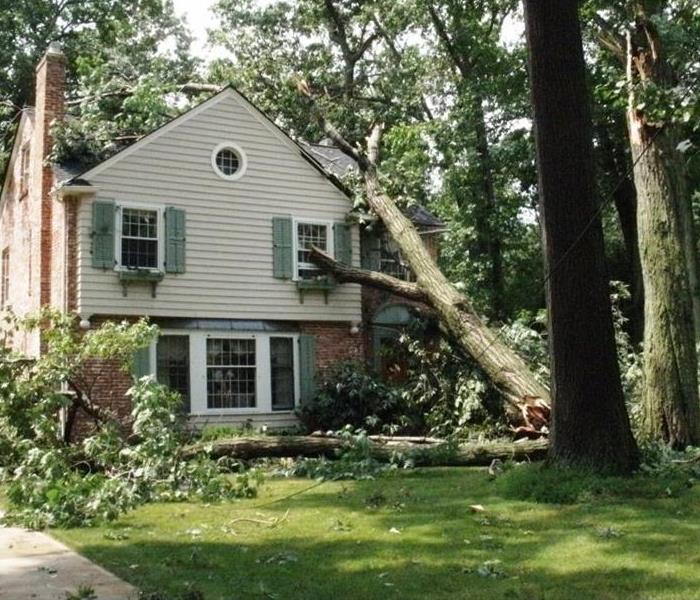 Storm Damage can happen anywhere and be large or small
Storm Damage can happen anywhere and be large or small
You have storm damage now what?
Recovery after a storm:
Just because the storm has passed does not mean that the danger is over or that all the damage that is to be done has been done. Continued exposure to the elements can cause further damage and problems. There are some key steps you must take to get back to normal as soon as possible.
Did you know that many insurance companies have time limits on how long you can wait to file a claim? These are very specific time tables and some vary based on the type of policy or even the type of damage that has occurred. Check your policy and know your time frames and make sure when you have a loss that you call the insurance company immediately. When calling the insurance company make sure you are contacting the Claims department directly.
Another good reason to call and get the process started as soon as possible is that the longer your home & Valuables are exposed to the elements the more damage can occur.
We here many people say that they do not call their insurance company because they are worried they will receive a rate increase. This is not the case you cannot be singled out for rate increases due to storm damage when filing an insurance claim. Remember most state laws prohibit insurance companies from cancelling policies for filing claims in an Act of God storm damage situation. In most states insurance company cannot single you out for a rate increase. If the insurance company is going to raise rates, they have to raise everyone's rates in your area. So, if you don’t file a claim, your personal rate increase will pay for everyone else's claim except for yours.
Get a restoration contractor because they have the knowledge with the your specific type of damage but they are also very adept with dealing with insurance companies and will be your best advocate. They will make sure the insurance companies pay for all damage both visible and hidden so that you do not have any major problems down the line.
When you are hiring a contractor there are several tips we suggest. Always get more than one estimate you are not familiar with this sort of work and having multiple estimates will give you a better idea of the true scope of the work that needs to be done. Make sure you are also not basing your decision solely on price. There are many factors to take into account and since most storm damage tends to be insurance work make sure you are picking the best contractor to handle the job. Be aware of any contractor whose pricing is far below as they could be taking short cuts or using inferior products. This can lead to major repairs that may not be covered down the line. Get a minimum of 3 estimates and make sure your entire property was inspected. This inspection should include the roof, windows, siding, AC units, screen, concrete and all exterior surfaces.
Be sure you are documenting the date of the storm itself as well as any time tables as you move through this process this will help to show you are taking proper action. Take pictures of the damage if you can do so safely. If you have any before images of how the property or items looked prior to being damaged these will help not only your contractor but proof of necessary work for the insurance company. Another good idea is to find some news articles about the storm hitting your area set aside in a folder you may need them later.
Make sure you are requesting and insurance adjuster to inspect the property. When scheduling a time for the adjuster to come out make sure you have whomever you have selected at the contractor be present for inspection. The contractor will make sure that the adjuster is noting all of the damage and that they are playing fair when giving you an estimate for the damages. Insurance adjusters work for the insurance companies and if they can find a way to deny your claim they will.
So your claim was denied!!!!!!!!! Breathe it is alright you are entitled to meet with 3 adjusters. Call and request another one. Even small damage should result in some sort of claim approval. Accepting a denial can lead to big problems down the road may be denied for improper action on the initial claim. Just like when you are selecting a contractor the rule of 3 is a good idea.
Once you have gained approval for the claim you will be issued multiple checks one of which will be in your name for the materials make sure the materials are ordered in your name as you will use this check to pay for them and then the contractor can get to work getting you back to normal.
Once the project has been started please make sure that any adjustment changes or deviations made by you or the contractor are submitted in writing and be approved by all involved.
Getting you back to like it never happened is important for you and your family; Make sure there are no headaches along the way make sure you are following the steps above. We hope this helps and remember stay safe out there.
GOT MOLD???? LET US KNOW
1/12/2016 (Permalink)
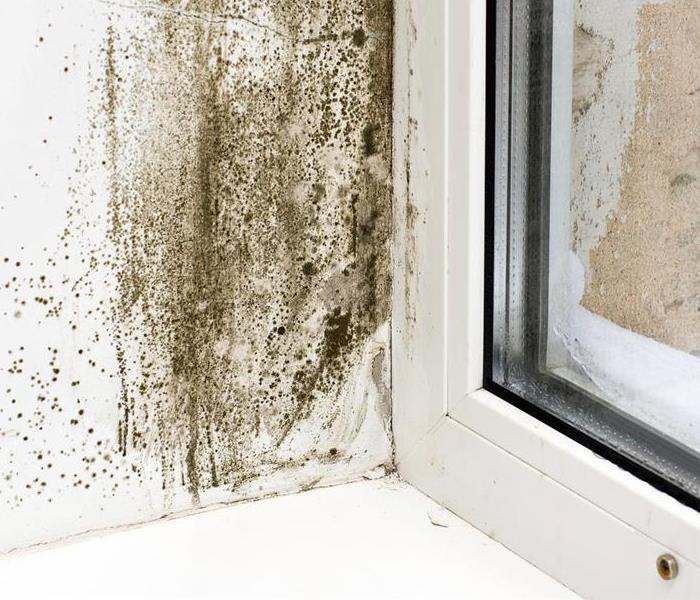 Mold can appear in more than just bathrooms Take a look around.
Mold can appear in more than just bathrooms Take a look around.
Mold remediation
Did you know there a lot of different kinds of mold, while some of the names may be foreign you may find that they are more common than you thought. If you have any doubts about the conditions in your home please make sure you call a professional. They have the testing equipment and the certified knowledge of how to get rid of any potential issues properly.
Just because you cannot see something does not mean it is not there so use all of your senses and trust your instincts. Check out where these types of molds can hide and take a look around.
Stachybotys
These stachybotrys molds grow on high cellulose material such as wood, wicker, hay, paper and cardboard. They are also commonly called ‘black mold’ and sometimes ‘toxic black mold’. This mold requires very wet or high humid conditions for days or weeks in order to grow.
Aspergillus
Aspergillus is the most common household mold. There are over 185 species of Aspergillus and 22 species are known to cause human illness. They can be found in almost any home or office on damp walls, wallpaper, PVC/paper wall covering, gypsum board, floor, carpet and mattress dust, upholstered-furniture dust, acrylic paint, leather, HVAC insulations, filters and fans, humidifier water, shoes, leather, bird droppings and potted plant soil, plastic and decomposing wood.
Cladosporium
Over 30 species of Cladosporium Species some produce olive-green to brown or black colonies, and have dark-pigmented conidia that are formed in simple or branching chains. They can be found on living and dead plant material but may grow on surfaces when moisture is present
Mucor
Common in soils these mucor molds are also often found along air conditioning systems and ducting. They are fast-growing, whitish to greyish, with usually thick growth.
Penicillin
Penicillin you may know as the miracle medicine but the penicillin mold can grow in your home on both walls and on a forgotten sandwich. Commonly found in soil, food, grains, paint, carpet, wallpaper, interior fiberglass duct insulation, and rotting vegetation.
Fusarium
Is a common soil fungus. It is found on a variety of plants as well as humidifiers.
If you think that you have any thing that resembles any of the above descriptions please make sure that you call someone to have it checked out. So that any potential problems do not get worse or cause a larger more severe problem later down the road.
You had a fire now what?????
1/7/2016 (Permalink)
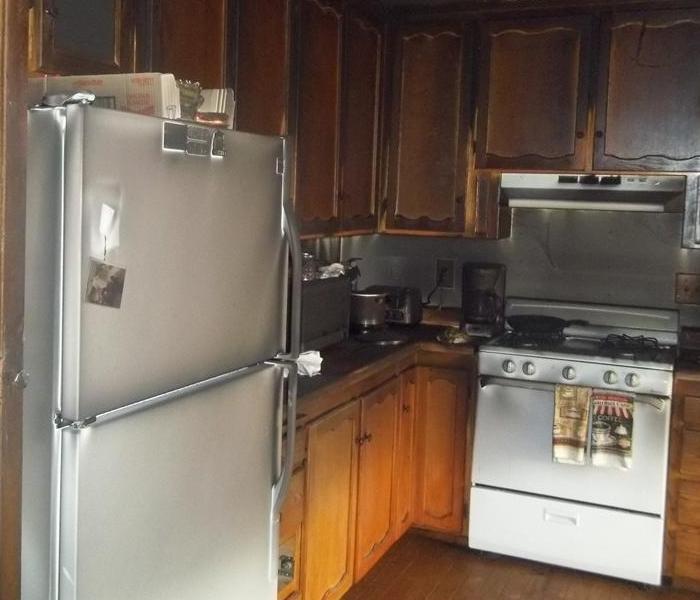 Smoke damage is so much more than you can see.
Smoke damage is so much more than you can see.
ACT QUICKLY and here's why.....
Smoke and Ash is everywhere. …Smoke is the fuel from the fire that did not burn it contains small particles of carbon and other materials. Fire gives off light, heat, carbon dioxide and water vapors. Smoke has all of this in it in microscopic form. It also contains soot ash and residuals from anything that was actually burning during the fire. Various types of smoke can contain chemicals that are dangerous to your health. While every fire will not contain it all, it is good to have an understanding of the importance of getting rid of the smoke. EPA studies show that methane, formaldehyde, Acetic acid, formic acid, toluenes, oxides of nitrogen, sulfur dioxide, organic carbon, and traces of heavy metals have all been found in smoke after fires. Ash will discolor most surfaces throughout your home or business and many surfaces and start to discolor immediately. If left for too long these discolorations may be permanent. Due to the acid nature of ash the longer it is there the more damaged it will cause.
Because wood is not the only thing that burns in a fire. Plastics, fabrics, foods, and other materials used in construction these too can produce toxic gases and other odors. While visible smoke may dissipate once the fire has been stopped. It does not mean that there is still not a great deal of damage to deal with. There are two kinds of smoke what they call driven and free floating. Fire also has two classifications high or low oxygen content and they will produce different kinds of damage.
When a fire is put out it changes from a dry heat to a hot humid heat. Depending on the method used to extinguish the fire the soot could be wet or dry and have a chemical residue left by extinguishers. This changes the relative humidity of the home or business depending on how much is needed to suppress the fire. Wood will expand and absorb the odors from the fire making it difficult to remove on your own.
Quickly removing soot and smoke damage is easier as some types of soot become more and more difficult to remove over time. Keep in mind even though items do not look damaged they could have suffered damage. Items could have melted slightly under the heat, things could be internally water logged, or the smoke film could be so thin you do not notice it and it has gotten inside the cracks of the items.
Contacting help as soon as possible also helps reduce the cost of the loss as many items may be salvaged if addressed right away. A professional will assess the situation and ensure that each and every item that needs to be restored is processed and what cannot be salvaged is removed so that the ash will not continue to coat surfaces. Using specialized odor neutralizing materials will be used and items should also be sealed off from the rest of the home to reduce permeating into the air until they have been restored.
Immediately calling your insurance carrier and notifying them of the damage is very important. Make sure you are asking for an adjuster to explain your situation and get the recovery process started as soon as possible. It is important to keep you and your family safe and ensure there are no toxic chemicals or hazardous materials in your home. Have a safety check conducted before you go back inside.
Contacting someone to help immediately will reduce the cost of the loss as many items may be salvaged if addressed right away. A professional will assess the situation and ensure that each and every item that needs to be restored is processed and what cannot be salvaged is removed so that the ash will not continue to coat surfaces. Using specialized odor neutralizing materials will be used and items should also be sealed off from the rest of the home to reduce permeating into the air until they have been restored.
Getting the right materials to remove the smoke from the various surface types throughout your home is exceedingly important. Knowing the proper drying times, humidity levels and pieces of equipment and chemicals needed to the job done properly will assist in getting you back to normal as quickly as possible. This is not always as easy as it seems which is why hiring a professional is strongly recommended. They have the formal training and products at their fingertips.
Prepare for winter..We have you covered
12/31/2015 (Permalink)
 Preparing your home and business for winter...
Preparing your home and business for winter...
Tips for Preparing Your Home & Business for Winter Weather
Home
1) Keep cabinet doors open during cold spells. This allows warm air to circulate around pipes.
2) Keep a slow trickle of water flowing through faucets, especially if the pipes for faucets run through unheated or non-insulated areas of your home.
3)Consider shutting off outdoor faucets. Find the shut-off valve in the basement or crawl space and turn it to “off.”
3a)If you follow the previous step, then open the outdoor faucet to help ensure it drains completely and the inner valve is shut off.
4)Ensure gutters are clean and secure. Leaves and debris accumulate, causing a damming effect on gutters, which could lead to roof problems and water damage.
5)Proper maintenance of your furnace can help reduce the risk of puff backs
Business
1)Check your business property for downed tree limbs and branches. Weather, such as wind, heavy rain, ice and snow, can cause branches to fall, which could cause damage to the property and potentially cause personal injuries.
2)Inspect property, especially walkways and parking lots, for proper drainage to alleviate flood hazard potential.
3)Inspect all handrails, stairwells and entryways to address and correct potential slippery or hazardous areas. Install mats or non-slip surfaces and post caution signs where water could be present.
Why these steps are important. Preventing these problems from happening is always easier and more cost effective than dealing with an emergency situation. Below you will find some information about some of the information above so that you have a better understand the need for prevention.
What is a puff back?
A puff back is a messy furnace malfunction that occurs when an oil burner backfires, sending soot throughout your home or business. It can happen all at once, covering an interior in grimy soot, or a puff back can leak soot particles more gradually.
Frozen Pipes
A frozen pipe can burst at the point where the ice blockage inside the pipe is located, but typically the rupture is caused by the backflow pressure between the water source and the blockage. A burst pipe can cause considerable damage to your property if not addressed quickly.
ICE DAM..Causes..Repair..Prevention..Solutions
12/30/2015 (Permalink)
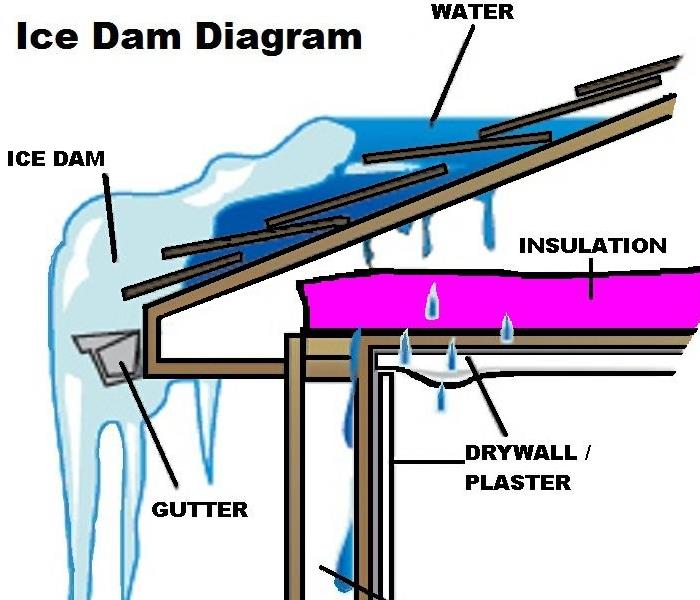 How and Ice Dam forms and the ways it can damage your home
How and Ice Dam forms and the ways it can damage your home
With Colder weather approaching Ice dams are a common problem … Have you had ice dams in the past?
How does an Ice dam form: Heat Loss from sides or roof of your home.
How can it damage my home? When you get an ice dam it can damage your home if it gets big enough…The ice that is closest to the house will start to melt and follows the path of least resistance. Many times that is under your shingles. It will continue to follow that path which can be into your insulation, down onto a ceiling or exterior walls. As it moves through maybe behind an eave it can damage the wall and the paint. The Ice Dam can break free from your home it can pull on parts of the roof, shingles or gutters. As it falls many things could be in the way. Kids playing outside, cars, shrubs, other parts of the house. If the area remains wet and not fully dry mold and rot can start to take hold.
What steps can I do stop an ice dam? There are steps that you can do to prevent an Ice dam from forming. A roof rake is a good tool for this. ( We recommend hiring a professional who uses a safety line) You have to be careful as there are really only 2 ways to use it. The first is from the roof itself pushing the snow off onto the ground. This means you have to be on a roof that has ice and snow on it. DANGEROUS>>>> The other is to keep your feet planted on the ground and pull what you can reach off of the roof. Which means you are in the path of falling snow and ice again DANGEROUS>> which again is why we recommend a professional. Replacing your roof with metal or standing seam is one way to get snow not to stick to it. While that may be expensive you could replace a smaller portion of your roof that is close to the gutters Approx. 3 ft with a drip edge. Keep in mind the incline on your roof will determine how effective or ineffective these options will be.
While all the above information will help you understand ice dams and how to work on preventing them, none of actually solve the problem of the heat loss. You have to deal with the ice dam once you have one. Let us tackle how to find out why they form to begin with and how to solve that problem.
Heat loss is how they form.. A warm roof or warmth seeping out from an unsealed edge of your home means snow has a chance to melt it will drip down to a point where it reaches the outside temperatures again and freezes again as Ice. Water follows the path of least resistance if that is down to the gutter or down into your home that escaping warmth will melt the snow and water will go to work. Should it drip down your roof it will eventually reach the colder outside air temperature. This build up over a period of time forms the ice dam. Heat loss is a very expensive problem that many do not notice until it is too late. There are many reasons for hear loss. The majority of the time it is through poor insulations or venting directly under the roof. The best solution is to work on insulation and preventing any convection through ceilings. Properly venting the space where the insulation and roof sheathing meet ensures that heat that seeps through is distributed away from the roof. Make sure you seal all living areas. A great resource is to have an energy audit with Thermograpic inspection so that you can see where the problems lie and properly seal insulate and vent in the right areas.
Obviously solving the problem is the best way to just not get an ice dam.
They do happen and when they do you have to deal with the problem. Our team at SERVPRO of East Boston Chelsea Charlestown is highly trained on dealing with the damage that an Ice dam can cause and are here for you 24/7. We will be here for you getting back to normal. Like it never even happened.
 SERVPRO of East Boston, Chelsea, & Revere is an area leader in mold remediation services, call us today to learn more.
SERVPRO of East Boston, Chelsea, & Revere is an area leader in mold remediation services, call us today to learn more.





 24/7 Emergency Service
24/7 Emergency Service






































































































